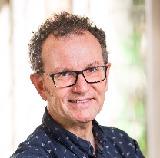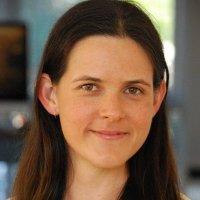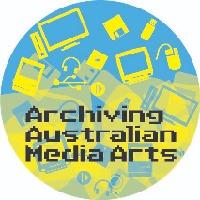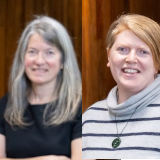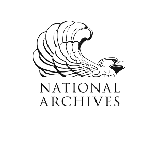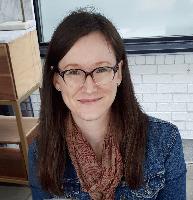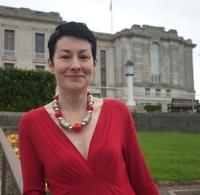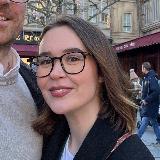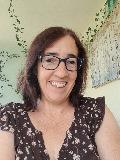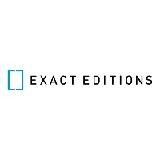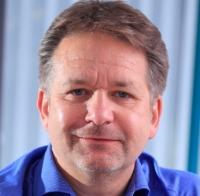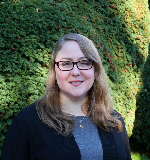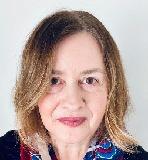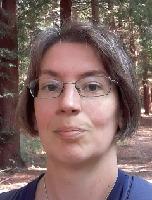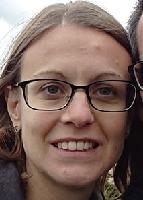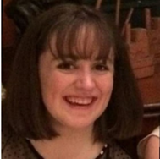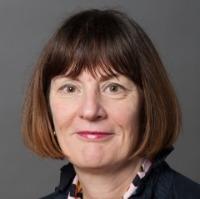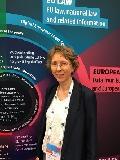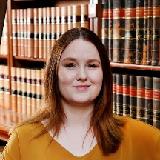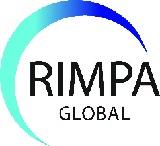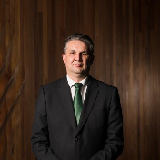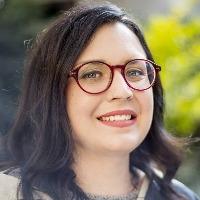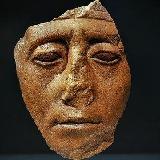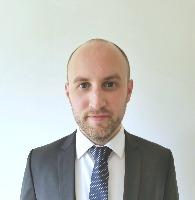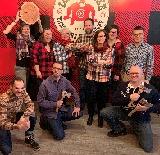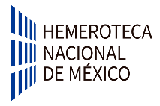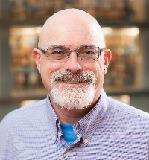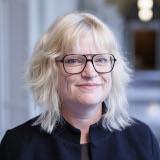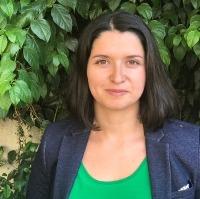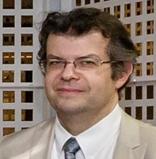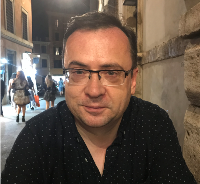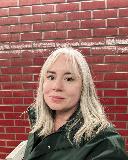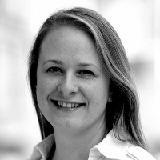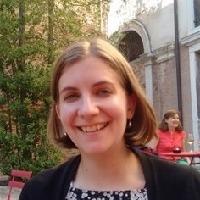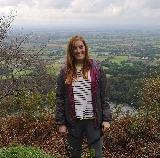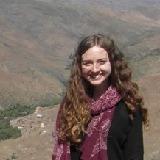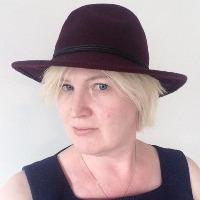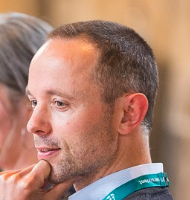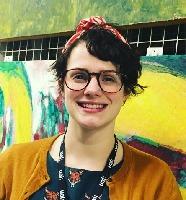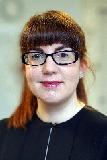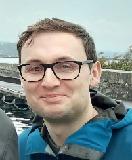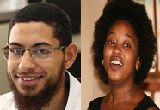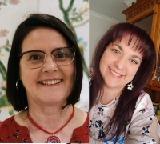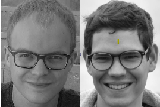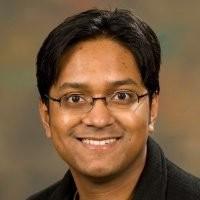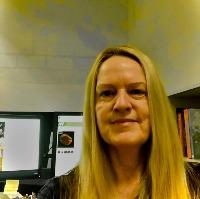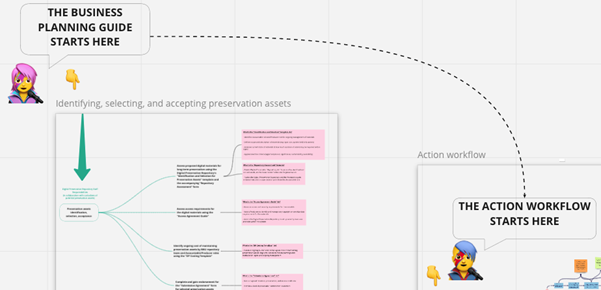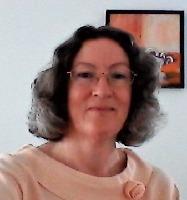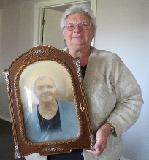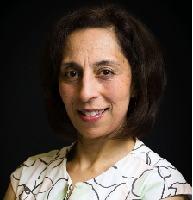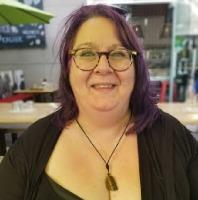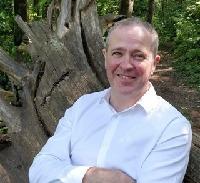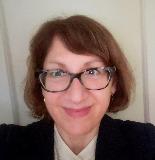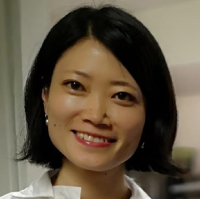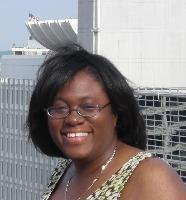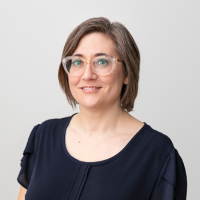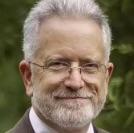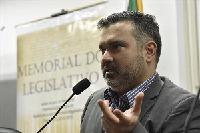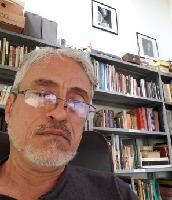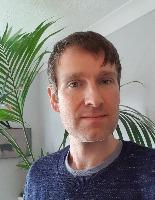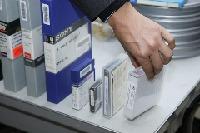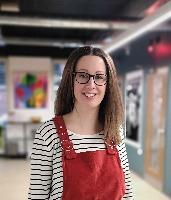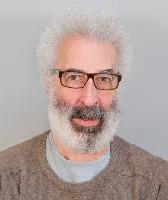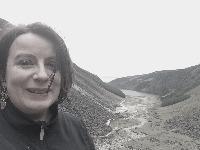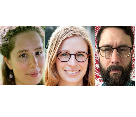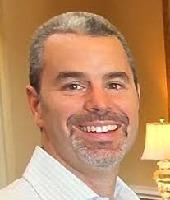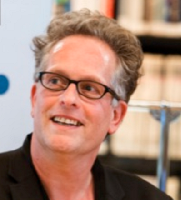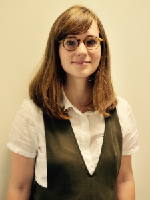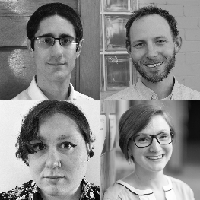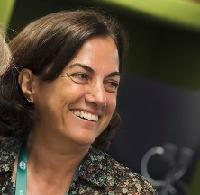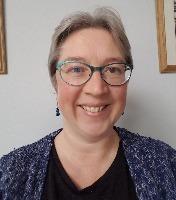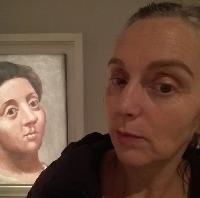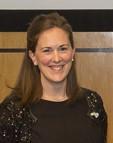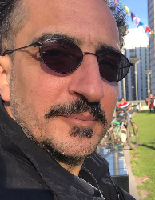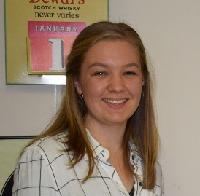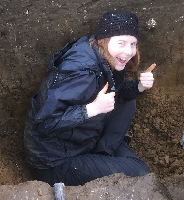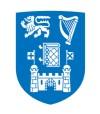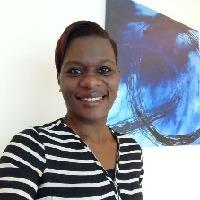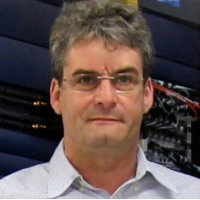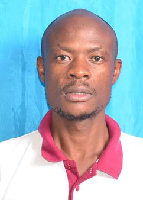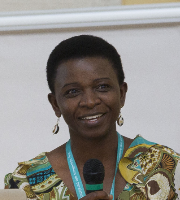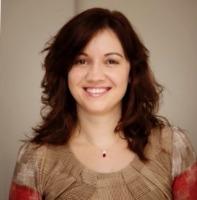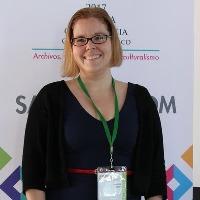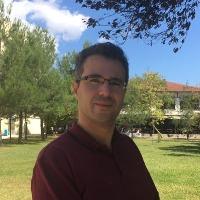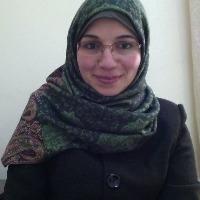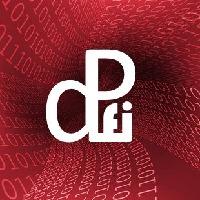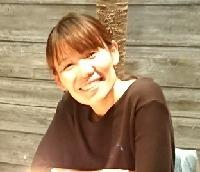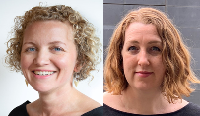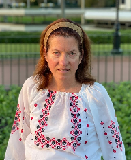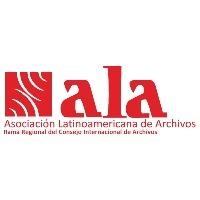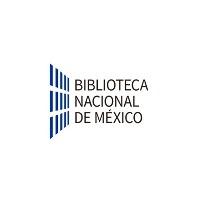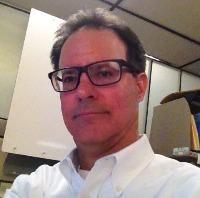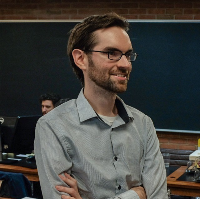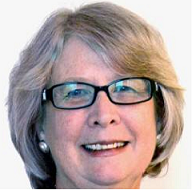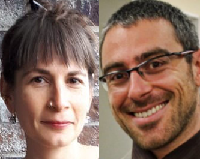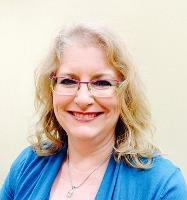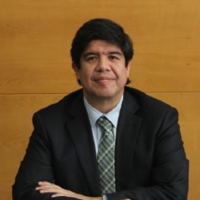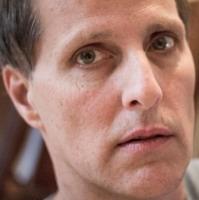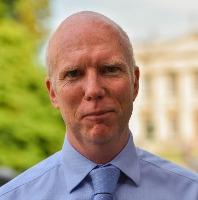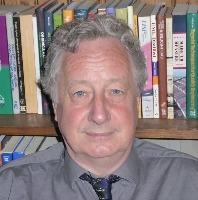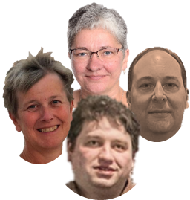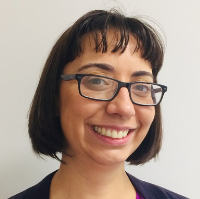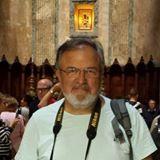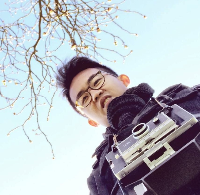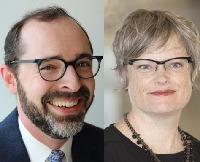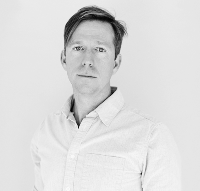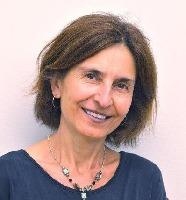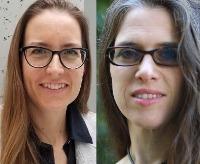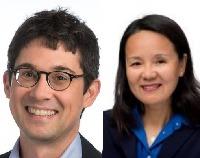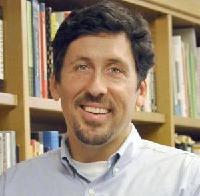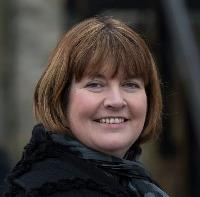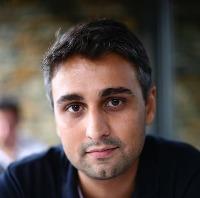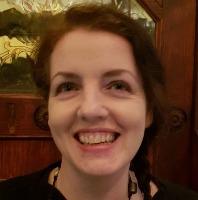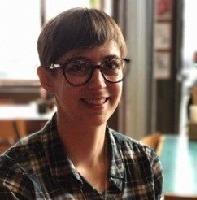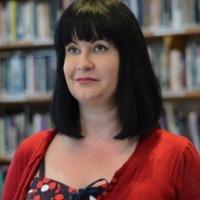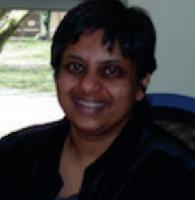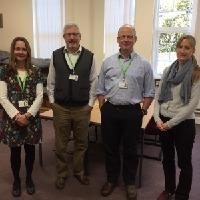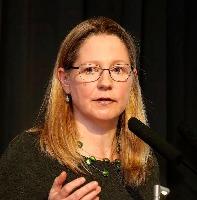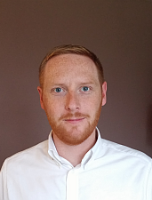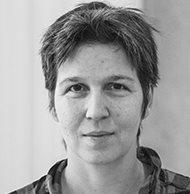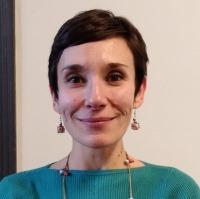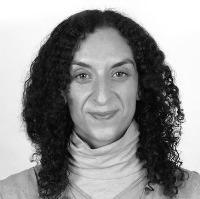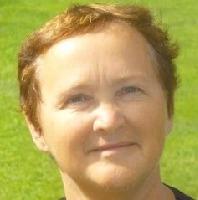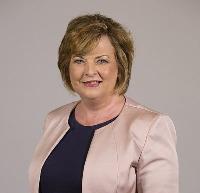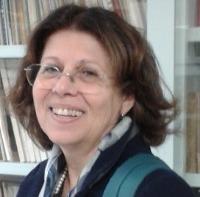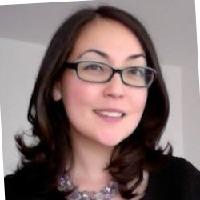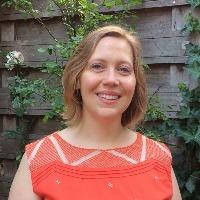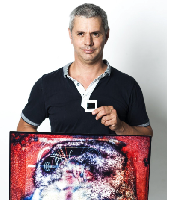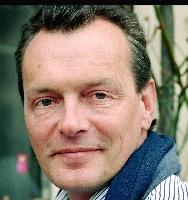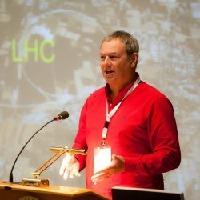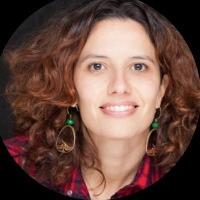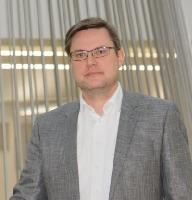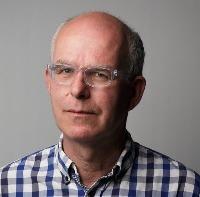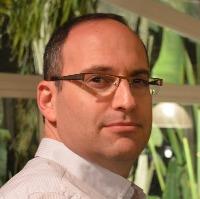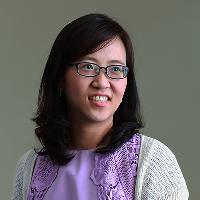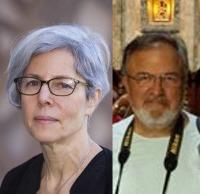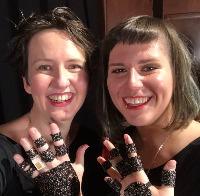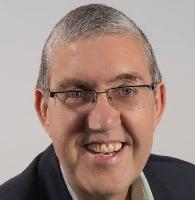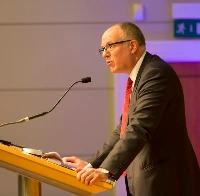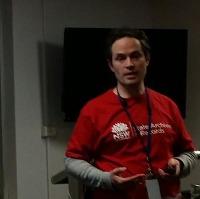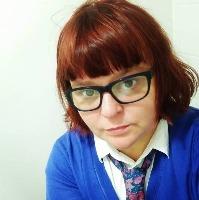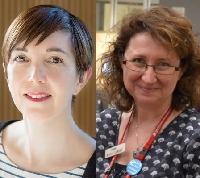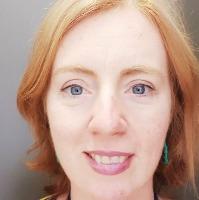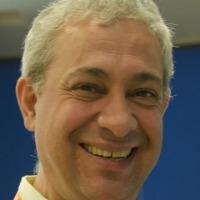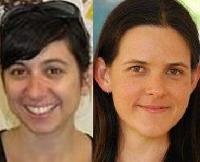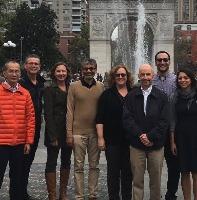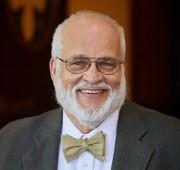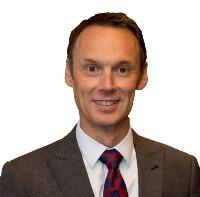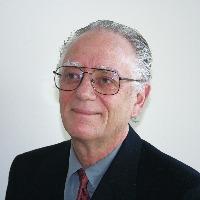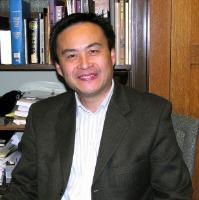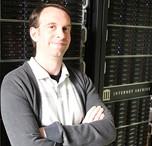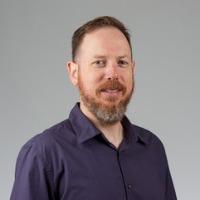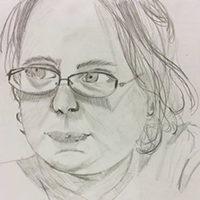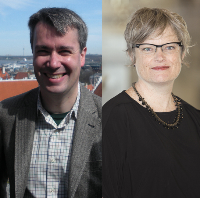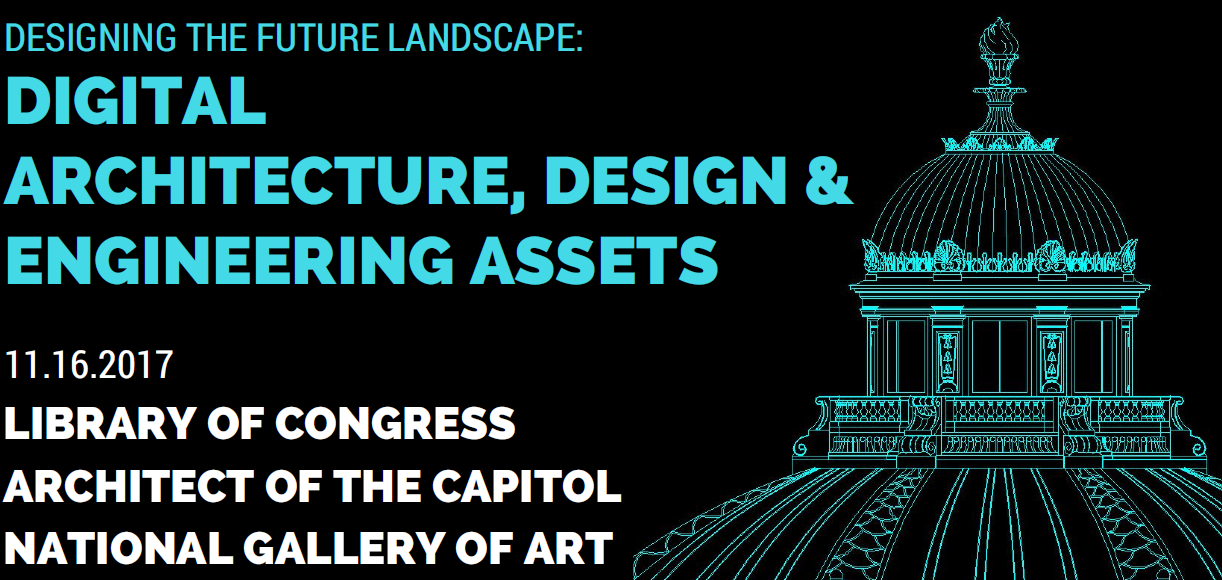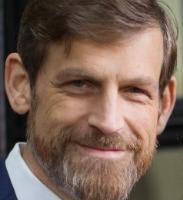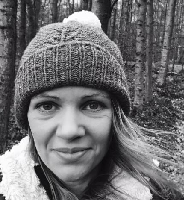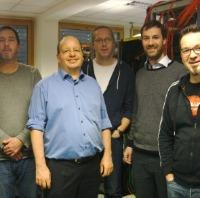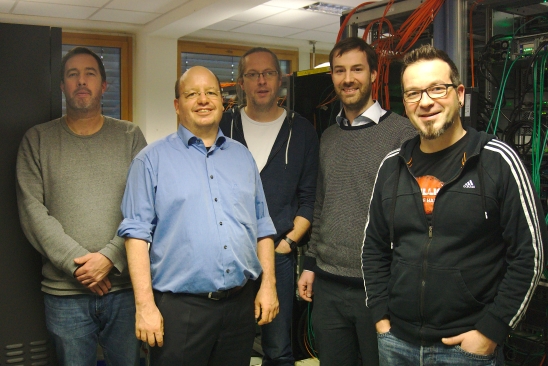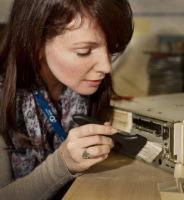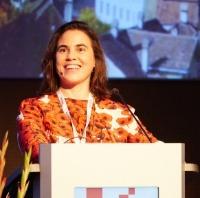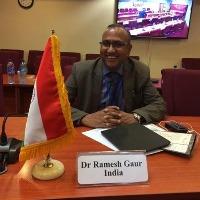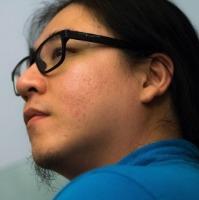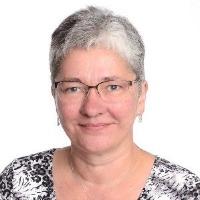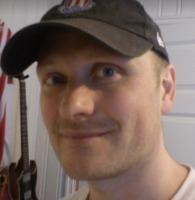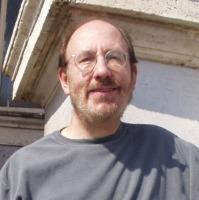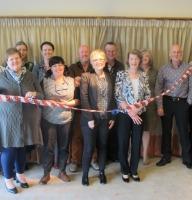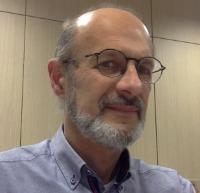What to expect if we save digital data on hard drives
Elizabeth Day, Assistant University Archivist for Records Management, and Irina Schmid, Instructor and Digital Collections Archivist, both work at the American University in Cairo.

THE WHITE DESERT STORY
The White Desert is a one-of-a-kind landscape in Egypt, known for its breathtaking rock formations created by wind erosion over millions of years. These formations are made of white chalk and have been sculpted into a variety of shapes and structures, such as mushrooms, cones, and columns.
From a cultural perspective, the White Desert is a well-known tourist destination and UNESCO World Heritage site. The distinctive rock formations, combined with the stark beauty of the surrounding desert, make it a popular destination for photographers, hikers, and adventurers alike.
From a scientific perspective, The White Desert provides important scientific insights into the erosion and sedimentation processes that have shaped the Earth's surface throughout history. The White Desert's distinctive formations and patterns can help scientists better understand how wind, water, and other natural forces interacted over time to create the world we know today.
Overall, the White Desert's unique geological features and cultural significance make it an appealing destination for both scientists and tourists. However, the economic benefits of tourism must be balanced against the need to protect and preserve the fragile ecosystem of the White Desert for future generations to enjoy.
Leverage the strengths of community, promote digital S&T literature resources preservation in China
Zhenxin Wu is the deputy director of NDPP (National Digital Preservation Program), and she is also a senior researcher of National Science Library, Chinese Academy of Sciences. Additionally, she is a professor of school of economics and management, University of Chinese Academy of Sciences in Beijing, China.
[本文的中文版如下]
We all know that we are in a world where "born digital material" has become the mainstream mode of academic communication, especially since Generation Z has become a part of the scientific research community. Therefore, sustainable access to digital scholarship resources is now an urgent strategic issue in the field of research and education in any country. However, due to the inherent risks of digital information in terms of media, formats, software, and systems, along with the international and commercial nature of the academic publishing market, it is not reasonable to assume that the sustainability of these resources is guaranteed. This is the principal reason for archiving commercial academic publishing resources.
China is currently the leading contributor to scientific publications[1], but most of its international publications are issued by 20+ commercial publishers operating outside of China[2]. Some Chinese institutions began digital preservation of scientific publications early on; for example, in 2009, the National Science Library (NSL)[3] of the Chinese Academy of Sciences (CAS) initiated long-term preservation agreements with SpringerLink and IOPP to archive publications.
The flexibility of the DIY archive: the Pacific and Regional Archive for Digital Sources in Endangered Cultures (PARADISEC)
Nick Thieberger works for the Pacific and Regional Archive for Digital Sources in Endangered Cultures (PARADISEC) and the University of Melbourne. Nick won the Research and Innovation Award at the Digital Preservation Awards of 2024.
“Those who do not see themselves reflected in national heritage are excluded from it."
Stuart Hall*
The Pacific and Regional Archive for Digital Sources in Endangered Cultures (PARADISEC) is an exemplary research repository, primarily for records in ‘small’ or ‘under-resourced’ languages, records that would otherwise have no archival home. These records include manuscripts, media recordings (with transcripts where possible), dictionaries and so on. Many are the result of fieldwork by an outsider researcher in a small community. For some of these languages, this is the only material in them available on the web.
PARADISEC demonstrates end-to-end training and assistance with creation of citable research data and metadata, longterm curation, and APIs to maximise findability. It shows how a relatively low-tech Australian DIY [1] solution can be world-leading. It uses standard metadata terms and conforms to relevant international standards, allowing its catalog to be harvested by the Open Language Archives Community (OLAC), TROVE, Research Data Australia, Digital Pasifik, and google, among others.
NFSA Technical Specifications for Preservation Digitisation
Jaye Weatherburn is Head of Digital Preservation at the National Film and Sound Archive of Australia (NFSA)
As the trusted custodian of Australia’s audiovisual heritage, the National Film and Sound Archive of Australia (NFSA) actively advises on technical specifications and implements policies and procedures that contribute to good practice across the international GLAMR (Galleries, Libraries, Archives, Museums and Research) sector.
We recognise that evolving technology is integral to the digital expansion of audiovisual archives, from the 1930s to the present. Our approach to selecting, reviewing and implementing digital object formats is undertaken in accordance with in-house operations which reflect current archival and industry standards.
Review, Understand, Implement: Planning for Digital Preservation by taking Inventory
Jack Wain is Coordinator, Digitisation and Preservation at Deakin University Library
University collections come in many shapes, formats and sizes, and typically involve a large variety of interconnected systems, discovery platforms and repositories, often accrued and integrated over many years – even decades. These systems will also often have their own data analysis tools or reporting functions, or have integrations set-up for this task, and as a result it can sometimes be difficult to grasp the sheer volume of digital files in the entirety of a collection because your data points are gathered separately. This is even further complicated in situations where ownership or responsibility for the collections varies, or in cases where documentation has been developed independently by numerous teams.
Australia: Doing our part to avert the digital dark ages
Cynde Moya, Postdoctoral Fellow at Swinburne University of Technology
For World Digital Preservation Day we are thrilled to announce that our ARC LIEF (Australian Research Council - Linkage Infrastructure, Equipment and Facilities) application "The Australian Emulation Network Phase 2 - Extending the Reach" has been funded.
The importance of Preserving Archival Material for Community through Digitisation
Amie Martin (Gamilaroi) and Gulwanyang Moran (Birrbay & Dhanggati) of the First Nations Community Access to Archives project at the Museums of History New South Wales
Under Article 13.1 United Nations Declaration of the Rights of Indigenous Peoples
Aboriginal peoples have a right to be self-determining in relation to their Languages, Knowledges and Cultures.
The importance of accessing archival materials is fundamental to not only language revitalisation but to connect First Nations people back to ancestors, reclaim cultural practices and shed our own light and shadows over the information found in colonial records. Further, there is a truth-telling connection to historic injustice, bridging a gap to connections thought to be lost.
Archives hold a power, a power over accessibility, over the impact of records on First Nations peoples and narratives, allowing them to explore past histories.
While these archives cast a dominating white shadow, they also trace another history. This invisible history can be seen through the almost breathtakingly complete absence of our voices within these spaces and texts. There are glimmers and whispers and we can read through their colonising archival lies. This is a history that we can collectively give life to; our Nunga histories of creative resistance, our histories of collective love transforming abjection, and our histories that are deeply engaged in survival. We cast our own shadows. We shed our own light; it can be found shining in the midst of oppressive times. - Baker et al. 2020, p 856.
Finding community on the other side of the world
Nicola Caldwell is a Digital Archivist at the National Library of New Zealand
DigiPres folk are some of the most generous and welcoming colleagues I have had the pleasure of meeting. As an early career professional from Aotearoa New Zealand, I have found a passionate and supportive network in the field of digital preservation. This sense of community is something I have felt both at home in Australasia and, more recently, during my travels in Europe. Earlier this year, I had the privilege of meeting colleagues in the UK, Ireland, and the Netherlands, thanks to the support of my managers, during some personal travel.
As a digital archivist at the National Library of New Zealand, I care for incoming unpublished born-digital heritage collections, carrying out transfer, technical appraisal and ingest. In my first two years in the role, I have learned about everything from obsolete technologies and hardware to collecting social media. I have also developed an avid interest in the preservation of complex digital objects such as games and time-based media art. On my travels, I was keen to find out how colleagues in Europe were tackling digital preservation challenges and to expand my knowledge of the tools, frameworks and processes used in the profession.
Shaping iPRES 2025 Together: Celebrating Community in Aotearoa New Zealand and Beyond
Andrea Goethals is Manager, Digital Preservation and Data Capability at Te Puna Mātauranga o Aotearoa National Library of New Zealand, and Conference Chair for iPRES 2025 in Te Whanganui-a-Tara Wellington. Valerie Love is Senior Digital Archivist and Acting Digital Collections Team Leader at the Alexander Turnbull Library, the Archives and Special Collections for Te Puna Mātauranga o Aotearoa National Library of New Zealand. They are one of the Co-Chairs for iPRES 2025.
Nau mai, haere mai and hello from Aotearoa New Zealand, the first place in the world to see the sun. We could not be more delighted to kick off World Digital Preservation Day 2024! This year’s theme, Preserving Our Digital Content: Celebrating Communities feels particularly relevant in the lead up to iPRES 2025, which will be held in Te Whanganui-a-Tara Wellington, Aotearoa New Zealand.
As part of our preparation, we’ll be hosting a series of ‘Call to Community’ online workshops over the coming months to gather your ideas on what the ideal iPRES conference experience could look like. These workshops will be a chance for the digital preservation community to shape the conference's focus and activities together, ensuring it reflects the community's evolving needs and aspirations. We can’t wait to hear from you!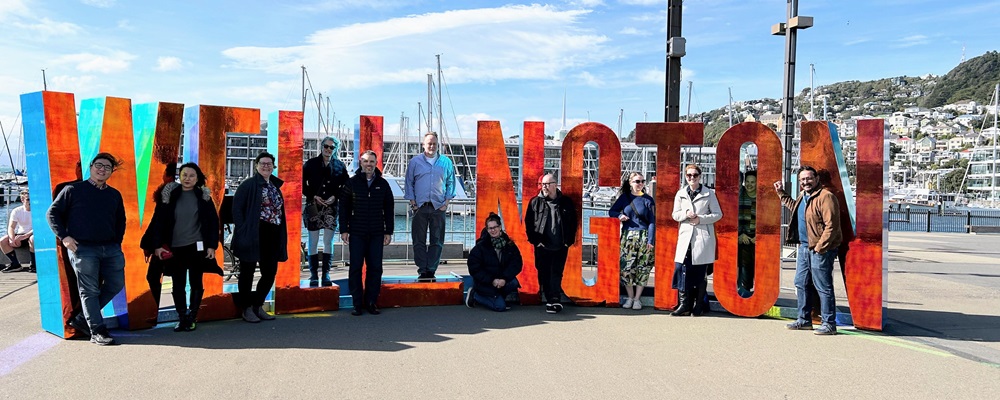
The Wellington digital preservation community, including staff from Te Puna Mātauranga o Aotearoa National Library of New Zealand; Te Rua Mahara o Kāwanatanga Archives New Zealand; Ngā Taonga Sound and Vision, and Te Papa Tongarewa National Museum of New Zealand. Photograph by Valerie Love.
Community
William Kilbride is the Executive Director of the Digital Preservation Coalition (DPC)
World Digital Preservation Day 2024 encourages us to consider the communities in which and for whom we work. The theme ‘Preserving Our Digital Content: Celebrating Communities’ has lots of layers and I am looking forward to hearing the many ways our diverse communities will respond to the theme. One of the initial reasons for creating World Digital Preservation Day was to help the highly distributed but also highly collaborative and welcoming community of digital preservation specialists to connect. That remains as true and as important especially as the community has grown. It also reminds us about the communities whose valuable digital content we are trusted to preserve. As regular readers of this blog will have heard me say before, preservation is not for the sake of the bits and the bytes: it’s about the people and the opportunities. If you are unsure where to start, start there.
Coda and Canon: World Digital Preservation Day 2023
William Kilbride is Executive Director at the Digital Preservation Coalition
- Coda: a passage that brings a piece or a movement to an end.
- Canon: a theme that is repeated and imitated and built upon by other instruments with a time delay, creating a layered effect.
World Digital Preservation Day 2023 adopted a musical turn of phrase with the theme ‘A Concerted Effort’, emphasizing the need for collaboration and partnership to achieve a shared goal. As the saying goes, ‘No one can whistle a symphony, it takes a whole orchestra to play it’. It might be phrased less elegantly: if you’re doing digital preservation on your own, you’re doing it wrong.
In musical terms this blog post is the coda which brings our celebrations to a close. It’s too early for me to take stock of all the different initiatives and outputs which have been shared over the course of the last 36 (ish) hours. I only have space for a few items which caught my eye so a very limited perspective. But here are a few things that, if you didn’t already know about, are worth holding on to:
My year of being a ‘First timer’ with the DPC
Julienne Pascoe is a Digital Archivist for Library and Archives Canada.
Digital Preservation is a collaborative effort, one that benefits from a variety of perspectives, expertise, and multifaceted participation. As a Digital Archivist at Library and Archives Canada (LAC), I work closely with my team in our section, Digital Integration, as well as colleagues in the Digital Preservation section, to perform a variety of tasks and services in ensuring that digital records are transferred, assessed, and preserved for sustainable access in the future. The stewardship of our digital legacy would not be possible without a collaborative, concerted effort with my colleagues who contain invaluable, diverse expertise and perspectives that combine to research and devise strategies for tackling the many nuanced digital preservation challenges. This collaborative effort to ensure continued access to our digital legacy extends to (and relies upon) the community that we are a part of, the digital preservation community, and it is this subject that I would like to discuss in my blog post today. More specifically I would like to discuss my experience as a ‘first-timer’ with the DPC this year, and the value that such a network brings to my role as a digital preservation practitioner.
Working in Concert: The Digital Preservation Community Symphony
Nance McGovern is Associate for Digital Preservation Practice and Instruction at Global Archivist LLC and a DPC Fellow
Digital preservation at its best is a collaborative sport. As always, the theme for World Digital Preservation Day (WDPD) is timely and important.
Collaboration has been an important part of digital practice for me since I started preserving digital content in 1986 at the Center for Electronic Records at the U.S. National Archives. We regularly welcomed visitors from all over who were interested in hearing about our program and in sharing what they were working on with us. An open source approach – sharing, using, and contributing back – contributes to the sustainability of good practice for digital preservation. Welcoming visitors – virtually and in-person – is a relatively easy opportunity for organizations engaged in digital preservation to contribute and to be informed.
It Takes A Team: Planning for Web Archiving at the U.S. National Archives
This blog post has been written by Laurence Brewer, Elizabeth England, Lisa Haralampus, Leslie Johnston, and Markus Most at National Archives and Records Administration (NARA)
Background
The U.S. federal government has signaled how important web content is to the public documentation and experience of government. According to U.S. government website tracking data, every 90 days there are over 5 billion visits to government websites. Enabling long-term preservation of government website content is critical to public understanding of the government and its history.
Bouncing off AI - how I've found it useful
Adam Harwood is Research Data & Digital Preservation Technologist at the University of Sussex
I talk about digital preservation with IT colleagues regularly and I often feel like I am in a position of perceived weakness - lecturing them on technical matters relating to preserving data. Needing a little confidence boost, I used ChatGPT to see what it had to say about the difference between backup and digital preservation. I posted an interesting outcome of this conversation in the Digital Preservation jiscmail list. Its answers boosted my confidence and I no longer feel those nagging pangs of talking nonsense during technical conversations.
The Recommend Formats Statement: the File Format Community Collab
Marcus Nappier is Senior Digital Collections Specialist at the Library of Congress
This year’s DPC World Digital Preservation Day theme, “Digital Preservation: A Concerted Effort” highlights the necessity of collaborative work to achieve digital preservation goals and ensure that our collective digital heritage stands the test of time. I’ve been thrilled to work alongside amazing colleagues at the Library of Congress to annually update and publish the Recommended Formats Statement, a digital preservation guidance tool and culmination of file format nerdiness.
What should our digital preservation policies be? Taking the time to think things through
Heather Tompkins is Senior Project Officer at Library and Archives Canada
As World Digital Preservation Day approached this year, I started to think about what might be worthwhile to share with our digital preservation colleagues across the world. One of the topics that came to mind is the work we are undertaking at Library and Archives Canada (LAC) to develop our digital preservation policies. In 2022, our digital preservation area underwent an audit which resulted in several findings. One finding was to develop a digital preservation policy suite that defines our preservation priorities. Another finding was to have criteria for the acquisition and preservation of digital material that takes into account LAC’s ability to preserve and make them accessible. While we had an overarching policy on preservation, we didn’t yet have clear documentation of these priorities or criteria as it relates to the unique aspects of digital preservation. We internally recognized we could improve how we work, in part, by clarifying these priorities and criteria.
iPRES: Contributing to the Digital Preservation Community
Chris Prom is Interim Associate Vice Chancellor for Research and Innovation at the University of Illinois at Urbana-Champaign
The University of Illinois at Urbana Champaign is proud to release the iPRES 2023 Proceedings on World Digital Preservation Day. We hope you find them profitable and useful for your work.
Doing so is a fitting capstone to the community effort that underpins digital preservation work so evident during the iPRES 2023 meeting, held from September 19 - 22, 2023. As conference co-chair, along with Tracy Seneca, I can truly say that organizing the conference was THE highlight of my professional career to date. The sense of welcome, collegiality, rigor, and fun that the entire conference planning team - our program committee, local organizers, peer reviewers, and supporters - brought to the table, was truly extraordinary and inspiring!
Well-Being of Future Generation Records in Wales
Sally McInnes is Head of Unique Collections and Collections Care at the National Library of Wales.
As a small, smart country, we in Wales are well accustomed to undertaking concerted efforts for the common good, notably reflected by our Well-being of Future Generations Act. This Act is unique to Wales and requires public bodies to think about the long-term impact of their decisions and to work collaboratively. We have certainly delivered the Act in the context of digital preservation, influencing decision making through the creation of a national policy, advocating for investment, skills development and through many collaborative initiatives.
Joining Efforts, a Sure Bet in Digital Preservation
Antonio Guillermo Martinez is the Founder and Head of Product at LIBNOVA.
Este blog está disponible en español a continuación:
One more year we join the Digital Preservation Coalition's initiative to celebrate the World Digital Preservation Day. This year the central theme to reflect on is "Digital Preservation: A Concerted Effort".
At LIBNOVA we firmly believe that a successful digital preservation project is the result of a joint effort between the institution and the provider, which is why we have always advocated a project approach based on cooperation, with the needs of our customers as the driving force for innovation and by engaging in collaborative research projects. But, what does this really mean?
A Guide to the Installation of IsoBuster, IROMLAB and IROMSGL
Niamh Murphy is a Digital Archivist with the Royal Dublin Society.
In our community, optical media imaging is an essential yet challenging task to undertake. Despite the plentiful documentation available in support of this topic, establishing a workflow can leave you questioning: Where do I begin?
Digital Preservation Soup
Ailie O’Hagan is the Digital Preservation Officer at Queen’s University Belfast. She attended the iPRES 2023 Conference with support from the DPC Career Development Fund, which is funded by DPC Supporters.
Starting with Digital Preservation is like making stone soup – the more we come together and pool our resources, the better we can sustain our staff and collections needs.
Celebrating WDPD2023 at the Nelson Mandela Foundation
This video was sent to us by Zandile Myeka, Metadata and Photographs Archivist at the Nelson Mandela Foundation, in celebration of World Digital Preservation Day 2023.
Digital preservation in interesting times
Mark Schroeder is a solution architect in Iron Mountain's Digital Business Unit
We are living in most interesting times…
(Joseph Chamberlain, 1898)

When the collapse of the Soviet Bloc precipitated the breakdown of the German Democratic republic in 1989, the East German Secret Service (Ministerium für Staatsicherheit - Stasi), found themselves holding extensive archives of records. In the forty years of its existence, 91,000 employees of the Stasi and up to 180,000 informants had amassed thousands of linear metres of archive material.
Graveyards and ghosts in web archiving
Alice Austin is the Web Archivist for the University of Edinburgh.
October 1969 was a busy month. Monty Python’s Flying Circus aired for the first time; Steve McQueen, Trey Parker and PJ Harvey were born; and on a dark, dark night (or about 10.30pm on the 29th), a 21-year-old UCLA student called Charley Kline started to transmit a message to the Stanford Research Institute using the Advanced Research Projects Agency Network. He meant to send the word ‘LOGIN’ – but the receiving system crashed at ‘LO’. And thus, the internet was born.
“So I’ve finally procured a digital preservation system, now what?”: Takeaways from DPC Supporter panel
Jenny Mitcham is Head of Good Practice and Standards at the Digital Preservation Coalition
Last month the DPC hosted a series of ‘Digital Preservation Futures’ events designed to showcase the work of our Supporter organizations. The event that kicked off this series was a panel discussion entitled “So I’ve finally procured a digital preservation system, now what?”. The session began with a representative from each Supporter organization giving a short lightning talk in answer to the question posed in the title, and this was followed by a lively discussion and Q&A with the audience. It worked well to benefit from the expertise of all of our Supporters together and in many cases to hear them effectively ‘singing from the same hymn sheet’ and repeating and developing on the points that others had made. With representatives from Arkivum, Artefactual, AVP, boxxe, Libnova, Preservica, and consultant Simon Wilson, this really did feel like ‘a concerted effort’. Pulling together the key learnings from the session into a blog post for World Digital Preservation Day seemed an obvious next step.
Bit List 2023: If digital preservation is possible then data loss is a choice
William Kilbride is Executive Director of the Digital Preservation Coalition
Digits are born vulnerable.
Every single byte of data depends on a global infrastructure of technology, process and people for its meaning and purpose to be realized. Much data serves the moment: it is quickly forgotten in a continuous flow of process and interaction. Other data serve lengthier purposes, as evidence and outputs of transactions that have significant impacts and long duration, longer than the infrastructure and the institutions through which the data was created. Everything in the latter category falls into the scope of digital preservation—the series of managed activities necessary to ensure continued access to digital materials for as long as necessary, beyond the limits of media degradation, technical obsolescence, and organizational change.
The Bit List is not a paper exercise. It was originally conceived as a call to action based on the insight and authentic voice of the global digital preservation community, and it remains so.
World Digital Preservation Day 2023: A Concerted Effort from Autocar & Exact Editions
Ellie Burnage works for Exact Editions based in the UK
“No one can whistle a symphony. It takes a whole orchestra to play it!” Halford E. Luccock 🎼
November has crept around again, and with it World Digital Preservation Day 2023 on Thursday 2nd November. Organised by the Digital Preservation Coalition, this annual celebration invites all data creators, archivists and curators to celebrate the benefits and opportunities enabled by the hard work of digital preservation community.
The theme of this year’s celebration is ‘Digital Preservation: A Concerted Effort’ — and a particular project Exact Editions took on during the last year encapsulates the collaborative work that digitising a magazine archive entails. Haymarket documented over 120 years of automotive history when they extended the archive of Autocar, the world’s oldest car publication, back to the first issue ever published in 1895.
World Digital Preservation Day 2023: Digital Preservation: A Concerted Effort
This blogpost has been written by St George’s, University of London (SGUL) Records Manager Kirsten Hylan, Research Data Support Manager Sarah Stewart, and Archivist Juulia Ahvensalmi.
‘Digital Preservation: A Concerted Effort’ is the theme of this year’s World Digital Preservation Day, celebrating how, by working with colleagues at our university and beyond, digital preservation allows us to both share and gain knowledge, which in turn supports our efforts at digitally preserving our digital records.
Digital Preservation Evolution: Navigating Changing Communities and Collaboration
Jon Tilbury is Chief Innovation Officer at Preservica
In the evolving realm of Digital Preservation, success hinges on collaboration. However, the dynamics of working together, exchanging knowledge and providing mutual support have seen significant transformations over the last few decades.
Since the late 20th century when Digital Preservation emerged as a distinct field, those engaged in it have recognized the importance of tackling its challenges through collaboration within a broader community. However, over that time the nature of those involved and the way information is exchanged around the community have fundamentally changed, and there are multiple communities with different problems and priorities. How do they support each other as Digital Preservation expands and evolves?
Digital Preservation for 5 Year Olds
This blog post has been written by Francesca Mackenzie, Digital Archivist specialising in file formats for the The National Archives (UK) and Jonathan Isip, Assistant Professor at the University of the Philippines School of Library and Information Studies (UPSLIS).
From our own experience starting out in the field of Digital Preservation, and conversations with each other on the subject we had found a recurring theme that the technical jargon can be off putting and often create a sense that the job is more complex than it is. Often glossaries can be quite daunting, so the goal of Digital Preservation for 5 Year Olds was to lower some of the language barriers of entry that maybe didn’t need to really be there in the first place.
Working across communities to ensure an open future for books: views from Copim's Archiving & Preservation team
Dr Miranda Barnes is Research Associate in Archiving & Preserving Open Access Books at Loughborough University
The Open Book Futures project, which began in May 2023 as an acceleration and advancement of the COPIM Project (11/2019-04/2023), continues to focus on the open access monograph, with an emphasis on Scaling Small. This principle “eschews standard approaches to organisational growth that tend to flatten community diversity through economies of scale” (Adema & Moore, 2021). Work Packages in both projects focus more broadly on infrastructure, governance, accessibility, financial models and revenue, metadata and dissemination, and experimental publishing, but also archiving and preservation. It is the combined approach and multifaceted, collaborative interaction of the work packages that leads to our best insights and outputs.
Colour Coding Complexity
Somaya Langley is Digital Preservation Manager at the Science Museum Group
If you’d asked me two decades ago what managing and preserving the memory sector’s digital and audiovisual collections would look like today, the picture I’d have painted would’ve been one where the metaphorical sky contained far more radiant shades.
Celebrating Collaborations, Intersections and Networks of Exchange: Embedded PhD research at the V&A Museum
For the last couple of years, I’ve been an embedded PhD researcher in the Design and Digital curatorial section at the V&A Museum, London. During my time there, I’ve been lucky enough to work alongside colleagues across different departments, both when conducting my PhD research and working on additional projects. So in response to this year’s WDPD theme of concerted efforts, I want to celebrate the value of researcher-institution collaborations, and the power of working at intersections. Because as an AHRC-funded Collaborative Doctoral Researcher, collaboration is quite literally in the name. And as someone working on digital collections care, I continually operate at intersections: between the museum and academia; between curatorial and preservation concerns; and between theory and practice.
Save Our Spiders: Crawler Traps and Sustainability at the UK Government Web Archive
Jake Bickford is a Web Archivist at The National Archives (UK)
Several members of the UK Government Web Archive team were fortunate to attend iPres 2022 in Glasgow, and we were all struck by the emphasis on the climate crisis and our community’s urgent need to address it. A particular highlight for me was James Baker, Rachel MacGregor and Anna McNally's workshop The Climate Crisis and New Paradigms for Digital Access, which challenged participants to identify concrete changes we could make to reduce the environmental harm caused by our work. This theme ran throughout the conference and several of the other interventions are summarised in Matthew Addis’s excellent blog post. We returned home determined not to leave these ideas behind as we resumed our normal routine.
The room of requirement: working together to set up a digital preservation lab at State Library Victoria
This blog has been written by Carey Garvie, Senior Digital Preservation Specialist, Library Systems & Digital Preservation and Susannah Bourke, Digital Archivist, Description Original Materials at State Library Victoria
This year’s theme for World Digital Preservation Day - Digital Preservation: A Concerted Effort feels extremely pertinent to our experience over the last year. In December 2022, State Library Victoria appointed two new Digital Preservation positions. Together these roles have been focused on setting up procedures and equipment for processing incoming and legacy digital acquisitions. One of the first steps has been to set up a working group of staff from across the acquisitions, description and library systems teams who process unpublished digital materials for the collection. This group has been working together to map out current workflows, identify opportunities for improvement and document procedures. While this was occurring a search was also underway for a location to set up the digital preservation equipment.
"No one can whistle a symphony. It takes a whole orchestra to play it!”
Fran Horner is an archivist at the University of Sheffield Special Collections, Heritage and Archives (SCHA)
My name is Fran and I am a new Archivist (or ‘musician’) at the University of Sheffield Special Collections, Heritage and Archives (my ‘orchestra’). Digital preservation (the ‘symphony’) falls under my remit in this new role.
It has been a really interesting experience over the last five months getting to grips with my new role and exploring this ‘orchestra’s’ ‘symphony’. I began by meeting my fellow musicians who manage digital archives and collections (or ‘notations’) which form the basis of the ‘symphony’, such as the Special Collections and Archives Managers, a fellow Archivist, the Library Systems team and the Digital Preservation Manager, Bryony Hooper, to name a few.
Acquiring a Digital Preservation System
Helen Dafter is Archivist at The Postal Museum in the UK
The Postal Museum recently reached a significant step in its digital preservation journey, with the purchase of Preservica. I am celebrating this achievement, and thinking about what we need to do next to get it fully up and running. We wouldn’t have been able to reach this stage without the support and cooperation of many others along the way.
A successful collaboration - working together to capture, preserve and provide ongoing access to the Intermedia microsite
This blog was written by Claire Newing, Web Archivist at The National Archives (UK), Patricia Falcão, Time-Based Media Conservator at Tate, Sarah Haylett, Archives and Records Management Researcher at Tate and Jane Kennedy, Records Manager at Tate
In 2023 - and for the first time in either of our histories of collaborative practice - Tate approached The National Archives about supplying the first in-house captured microsite to the UK Government Web Archive. This was a near reversal of the usual process, by which the TNA regularly captures Tate’s website as part of their collecting remit to “archive central government information published on the web”.
Integrity checking with CSV Validator at National Records of Scotland
Eve Wright is a Digital Archivist at National Records of Scotland
At National Records of Scotland, our current approach to digital preservation is to look outwards. We take small incremental steps to improve our preservation activities gradually, so we are continually dependent upon (and grateful to!) to our colleagues, who make open source digital preservation options available.
One challenge we have recently faced was how we could implement a regular process of integrity checking without any system automation. Our Digital Repository is file system based so there would need to be some kind of tool to look through digital objects and compare checksums against what we produced during ingest.
Audience Awareness
Barbara Sierman is a Digital Preservation Consultant and a DPC Fellow
Imagine digital preservation as a concerted effort and all digital preservationists worldwide as an orchestra playing one big symphony about digital preservation. This is the theme of the WDPD2023, but is it true? I have my doubts, as there is no conductor for the orchestra and no “Great Plan”, but OK, there are sure some good examples of concerted efforts in dedicated projects.
Collaboratively exploring strategies for immersive media
Lieve Baetens is Student Cultural Heritage/Former intern selection and preservation immersive media at the Netherlands Institute for Sound and Vision and is pursuing a bachelor’s degree in Cultural Heritage. She interned at the Netherlands Institute for Sound and Vision where she researched strategies for the selection and preservation of immersive media.
During my internship at the Netherlands Institute for Sound and Vision I conducted the research titled “Collaboratively Moving Forward: Exploring Strategies for the Selection and Preservation of Immersive Media in Cultural Heritage Institutions”.[1] As the name suggests, the research emphasizes the importance of institutional collaboration for selecting and preserving immersive works.
As part of the research, I interviewed fourteen experts in the field from ten institutions in total. I was very pleasantly surprised about how willing everyone was to contribute to the research. From listening to the interviews with these experts on one of my favorite podcasts called “Art & Obsolescence” hosted by Cass Fino-Radin, to being able to meet these experts and talk with them about immersive media made me very happy. As a young professional it was wonderful to experience how welcoming the digital preservation community is. It made me realize that digital preservation truly is a concerted effort.
Open-source and the virtuous circle stimulated by public administrations. The (re)use of e-Archiving by EUDOR, the long-term digital preservation service of the Publications Office of the European Union.
Corinne Frappart is Digital Archivist at the Publications Office of the EU
Introduction
As we recently celebrated World Digital Preservation Day (WDPD) in 2023, we find ourselves standing at the crossroads of history in the field of digital preservation, tasked with the challenge of safeguarding the ever-increasing number of digital artifacts that define our past, inform our present, and shape our future.
The theme for this year's WDPD, "Digital Preservation: A Concerted Effort," underscored the collaborative nature of the digital preservation community's mission. One of the most emblematic examples of this collaboration is the development of open-source software. In this blog post, I will delve into the specific case of the long-term preservation open-source software RODA, and the impact of its use by public administrations leading to improvements that benefit the digital preservation community at large.
A Collaborative Approach to Digital Preservation: The Rosetta Community
Daniel Greenberg is Director of Product Management at Ex Libris, part of Clarivate
The challenges of digital preservation are constantly evolving. New file formats emerge, old ones become obsolete, and the quest to ensure the longevity of digital assets never ceases.
In this changing landscape, one principle remains constant at Ex Libris, part of Clarivate: the power of community-led development. This credo is more than just a philosophy; it's the core of our digital preservation efforts. For us, working with the community is the only way to guarantee a real-life, use-case-oriented system.
WDPD, iPRES 2023 and Digital Preservation: A Concerted Effort
Emily Clarke is Digitisation Lead at Monash University Library. She attended the iPRES 2023 Conference with support from the DPC Career Development Fund, which is funded by DPC Supporters.
As a first-time attendee to iPRES, I wasn’t sure what to expect. I don’t have a background in the technical aspects of digital preservation. I am not a digital preservationist. What was waiting for me in Champaign, Illinois? My concerns that I would be overwhelmed by technical jargon, foreign concepts, and subtle specificity were not to be met. In this blog, I reflect on some of what I learned from the iPRES 2023 conference, particularly how it connects to this year’s WDPD theme of ‘A Concerted Effort’: The importance of a holistic view of digital preservation, and what are we actually doing it for?
Collaboration for Automation at Museums of History NSW
This blog was written by Tara Majoor and Allison Graycon at Museums of History New South Wales
Museums of History NSW manages and preserves the State Archives Collection for the State of New South Wales, Australia, as well as place-based collections of objects and materials associated with our portfolio of historic houses and the Caroline Simpson Collection of publications, objects and materials related to homes, gardens and domestic life in Australia.
The Risk of Entering a Digital Dark Age
This blog was written by Linda Shave for the Records and Information Management Practitioners Alliance (RIMPA)
Australia like many countries around the world is struggling with the rise of a data rich metaverse world, the rise of Quantum information processing and navigating the pitfalls of disinformation, misinformation and malinformation. Traditional approaches for identifying digital archives for digital preservation are not necessarily agile in today’s world. Traditional approaches are not designed for ploughing through the metaverse nor in identifying what is the truth or not the truth. Our future depends on a universal concerted effort to find a way forward in collecting, archiving and preserving digital assets now and into the future or we could risk entering a digital dark age.
RAMping up Collaboration in Aotearoa
Martin Gengenbach is Digital Preservation Policy and Outreach Specialist, National Library of New Zealand
| Te Puna Mātauranga o Aotearoa
Since the inception of the DPC Rapid Assessment Model (RAM) in 2019, the National Library of New Zealand Te Puna Mātauranga o Aotearoa has used the framework annually to identify strengths and gaps in its digital preservation programme, and to adjust resources and initiatives accordingly. However, there was little direct comparison of RAM results between organisations. We were unsure who else was using the RAM within the region, and then COVID-19 related lockdowns proved challenging to many local collaborative initiatives. (But not all of them -- We see you, Australasia Preserves!)
Rokirokitia: A shared effort to digitally preserve traditional knowledge in Māori communities
Paul Meredith is Pou Ārahi – Deputy Chief Executive, Māori, for Ngā Taonga Sound & Vision in Aotearoa New Zealand
Ngā Taonga Sound & Vision has been engaged in an unprecedented programme of community based magnetic media digitisation within indigenous communities. Rokirokitia (a Māori word that can be translated as “to preserve or care for”) was devised and carried out by Aotearoa New Zealand’s audiovisual archive between 2021 and 2023.
Strike up the Band: World Digital Preservation Day 2023
William Kilbride is Executive Director at the Digital Preservation Coalition
World Digital Preservation Day takes a musical turn this year. Recognizing the many roles and skills which are required to preserve digital materials, our theme is ‘A Concerted Effort’.
It’s a wonderful metaphor which invites all manner of variations: we will be striking chords, keeping the beat and mostly all singing the same tunes. We will be hitting high notes, developing themes, and calling for all manner of improvisation. It will reach a crescendo (for DPC at least) with the release of the Bit List. There may even be actual music involved at various points. I am looking forward to the complimentary puns and witticisms that will certainly follow.
The University of Melbourne celebrates World Digital Preservation Day 2023 with a day of reflection and self-directed learning
This blog post has been written by Jaye Weatherburn, Program Manager, Digital Preservation and Elise Bradshaw, Digital Curation and Archives Specialist at the University of Melbourne.
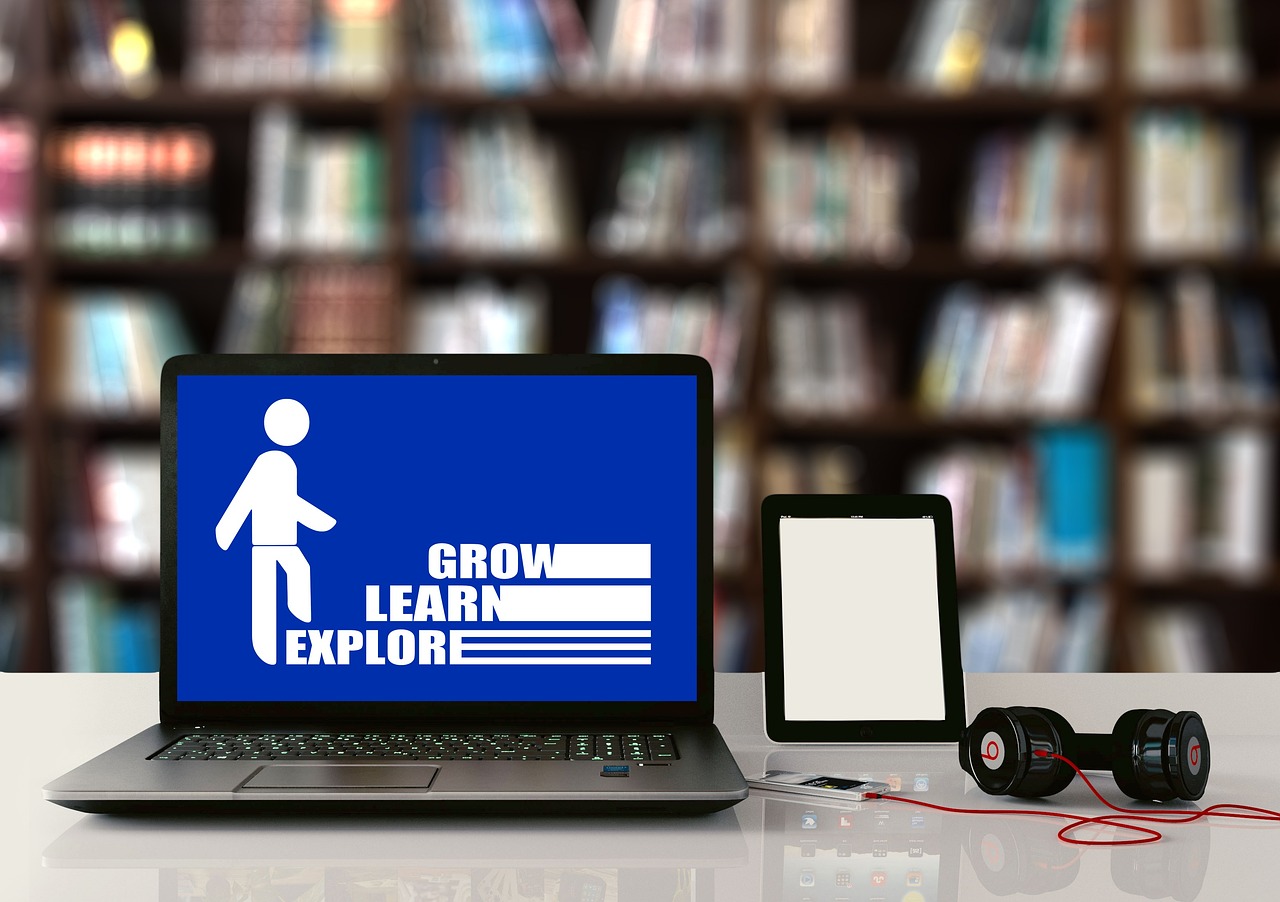
In honor of World Digital Preservation Day 2023 on Thursday 2 November, the Digital Scholarship (Research) team responsible for digital preservation at the University of Melbourne is planning a day of reflection and self-directed learning. This will include advocacy work and watch parties of conference recordings and webinars, as well as a team lunch.
When Friday Comes
The Earth spins. The Sun rises. It’s Friday 4th November which means World Digital Preservation Day 2022 is now over. The Earth will keep spinning and the Sun will keep rising, so the question is what will we do with all those new connections and insights which have been so generously shared? This post is a bit like the morning after election night: it’s too early for the final count but there’s enough to ‘call’ the result. And I am therefore ready to announce World Digital Preservation Day 2022 a success. Maybe even the best yet.
NDSA Leadership Refreshes Foundational Strategy, Now Includes Transparency and Openness
Nathan Tallman is Chair of the National Digital Stewardship Alliance Coordinating Committee
The NDSA held its 10th annual Digital Preservation conference on October 12-13 in Baltimore, Maryland, you can read some highlights from NDSA Leadership on the NDSA News blog. During the opening ceremony, while sharing my remarks as Chair, I mentioned that NDSA Leadership worked over the summer and fall to refresh our foundational strategy. What better day to talk about our refreshed strategy than World Digital Preservation Day!
Our mission statement now reflects that NDSA fosters and incubates communities of practice who advocate, support, and provide expertise in digital preservation through their work, to benefit practitioners, service providers, and memory organizations, as well as the creators, owners, and users of digital content. These changes reflect a more dynamic and engaged NDSA that supports the community in furthering our collective goals.
#WDPD2022: Exact Editions’ Year In Preservation
Ellie Burnage works for Exact Editions based in the UK
Exact Editions is thrilled to be celebrating World Digital Preservation Day once again this year alongside the community of data creator, curators and consumers.
This theme of this year’s event, organised by the Digital Preservation Coalition, is ‘Data For All, For Good, Forever’. With that in mind, we are focussing on some of Exact Editions’ significant events over the past year that have enabled publishers and libraries to improve access to their digital resources both in terms of readership and longevity.
An Update on the BCC Python Study Groups Pilot
This blog post was co-authored by Jess Farrell, Educopia and the BCC, and Sharon McMeekin, DPC.
Happy World Digital Preservation Day!
Today, the Digital Preservation Coalition (DPC) and the BitCurator Consortium (BCC) are excited to announce the transition of the BCC’s Python Study Groups pilot to a program and a new benefit for DPC and BCC members hosted by the DPC.
The BCC Python Study Groups were launched in 2021 by Elvia Arroyo-Ramírez, David Cirella, Jess Farrell, Shira Peltzman, Dorothy Waugh, and Sara Day Thomson in response to a conversation at the 2020 BitCurator Users Forum. Their primary goal was to create a welcoming study space that focused specifically on the cultivation of Python skills in order to support library and archives’ tasks and workflows, empowering practitioners to use Python in their everyday work. Many of us have attempted to learn coding languages independently using online resources, and many have reported that a lack of confidence and time has often derailed these efforts. The BCC Python Study Groups aimed to help overcome these obstacles by building intentional space to learn from each other regardless of where we were starting from.
Digital Curation Lab: An Update from the New Coordinator
Janet Jennings is Digital Curation Lab Coordinator at the University of Salford in the UK
Tucked into a corner of the University of Salford’s MediaCity Campus, the Digital Curation Lab (DCL) houses an array of equipment which indices both nostalgia and possibility. Super 8 and 8mm projectors sit alongside reel-to-reel tape recorders, cassette decks, mini disc players and a copy stand, amongst an array of other devices. It is a space caught somewhere between the past and the future, providing opportunities for revealing hidden histories and creating digital treasure. I recently started my new role here and am excited and intrigued by the possibilities that lie ahead.
File format identification isn't always this hard...
On this World Digital Preservation Day of 2022 I wanted to celebrate file format identification. It is a topic that is central to digital preservation ingest workflows and close to many of our hearts. We are so lucky within this community to have a number of different tools that can carry out and automate file format identification at scale, and of course the amazing resource that is PRONOM that underpins so many of those tools.
Leading up to World Digital Preservation Day I started thinking about what we would do if we didn't have those tools, and also what happens when we have to investigate and interpret each file individually. These thoughts were also triggered by a tweet from Helen Dafter of the Postal Museum about a double file extension that she had recently come across. It was great to see the file format enthusiasts of the digital preservation community piling in to try and help solve the mystery...!
BitList 2022: A Call to Action
The annual review of The Bitlist, the Global List of Digitally Endangered Species, has been a fixed point for World Digital Preservation Day since its inception. This year's revisions are the work of a small task force and have been compiled and edited by Dr Amy Currie, general editor of the list. The following excerpt, the Director's Introduction highlights the major trends and offers a call to action. The full list can be found here: http://doi.org/10.7207/dpcbitlist-22
The BitList 2022 is the third interim review of the list since its initial publication in 2017. It builds on the work of previous BitList juries, and in particular the comprehensive review in 2021.

The BitList 2022 offers a brief update and reflection on the state of the art since the last year. The list was assessed by a Taskforce on behalf of the DPC’s Advocacy and Community Engagement Sub-Committee which guides DPC’s advocacy work on behalf of the DPC’s global membership. The Taskforce were briefed to identify and comment on trends towards increased or reduced risk against every entry on the list as published in 2021. There are no new entries to the list nor has the Taskforce substantially changed, rescoped or restructured entries in the 2021 BitList.
The political cartoon as a resource to narrate the memory of the last Colombian peace process
Johanna Gallego Gutiérrez is responsible for digital deposit for the Collection Development Group at Biblioteca Nacional de Colombia
[la versión en español sigue]
The National Library of Colombia joins in the celebration of Digital Preservation around the world. This year one of the reflections is about what an image tells us about the story. An image can mean a lot or really nothing without a context, in a different year, country or culture.
Adventures of Wilf in the Digital Stacks
Sally McInnes is Head of Unique and Contemporary Content Department at the National Library of Wales
Today is World Digital Preservation Day and an opportunity to highlight the work undertaken by the National Library of Wales to ensure that digital content is preserved for the future. In order to raise general awareness of issues relating to enabling on-going access to digital content, which affect personal as well as organisational data, I would like to introduce you to Wilf.
World Digital Preservation Day 2022: Data For All, For Good, Forever
This blogpost has been written by St George’s, University of London (SGUL) Archivist Juulia Ahvensalmi, Research Data Support Manager Michelle Harricharan, and Records Manager Kirsten Hylan.
‘Data for All, For Good, Forever’ is the theme of this year’s World Digital Preservation Day, demonstrating how digital preservation allows ‘digits to flourish’. What an apt theme for a university that has been transforming health and medical care since 1733! Whether it is developing the earlier practices of variolation into vaccination (introduced by Edward Jenner in 1798) that eventually eradicated smallpox or transforming health practice though our pioneering work in infection and immunity, population health and molecular and clinical research, for St George’s data has always been for good, for all and, with proper care, forever. This post will consider how by preserving records and data regardless of format that are held in the archives and currently being developed by our staff, we are not only ensuring we maintain our history, but that St George’s continues to contribute to ground-breaking medical research by allowing digits to flourish.
Title: Preservation Digitisation Project – Digitising the Tasmanian Archives audio visual collection
Karin Haveman is Acting Manager Government Archives and Preservation at the Tasmanian Archives and Digitisation Services Coordinator
In February 2021, Libraries Tasmania launched the Preservation Digitisation Project – a major collaborative project that brings together Digitisation Services, System Support and Delivery, Government Archives, and the Community Archives teams. The aim of this project is to digitise our Tasmanian film, sound, and video collections for long-term preservation and to provide greater access to our collections for the public. Our priority is our magnetic tape collection which is at great risk of being lost forever if not digitised before 2025 (NFSA paper: Deadline 2025 | National Film and Sound Archive of Australia (nfsa.gov.au))
Let business records flourish!
It is always good to be able to release new resources on World Digital Preservation Day and this year is no exception. The resource I’m going to talk about isn’t exactly a ‘new’ resource, it was originally published and promoted by the Archives and Records Council Wales (ARCW) back in August, but they generously agreed that the work could be repackaged and re-released on the DPC website to ensure that a wider and more international audience could also benefit from it.
Why am I so excited to get this particular resource out on World Digital Preservation Day? Well the theme of World Digital Preservation Day this year is particularly inclusive - ‘Data For All, For Good, Forever’. Much of the work that I do at the DPC tends to have a focus on working with people who are already part of our community, and are already sold on the idea that digital preservation is ‘A Good Thing’. This is all good, but sometimes I am aware of the echo chamber within which I tend to reside.
Funding digital preservation skills development
Natalie Baur is Program Director for DPOE-N
Happy World Digital Preservation Day from your colleagues at the Digital Preservation Outreach and Education Network (DPOE-N)! We are excited to celebrate this important day with you, and we wanted to share some of our resources and funding opportunities that are available to the community.
DPOE-N was created by the Library of Congress in 2010 to provide digital preservation training across the U.S. The program transitioned to Pratt Institute School of Information and New York University’s Moving Image Archiving and Preservation program in 2018 to further develop it and support it into the future. In 2020, DPOE-N received a two-year grant from the Mellon Foundation to support its operations. In 2022, DPOE-N received two more years of grant funding from the Mellon Foundation.
Digipres resources for all, for good, forever
Andy Jackson (@anjacks0n/@anj@digipres.club) & Paul Wheatley (@prwheatley) have shared this post on behalf of all the digipres.org contributors.
Calling All Digital Preservers!
The digital preservation community is small and under resourced. This means we must work together if we want to make the biggest impact. To this end, a small group of us have been attempting to help the members of the digital preservation community better support each other. On World Digital Preservation Day, we'd like to encourage you all to (re)discover what we've built so far:
Reviving Digital Preservation Policies at National Library of New Zealand
Martin Gengenbach is Digital Preservation Policy and Outreach Specialist, National Library of New Zealand
There are many resources to help an organisation draft its first digital preservation policy, including the excellent guide provided by the DPC. There is less information about reviewing and revising policy documentation - though most policy guides recommend a regular process for doing so. Announcing an existing policy revision probably doesn’t sound as exciting as promoting a new digital preservation policy. Once completed, should policy review simply become an unheralded act, subsumed into business as usual?
Digital preservation at the National Library of Australia
Libor Coufal is Assistant Director for Digital Preservation at the National Library of Australia
We are very mindful that it has been (not quite all, but mostly) quiet on the NLA communication front in the last several years, while we have busily worked on implementing our digital preservation program. Our attendance at this year’s iPres (our first since 2014) was a great opportunity to pause and reflect on the progress we have made. We would like to update the community on what we have been up to and the things we have achieved.
For all, for good, forever
World Digital Preservation Day 2022 has arrived.
You might be looking at your watch and thinking it’s still only Wednesday 2nd and not even close to midnight wher you are, but World Digital Preservation Day is a global event. So as the working day begins across the Pacific Ocean, so it's time to get this show on the road.
The theme of World Digital Preservation Day 2022 is ‘Data for all, for good, forever. I am looking forward to a global outpouring of blogs and presentations and tweets and songs and cakes which celebrate and interpret this theme. Almost anyone working in or thinking about digital preservation can have something to say about a theme as open as this. The day has two broad purposes: to raise awareness about the digital preservation challenge; and to help a growing but widely distributed community connect with each other.
Evolving File Format Identification, Migration, and Management for Preservation through Tool Development
Tom J. Smyth (Manager, Digital Preservation) and Maxime Champagne (Digital Preservation Repository Supervisor), Library and Archives Canada
Early this year, it became a priority for LAC’s Digital Preservation unit to reconsider the context of (and affect a major update to) our policy statement on the file formats we accept for transfer of digital library and archival documentary heritage.
In the course of examining the existing documents, a few issues arose for discussion among the preservation divisional staff:
Breaking down barriers in e-only thesis submission: how digital preservation contributes to the conversation at the University of Glasgow
Leo Konstantelos is Senior Assistant Archivist (Digital) in Archives & Special Collections at the University of Glasgow
The Digital Preservation Working Group (DPWG) at the University of Glasgow is a cross-University collaboration working to implement the University’s digital policy and strategy. Established in 2015, the group oversees the delivery of digital preservation services, with representation from the University Library, IT Services and the Data Protection & Freedom of Information Office.
We’ve been busy DP bees recently, assessing Archivematica as a production-level DP platform; reviewing and elaborating on our digital archiving workflow; testing said workflow with born-digital acquisitions at the University Archives; and working on setting up an archival forensics lab. Check our #WDPD2021 posts on Twitter @UofGlasgowASC to see what we’ve been up to!
On Being a Good Ancestor
I had the happy task of opening World Digital Preservation Day about 40 hours ago: but I get the fuzzy end of the lollipop too. Today I have to encourage you back to work. Those Excel spreadsheets aren’t going to screw up the date columns on their own. Oh hang on…
The original idea for World Digital Preservation Day was very simple: to help our far-flung community connect, and to raise awareness about our work. In 2021 we added a theme – we didn’t have themes in the early years – about Breaking Down Barriers to Digital Preservation. Linguists will spot a verb in there, and it’s in the active voice too. So, at least thematically, 2021 has been the most ambitious World Digital Preservation Day yet, with action at its core. There’s a renewed urgency and confidence represented by this theme, growing partly from the many connections and case studies (not to mention cakes and crafts) which have come before.
Urgency and confidence are needed. This last year might be remembered as the year of the great deletion; as the year of obfuscation, misinformation and denial. As technology has become more and more critical to our lives so it has become the means and theatre of division, exploitation and harm. The fragility of digital media has given cover to those who would hide their actions, and misdirection to the gullible who think data loss is inevitable, perhaps even reasonable.
As Richard Ovenden has argued, it’s time to Undelete the Government. My only qualification: not just the UK and not just the government. If I can mix my metaphors, we started World Digital Preservation Day with the idea of breaking down barriers, but perhaps we need to end it by taking to the barricades.
Data loss may seem like a small issue considering the many challenges ahead but rest unassured: corruption, maladministration, disaffection, and incompetence are the inevitable consequences of an entirely avoidable digital dark age.
Enabling reconciliation in Canada: the value of digital preservation
Kelly Stewart is Chief Archivist at Artefactual Systems Inc.
There are many ways to describe the value of digital preservation, but for me it’s fundamentally about enabling memory in the modern world. Whether we want to hold those in power to account for the actions they have taken or use those records in new, previously unimagined or impossible ways as science, culture, and technology evolve, access to reliable and trustworthy digital records is a cornerstone to our collective memory.
Breaking Down Barriers: Collaboration at the University of Calgary Libraries and Cultural Resources
Eilzabeth-Anne Johnson is Electronic Records Archivist at University of Calgary Libraries and Cultural Resources.
At the University of Calgary Libraries and Cultural Resources (LCR), we're in the process of developing our digital preservation program. As part of this undertaking, we've been breaking down the barriers of the ways we communicate with each other and with our colleagues, patrons, and donors outside the institution. Acquiring, cataloguing, migrating, and sharing our digital material all comes with challenges. Learning how best to communicate with colleagues in different departments and with different areas of expertise has been crucial for our projects. While digital preservation can seem like the domain of only archives and libraries, LCR operates eight University of Calgary libraries on campus and across the city. Included in LCR are two art galleries: the Nickle Galleries and the Founders' Gallery at The Military Museums, as well as Archives and Special Collections, the University of Calgary Copyright Office, Research Data Centre and the University of Calgary Press. All these units create born-digital material.
Fixity When Nothing is “Fixed” - Reflections on Upstream Engagement and Digital Preservation
Angela Beking is Data Policy and Research Analyst/Analyste des politiques et de la recherche en les données at Privy Council Office/Bureau du Conseil privé (Canada).
We often speak of the critical importance of upstream engagement in digital preservation work. If we wait until the end of the records lifecycle to begin speaking with Producers about the opportunities provided by digital preservation, we are often too late. That box of unreadable floppy disks. Those files in a format that is not recognizable, let alone readable. That information that was stored on a social media platform, thinking it would be around forever (looking at you, Google +). All of these examples speak to the need for active and engaged digital preservation practice.
But how do we actually “do” upstream engagement? What value can we deliver to Producers, and what can we learn in return? I suggest that there are lessons to be learned in breaking down barriers through upstream engagement that will encourage – or even require – our discipline to reflect on its core assumptions.
Perishable Knowledge: Why digital preservation matters for accessibility
Christopher Zaste is a Digital Archivist at the University of Manitoba.
On September 30th of this year, Canada held its first National Day for Truth and Reconciliation. Throughout the nation, one could see people wearing orange shirts wherever they went. Old, young, Indigenous, non-Indigenous, people of all backgrounds donned this shirt to remember residential school Survivors. While the number of orange shirts are plenteous, the number of residential school Survivors are not. Each year, their number steadily decreases. While archivists preserve the written record in archives, society loses the firsthand experience of those who went to residential school. Human knowledge has a shelf life, and it is the lifespan of the person holding it.
With the loss of this knowledge, people will lose the opportunity to learn about what happened from those who experienced residential schools firsthand. The same can be said for the loss of knowledge for other marginalised groups as their truths often vanish when one of their number passes away. This is a perspective that is not present in the written record, which non-community members often wrote. With its loss, entire communities can lose their voice in history.
We need application signatures! Automating access via emulation with application signatures
Euan Cochrane is Digital Preservation Manager at Yale University Library.
As part of the EaaSI program of work we are aiming to make it as easy as possible to use emulation for long term digital access. One goal we’re trying to achieve is to enable users to automatically open digital objects in their original interaction software. We hope this will break down barriers to the use of emulation and preserved software in long term access contexts.
We currently have a prototype of the Universal Virtual Interactor (which is what we call the tool that automates the automated opening process) that uses file format information and other metadata to match digital objects to interaction software. It assumes that a file matching a specific file format signature (when scanned with a format identification tool), should be opened with the software for which that format was the default, and which was available when the file was created. Even then it reports multiple matches and attempts to order them by best fit/most likely to be “original” (based on dates, etc).
Web Archiving the 2021 Federal Election at Library & Archives Canada – A Look Behind the Curtain
Emily Monks-Leeson, Russell White and Kevin Palendat from Library & Archives Canada.
On September 20, 2021, Canada held its 44th federal election following a 36-day campaign. As Canadians turned to their preferred news and social media outlets, Library and Archives Canada's Web and Social Media Preservation Program began crawling and preserving election-related websites as events unfolded online. This was the sixth election LAC had captured through web archiving, and when it comes to the dynamic nature of such a task, we’ve found that frequency is a friend. We had a background of knowledge and experience to draw on, dating back to 2006 when we archived a modest 21 websites totaling 23 GB of data. Our efforts have intensified with each election to the point where, in 2021, we have crawled over 300 seed URLs totaling around 1.5 TB of data (and counting).
Digital preservation of digital documents of an NGO in Mexico
Claudia Muñoz López is a student of the master’s degree in Library and Information Studies at the National Autonomous University of Mexico.
The following blog is available in Spanish below.
Non-governmental organizations are non-profit associations that provide services to society on the most diverse purposes: education, culture, human rights, environment, hospital aid or support to vulnerable communities, among many others. Their activities have an impact on society and the communities with which they work.
As organizations, documents recording their activities are useful both for the efficiency of the organization itself and for society so that it can understand its history and social, cultural and political influence. However, what happens when most of these documents are digital and do not have a digital preservation plan? E-mail, websites, databases and multimedia files are widely used documents that reflect the day-to-day work of organizations and do not have a paper version.
Generating value with digital preservation in the National Library of Mexico
Ana Yuri Ramírez-Molina, Alberto Castro Thompson, Lisandro Pablo Olivares, Coordinación de Innovación y Estrategia Digital de la Biblioteca Nacional de México.
Due to the events of the pandemic, in Mexico and all around the world, people have modified the way they work and communicate and have turned to new technologies that facilitate digital connections. These technologies are important in the teaching and learning process and can have a significant social impact if used in education as a means of achieving social development. Institutions in charge of safeguarding the knowledge generated by the society play a key role in this permanent process of human development, as they are holding responsibility of ensuring continuity of digital heritage materials as long as they are needed.
See a barrier? Let's knock it down...
Nancy McGovern is Director of Digital Preservation at MIT.
WDPD’s theme Breaking Down Barriers is perfect for this year! I know I’ve been working on all kinds of barriers this year. These are some of my barrier busting examples from this year:
ICA Managing Digital Archives course: This one comes first because it’s the most recent – it’s launching today! It’s been so rewarding to collaborate with Margaret Crockett at ICA, my co-creator, with significant contributions from Kari Smith of Global Archivist. One of our objectives was to help organizations with limited resources, a common barrier, to build their capacity by providing an accessible and comprehensive course that is lifecycle-based and grounded in standards and good practice. More info here: https://www.ica.org/en/ica-online-course-managing-digital-archives
Building bridges with the Big Data of the Past
This post was written by the team of the Time Machine Organisation.
This year´s World Digital Preservation Day’s theme “Breaking Down Barriers” points to how digitisation is the road into the future and holds numerous opportunities in various areas. Moreover, “the aim of World Digital Preservation Day is to create greater awareness of digital preservation that will translate into a wider understanding which permeates all aspects of society – business, policymaking, personal good practice” (cited from dpconline.org) – a conviction that is shared by the Time Machine network and that we would like to outline for you on this occasion.
Breaking Down Barriers: NDSA’s Evolving Role in the Global Digital Preservation Community
Dan Noonan is Associate Professor/Digital Preservation Librarian at The Ohio State University and the Coordinating Committee Chair at NDSA.
This year as we celebrate World Digital Preservation Day, we contemplate how we can break down barriers to enable success, not just for ourselves and our personal institutions and organizations, but for the greater global community. Digital preservation is not a state that is achieved; rather it is a comprehensive set of managed activities that are necessary to provide continued access to digital objects, beyond the limits of media failure or technological change. These managed activities do not happen within one division, department or unit of an institution or organization, nor do they necessarily happen solely within one particular entity. Therefore, it is appropriate to consider the framework for this collective work as an ethos, which is described as the characteristic spirit of a people, community, culture, or organization as manifested in its attitudes and aspirations.
Partnering with publishers to break down barriers to preserving new forms of scholarship
Karen Hanson is Senior Research Developer at Portico.
The scholarly community continues to experiment with new ways to present research. Today’s publications may include features such as interactive visualizations, data-driven experiences, extensive multimedia integrations (often with media hosted on third party platforms), user annotations or comments, non-linear navigation, and more. Meanwhile, keeping pace with preserving this increasingly complex network of born-digital materials is ever more challenging. To preserve these forms of scholarship effectively and at scale, one path forward is for preservation experts, platform developers, and publishers to work together to break down technical barriers for preservation.
The Last Long Mile from Transfer to Ingest
Jeanne Kramer-Smyth is Digital Archivist with the World Bank Group Archives.
There are so many cliches about how hard it is to get from “almost done” to “done”. Cliches like, “the last 10% of the work takes 90% of the time” and “the last mile is the longest” can feel all too real. The barrier I am most obsessed with these days is the “last mile” between transfer and ingest of digital records.
At the World Bank Group Archives’ digital preservation program we are diligent in our efforts to work on all the traditional components of archival work with digital records, including appraisal, transfer, ingest, description, preservation, and access. Each component presents its own challenges, but getting from transfer (which I define as “bringing digital records into archival custody”) to ingest (which I define as “moving digital records into the Digital Vault, our digital preservation platform”) often feels larger than all the others.
New Guidance and Open Source Tools from FADGI
Kate Murray, Digital Collections Management & Services at Library of Congress.
The Federal Agencies Digital Guidelines Initiative (FADGI) Audio-Visual Working Group, a collaborative group of US federal agencies led by Library of Congress since 2007, has had a busy year! We’ve released three updated projects in September to support its ongoing work with developing good practice guidelines and open source tools for digital audiovisual content and digital preservation practices.
Developing a Digital Preservation Training Plan at NARA
Elizabeth England, Digital Preservation Specialist and Leslie Johnston, Director of Digital Preservation both from the U.S. National Archives and Records Administration.
As part of its Digital Preservation Strategy, the United States National Archives and Records Administration (NARA) has goals associated with the ongoing review of its program and with ensuring that agency staff have appropriate training. Discussions with our internal digital preservation advisory group confirmed the findings from our ISO 16363 self-audit in 2019 that NARA staff in a variety of roles are unfamiliar with the goals and activities that are part of digital preservation, as well as the technologies used, NARA-specific activities and programs, and the regulations and guidance that NARA produces and abides by to ensure that the permanent born-digital and digitized records of the federal government are managed, preserved, and made accessible.
Web Archiving Projects as a Path to Cross-Department Collaboration and Building a Broader Audience for Digital Preservation Activities
Teresa Soleau is Digital Preservation Manager and Alexis Adkins is Institutional Archivist. They work at the J. Paul Getty Trust.
As one of the newest members of the DPC we are thrilled to start working more closely with others in the digital preservation community, hearing about their work and sharing ours. As a first step in that direction, we’re going to share with you some web archiving work we’ve done in the past year. At Getty we don’t have a specific person dedicated to web archiving so the work is done collaboratively between staff in Institutional Records and Archives and Getty Digital.
Memoria constituyente: Preservación digital del patrimonio documental de la Convención Constitucional
Gabriela Andaur Gómez, Archivera del Archivo Electrónico del Archivo Nacional de Chile //
Gabriela Andaur Gómez, Archivist of the Electronic Archive of the National Archive of Chile
[ENGLISH FOLLOWS]
Quienes trabajan en instituciones comprometidas con el patrimonio documental, saben que puede resultar desafiante transmitir la relevancia y urgencia de la preservación digital como área de desarrollo permanente. La complejidad del trabajo técnico y la necesaria inversión de recursos que implica, pueden ser difíciles de justificar cuando los resultados no son visibles de manera inmediata. Por el contrario, sabemos que el valor de la preservación digital se revela con particular fuerza en la medida en que transcurre el tiempo, mucho más allá de lo que el corto plazo nos permite anticipar.
Considerations on the barriers to the practice of digital preservation
Amarílis Corrêa is an Academic Librarian and Researcher on digital preservation in São Paulo, Brazil / Amarílis Corrêa, Bibliotecária acadêmica e pesquisadora em preservação digital
[PORTUGUESE FOLLOWS]
For some of us, there seems to be no barriers to digital preservation; for others, too many. Is the grass always greener on the other side of the fence? For me it is, considering I haven’t had the opportunity to implement any part of the digital preservation process in the institution where I work.
My Backwards Walk – Thinking About a Decade at the DPC
13th June 2021 was the 10th anniversary of my first day with the DPC, the point where I made the switch from practitioner to a focus on workforce development. Such a significant milestone has naturally led to time spent reflecting on years past and hopes for the future.
As with any experience in life, my decade with the DPC has brought a combination of highs, lows, and plenty places in between. But thankfully I can report that the highs massively outnumber the lows. In my family, our unofficial motto is that “it’s all about the stories” and I can say with all confidence that my time with the DPC have given me more interesting stories to tell than I could possibly count. So, overall, I think that my time with the organization has been a success.
The Cariniana Network for Digital Preservation
Miguel Ángel Márdero Arellano is Cariniana Network Coordinator at IBICT and José Carlos Abbud Grácio is President of the Permanent Commission for Digital Preservation UNESP.
A network of digital preservation services
In many countries, experiences in the implementation and actions of digital preservation have aroused the interest of heritage institutions, which seek to formalize preservation strategies through policies and action plans in different infrastructure contexts and aimed at digital collections of different natures and scenarios. In Brazil, the work area of digital preservation is still little known, despite this, the practices of digitization and creation and repositories in the country converge in digital preservation actions in spaces where norms, tools and digital archiving systems are formalized.
Digital preservation in Brazil as an institutional practice is still linked to relatively restricted experiences. The perspective of expanding procedures and institutionalizing policies in this field involves the structuring of archive networks, or libraries, which contribute to disseminate technologies and support services, promote the sharing of collections and expand the possibilities of exchange between dedicated researchers to the same themes.
Presentation of the French translation of the Digital Preservation Handbook
[la version française suit]
Since 2019, France has had a Cellule Nationale de Veille sur les formats (National Formats Watch Unit), under the aegis of the French association Aristote and its working group on the Preservation of Digital Information (PIN). The Cellule currently brings together a dozen private and public partners. Its main objectives are to share monitoring activities on formats, to raise awareness among professionals on the subject, and to contribute to or influence the associated tools. It aims to be a recognised French-speaking interlocutor in international work on these subjects.
Breaking Down Barriers: Harnessing the power of our people
This blogpost has been written by St George’s Records Manager Kirsten Hylan, Archivist Juulia Ahvensalmi, Records Manager Kirsten Hylan and Research Data Support Manager Elizabeth Stovold.
The World Digital Preservation Day theme for 2021 is ‘Breaking Down Barriers’ and focuses on how digital preservation supports digital connections, unlocks potential and creates lasting value. In this post we’ll look at the work we’ve been doing to identify areas in the university holding records of interest for long-term preservation. By connecting with people and areas of the university who previously were not involved in the project we are unlocking the potential of the records and creating lasting value.
You can engage with the day and find out more about our work on the Museum and Archives Twitter account, and using the hashtags #WDPD2021 and #SGULwdpd2021.
Being brave and making connections at the University of Hull
Laura Giles is the City of Culture Digital Archivist at The University of Hull, UK
We’ve blogged before about our work on the City of Culture digital archive and now in keeping with the Breaking Down Barriers theme of this World Digital Preservation Day we’re now thinking about the ways that the City of Culture digital preservation work can help us open doors across the university to build relationships and embed good practice around the creation, storage and eventual preservation of digital records.
Community archives & digital preservation – Breaking down barriers
John Pelan is the Director of the Scottish Council on Archives
The digital archives of community groups were added to the DPC’s Bit List under ‘Critically Endangered’ in 2019 due to a number of identified aggravating conditions. These included: poor documentation; lack of continuity funding; dependence on small number of volunteers, conflation of backup with preservation; and distrust of official agencies, e.g., local authorities and national collecting bodies.
Hello, World! Welcome to the first Digital Preservation at Cambridge University Libraries (CUL) post
Caylin Smith is Head of Digital Preservation at Cambridge University Library.
This post was originally published on the Cambridge University Libraries Digital Preservation blog and can be found at this URL: https://digitalpreservation-blog.lib.cam.ac.uk/hello-world-fa267483a86d
Welcome to the first Digital Preservation at Cambridge University Libraries (CUL) post!
CUL is a network of libraries at the University of Cambridge comprised of Cambridge University Library, the main research library for the University, as well as faculty and departmental libraries.
Digital preservation is incredibly important to the Libraries. This discipline is fundamentally about ensuring access to digital materials for as long as necessary — and that’s what staff working in this area at CUL help achieve for digital materials created or acquired for library collections. We’re keen to share news of what we’re working on because the impact of our digital preservation work will extend right across these libraries.
Lloyds Banking Group: The Dark Horse goes Digital
Peter Judge is Archivist for the Lloyds Banking Group Archives & Museum
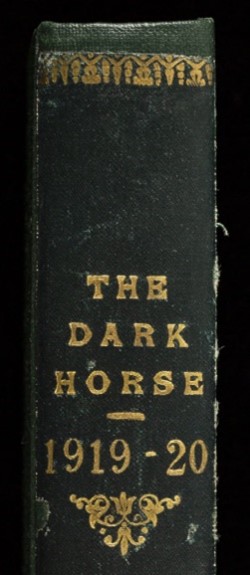
Prior to 2020 at Lloyds Banking Group Archives we had been making plans to digitise parts of our collections. Then, like so many other organisations, we found ourselves in a situation where lockdown restrictions were limiting our access to the archives. Given how much of our work is tied to a physical space, this added extra impetus to our plans for digitisation.
Audiovisual Preservation at Wellcome Collection
Christy Henshaw is Digital Production Manager at Wellcome Collection in London
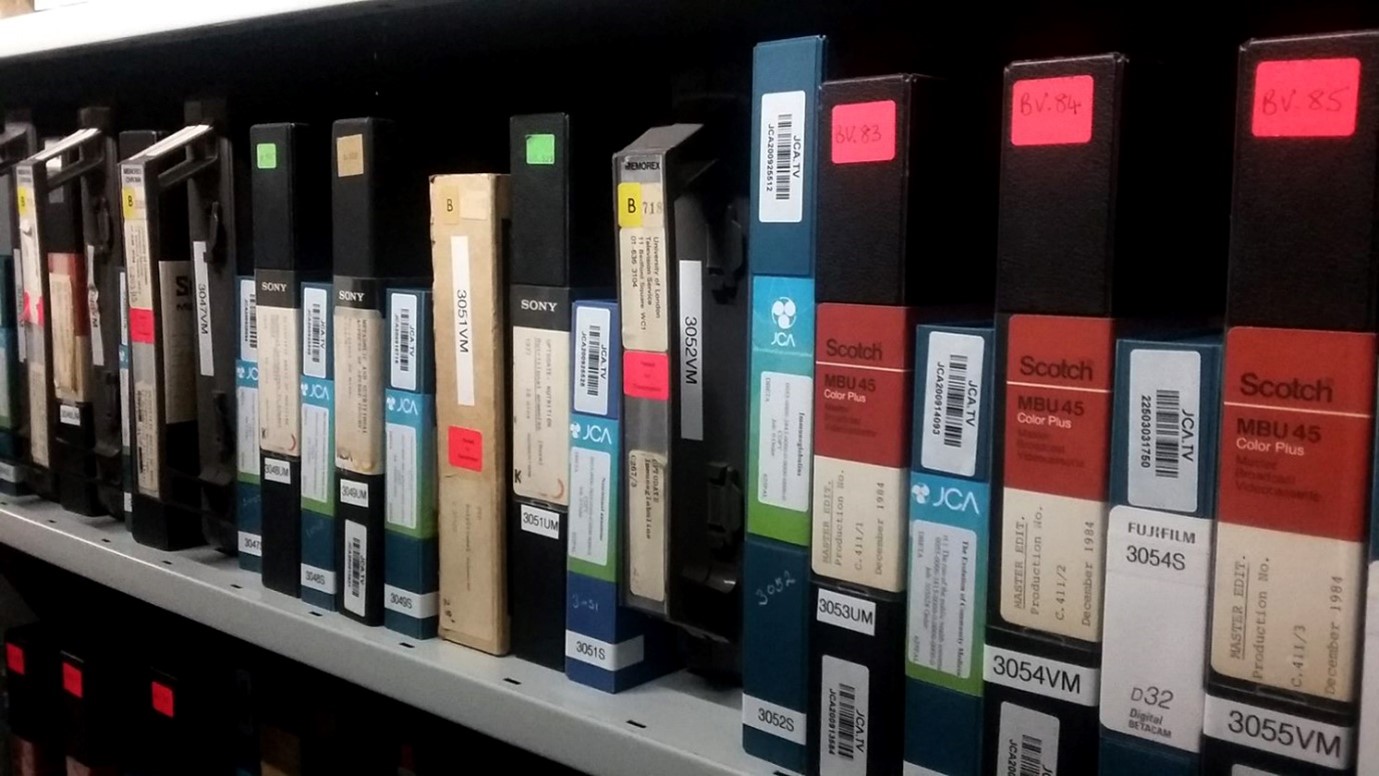
Wellcome Collection, like many archives, has a tape problem. Video or audio, good condition or bad, tape archives present a major challenge for preservation and access. We hold hundreds of unique and distinctive works on tape formats, and regularly acquire more through our acquisition programme.
Digital preservation: locking and unlocking the lasting value of digital content
Sue Trombley is the Managing Director of Thought Leadership at Iron Mountain.
Modern civilisation is becoming more and more defined by the rapid evolution of technology, and its equally rapid obsolescence. The cultural heritage we create for future generations now largely exists in the form of ones and zeros found in myriad formats and in countless data storage systems. On top of that is the fact that we generate exponentially greater volumes of data every year.
When it comes to physical media, a book that is centuries old is fundamentally the same as one we print and publish today, and if preserved properly, is equally accessible today. When it comes to digital media, however, it is a very different matter. Devices and formats have changed almost beyond recognition in the last couple of decades, many are wholly incompatible with one another and many files can no longer be read due to platform obsolescence. This gap will only widen if we fail to pay attention to the importance of digital preservation in enabling lasting value.
3D scanning and virtual reality environments at the University of Bristol.
Emma Hancox is Digital Archivist at the University of Bristol.
As well as digitising two dimensional materials, at the University of Bristol we have been experimenting with three-dimensional scanning methods. We are actively engaged in digital preservation and the creation of 3D scans creates its own set of challenges. In terms of access, we have started working on ways of increasing interaction with the 3D models we create breaking down barriers, giving our collections a wider reach and unlocking their potential in the long-term.
Isolated Together: Virtual Collaboration for the Advancement of Open Source Digital Preservation Tools
Charlotte Armstrong is Project officer for the Open Preservation Foundation
In 2020, amid a global pandemic that isolated many people from their professional communities, the Open Preservation Foundation (OPF)’s Spring Hackathon brought together an international group of contributors to enhance open source digital preservation tools and documentation relied on by digital preservation practitioners around the world.
Long-term sustainability: what does it REALLY mean for your digital content?
Jon Tilbury is Chief Innovation Officer at Preservica
Institutions and individuals working in Digital Preservation are rightly concerned about the long-term sustainability of the technology or service providers they trust to look after their material. However, the meaning of “sustainability” is much broader than often appreciated.
Keeping it FAIR: Providing Access to Reusable Data at the Archaeology Data Service
Olivia Foster is Digital Archives Officer at the Archaeology Data Service in York, UK
Staff at the Archaeology Data Service (ADS) have been busy over the last year archiving the data deposited with us, collaborating with partners and rolling out the new OASIS online archaeological reporting system. Digital preservation is one of the core activities of the ADS and as a digital archive we preserve and make publicly accessible archaeological and heritage data in our archives and the ADS library.
The National Archive’s new Transfer Digital Records Service: The Hard Drive forward
Kirsten Arnold is Service Owner for Digital Selection and Transfer at The National Archives in the UK
Hi. I’m the Service Owner for Digital Selection and Transfer (DST), working within Digital Archiving at The National Archives (TNA). DST works closely with records creators to help them understand, provide advice and facilitate the transfer of their selected digital public records to The National Archives. These record creators specifically are public record bodies, and in the main UK government departments.
Breaking down barriers with DiAGRAM
David is a senior digital archivist at The National Archives in the UK.
Original development
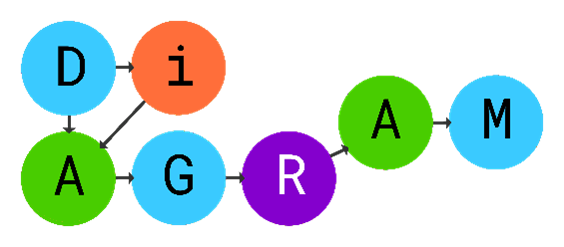
With DiAGRAM (the Digital Archiving Graphical Risk Assessment Model) we are trying to break down barriers to digital preservation in two ways: firstly, to help archivists make progress with digital preservation by showing them which interventions will have the greatest impact in reducing the risks to their digital materials; secondly by making sure that the tool itself does not present barriers to being used by anyone who needs it.
Breaking down Barriers in Wales Through the Iffy Tiff
Sally McInnes is Chair of the Archives and Records Management Digital Preservation Group at the National Library of Wales
In Wales, we have been working for many years to break down barriers to digital preservation through working collaboratively to increase capacity and skills. The publication of the National Digital Preservation Policy and accompanying Technical Appendix, on Digital Preservation Day in 2017, aimed at ensuring digital resources of enduring value would be selected for preservation and remain authentic and accessible in the future and to raise awareness of the importance of digital preservation for stakeholders and decision makers. The policy framework is supported by the development of a technical solution, which links Archivematica, Fedora and the National Library of Wales’s Digital Archive, whilst providing access to content through the discovery systems which are managed by the partners.
Building relationships and building collections
Rachel MacGregor is Digital Preservation Officer at the Modern Records Centre, University of Warwick
Making connections with people is always important when working in digital preservation – without connecting with our creators and our users (potential and actual) there is nothing to preserve and no one to preserve it for. We can sometimes get too focussed on our digital collections as a bunch of bits and bytes but in very real terms what we have is stories and experiences, told through a dizzying variety of file formats, content types and platforms. It’s our job to make sure those stories are preserved – and the context around them – to make them meaningful and accessible for future generations.
New Models for Preservation: Photogrammetry at the University of St Andrews Libraries and Museums
Sean Rippington is Digital Archives and Copyright Manager at the University of St Andrews
Photogrammetry – taking overlapping photographs of an object and converting them into 3D digital models – has become business as usual for the University of St Andrews Libraries and Museums. Driven by the push to provide more, different, and better types of online access to our collections for teaching and learning during the pandemic, we now have over 170 examples on our IIIF-based Collections site. Many of the models have already been used in our Exhibit teaching and engagement tool, developed to provide new, curated, almost tactile encounters with digital objects. Some of our favourites include:
From an acorn (bit) a mighty oak forest (repository) grows: Developing digital preservation capability in Nottingham
Jaana Pinnick is Grants Manager and Research Data and Digital Preservation Manager at the British Geological Survey
A.K.A. a brief timeline of the digital preservation journey at British Geological Survey (BGS) and National Geoscience Data Centre (NGDC) over the last few years
Around this time in 2016, the initial thoughts I had had to explore digital continuity and preservation needs at BGS were starting to develop further. I had finished my MSc thesis on “Exploring digital preservation requirements: A case study from the National Geoscience Data Centre (NGDC)” which led to my first peer-reviewed article being published in the Records Management Journal. During my studies I had discovered that our parent body UKRI (then still RCUK) was a member of the DPC, so I approached Juan Bicarregui, Chair of the DPC who works at the Science & Technology Facilities Council (STFC) to ask if I could join. I soon got in the habit of attending DPC events, meeting William, Sarah, Paul and others, not forgetting other digital preservationists from around the world and learning a lot from them. Their jobs sounded fascinating so I took a Post-Graduate Diploma in Digital Preservation at the University of Aberystwyth with Sarah Higgins, and learned some more. But what next?
The WDPD2021 file format karaoke!
World Digital Preservation Day is a chance to talk about our digital preservation challenges and some of the progress we have made, both individually, and as a community. Of course, it is also a chance for the community to come together and have a bit of fun in the name of awareness raising.
One of the things I enjoy most about World Digital Preservation Day is the musical contributions. There is no doubt there is some talent in our community of digital preservationists.
But this year I wondered what would happen if we invited our file formats to take to the floor and have a go at singing. As you can see, they embraced this challenge with great enthusiasm.
Deletion Rebellion: The BitList in 2021
There’s a paradox about World Digital Preservation Day this year. 2021 might well be marked as the year of the great deletion. Barely a day has passed without a news story about some curious deletion or obfuscation which has inhibited prosecution, denied transparency, disrupted science or defeated accountability. And yet, the digital preservation community has grown in number and in skills over this same period. What’s going on? How can both of these statements be true at the same time? The BitList provides something of an answer: that capability is ahead of policy.
FAIR today, FAIR tomorrow and FAIR forever
Matthew Addis is Chief Technology Officer at Arkivum.
The theme of this year’s World Digital Preservation Day is ‘Breaking Down Barriers’. A great example is recent work on how digital preservation can help ensure scientific data will remain accessible and usable for decades to come. The European Open Science Cloud (EOSC) is bringing together the communities of scientific research and digital preservation to break down the barriers that currently jeopardise the long-term access to hugely important scientific datasets and results.
This is happening both at a strategic level, for example through EOSC’s working group on sustainability that includes a task force on long-term digital preservation (LTDP), and on a very practical and technical level, for example through the ARCHIVER project that is developing new LTDP services for EOSC. Arkivum has been privileged to work in ARCHIVER to find new ways to do cost-effective, scalable, and environmentally friendly digital preservation at scale (more on that below).
Applying for CoreTrustSeal: Part 1
Lee Hibberd is Digital Preservation Manager at the National Library of Scotland.
For many years the National Library of Scotland has talked about joining the great and the good and certifying our digital preservation and access activities against CoreTrustSeal (https://www.coretrustseal.org/). If you’re unfamiliar with Core Trust Seal it is a certification scheme for trustworthy data repositories. Sixteen core criteria are assessed and it's up to you to provide evidence of how your institution satisfies each of them.
Part 1 of this blog is an account of our positive experience up to the point of submitting our application for review in summer 2021. Part 2 will cover “what happened next” and some of the challenges we faced along the way. This will come shortly after gaining the seal. We’re not being presumptuous here – we are simply committed to undertaking any additional work we need to do to demonstrate our competence to the reviewers. The point of the application is not to gain a shiny badge but to improve what we do, and this sentiment is well shared in blogs by other DPC members (see box below with some links).
Saved by digital preservation
Kunika Kono is Technical Lead for Digital Humanities at the Digital Humanities Research Hub, School of Advance Study, University of London
Over the last year, many universities in the UK faced organisational restructure, departmental closures and job cuts. The School of Advanced Study and its institutes were no exception, and in February 2021, the Digital & Publishing department in the Institute of Historical Research (IHR), where I worked, effectively closed.
On Gardening and Digital Preservation… A year of reflection and better engagement
Garth Stewart is Head of Digital Records Unit at the National Records of Scotland
As a practical discipline, tending to a garden feels quite similar to digital preservation: it can never be considered ‘done’. Whatever the season, wherever you are in the world, there’s always something to do; whether it’s the laying of a new lawn (or the installation of a new piece of digital storage infrastructure), the sowing of a new flower bed (or the ingest of new image files), applying fertiliser (or using characterisation tools to enrich metadata), or the odd bit of dead-heading (or the rare act of de-accessioning). Gardening - and digital preservation - are engrossing, progressive, life-long activities.
Remote but connected: students and digital collections
Laura Peaurt is Digital Preservation Officer at Manuscripts and Special Collections, University of Nottingham Libraries.
World Digital Preservation Day always provides a welcome prompt to pause and reflect on our digital preservation journey over the last twelve months. This year we have been asked to consider how digital preservation supports digital connections, unlocks potential and creates lasting value.
At Nottingham Manuscripts & Special Collections we have been begun to realise the opportunity provided by our digital preservation system to encourage broadening access to and use of our digital collections. This includes both our previously hard to access analogue materials (such as VHS and cassette tapes) as well as newly acquired born digital content collected on CDs, DVDs, and floppy disks over the years.
Inspiring curiosity: Increasing access to collections at University of the Arts London
Elisabeth Thurlow is Digital Preservation and Access Manager at University of the Arts London.
Whilst the first phase of the University of the Arts London (UAL) Digital Archives and Collections project aimed to introduce a digital preservation programme including the implementation of a new digital preservation system, the second phase focused on increasing access to the University’s growing digital collections. This led us to the development and recent launch of a new Digital Collections portal.
The university-wide Project focused on digital materials found in its archives, museums and special collections - which include images, video and sound recordings, and an increasing number of born-digital artworks.
‘Bringing the world’s treasures to your desktop’ – digitally preserving the works of Dylan Thomas (1914 - 1953) and Elizabeth Montagu (1718 - 1800)
Alexander Roberts is the Digital Humanities and Research Data Manager at Swansea University.

Over the last 3 years, Swansea University Library has been on a digital preservation journey to increase access and engagement with two important world-class physical collections currently held in the Harry Ransom Centre, University of Texas at Austin, and the Huntington Library, California.
National Libraries, Universal Challenges, and Digital Preservation
Daniel Greenberg is Product Manager for Digital Resources Management at Ex Libris.
The theme for World Digital Preservation Day this year is “Breaking Down Barriers,” highlighting how digital preservation supports expanding horizons for libraries and other institutions. For national libraries, this expansion comes with some unique considerations and best practices.
But let’s take a step back and look at the basic challenges national libraries face in managing preservation of their digital assets.
Digital Curation Lab: leveling up, shortly
Lamia Sassine is Digital Curation Lab Coordinator at the University of Salford
As a relative newcomer to digital preservation the theme Breaking Down Barriers really spoke to me. My background is in archaeology and museum studies, but I started to get attracted to digital curation during my PhD. My research investigated perceptions of Phoenician collections from 20 different museums, and I envisioned the best way to bring them together would be through a digital platform, but this is a story for another time.
What are we missing? Completeness checking with e-journals and why we should care
Micky Lindlar is Digital Preservation Team Leader at Technische Informationsbibliothek (TIB).
A few weeks ago I watched the recording of Helen Hockx-Yu’s excellent presentation on “The obsession with checksums”. In one of the slides Helen talked about “A matter of where to spend energy”, listing her top 5 priorities. One of those priorities is “overlooked things that have lead to data loss”, e.g. “not collecting content”. This really reminded me of the current work we – that is TIB’s digital preservation team – are doing around e-journals and completeness of metadata as well as content.
You might ask yourself now “what does digital preservation have to do with completeness checking and why should I care?”. Life is easy when you interact with a data producer who signs responsible for the completeness of a deposit. But what if you’re tasked to interact with a repository that you harvest data from? Or if you deal with really large deposits (e.g. more than 5 million articles)? And, as a collecting institution, do you blindly trust a manifest given to you by a publisher or do you need to cross-check? Things were easy in the analogue days. The library would receive a journal issue, all articles would be contained within that printed publication and at the end of the year all issues would be bound together in a volume. Not today, my friend!
Which checksum algorithm does everyone use? Introducing the NDSA Fixity Survey Report
Almost a year ago now, the DPC published a Technology Watch Guidance Note from Matthew Addis entitled ‘Which checksum algorithm shall I use?’. It was really helpful at the time to summarise and condense advice and good practice on checksums and their use in digital preservation (and of course help people to make that all important decision on which checksum algorithm to pick).
Without a doubt, checksums are of key importance to our work in digital preservation. Use of them is regarded as good practice (as encapsulated in models such as the NDSA Levels of Preservation and DPC’s Rapid Assessment Model and certification standards such as CoreTrustSeal and ISO16363), but there is still a gap in our knowledge.
How do we know exactly when to create them, which tools to use, how frequently to check them, which events would trigger their use, what to do in the event of a failure...and of course, which algorithm we should use to create them? Where is the step by step handbook to provide all the answers?
Of course, there isn’t one.
Digital Preservation of Community Archives: Breaking down barriers to digital preservation through training
Dr Deborah Thorpe is Education and Outreach Manager for the Digital Repository of Ireland
This autumn, the Digital Repository of Ireland (DRI) held an online introductory training programme in digital preservation for our members, with a particular focus on the training and community-building needs of community archivists. This course has been helping with breaking down barriers to digital preservation, by making topics such as appraising your digital collections for preservation, data protection, and metadata preparation understandable, relatable and accessible to all. ‘Understandable’, because we recognise that every individual who attends DRI training has a different level of existing knowledge of digital preservation processes; ‘relatable’, because sometimes it can be difficult to identify how the intricacies of topics such as GDPR or anonymisation relate to a particular digital collection; and ‘accessible’, because many community archivists are volunteers who do not have expanses of time or resources to spend on either undertaking training or preparing their collections for digital preservation.
Upskilling and upscaling: digital preservation at the Houses of the Oireachtas Library
Kate McCarthy is Special Collections Librarian and manager of digitisation projects at the Houses of the Oireachtas Library
It’s late in the evening. Do you know where your children are? And by children of course I mean all those digital files you’ve happily brought into existence in recent years. The documents, images, and datasets. The hundreds of thousands of tiffs, jpegs, pdfs, mp3s, mp4s and xml files. Are they under the supervision of a digital preservation system? Hanging out on a Cloud account? Loitering on a local server? Idling on an LTO? Waiting to be collected from an external hard drive in a desk drawer that you haven’t opened for two years?
Breaking down the barriers between refugee voices and the future
Tom Wilson is Associate Archivist (Digital Preservation) at the UN High Commission for Refugees
Breaking down barriers is something that often appears in the day-to-day work of UNHCR albeit, more often than not, in the metaphorical sense. Whether it’s providing shelter for refugees, access to healthcare, informing the public of the plight of refugees and other persons of concern or one of the many other activities that UNHCR carries out, UNHCR seeks to remove the barriers that can prevent people fleeing from conflict from reaching safety. Part of this work is done on the internet and by amplifying the voices of refugees or advocating on their behalf and this is where UNHCR’s web-archive comes in to help preserve this content for posterity.
Update on the work of the PREMIS Editorial Committee
Karin Bredenberg, Marjolein Steeman, Tracy Meehleib are part of the PREMIS Editorial Committee
 First of all, thank you for the feedback you have given us in response to last year's call to action! We also want to express our big thank you for the Brazilian Portuguese translation of “Understanding PREMIS” and the updates made to all of the other translations! We’ve been busy putting your feedback recommendations into effect and it’s fair to say that 2021 has been a very productive and--at the same time--a very strange year for the PREMIS Editorial Committee! We’ll start with the productive and end with the strange.
First of all, thank you for the feedback you have given us in response to last year's call to action! We also want to express our big thank you for the Brazilian Portuguese translation of “Understanding PREMIS” and the updates made to all of the other translations! We’ve been busy putting your feedback recommendations into effect and it’s fair to say that 2021 has been a very productive and--at the same time--a very strange year for the PREMIS Editorial Committee! We’ll start with the productive and end with the strange.
Breaking Down Barriers as part of our DNA
Antonio Guillermo Martinez is the CEO and founder of LIBNOVA.
Este blog está disponible en español a continuación:
Last year, in our guest post on the DPC blog we wrote about the challenges of the digital preservation of research datasets, and unknowingly it was slightly related to this year's chosen topic: Breaking Down Barriers.
This year, we want to focus on some of the technological barriers that LIBNOVA has broken down to make digital preservation more accessible to the community by simplifying it.
Historically, digital preservation systems have been complex to use and complex to set up. When we first met this community, everything was complicated, everything was difficult to do. LIBNOVA has focused every single day since its inception on breaking down those barriers, empowering the community to do more with less, and optimizing its systems to help them achieve that.
UCT Libraries on the road to digital preservation
Ya’qub Ebrahim and Thandokazi Maceba are both Data Curation Officers at University of Cape Town Libraries, Digital Library Services.
For a number of years now we have planned and strategised and now it’s time to implement. Implement what you ask? Well, it all started in 2015 when UCT libraries had the vision of creating two Data Curator positions in the Digital Library Services department. Fast forward to 2018 and we have successfully scoped and motivated for implementing a digital preservation system. Finally in 2021, this system, which we have named Izolo (isiXhosa for ‘Yesterday’) is installed and set to store not only historic, or ‘special,’ collections at the University, but all data requiring preservation at UCT[1]. But, policies aside, as the data curators and preservation experts we see our job as being to ensure that data gets preserved, period.
Digitisation and Digital Preservation journey at Unisa Library and Information Services
Ansie van der Westhuizen is Non-commercial Digital Developer (Institutional Repository) and Anri van der Westhuizen is Manager of Archives. They both work at the University of South Africa (Unisa).
The Unisa Institutional Repository (UnisaIR) was launched in May 2009. Challenges and barriers were the order of the day. During a conference in Senegal, Nkosi (2008) rightfully called these barriers by name: mistrust, resistance and lack of skills. At present the UnisaIR is still operating as a “traditional institutional repository”. However, it became and remains a flagship service offered by the Unisa Library and Information Services and is continuously breaking down barriers.
Encountering barriers along the way – Why networks are a part of the solution
Svenia Pohlkamp Runs the nestor office at the German National Library
When asked to write a blogpost to be published on this year’s WDPD I started thinking about the motto “Breaking down barriers”, digital preservation and my work at nestor. In the end I had a disturbingly long list of barriers in my mind, that I needed to order and bring into perspective. This text is the result (though it does not deal with every barrier I could think of) and it tries three things at once: Relating my experiences of working in a network while people are advised not to meet, looking into barriers that are relevant to our work in digipres and letting you know what nestor is all about.
Should Digital Preservation be Perfect?
Irina Schmid is Digital Collections Archivist for American University in Cairo
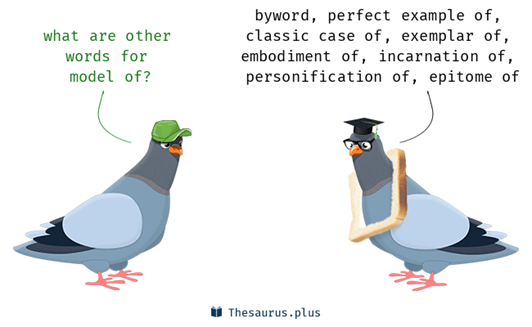
https://thesaurus.plus/synonyms/model_of
World Digital Preservation Day is a special day for us to celebrate. Digital preservation is not an easy program to start. Various technologies, a large number of files, not enough financial support, and sometimes just not knowing where to begin. Or it could be a desire for perfection that can halt an idea, without realizing that only imperfections and difficulties can initiate a preservation program. Adding coal to a firebox can start an engine, and at the American University in Cairo (AUC), we are using the same technique. Our small but solid steps act like coal igniting the preservation engine, which leads us to the destination.
Series: an underestimated but valuable concept
Koen Dobbelaere & Quincy Oeyen work at Digital Archives Flanders for the Agency for Facility Operations of the Flemish Government
The expanding digitization of the government brings new challenges regarding the management, the (long term) preservation and the disclosure of digitally created or digitally received information. To tackle these challenges in an efficient way Digital Archives Flanders uses the concept of ‘series’. We define a series as: “An aggregation of files created and maintained by an owner, in the same identifiable sequence, or the result from the same accumulation or filing process, and of similar function, format or informational content”.
Breaking Down Preservation Barriers, One Small Step at a Time
Elizabeth Kata is Archives Associate for the International Atomic Energy Agency based in Austria
Let’s face it, there are a lot of barriers to preservation, often due to a lack of resources. An institution needs enough staff and sufficient training opportunities for said staff, technical infrastructure, and an institutional commitment to finance preservation measures. When we began examining our digital holdings in 2020, we encountered a variety of barriers, both anticipated and unexpected.
Digital preservation reading club?
Barbara Sierman is a Digital Preservation Consultant
Is digital preservation a profession? And if so, what characterizes it as a profession? If you look at a skilled carpenter, the professionalism is defined by the skills of the carpenter, the tools that are used, the flexibility to apply centuries old knowledge in different situations and materials and above all, to expand this knowledge.
BREAKING DOWN BARRIERS with CSC Climate negative / zero Carbon data center
Veli-Antti Leinonen is a Specialist at the Kajaani Data Center Program, CSC IT Center for Science in Finland
In order to secure the digital preservation in long term, the preservation MUST be ecologically on a solid foundation. Otherwise, the data can’t be preserved in the future if it consumes too much of earth’s resources. Non-sustainable preservation will eventually lead into data loss or intentional deletion of data. This is comparable to subject that organizations need to be on a sound foundation to assure the reliability, but from the environmental point of view. In addition to our data center operations, CSC provides national digital preservation services for both cultural heritage sector and research data in Finland, and acts as a national competence center for digital preservation. Having energy efficient data centers provides ecologically sustainable solutions especially when considering bit-level digital preservation.
Curating Repatriated Content for Long-term Digital Preservation
Dr Arif Shaon is Senior Digital Curation Specialist at the Qatar National Library.
Efficient long-term digital preservation requires a series of operations to be undertaken throughout the lifecycle of a digital object. The task of preparing content for preservation – i.e., a Submission Information Package (SIP)[1] is a crucial step in the overall workflow as this is where the semantic and structural quality of both data and metadata is set for accessing and using the content in the future. The lower the quality of a SIP, the lower the longevity of the content being preserved.
For large collections of digital objects acquired from external institutions, the task of preparing SIPs can be very challenging. This is especially true where the policies for data and metadata quality of the acquiring organization cannot be easily aligned with those of the donor or contributing organizations.
Record, upload, archive... repeat
Vera Ferreira is Depositing Officer for Endangered Languages Documentation Programme, BBAW in Lisbon, Portugal and Leonore Lukschy is Programme Administrator & Communications Officer for Organisation: Endangered Languages Documentation Programme, BBAW in Berlin, Germany
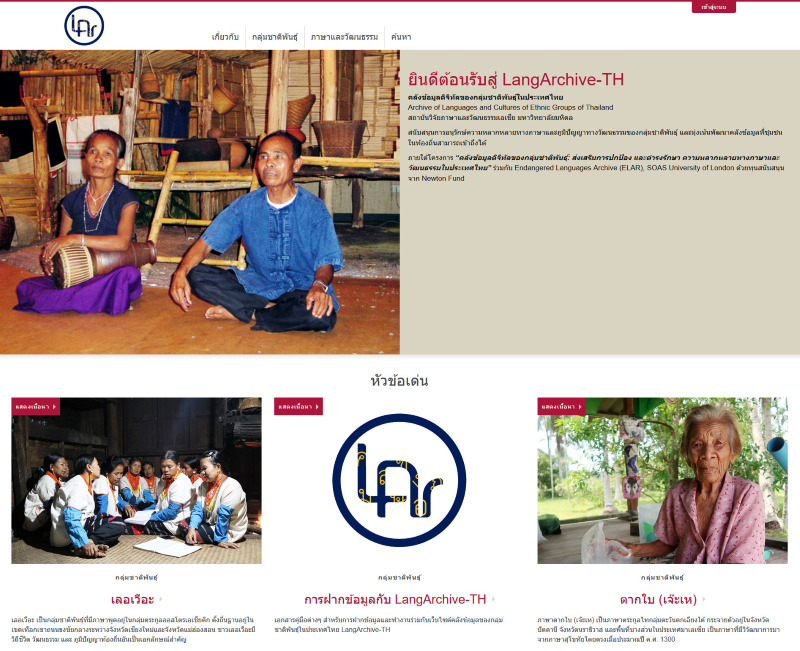
Homepage of the Archive of Languages and Cultures of Ethnic Groups of Thailand (https://langarchive-th.org)
Capturing Digital Memory – Breaking Down Barriers
Lee-Anne Raymond is Manager of MV Images (DAMS) at Museums Victoria, Australia
This year’s theme Breaking Down Barriers invokes imagery of protest marches, placards, actors suddenly bursting into song… Just me? Likely. Too much streaming in long lockdowns. Honestly, I really had to mull on the theme a bit, as I was concerned. How could I determine that barriers are being broken down from within a Museum where we do a lot of digitisation for reasons of physical preservation and access?
A new Digital Archive to preserve Victoria’s history now and into the future
Julie McCormack is Senior Manager for Government Recordkeeping at Public Record Office Victoria, Australia
Public Record Office Victoria in Australia (PROV) is pleased to announce the completion of our Digital Archive Program, replacing our entire archival management and digital preservation environment that had been in place since 2005. This program represents a key initiative of our Victorian Electronic Records Strategy (VERS) to ensure continuous access to complete, authentic and meaningful digital records now and into the future.
OAIS: Isn’t that a British rock band with delusions of grandeur? Breaking down barriers by sharing knowledge
Carey Garvie is Project Officer, Digital Archives Innovation and Research at the National Archives of Australia
After a hectic September of virtual conferences and opportunities to connect and share stories about how the National Archives of Australia does digital preservation with the broader community, I finally got a chance to sit back and start writing our blog for World Digital Preservation Day 2021 (WDPD2021). Reflecting on the theme of ‘Breaking Down Barriers’ and making digital preservation ‘understandable, relatable and accessible to all’, I began to think not about external community activities but internal ones instead.
Records from the sea of islands: The Pacific and Regional Archive for Digital Sources in Endangered Cultures (PARADISEC)
Nick Thieberger works for the Pacific and Regional Archive for Digital Sources in Endangered Cultures (PARADISEC) and the University of Melbourne
The distance between major population centres in the Pacific makes it difficult for residents of the sea of islands to access records in their languages. Even if records are stored in national museums or cultural centres, that can be some distance from most of the population. As the internet becomes more widely available, connection to these records becomes more feasible, but that requires the records to be described, digitised, and made accessible.
Breaking down barriers to implement digital preservation
Jaye Weatherburn, Program Manager Digital Preservation and Elise Bradshaw, Digital Curation and Archives Specialist work at the University of Melbourne
Supporting digital connections
The theme of this year’s World Digital Preservation Day, “Breaking Down Barriers” connects with some work we have currently underway to realise the University of Melbourne’s 10-year digital preservation strategy. This year in a big effort to build and support connections between the distributed teams contributing to the success of long-term digital preservation at the university, we have been working on a collaborative planning and implementation process for long-term preservation of university records.
Digitisation and digital preservation practice – making archives available and keeping it accessible (part 3)
Ros Malone is School Archivist for Bunbury Cathedral Grammar School in Perth, Australia
Image Keys: Easing Barriers to Retrieval in the School Archives
It’s a familiar problem for many Schools and School Archives, and indeed for collections of all kinds – what can be done with our vast collection of untitled, un-tagged digital images?
Digitisation and digital preservation practice – making archives available and keeping it accessible (part 2)
Rosemary Grace Bruce-Mullins is Committee Member and Member of the Research Team at the Wentworth Historical Society Inc, Australia
As a local History Society member digital preservation of records provides a multitude of benefits.
An experience where the local town hall, that housed the history society collection, was firebombed, and thankfully saved, made us aware of the reality of losing the collection, and all the information it contained.
Digitisation and digital preservation practice – making archives available and keeping it accessible (part 1)
Karuna Bhoday is Program Manager, Integrated Archival Management System Program at National Archives of Australia.
The National Archives of Australia ensures that Australian Government information of enduring significance is identified, secured, preserved and accessible for future generations.
To continue to meet our vision of being world leading archive in this digital age and to fulfil our functions now and into the future a high priority for the National Archives is to embed an end-to-end archival management capability across the organisation and to accelerate its digital transformation. The integrated Archival Management System Program (IAMS) is a Digital Transformation Project led by our Chief Information Officer.
Breaking Down Barriers: World Digital Preservation Day 2021
It’s my pleasure to announce the official start of World Digital Preservation Day.
It’s both welcome and surprising to realise that we’re now onto our fifth annual event. In the first couple of years, the simple purpose of connecting people and raising awareness about our work was sufficient. Even that seemed ludicrously ambitious in 2017. This year’s theme – Breaking Down Barriers – represents a new confidence, and perhaps a new urgency too. It’s a call to action. It’s a challenge to do something with those connections and insights that we’ve gained in the last four years. We’ve connected with colleagues around the world and formed those relationships and in 2021 we move forward together.
There’s no shortage of ambition here, but let’s be honest, there’s a need for ambition. There are enough barriers to be broken down. We’re used to thinking about digital preservation as the intersection of technology, resources and organization. There are barriers to all three of these, and the scale of the challenge only seems to grow.
Not Unchanged
The last rays of sun are now setting on the most westerly reaches of the map and we’ve all now had a chance to celebrate and participate World Digital Preservation Day. I have a brief moment – for me it’s now the morning after the night before – to offer a few immediate reflections and pick a few highlights.
Our theme for the 5th November, Digits For Good, has a neatly-constructed double meaning implying both purpose and time. Both are necessary and both were on display. I encourage you to leave your comments here on your own highlights.
It’s too early to report the full story of World Digital Preservation. This particular count is far from complete but the success is undisputed. We counted 85 blogs on the DPC website (yes that’s the most ever) from 22 countries (yes that’s the most ever). And that’s just one of the many blogging platforms: I know because I wrote for two others besides and we spotted maybe another 25 that we know of. We have counted well over 5,000 tweets - more than 4,000 on the #wdpd2020 tag and another 750 or so with #dpa2020 from around 1900 different accounts. There were at least 10 baking ‘incidents’ (I don’t count each individual cupcake or cookie) in the #BitListBakeOff. Two new initiatives - the digital preservation themed pizza and at least one digital preservation themed cocktail selection, to be enjoyed while marvelling at the musical contributions. The State Library of Queensland has made the parody video into an art form.
The EaaSI Interaction API
Euan Cochrane is the Digital Preservation Manager at Yale University Library in New Haven, CT
-
Imagine being able to migrate any data from any legacy format to any compatible modern format automatically.
-
Imagine being guided through using legacy software with real-time demonstrations and tutorials that you can interrupt and take over from at any point.
-
Imagine being able to add a screen reader to any software, enhancing accessibility.
-
Image having access to comprehensive metadata about all software titles.
We are developing Emulation as a Service Infrastructure (EaaSI) software with a long time horizon - we expect the general approach that EaaSI is enabling, i.e. the ability to be able to re-run legacy software at any point in time, to be necessary indefinitely.
2020, #WeMissiPRES and the best conference I have never attended
Steph Taylor is based in Los Angeles, USA.
I’ve worked in digital libraries and archives for a long time, and I’ve always wanted to attend the iPRES conference, but I’ve never made it. Given my many failed attempts, I was not expecting 2020, the year of the apocalypse, to be any different. But these are strange times. I heard about an online event called #WeMissiPRES, hosted by DPC and I rushed to book a place. The event was not iPRES, and the organisers (friends of iPRES), explained up front that there would be no heavy papers. Instead, they were aiming for a fringe festival, coffee shop vibe for the event. This sounded perfect.! My 2020 self needed to connect and learn, but in a gentle way.
The event itself was excellent. In recent years, there has been a shift to put more professional content online within the digital preservation community and the event benefited from this move. And in the age of the pandemic, many of us are now video conferencing experts. Organisers, speakers and delegates easily picked up the etiquette of online interactions and each session ran smoothly. There was also a social element, which was a lot of fun and helped to provide the networking element often missing with online events.
The biggest and most significant shift for me was not the technology or the well-organised programme, but the range of participants. Although I had missed out on iPRES, I’ve had a number of jobs where I’ve been privileged enough to attend many conferences. These conferences billed themselves as international, but as #WeMissiPRES unfolded, I realised that I had never attended a truly international conference. Most of my conferences had been based in Europe. There would be a lot of European-based delegates, with a smattering of people from elsewhere. I’d only been able to attend one conference outside Europe and was one of only a handful of European-based people there, with most people being from the local region. So here I was, in a time of restricted national and international travel, when many people around the world were barely leaving their own homes, participating in an actual global event.
The Business of Preservation is the Practice of Care
Justin Simpson is the Managing Director of Artefactual Systems.
Digital preservation can be a hard sell. Institutions may recognize the need. Many do not adequately prioritise the work. The return on investment for digital preservation efforts is difficult to quantify, and not achievable in a short time span.
We will not convince the world of the importance of this work in financial terms alone. While the practice of digital preservation can be understood as a business practice, I believe a more profitable framing is to consider the work of preserving and providing access to cultural memory as a practice of care.
Bernice Fisher and Joan Tronto describe caring as ‘… a species activity that includes everything that we do to maintain, continue, and repair our ‘world’ so that we can live in it as well as possible.’ [1]
This definition describes the work of caring for cultural memory just as well as it describes healthcare, or childcare, or the many other forms of caregiving. The work of caring, of all kinds, is generally undervalued, and often invisible. Our conversations about how to provide, for example, healthcare, are often restricted to purely financial concerns. Caring is then turned into a commodity for profit making, at the expense of the real value that caregiving creates.
WDPD 2020 Blog - Grupo de Preservación Digital
Isabel Galina Russell is a Researcher and member of GPD based at Instituto de Investigaciones Bibliográficas, UNAM.
For a second year, the Grupo de Preservación Digital (GPD) based in Mexico,  is joining in the celebration of World Digital Preservation Day. The GPD, founded in 2017, is a multidisciplinary and interinstitutional group focused on the practice of digital preservation as well as supporting research and training in digital preservation. We also focus on advocacy work for preserving our digital cultural heritage. The GPD originated at the Biblioteca Nacional, Mexico’s National Library which is based at the national university, the UNAM. The group focuses mainly on the digital cultural heritage sector, working with cultural heritage institutions and universities around the country. We now also have an increasing membership of people from other sectors, all concerned about how to address digital preservation issues.
is joining in the celebration of World Digital Preservation Day. The GPD, founded in 2017, is a multidisciplinary and interinstitutional group focused on the practice of digital preservation as well as supporting research and training in digital preservation. We also focus on advocacy work for preserving our digital cultural heritage. The GPD originated at the Biblioteca Nacional, Mexico’s National Library which is based at the national university, the UNAM. The group focuses mainly on the digital cultural heritage sector, working with cultural heritage institutions and universities around the country. We now also have an increasing membership of people from other sectors, all concerned about how to address digital preservation issues.
WDPD Blog - Christopher Zaste - University of Manitoba
Christopher Zaste is a Digital Archivist at the University of Manitoba.
As we gather around the virtual campfire this World Digital Preservation Day, I have a story to share. I knew a guy, keeping him anonymous, who loved to back up his data to CDs and later DVDs. Many of these discs, of course, had “archival media” proudly printed on the manufacturer’s label. His backup collection contained family movies, photographs, documents, software, and much more. Many of which are some of his most prized possessions. One day, his computer crashed. Not a simple crash to desktop, but a fatal error causing the loss of all locally stored files. Thankfully, he had a vast backup store of discs, so he thought it was not the biggest loss.
The next day, he went to the store and bought a new laptop. This machine had a fast processer, lots of RAM, and even a nice 4k display. No expense was spared. He brought his machine home and began adding his backup files. Running his finger along the laptop’s right side, he found no eject button. He tried the left side and found nothing. He looked all over the machine, pressing button after button, but to no avail. His new laptop, the one he just spent a considerable amount of money on, had no disc drive to read his obsolete media. Frustrated, he had to go to Amazon and buy a disc drive that can connect via a USB cable.
Such digital preservation stories are quite common. We have all experienced such issues, and not just in our professional careers. Family photos stored on old CDs, a home video on a VHS tape, I can go on with examples. In our primarily digital society, the digital copy is often the only copy. A record can easily be lost if is not stored in an accessible backup format. These scenarios of loss are what we, as digital preservation professionals, try to prevent.
Small-Scale Digital Preservation at Lakehead University
Sara K Janes is an Archivist at Lakehead University.
Local and regional archival collections are a key part of the worldwide archival network. Living and working in Thunder Bay, ON, which is a four-hour drive from the nearest city of comparable size, has taught me just how important local heritage collections are to the people who create them and the people who use them. If our national and provincial archives are a plane ride away, we can’t reasonably ask those institutions to take responsibility for our local history.
I work as the Archivist for Lakehead University; the archives (https://archives.lakeheadu.ca/) is but one room and 1.5 FTE, so I have responsibility for most things, and digital preservation is only one aspect of my work. We’ve thus benefited enormously from taking part in Scholars Portal, a set of services provided through the Ontario Council of University Libraries. One of those services is Permafrost (https://permafrost.scholarsportal.info/), which provides reliable storage and a hosted Archivematica instance. Accessing these tools as a service hosted elsewhere, and with excellent support provided by Scholars Portal, makes it possible for an archivist without a strong tech background to carry out meaningful digital preservation work.
Collaboration Through Open Source Software
Greg Bak is the Associate Professor of History (Archival Studies) at the University of Manitoba.
Heritage institutions are accustomed to having more mandate than resources. We are used to supplementing meagre core funding by applying for special project funding, whether internal or external. Open source software offers a way of structuring collaboration that allows us to build upon sporadic and context-dependent project funding.
Products such as Archivematica, BitCurator and Fixity offer institutions of all sizes access to purpose-built digital preservation tools and systems that can be adapted to local needs. Heritage institutions are still working to absorb the different logic and economic demands of using open source systems as opposed to proprietary systems. Costs are not necessarily reduced, but they are differently incurred, distributed and managed. Initial setup costs are drastically reduced, but subsequent work is required to bring the system into line with local institutional and user needs. Development of the code base can be shared among institutions. Smaller institutions can leverage work done by larger institutions and consortia.
It Takes a Village: Documenting the Pandemic for Research, Policy, and Practice
Oya Y. Rieger is a Senior Strategist and Rebecca Springer is an Analyst, both working at Ithaka S+R, US
Throughout the pandemic, critical information about COVID-19 has been flowing through a range of channels, including social media, news outlets, journals, and preprint servers. Cultural heritage organizations have been participating in efforts to curate and archive these rich and diverse sources of information–not only for future generations but also for those currently studying various scientific, sociological, political, and cultural aspects of the pandemic. These archiving efforts will not only help to capture a significant moment in our history but may help to prevent or manage future outbreaks. But digital preservation continues to be an expensive and complicated process, especially at an institutional level. According to a recent UNESCO Memory of the World survey, 66 percent of respondents reported that in their country there are no national preservation policies or strategies. The 2020 Open Preservation Foundation survey shows that the average FTE across digital preservation roles is less than two. In almost every country, cultural heritage organizations with a strong sense of mission are trying to do their best with limited resources and expertise.
Portico: Evolving with the community to ensure access to scholarship for good
Stephanie Orphan is the Director of Content Preservation at Portico.
Fifteen years ago, when Portico was in its early stages, we answered a call from the community to ensure that the electronic journals libraries were investing in were protected for the long term. At the time, the primary concern was ensuring that licensed content, often from the very large commercial publishers, was properly preserved with mechanisms in place to ensure future long-term access for researchers, as well as near-term post-cancellation access where possible.
During the first five years in which Portico signed publishers (2005-2010), we made great progress, signing 119 journal publishers, including all of the very large commercial publishers as well as many medium-sized publishers, university presses, and a couple large open access (OA) publishers. We also successfully expanded our services to include preservation for e-books and digitized primary source collections (the latter through our d-collections preservation service).
Over the course of the next 10 years, little by little, the trajectory of Portico’s growth began to change. The range of publishers expanded to include more small publishers (those with five or fewer journal titles) and fully OA publishers---including many library publishers and independent scholar-led journals. While we continued to work with publishers who had developed their own sophisticated platforms or who were using commercial hosting platforms, increasingly we began working with publishers self-hosting through an instance of OJS (Open Journal Systems), WordPress, or web sites.
ICPSR’s COVID-19 Data Repository
Chelsea Goforth, Senior Data Project Manager at Inter-university Consortium for Political and Social Research (ICPSR).
Since the start of the COVID-19 pandemic, the Inter-university Consortium for Political and Social Research (ICPSR) has engaged in digital preservation activities to enable rapid data access, wide data sharing, and long-term data re-use of COVID-19 related data collections. Our preservation work supports social science researchers engaged in asking and answering questions about COVID-19 in order to soften its impact, especially for the most vulnerable populations.
Our Common Digital Future: Digital Preservation and the United Nations Sustainable Development Goals
Eng Sengsavang is a Reference Archivist at the UNESCO Archives.
Technologies are needed that produce 'social goods'…[1] 
Since the 1980s, the drive to achieve “sustainable development” has been led by the United Nations through several global frameworks for action, most recently the 2030 Agenda for Sustainable Development and the Sustainable Development Goals (SDGs). Our reliance on digital technologies and information is so enmeshed into our lives that it is time we acknowledge the critical role digital preservation plays in such global initiatives. Digital preservation is an indispensable component of sustainable development and will prove to be increasingly critical for the achievement of the SDGs and future initiatives like it. Digital preservation consists of a constellation of acts and strategies that, like sustainable development efforts, fundamentally anticipate the succession of future generations who depend on our actions today for the shape and content of the world they will inherit in decades to come and beyond.
Photo: Earth seen from Apollo 17, Public domain, via Wikimedia Commons
Digital Records: for accountability, transparency and the public good
Sherrine M. Thompson, Lead, Access to Information, World Bank Group Archives
Two years ago, my colleagues Jeanne Kramer-Smyth and April Miller introduced the World Bank Group (WBG) Archives’ efforts to preserve digital records, and last year my colleagues Shiri Alon and Daniele Balduzzi wrote about how we’re defining the digital landscape of the WBG in order to shape and refine our long-term digital preservation strategy. This year’s post will focus on the importance of preserving born-digital records for accountability, transparency and the public good.
Preservation of both born-digital records and digital surrogates of analog originals is the responsibility of the WBG Archives as owners of the WBG’s Records Management Policy and one of the principal implementors of the Bank’s Policy on Access to Information (AI Policy). The former ensures that records, regardless of format, are properly managed throughout the entire lifecycle and the latter sets forth how the World Bank makes information available to the public.
The benefits and drawbacks of DIY digital preservation
Amy Rudersdorf is a Senior Consultant with AVP.
Introduction
2020 hasn’t been the year most of us expected. At the top of all the stuff that this year has thrown our way is the global pandemic. For some organizations it has also meant reductions in resources and staffing. This has left many cash-strapped organizations with tighter budgets than ever before, even as the costs of technology and human resources continue to rise. At the same time, many organizations are struggling to get a handle on the mountains of digitized and born-digital content in their collections to ensure it is safe now, and managed over time to ensure it is accessible and renderable into the future.
So what’s a digital preservationist do when it comes to selecting technology for their program? Is it cheaper, better, and faster to build from scratch or buy an out-of-the-box (OOTB) solution? This post describes the benefits and drawbacks of do-it-yourself (“DIY”) digital preservation that may help decide in which direction to go.
Recent Developments at the Library of Congress: File Format Policies and Web Archiving Anniversary
Authors – all from the Library of Congress: Kate Murray (Digital Projects Coordinator), Trevor Owens (Head, Digital Content Management Section), Marcus Nappier (Digital Collections Specialist), Ted Westervelt (Chief, US/Anglo Division) and Abbie Grotke (Assistant Head, Digital Content Management Section & Web Archiving Program)
The Library of Congress relies on a network of policy documents, good practice and specifications that govern the Library's digital collection management program compiled in the publicly available Digital Collections Management Compendium (DCMC). The Compendium brings together the business guidance from across the Library’s many departments related to digital formats, inventory and custody and finally, access. In October of 2019, the Library of Congress launched a public version of the DCMC, which presents digital collection management policies in three main areas: digital formats, inventory and custody, and access. The section for digital formats includes a summary of how the Library’s Recommended Formats Statement can be applied, as well as overarching statements about how we manage various digital preservation issues for digital formats, including the preservation of content “as received” over time, the creation of digital surrogates, and inventorying of format types. As such, the ongoing maintenance and development of the RFS is critical to the Library’s overall digital collection management policy and practice.
Acting on Principle
R. F. (Chip) German Jr is the Programe Director for the Academic Preservation Trust.
World Digital Preservation Day is a good day to reflect about our work. I’m thinking about big things I’ve heard, observed and learned in the six years that I’ve been with the Academic Preservation Trust. Most are obvious at least in hindsight, but they didn’t start out as principles that served as touchstones for our decisions. They are now. Thanks to the many folks responsible for them.
First is “Missions differ; don’t forget yours.” Those of us who play some role in the long-term preservation of digital materials do so in pursuit of diverse missions. In some cases, we do it to comply with governmental or business requirements. At APTrust, our library-focused consortium aims to preserve a significant volume of digital materials related to human knowledge and cultural history.
Early on in dealing with such materials, I learned a principle from the remarkable preservation librarians with whom I work each day that I’ll express in this paraphrase: Preservation NOW without access THEN is pointless. I get that. If what we preserve today is unable to be used in the future, why did we bother? Not only is that statement an important principle on its own, clarifying its components leads to other principles.
Preserving Digits for Good: Turning Strategy into Practice at Concordia University
John Richan is a Digital Archivist at Concordia University.
The following blog is also available in French below:
For the third time in four years Concordia University Records Management and Archives (RMA) is participating in World Digital Preservation Day organized by the Digital Preservation Coalition. For those of us involved in digital preservation, continuing to protect and provide access to reliable, trustworthy data has reached new levels of importance during a global pandemic. Concordia, a major North American research University in Montréal, has a rich digital legacy requiring active preservation by RMA while the institution undergoes rapid digital transformation.
World Digital Preservation Day presents an annual opportunity to recognize advancements made by the global digital preservation community throughout the year. While learning with interest how external colleagues are ‘doing digital preservation’, RMA staff make a point of engaging the Day as a reflection and celebration of our development since 2017 when the Concordia RMA Digital Preservation Program was launched.
Preserving the bits : Library and Archives Canada’s Pre-Ingest workflow
Heather Tompkins is a Project Officer at the Library and Archives Canada.
When the call came out for blog posts for this year’s World Digital Preservation Day, we within the Digital Preservation and Migration Division of Library and Archives Canada (LAC) wondered what we could discuss and what might be of interest for the external community. Today, we are opting to blog about our Pre-Ingest workflow.
Our Pre-Ingest review is part of an essential workflow for preserving digital archives. We’re looking forward to sharing what we are doing and hearing from you re: how your own work may be similar or different. So far, this work hasn’t been greatly impacted by COVID-19 – we have continued to do Pre-Ingest despite working from home with minor network speed issues. Our built infrastructure (specifically, a 20TB server to which we can connect via VPN), and our ability to message, share screens, and video chat have all been put to good use!
As is often the case with digital archival transfers, we don’t always have the opportunity to review the content prior to transfer or gather much information. As a result, sometimes what is transferred… isn’t always what we intended to acquire or preserve. LAC’s Pre-Ingest workflow helps to address this challenge. Initiated in 2013 with only two staff members, this function has grown over the past seven years to include five Digital Archivists from the Digital Integration section who bring both archival experience and a digital preservation mindset to the work.
La Cadena de Custodia de Archivos Digitales - CCDA combinada con Preservación Digital Sistémica - PDS para Archivos
Dr. Daniel Flores, Asociación Latinoamericana de Archivos - ALA, Representante Nacional de Brasil en el GE RIBEAU ALA.
Profesor e Investigador del Curso de Archivología y de la Maestría y Doctorado en Ciencias de la Información de la Universidad Federal Fluminense - UFF (Brasil) y Líder del Grupo de Investigación en Documentos Digitales: Gestión y Preservación Digital Sistémica en un CCDA.
The following blog is available in English below
Nuestra sociedad comenzó a producir documentos digitales, los cuales son, en sí mismos, complejos y específicos y, por tanto, requieren un tratamiento especial, desde su génesis, confinados en Sistemas Computarizados contemplando una Cadena de Custodia y Preservación, orientados a normas, estándares, modelos y requisitos. Sin embargo, era necesaria, y sigue siendo, la solución previa de los problemas y dilemas conceptuales que la propia Archivología necesita para superar eficazmente la Ruptura Paradigmática y establecer un escenario firme de Transición Paradigmática, como forma de garantizar a la sociedad y a la ciudadanía, que pueden ejercer su ciudadanía plena sobre la base de documentos auténticos, fiables y conservables.
Ahora, con Registros digitales - Documentos digitales, mucho ha cambiado, hemos detectado y presenciado una ruptura paradigmática, donde la complejidad y especificidad de los registros digitales ha cambiado, la forma en que entendemos la "prueba", o "evidencia", para la Cadena de Custodia, ahora resignificada para la Cadena de Custodia de Archivos Digitales - CCDA. Enfoque mucho más interdisciplinario de la ciencia y el derecho forenses digitales. Ahora la atención se centra en la política de archivo y el entorno digital, basados en estas políticas, así como en las normas, estándares, modelos y requisitos.
Por que preservar os registros de uma pandemia
Miguel Ángel Márdero Arellano, Coordenador da Rede Cariniana, Instituto Brasileiro de Informação em Ciência e Tecnologia – IBICT
The following blog is available in English below
O tratamento dos registros sobre a pandemia do COVID-19, por profissionais da informação, deverá incluir a aplicação de estratégias de preservação para garantir a confiabilidade das fontes e o conhecimento da realidade atual.
O volume de informação sobre a pandemia em formato digital cresce a cada minuto. Todos os esforços para organizar esses registros poderão ser reconhecidos no futuro por aqueles que enfrentarão novos problemas de saúde pública. Da mesma forma, as estratégias de preservação que forem aplicadas a esses registros proporcionarão a garantia de termos fontes de informação confiáveis para conhecer a realidade atual.
Isso será o resultado de um trabalho árduo de profissionais da informação empenhados em descrever todos os detalhes de registros dos eventos em diferentes formatos. Após um período de isolamento, a necessidade de abrir bibliotecas e arquivos para atendimento das comunidades, mesmo antes de estarmos em um ambiente livre da doença, é produto do compromisso social dos responsáveis pelos serviços de informação para que todos tenham acesso a informações precisas sobre as ações necessárias para conter os efeitos do vírus.
Building and Sustaining the ‘Digits for Good’ Community
Nancy McGovern is the Director of Digital Preservation at MIT.
This year’s theme - Digits: For Good – is great! It’s always fun to work on a WDPD blog post. There are so many examples of collaboration within and beyond the digital preservation community. Working together is part of what we do, yet it often seems to be more intentional and valued in 2020.
The 2020 WDPD topic got me thinking about preserving digital content in a way I haven’t in a while. I have worked as a digital archivist and then as a digital preservation manager. As a digital archivist in the ‘80s and ‘90s, I found appraisal to be a very engaging activity and yet by the time I felt I knew enough to make a decision about keeping the digital content or not, I found it hard to not take the content – I inevitably got fond of it as I came to understand it. Working on digital preservation is more agnostic about content for me – if digital content needs to be preserved, I’m in! The examples I’m sharing are not about preserving specific material, they are more about sustaining community and building capacity to be able to preserve whatever needs to be preserved “for good – or at least for as long as required” – love that part of the Blog theme for WDPD. Here are some of the recent activities that I’m highlighting.
Digital Preservation for Every Archive
Jonathan Tilbury is CTO and Founder of Preservica based in the UK
From corporate to academic, charity to government, archives around the world are working harder than ever making sure that the events of the past year are documented for generations to come. With lessons to be learnt from this global health pandemic, and the end not quite in sight, having easy, automated, and affordable digital preservation software accessible to every archive, especially those with limited resources, has never been so important. The more people using digital preservation, the greater the benefit for all, but with this comes an increase in the number of non-expert users.
Luckily, there are a number of initiatives that will bring all these threads together to create an ecosystem that re-uses community expertise to deliver best practice digital preservation in an automated manner.
The UK Government Web Archive: Continuing to Capture the UK Government’s Response to COVID-19
Tom Storrar is the Web Archiving Service Owner at The National Archives.
The COVID-19 pandemic has been an unprecedented challenge for The National Archives’ Web Archiving Team. In the six months since our last blog post, we have continued our efforts to build a definitive record of the government response to the first pandemic of the digital age. Our three-pronged approach, consisting of regular in-depth archiving of core websites, complimented by broad crawls across the government web estate, working closely with our suppliers, MirrorWeb, and daily captures of interactive content with the excellent Webrecorder/Conifer tools have now matured and become routine.
This has not been without its technical challenges. With each of these “prongs” we have had to change the way we work, and rapidly: not only to working remotely, but also to new technology and to the speed with which content has been updated or published. This has prompted us to create new approaches to archiving content and to accelerate innovations that we had already started to develop before the pandemic. For example, we need to ensure that every member of the team has available to them their own version of Webrecorder/Conifer in this remote scenario. So far we have achieved this using virtual machines, which is quite a change from just a year ago, when we were taking turns capturing content from a single machine in the office!
Getting the records
Helen Dafter is an Archivist (Digital Preservation) at The Postal Museum
Before any archive can start to preserve digital records it first needs to get them into the archive. This is something I have been working on at the Postal Museum this year. It has been an exercise in advocacy and trust building as much as technical skills.
To set the scene, the Postal Museum cares for the archive of Post Office Limited (POL) and Royal Mail. It is an independent charity which has created its own challenges for this work. This blog focusses particularly on my work with POL but I hope that the processes developed will be applicable to Royal Mail in due course.
In 2018 POL developed retention schedules across the business. The Postal Museum commented on these during the project, identifying materials which needed to be offered to the archive. These provided the starting point for my approaches to POL departments to discuss the transfer of records to the archive.
Digital Preservation at the United Nations
Aleksander Gelfand is the Information Management Officer at the United Nations Archives and Records Management Section, Department of Operational Support, United Nations Secretariat in New York.
Digital preservation and media obsolescence have been issues on the minds of archivists at the United Nations since at least the 1970s. Then, information found on punch cards had to be preserved knowing that the cards themselves were not a suitable medium for preserving machine-readable information. A temporary solution was to transfer the information to computer tape, though the process was expensive and time consuming. With the increasingly introduction of new information technologies, preservation seemed a constantly moving target.
The 1980s was a decade of automation at the UN as computers running word processing and database software became ubiquitous. The UN Archives began advocating for action at the very beginning of the lifecycle of electronic records, and as a result Archives staff took a more active role in managing records rather than being a passive recipient. This, however, was easier said than done – at least initially.
The first large wave of digital records came in the form of floppy disks, which were increasingly common in collections accessioned throughout the late 1980s and throughout the 1990s. Frequently inside folders with paper records, unless properly described, these pieces of soon-to-be obsolete media could easily get lost. Nevertheless, by early 2000s, the contents of many of these disks had been migrated to external hard drives and many finding aids included descriptions indicating the presence of this digital media.
OPF at All Things Open: What we can learn from open source communities
Becky McGuinness is the Community Manager for the Open Preservation Foundation
In October, the Open Preservation Foundation attended the ‘All Things Open’ conference. Two of the themes it focused on this year were community leadership and diversity and inclusion, which are central to much of our recent and ongoing work. In this post, I’ll share some key takeaways from the event in the context of Digits: For Good, including celebrating the growth of open source, ensuring tech access for the underrepresented, the importance (and pitfalls) of community leadership, and best practices for creating a diverse and inclusive community.
In one of the keynotes, Erica Brescia, COO of GitHub, spoke about how open source has become a key driver of innovation in technology. Open source software is used in every sector and the amount of software is expected to grow exponentially in the next 10 years. As well as its increasing popularity across sectors from medicine and healthcare to memory institutions such as libraries, archives, and museums, the use of open source is expanding geographically. Five years ago, the majority of contributions came from the western world, but today, the epicentre of open source development has moved to developing nations with a huge increase in participation from India, Africa, China and Latin America. To support this growth, there will need to be more contributors, maintainers and commerce to meet demand. More importantly, there is a need for inclusive communities that support wide participation and access to essential knowledge and resources for those who are often underrepresented.
Max Communications - AIP Query Builder & Tagging
Tim Schofield is a Senior Developer for Max Communications.
Max are working with Imperial College London Archives and Corporate Records Unit (ICL ACRU) digitally preserving their documentation. We use Archivematica for digital preservation in tandem with AtoM as an access system.
The project set out to improve Archivematica’s reporting ability by developing an in-house QueryBuilder utility. The QueryBuilder enables the user to create compound queries and interrogate Archivematica’s database. For instance, searches can be run returning all packages created within a particular date-range, or packages over a certain size, or created by a particular user.
What is data integrity?
Matthew Addis is Co-Founder and CTO of Arkivum based in the UK.
What do we mean when we talk about data integrity? What is data integrity and why is it an important part of digital preservation? Data integrity means different things to different people. If you ask the question to an IT professional, compliance officer, corporate archivist, research librarian, or curator of a special collection then you will typically get very different answers. What we mean by data integrity depends on what we mean by data, how and why that data exists, and most importantly who’s using it and for what purpose. There is no single answer. But in all cases, digital preservation has a role to play in achieving data integrity, and that makes life in the digital preservation world both challenging and interesting!
WDPD 2020 - NRS Blog - Response to Covid-19
Authors: Lynn Bruce, Web Archivist; Laura Gould, Government Records Archivist; Barbara Fuentes, Web Continuity Assistant; Joanne Watson, Digital Capacity Planning Lead & Garth Stewart, Head of Digital Records Unit from the National Records of Scotland.
Introduction
In a year like no other, so many aspects of our society have changed in the wake of Covid-19; how we work, how we play, how we govern, how we live.
At the pandemic’s onset, National Records of Scotland - as keeper of Scotland’s national archive, set out to ensure that we captured a record of the unprecedented changes facing Scotland’s government and public health administrations. This required bundles of energy, focus, and engagement by colleagues, which at times significantly tested our resilience. We’ve adapted admirably to this challenge: read on to explore our key successes and thoughts on the future.
Keeping the Good for Good: Preserving the Laws of Hywel Dda at the National Library of Wales
Sally McInnes is Head of Unique Collections and Collections Care at the National Library of Wales.
When Sarah Middleton announced that the theme of this year’s World Digital Preservation Day was Digits: for Good, I could not resist the chance to talk about the Library’s approach to preserving one of Wales’s most iconic manuscripts, namely the Boston Manuscript of the Laws of Hywel Dda (the Good). The Library has combined innovative approaches in traditional conservation, digitisation and digital preservation to ensure that these Welsh Laws are accessible now and in the future.
The Boston Manuscript was purchased in 2012 by the Library with assistance from the Lottery Heritage Fund, the Friends of the National Libraries and the Welsh Government. The manuscript, written in Welsh, dates from around 1350 and records the native Welsh laws, which were thought to have been codified by Hywel Dda. It is a key text in the history of Welsh law and provides insights into Welsh identify and cultural life. It was used as a working text, being annotated by a Judge in South Wales, who carried it around in his pocket. By the 19th century, the manuscript had reached America and was in the custody of the Massachusetts Historical Society in Boston, having probably been taken across the Atlantic by an emigrant.
Three Copy Nirvana? A Climb into the Clouds
Lee Hibberd is the Digital Preservation Manager at the National Library of Scotland.
For more than a decade the National Library of Scotland has been on a journey to achieve one of the digital preservation fundamentals – safe storage. In October 2020, and for the very first time, we achieved our goal of keeping 3 copies of our preservation data. To mark the coincidence of this result with World Digital Preservation Day I’d like to share the ups and downs of the climb with you - from the foothills to the clouds.
Between 2000 and 2010 the National Library of Scotland had an established Digital Preservation Programme, was purchasing digital content and collecting Scottish websites and personal archives with digital bits attached. Growth was manageable and routine – one copy lived on networked disk storage, and another on back-up LTO tape. We were early and full members of the Digital Preservation Coalition and had attended our fair share of training but data losses remained as words on a PowerPoint slide. It wasn’t long before the theory became personal.
Digits: For Good – Black History Month at Lloyds Banking Group
Peter Judge is an Archivist at Group Archives & Museum (Lloyds), Group Corporate Affairs
Lloyds Banking Group Archives hold very few records about race and ethnicity. During previous Black History Months, we have been asked for stories about black colleagues that could be shared as part of the celebrations, but by going through material in the archive we quickly realised that conversations around race and ethnicity didn’t start in the Group until the 21st century. So this year we took the opportunity to join the Group’s Black History Month working party and create a bank of stories that will illustrate for future researchers one small part of the black experience in the U.K., in a year when capturing these stories feels more important than ever. It is through our use of the digital preservation platform Preservica that we aim to keep these stories accessible for future generations.
Amplifying Change: Stories of Change from Irish History
Bláithín Ní Chatháin is a Historical researcher and oral historian, Atlantic Philanthropies Archival Project at the Digital Repository of Ireland.
‘Amplifying change: A history of the Atlantic Philanthropies on the island of Ireland’ is a collaborative project between the Digital Repository of Ireland (DRI) based in Dublin and the Division of Rare and Manuscript Collections (RMC) at Cornell University Library, New York. The ‘Amplifying Change’ team based at DRI was granted access to the Atlantic Philanthropies Archive housed at RMC, enabling DRI to play a role in providing persistent access to grant documents and in contextualising the stories that surround significant social and cultural change with newly collected oral histories. The collaboration aims to build and disseminate a vibrant, sustainable, and openly accessible digital archive and online exhibition of the impact of the Atlantic Philanthropies grantees on the island of Ireland, consisting of select business records and new oral histories, that reflect Atlantic’s grant making philosophy, approach and impact in the Republic of Ireland and Northern Ireland.
‘DIY’ Digital Preservation: A Collaborative Trainee Project on Personal Digital Archiving
Jacob Bickford, Erin Liu, Ellie Peng, Ash Ullah are Bridging the Digital Gap trainees with The National Archives.
We are four Bridging the Digital Gap trainees employed by The National Archives (funded by the National Lottery Heritage Fund) and seconded across four host institutions: University of the Arts London, London Metropolitan Archives, Transport for London Corporate Archives and University of Westminster. The traineeship scheme is designed to bring our digital capabilities to the archives sector whilst developing our skills in various aspects of archival practice.
Whilst forming our proposal for a collaborative cross-institutional project, we were cognisant of our position as trainees working in archives that sit within comparatively larger organisations, bodies with resources to support the hosting and operation of purpose-built digital preservation systems. We wondered where newcomers (like ourselves), ‘non-specialist’ practitioners and/or those without a massive budget sat in relation to this digital preservation landscape, which could appear resource-intensive and technically complex. We were keen to explore how digital preservation tools can be approached as readily as any other everyday DIY tool, since the practices of creating, storing, keeping and sharing material are intuitive and necessary to all.
Bit by bit
Rachel MacGregor is a Digital Preservation Officer at the Modern Records Centre, University of Warwick.
26th March 2020 – I was just finishing my first full week of working from home (I’m still here) and it felt very far from normal, particularly because I should have been in Dublin speaking to colleagues from the Archives and Records Association Ireland about digital preservation. I had been really looking forward to my trip there not least because it’s a city I’d like to see more of having only been once before. That will have to wait for the time being (although Dublin – you have been warned!).
Hopes and dreams of the 2020 DPC Fellow
Micky Lindlar is Digital Preservation Team Leader at Technische Informationsbibliothek (TIB) in Germany and recipient of the Digital Preservation Awards 2020 DPC Fellowship.
Dear Judges,
Dear DPC,
Dear digital preservationists world wide,
Dear colleagues and friends,
Digital preservation is mostly done in the dark. Like a lifeguard in a sea of bits and bytes we ensure that all stay afloat, we take precautions, we rescue when needed, we raise a warning finger at unsuitable gear. Our job is to create and maintain safe environments where data lives – lives to be used by others. The digital preservation awards is one of the rare occasions where the work in the dark is put into the spotlight to be seen and recognized. Praise by your peers is the highest form there is and I feel very honored to receive the DPC Fellowship.
Introducing the Levels of Born-Digital Access
By Brian Dietz (Digital Program Librarian for Special Collection, NC State University Libraries), Shira Peltzman (Digital Archivist, UCLA Library) and Jessica Venlet (Assistant University Archivist for Digital Records and Records Management, UNC at Chapel Hill University Libraries)
The decisions facing those who work with born-digital archival materials are myriad. While it has become increasingly easier to find technical processing workflows and lists of handy tools, documentation and guidance on exactly how to provide access to our born-digital collections has lagged behind in our collective conversations.
Over the last several years, a few like-minded efforts in the U.S. to tackle this common challenge coalesced into the DLF Born-Digital Access Working Group (BDAWG) in 2017. Among other things, the group set out to explore the questions: What if the Levels of Digital Preservation included access? Does access have to be an all or nothing choice? What are some of the key considerations - technical or policy - that make access to born-digital materials possible?
NDSA Levels of Preservation: Keys to Leveraging Collaboration
Bradley Daigle is the Strategic and Content Expert / Chair for the Academic Preservation Trust / NDSA
As most of this audience knows, the Digital Preservation Coalition (DPC) celebrates the expression of digital preservation in all its forms through its awards process. This year, the NDSA was honored with having been shortlisted in the new Innovation and Collaboration section of the awards for the work that its members and colleagues have done to reboot the NDSA Levels of Digital Preservation. Given the talent and effort by so many who were nominated, this nomination is itself a testament to the role the Levels play within the overall practice of digital preservation.
It takes a Big Picture to bring us further
Marcel Ras is the Digital Preservation Program Manager at the Dutch Digital Heritage Network
The mission of the Dutch Digital Heritage Network is to develop a system of facilities and services for improving the visibility, usability and sustainability of digital heritage. And thus lend more social added value to our digital heritage. An ambitious mission that demands a lot of collaboration and connection with the individual heritage organisations. This can only happen with the right set of instruments providing help.
Imagine you are the project manager of the Album Cover Museum, just recently digitised 10.000 LP covers from your collection. The results, 10 TB of data, are stored on a hard disk. You have Ambitious plans to digitise even more in the near future with an estimated yearly growth of 20 TB. The collection needs to be preserved and linked with other digital collections in an online exhibition about music. This brings a truck load of questions to be answered now. Too many for a little museum to answer by itself.
A year of digital preservation at Bodleian Libraries
Edith Halvarsson is a Digital Preservation Officer at the Bodleian Libraries.
It seems like it was only a couple of months ago that Bodleian Libraries’ last yearly roundup was posted on the DPC blog. While it has at times felt like time has stood still this year, looking back on the huge amount of work which colleagues have completed over the past months is a tell-tale sign that we are nearing the end of 2020.
So, what is new at the Libraries? After much research, requirements gathering and testing in previous years we are now seeing many of our proof-of-concept and pilot projects moving into their final delivery phases. It has also been a year when digital services, research, and teaching has been discussed and highlighted across the University of Oxford. In response, the Libraries has ramped up its web archiving activities to capture how the University is adapting to remote working during the COVID-19 pandemic. Below is a summary of our year so far.
Tiered Storage and the Case of the Labor-Intensive Derivate
Author: Walker Sampson, University of Colorado, Boulder; in collaboration with Keith Pendergrass, Harvard Business School, Boston; Tessa Walsh, Artefactual Systems, BC, Canada; Laura Alagna, Northwestern University Library, IL;
For the past several years, Keith Pendergrass, Tessa Walsh, Laura Alagna, and I have been exploring how to make digital preservation more environmentally sustainable. Recently, we have focused on building a global community of practice, striving to add environmental sustainability as a third, co-equal pillar of digital preservation practice along with digital object management and successful use. We began our work with a research article, then created a workshop protocol, and have been engaging in outreach and education efforts. We are honored to be a Digital Preservation Awards finalist for the Dutch Digital Heritage Network Award for Teaching and Communications.
We have written a couple of blogs posts on our work previously, first discussing our workshop protocol and then providing details on implementing policy and workflow changes at Baker Library Special Collections. Here I would like to describe efforts at the University of Colorado Boulder to generate guidelines on the use of three storage tiers. In our article we recommend storage tiers as a way to accommodate retention needs for a range of content – some of which may not merit or immediately need top-tier storage. I suspect many institutions may have multiple storage options available to them, with varying qualities to each – though here, we have just begun the process of organizing these options into a unified strategy.
El Programa de Webinars de la RIPDASA nominado para los Premios de la Coalición de Preservación Digital (DPC)
Perla Olivia Rodríguez Reséndiz - Coordinadora de la Red Iberoamericana de Preservación Digital Sonora y Audiovisual (RIPDASA) / Investigadora de la Universidad Nacional Autónoma de México (UNAM)
La nominación del Programa de Webinars en español de la Red Iberoamericana de Preservación Digital Sonora y Audiovisual (RIPDASA) a los Premios que cada año otorga la Coalición de Preservación Digital (DPC) es un estímulo al trabajo que desde 2019 llevan a cabo los investigadores y profesionales de esta red de investigación.
El Programa de Webinars fue creado por la RIPDASA con el propósito de difundir información práctica y experiencias profesionales sobre la gestión y el cuidado de los archivos digitales para minimizar el riesgo de pérdida de las colecciones sonoras y audiovisuales en la región.
La RIPDASA se creó para compartir saberes y experiencias de Universidades, instituciones de la memoria, empresas y organismos internacionales de la región a fin de favorecer la investigación científica en torno a la situación y perspectivas de futuro de la herencia sonora y audiovisual y con ello, proponer soluciones ante su riesgo de pérdida.
Fraserburgh on Film
Andrew Davidson is a student at Robert Gordon University in Aberdeen.
Fraserburgh is a small coastal town that sits on the North East corner of Scotland. It was the birthplace of abolitionist James Ramsay in 1733; one of the founding fathers of modern Japan, Thomas Blake Glover in 1838; world renowned fashion designer, Bill Gibb in 1943; and me, in 1985.
I am in no way suggesting that my name be added alongside theirs in the annals of the town’s history, the only thing we hold in common is that we all at one point in time lived in the same place. However, to convolute this idea and confuse our commonality further, it might be more appropriate to say we all lived in the same geographical region but arguably all lived in different places.
Growing up in the 1980s and 90s, Fraserburgh was still very much a summer holiday destination with two caravan parks that ran alongside what was once the railway line, full of families who came for the beach and, believe it or not, the mild summer weather. The harbour full of boats landing fish from the North Sea and the town centre, a thriving hub of small local businesses.
The LONTAD project
Maria José Lloret Alcañiz is the Digital Preservation and Access Managera at the United Nations Library & Archives in Geneva.
The United Nations Library & Archives in Geneva are responsible for the preservation of the archives of the League of Nations (LON) and have the mission to make them accessible for researches and historians around the world. The access is public, but the paper archives must be consulted on site; that’s probably the main reason why most users are coming from Europe and the US.
That was the situation before the 5-years ‘Total Digital Access to the LON Archives Project’, known as LONTAD, was born. The project will provide for the digitization, physical and digital preservation and online access of the LON Archives.
I remember the day, in mid-2017, when I first heard about the donation that our Director General had received from a Geneva foundation, to support the digitization of the entire LON Archives. I had been working in the Library & Archives for many years, managing a team in charge of the computing infrastructure and IT systems, including the Archives Management system. But, to be honest, I knew very little about the contents that my colleagues were cataloging into the system. The project sounded really interesting for the archivists, of course, but it was also challenging for an IT professional, so I didn’t hesitate to join the management team and take over the responsibility for technology, including digital preservation. From the beginning, it was clear that the latter was an essential component of the project which represents an enormous undertaking, requiring a substantial investment: we could not take the risk that one day the digitized material might be lost or become unusable.
Amplifying Change: The Making of a Digital Archive
Anja Mahler is a Digital Archivist, Atlantic Philanthropies Archive Project, Digital Repository of Ireland.
Before I took up the position of digital archivist for the Atlantic Philanthropies archive project in early 2018, I did not know much about Chuck Feeney and the extent of his philanthropic investment on the island of Ireland. Conor O’Clery’s book The Billionaire Who Wasn't: How Chuck Feeney Secretly Made and Gave Away a Fortune provided me with great insight into the work of the Atlantic Philanthropies. Soon after I took up my position, I travelled to New York to visit Cornell University. I got to see the physical archive held at the Division for Rare and Manuscripts Collections and I also gained exclusive access to The Atlantic Philanthropies grant management system for Ireland and Northern Ireland. It was then that I grasped the great extent of this archive. It was not, however, until I got to look closely at the grant files, which contain records that document the entire life cycle of grants-from proposals to final reports and rich ephemera, that I experienced a sense of awe because I realised the vast impact of the Atlantic Philanthropies. I recall cataloguing the document Action Plan on Bullying and how that acted as a catalyst for me to realise the sheer amount of combined energy needed to bring about societal change. My dear colleague Phoebe Lynn Kowalewski, the Atlantic Philanthropies Archivist at Cornell University Library, put it this way to me very recently:
WDPD 2020 - Royal College of Nursing
Fiona Bourne is the Archives Manager at the Library and Archive Service for the Royal College of Nursing in Edinburgh.
It’s a strange feeling to be quietly working at home with a laptop and a cup of tea one day, to suddenly be addressing the world at large about digital preservation the next. Many archivists around the world have been doing just that this year, at home keeping pets off the keyboard and family off-screen or battling against appalling internet connections. They have been struggling to keep their archive open, the collections safe and to progress their projects. But the benefits to digital record-keeping and preservation have evidently been immense as I found out at the iPRES 2020 conference. As DPC award finalists we were asked to do a lightning talk about our nominated project, A new way of sharing nursing history – Royal College of Nursing member and public digital archives
My organisation is the Royal College of Nursing (RCN): a professional association and trade union for nurses and healthcare workers with over 470,000 members. We provide guidance on clinical and professional practice, legal representation in employment relations, pay negotiations and political lobbying. The organisation is over 100 years old and is known as the ‘voice of nursing’ for the UK. Sharing that history is a critical part of my role, but the ease of digital accessibility has blurred the lines I work within. Historical record series’ now run right up to the present bringing new audiences and new problems. A public digital archive website provides access to selected records, such as publications and annual reports, but many of our records cannot be shared publicly.
Enabling research: digital access during lockdown
Lotte Wijsman is a Student at the University of Amsterdam (MA Archival and Information Studies) & Intern at the National Archives of the Netherlands
After several months at home, it has become time to take stock regarding productivity. At the start of the lockdown, people spoke about all the things they could do now that they would be stuck at home. Whether this was to DIY or to learn another language, it was all ambitious. For me, none of these ambitions have come to fruition. However, several others did. I completed my paper on the significant properties of spreadsheets, which was part of my internship at the National Archives of the Netherlands. Moreover, I am now working on my Masters thesis on reference rot, while in lockdown and without physical access to the university library. This would all be impossible without digital preservation.
Against All Odds
Authors: Tom Wilson, Charlie Barbe and Patricia Sleeman for the UNHCR.
UNHCR is at the forefront of one of the most critical crises facing the world in the 21st century – that of displacement. 79.5 million people - 1 percent of the world’s population - have fled their homes due to conflict or persecution. Preserving ‘the history of now’, for present and future generations, has never been more complex or essential. UNHCR Records and Archives Section (RAS) preserves not just the legacy of UNHCR’s work but also of humanity. Though small in size, it supports a global staff of over 17,000 and has an ambitious vision.
Since 1996 UNHCR has preserved critical digital information about situations that have shaped our world and it continues to do so. Faced with the largest refugee crisis the world has ever seen, UNHCR has a mandate to protect some of the most vulnerable in our global society – refugees, the internally displaced and stateless. This includes the preservation of its records and archives. Preserving the digital legacy of UNHCR is the protection of the legacy of humanity. The digital content selected for preservation is testament to the work of UNHCR and a record of the victims of emergencies, for now and for generations to come.
Capture can be challenging due to the complexity and the speed at which UNHCR operates in some of the most dangerous places in the world. UNHCR’s digital content is highly valued but often for its primary value due to the rapidity of response needed for emergencies and operations in the field and UNHCR is often an early adopter of new technologies, often challenging to preserve. Also, a continual staff rotation policy is challenging for information management.
Please be upstanding for the Digital Preservation Awards Finalists
This World Digital Preservation Day is a bit different to those we have experienced before, but certainly no less important and relevant. Coinciding, as it does every two years, with the Digital Preservation Awards, we had grand plans for a spectacular contribution to the days’ proceedings … an awards ceremony to be held at the newly opened Bibliothèque nationale du Luxembourg!
However, as the events of the year unfolded, it was clear that those plans would not be possible, and we even (very briefly) considered whether we would run the Digital Preservation Awards at all… after all, surely everyone everywhere had bigger fish to fry?!
But then it struck us, that the Digital Preservation Awards was exactly what we needed in a year like this. In fact, even more so! Hard work, excellent, clever, innovative work was still going on in spite of – and because of – the global crisis… albeit generally from spare rooms and dining tables rather than offices and labs.
Preserving websites for Sydarkivera’s member municipalities in changing times
Annie Stille is a Metadata Specialist at Sydarkivera in Sweden
Illustrations from Magnus Heimonen, Web editor and media producer, Sydarkivera
The challenges of web archiving in a rapidly changing world at Kommunalförbundet Sydarkivera described with focus on the digits. Sydarkivera is a municipality organisation founded in the south of Sweden in 2015. Preserving information as an archival authority organisation in times of change is a great challenge. Some of these challenges will be presented in this blog post, written by Annie Stille, metadata specialist and responsible for web archiving at Kommunalförbundet Sydarkivera.
Sydarkivera is a provider of long-term digital preservation services. It acts as the archival authority for several municipalities in southern and central Sweden who are members of Sydarkivera. The purpose of the organisation is to preserve the member’s information flows for future generations.
In today’s society, information flows are rapidly changing and increasing in volume. This puts the onus on actors dealing with digital preservation to be prepared and outward-looking. This is, however, challenging because it is not always possible to predict how the information will be used in the long term. This places considerable technical demands on organisations working with digital preservation in terms of potential formats, technical solutions, metadata, storage and data management. Alongside these technical demands are changes to attitudes towards new situations that require quick action from a digital preservation perspective. Doing nothing or acting too slowly risks information loss.
Digital Preservation Training for Good
Toni Sant is the Digital Curation Lab Director for the University of Salford at MediaCityUK.
Training is an essential component of good digital preservation. There are several ways that people involved in digital preservation receive their training. In some cases, digital preservationists come from a library and information science background. Other times a computer science degree leads to a specialism in tool development for preservation or technical infrastructure management. However, it’s also true to say that a large number of people who engage with digital preservation projects, without prior experience, could benefit greatly from even the most basic digital preservation training.
Digital preservation training is a broad church. The Digital Preservation Coalition and other organisations with members from across a wide range of institutions, such as the Open Preservation Foundation, offer systematic training in the form of short courses or workshops. An ever-growing number of higher education institutions offer degree courses at all levels providing varying quantities of digital preservation training.
Reflections on the year
Laura Peaurt is a Digital Preservation Officer at the University of Nottingham.
This year I’m reflecting on the progress that Manuscripts & Special Collections at the University of Nottingham Libraries have been able to make during this challenging and unprecedented year to preserve our digital collections for future generations of researchers.
We have spent this year putting our new digital preservation system into action. This represents a great leap forward for us in terms of our ability to actively manage and continue to develop our growing digital collections. We have also successfully integrated the system with our Collection Management software meaning that in the future our end users should be able to access our digital records directly from the catalogue.
Our first steps have been to transfer our existing digital collections into the system for safekeeping including both digitised images and born digital collections, but we have also been able to spend some time actively collecting new digital content to document the university’s role in responding to the pandemic.
University of Bristol: World Digital Preservation Day blog post
Emma Hancox is a Digital Archivist at University of Bristol Special Collections and Theatre Collection
At the University of Bristol we have recently been working on improving our capabilities for digital preservation. Some of the activities we have been carrying out include developing a digital preservation policy, assessing ourselves against the DPC’s rapid assessment model and implementing Preservica as our digital preservation system.
Before the Covid-19 pandemic our efforts had mainly been focussed on dealing with legacy digital material in our archive collections and digital images created through past digitisation efforts. As for organisations across the country, the pandemic brought major changes to the teaching, management, and operation of the University of Bristol. As a response to this, we decided that it was important to collect records documenting these changes in our Special Collections archive so that future researchers could understand the University’s response. We also wanted our Coronavirus records to act as a complement to those being collected by other repositories nationally and internationally. We see this and the work being done by these other archives to collect Covid-19 related material as encapsulating the World Digital Preservation Day 2020 theme of Digits: For Good.
It’s not easy being green: Evaluating the impact of digital preservation
Elisabeth Thurlow is the Digital Preservation & Access Manager at the University of the Arts London.
As we challenge the long-held myth of neutrality within libraries, museums and archives, and diversify our collections, how do we avoid making decisions in support of digital preservation, which risk reinforcing historic biases? How do we select and prioritise our preservation actions whilst ensuring we are not duplicating existing biases? As well as the potential social impact of digital preservation, how green are our often IT-intensive digital preservation actions? How do we assess and minimise the environmental impact of our digital preservation programme?
These are not new discussions for my library and curatorial colleagues, who have been engaging in similar conversations in relation to their collections management practices over a number of years. But the inclusion of digital preservation in these recent discussions over the last two or three years is a strong indicator that digital preservation is becoming more embedded in our institutional culture. Collaboration is at the centre of many of these conversations - which is also central to the success of any digital preservation programme and our work at University of the Arts London (UAL).
Preserving Open Access Books: The COPIM Project
Dr Emily Bell is a Research Associate in Archiving and Preserving Open Access Books, at Loughborough University and Dr Gareth Cole is the Research Data Manager at Loughborough University. Both are members of the COPIM Project.
COPIM (Community-led Open Publication Infrastructures for Monographs) is an international partnership of researchers, universities, librarians, open access book publishers and infrastructure providers. It is building community-owned, open systems and infrastructures to enable open access book publishing to flourish.
As part of COPIM Work Package 7 (Archiving and Digital Preservation), we are researching the challenges and options for archiving and preserving open access books. As part of this we are running a series of workshops in 2020 and 2021 aimed at gaining a better understanding of existing best practice in the preservation of OA monographs, and developing possible solutions for the technical issues of archiving books, including embedded content and links. Our first workshop took place on 16 September 2020, jointly run with the Digital Preservation Coalition and was focussed on third party material. This workshop brought together representatives from the Archaeology Data Service, Cambridge University Library, Educopia, Internet Archive, Library of Congress, Los Alamos National Lab and Portico, as well as COPIM team members from Loughborough University, Open Book Publishers, the British Library, the DPC and Jisc.
Lancaster University: World Digital Preservation Day blog post
Thomas Shaw is the Assistant Director of Digital Innovation and Research Services at Lancaster University.
It is undoubtedly both a truism and an understatement that these are unprecedented times. Universities, along with other types of knowledge-intensive organisation, have experienced seismic shock and uncertainty due to the current pandemic, ranging from uncertain student recruitment to detrimental impact on research projects. Add to this the consequent financial effects, and the resulting circumstances do not appear to be conducive to making the argument for the importance of digital preservation and the need to invest in it.
In universities, there are currently two key barriers to making the case for digital preservation:
-
Financial constraints and uncertainty – the need for institutions to manage very challenging financial circumstances creates barriers to investment in either staffing or infrastructure for digital preservation. In most institutions, now will not be a good time to request new investment.
-
Organisational focus is elsewhere – universities have had to respond rapidly and adapt to the challenges of the pandemic. Institutions have had to transition to digital and blended modes of teaching, whilst managing key activity in other areas, such as preparation for the Research Excellence Framework. Consequently, senior leaders are unlikely to be receptive to calls for action on digital preservation at the current time, especially with so many other competing challenges.
“We never closed.” Digital continuity at the British Library during the pandemic
Michael Day is the Digital Preservation Research Lead at The British Library
In the not-so-distant past, if the digital preservation community in the west ever paused to think about the effects of viruses on digital collections and operations, I suspect that most would have been mainly thinking about computer malware or similar nasties. In fact, a couple of years ago, the digital preservation team at the British Library hosted Evanthia Samaras, from the Public Record Office Victoria and the University of Technology Sydney, to undertake a PhD placement to look at this very issue. Our research at that time didn’t find that much evidence of malware-risk in the Library’s collections, although we did find that we held a copy of a late-1990s computer magazine cover disk that had been published with a computer virus named “Marburg,” itself named after a human virus outbreak in Germany during the 1960s..
The British Library’s vulnerability to human viruses was not within scope of that particular study, but the implications of a global health pandemic became apparent very quickly during March this year. The Library’s physical sites were closed on the 26th March, part of a UK nationwide lockdown.
Digits: For Good
Samantha Case is an Assistant Archivist for the Whisky and Gin Archives at Bacardi based in Glasgow.
In its 158-year history, family-owned Bacardi has seen (and documented) many moments that have tested its resilience. From natural disasters to Prohibition to forced exile from its original homeland in Cuba – these stories from the past have shaped our culture and legacy. 2020 will mark another one of these challenging moments captured in our archives. Making sure the stories of today are preserved for generations to come is a tremendous responsibility made even more challenging during COVID-19 as situations shifted daily and countries found themselves in different stages of the recovery or closure.
Due to the sudden onset of the pandemic and the global scale of our company, it was vital that the archive team at Bacardi captured communications and changes in ways of working as rapidly as they happened. Our brand and company archives are spread out across four locations in the UK, France, Italy, and the USA, so we were well-placed to gather a range of records. Early on we mapped out the business records that we would need to capture to reflect any changes in working practices and the state of our business. It was important to consider how to best capture unique changes brought on by the pandemic, such as social distancing and temperature checks.
This situation emphasized how crucial digital records are to our company’s history. All the records relating to the pandemic were digital, which was ultimately useful because it allowed us to gather records from people even while unable to physically be in the office.
The exciting world of Metadata
Teagan Zoldoske is a Digital Archives Assistant at the Archaeology Data Service
Metadata is the data about data which is both as simple and complex as it sounds. Without proper metadata, data is useless. It can’t be used for verification, reuse, or anything else. But what really is metadata?
Metadata.
Something extremely important to the long-term health and reuse of data and yet the mere mention of it can cause people to shut off and run away. So, what is it, how is it different from data, and how could it be for good?
Metadata is the data about data. I think that sums it up quite nicely, don't you? Ok, let's phrase it a different way. It's essentially the documentation needed to make the data findable, understandable, and useable. It allows for verification of claims, reuse for future projects, and more.
Living in Lockdown: Archives of the Trinity Community in the Covid-19 Pandemic
Dr Jane Maxwell is Manuscripts Curator at the Manuscripts & Archives Research Library, The Library of Trinity College Dublin. Dr Brendan Power is Digital Preservation Librarian at The Library of Trinity College Dublin.
When the enormity of what the COVID-19 pandemic threatened fully dawned eight months ago, every research-active institute, lab, and repository began to ask ‘how can we respond to this in a manner which has long-term value?’. The archives profession was no different, concerned, as always, with ensuring that future researchers would have material upon which to base their enquiries. The Library of Trinity College Dublin, in collaboration with the Long Room Hub, the University’s arts and humanities institute, initiated a COVID-19 archives-collecting initiative. Focused very much on capturing individuals’ experiences of living in Ireland in 2020, the ambition of the initiative was three-fold; in the first instance we recognised that the private voice is a resource that is traditionally difficult to capture during major social upheavals. Secondly, we recognised that the recorded experience of a university community would represent a distinct snapshot of Irish life. Finally, in the early days at least, the Library saw this initiative as a valuable outreach activity, offering our community a concrete and valuable way to respond to the times we were going through.
Local Government Legislative process through a time of crisis, the story of Nairobi City County Assembly
Villy A. Magero is a Records Officer at Nairobi City County Government, Kenya and is a Member of Kenya Association of Records Managers (KARMA) and an Individual member of the International Council on Archives.
Introduction
The Kenyan political scene and system of Governance has been through a tumultuous time which birthed development and eventual promulgation of a new Constitution of Kenya 2010 (CoK 2010). The Constitution brought in changes in Governance right from the Central Government and more power was given to the people through devolution which birthed 47 Counties out which Nairobi City County is the 47th County in the Country. The County was operationalised by the County Government Act No. 17 of 2012 of the CoK 2010.
Currently the County of Nairobi has a total of 123 Members of the County Assembly 85 elected and 38 Nominated. They are charged with a responsibility of representing the local Nairobi resident at ward level. The County Assembly is established through Article 176 of the CoK 2010. The members of the Assembly sit on various committees that discuss issues touching on motions, petitions and any other matter that is presented to them as far the legislative process is concerned, they also offer an oversight role to the Executive arm of Nairobi City County. The Committees are the rooms where the actual dismantling of issues are broken down before they can be tabled on the floor of the Assembly to be passed as motions or bills for enactment in the County.
An Open Data Policy for CERN…and an important step in preserving the digital legacy of the Large Hadron Collider
Dirk Duellmann is the Head of Scientific Computing Collaborations group, CERN IT department
CERN and the High Energy Physics (HEP) community in general have a long tradition of applying Open Science concepts already well before today's term "Open Science" had been invented. Due to the size and complexity of large-scale particle accelerator and detectors projects, our community was forced from early on to consolidate effort and share key infrastructures such as accelerators, computing resources (both at CERN and world-wide partner labs) and also its crucial software investments. This culture has, in comparison to other sciences, created an early coherence across the HEP community that facilitated the collaborative development of open software over the decades, and enabled an open exchange of data analysis methods and science results.
What and how would you like to learn about PREMIS?
Authors: Angela Dappert, Karin Bredenberg, Micky Lindlar, Tracy Meehleib, PREMIS Editorial Committee
When asking a room full of digital preservationists whether they know PREMIS, most will raise their hand. Most understand key concepts including Objects, Rights, Events and Agents. But open questions remain for them and we need to support new practitioners. The PREMIS Editorial Committee wants to make PREMIS approachable and make it easier for people to understand and use preservation metadata. What kind of materials are people looking for? Short webinars on specific issues? Longer tutorials? Implementation stories? A short live survey gave us insight into the community’s needs.
PREMIS is the de facto standard for digital preservation metadata. It captures technical, provenance, rights, and platform information that is needed to ‘ensure the viability, renderability, understandability, authenticity, and identity of digital objects in a digital preservation context’[1].
PREMIS is widely adopted in open-source, commercial and in-house developments. It has reached a high level of maturity. Version 3.0 was released in 2015. It has proven to be stable and to be doing what it is supposed to: Defining digital preservation metadata that ‘most preservation repositories need to know to preserve digital materials over the long term‘.
COVID-19: Advancing the Digital Participatory Microhistory
Bonface Odhiambo is a University Archivist, United States International University- Africa. He is representing the Kenya Association of Records Managers and Archivists (KARMA) and International Council of Archives (ICA).
The year 2020, will be one of the memorable years that will never fade away from people’s minds. Everyone will tell you how COVID-19 disrupted their lives, how the pandemic led to several deaths, how lockdowns brought about travel restrictions, how they lost their jobs and many more. Despite the myriad of shortcomings, the pandemic has instead reinforced the participatory or post custodial perspective towards digital preservation. Building on the UNESCO communication on turning the threat of COVID-19 into an opportunity for greater support to documentary heritage and ICA’s declaration that the duty to document does not cease in a crisis, it has become more essential and necessary to advance the digital participatory micro history. As a digital preservation enthusiast, I believe that this year, the current situation, has set the pace for a new paradigm in preserving heritage and culture. Let’s embrace “Digits for Good” as a rallying call, and let’s use the pandemic as an opportunity to advance the digital preservation landscape.
Does anyone know how the coronavirus changed the world?
Alicia Pastrana García and José Carlos Cerdán are part of the Non-Print Legal Deposit department at the National Library of Spain
I know, you are living it, you know how your day-to-day life is changing but, what about your grandchildren? Will they understand how this is changing our lives? The best view of our society is on Internet, especially on social networks. How will a researcher of the future understand this change if he does not have access to all the information that is flowing on the Web? Is anyone preserving all that information?
Yes, someone does!
At the National Library of Spain, we are doing just that, like many other national libraries around the world. We began nominating websites about the emergence and spread of the coronavirus in mid-February, responding to a call from International Internet Preservation Consortium (IIPC). But when the situation got worse in Spain, we decided to create our own collection, making a much more exhaustive selection. Thus, the first Spanish crawl was launched on March 10th. Since that date, both we and our collaborators from the regional libraries, within the framework of the Library Cooperation Council, began an intense work of searching and nominating the information published on the Internet related to this topic.
We have already collected one of the most important web collections in our history. The number of pages that appeared and are still appearing to the situation caused by the expansion of the coronavirus is immense and most of them will disappear once this great crisis is over. Web collections will become one of the largest sources of information about the situation caused by COVID-19.
Pushing through the pandemic...for good: a brief look at the digital preservation programme at the International Residual Mechanism for Criminal Tribunals
Angeline Takawira-Magaya is a Digital Archivist at the International Residual Mechanism for Criminal Tribunals ("IRMCT" or "Mechanism")
During the pandemic, the International Residual Mechanism for Criminal Tribunals ("IRMCT" or "Mechanism") has been hard at work preserving the records of the International Criminal Tribunal for Rwanda (ICTR), the International Criminal Tribunal for the former Yugoslavia (ICTY) and the Mechanism. If you're wondering what we've been up to, take a few minutes to read all about what we've been doing and why we are doing it!"
Q: What is digital preservation and why is it important?
A: Digital preservation is the active management and maintenance of digital objects to ensure that they continue to be accessible and useable for as long as required.
A key feature of effective digital preservation is that it is a process which is active and on-going and not a one-off event after which we fold our arms and sit back.
So, for example putting our digital data on robust and secure storage systems would allow us to keep the data but would provide no assurance that the data would continue to be accessible or useable over time, even if we took good care of the storage systems and upgraded them routinely.
With a mandate to preserve, we recognized that we needed to do more than just ‘keep the data’. We needed more than just secure and robust storage.
Digits: For good – Preserving social sciences COVID-19 data for reuse
Ingrid Dillo is Deputy Director at DANS and is co-chair of the RDA COVID-19 Working Group. Marjan Grootveld is Coordinator Projects and Policy at DANS and involved in FAIRsFAIR.
Under the umbrella of the Research Data Alliance (RDA) and on request of the European Commission more than six hundred data professionals and domain experts developed guidelines for sharing research data to address the COVID-19 pandemic. The guidelines for researchers, published in July 2020, help four domains to find a balance between timeliness and accuracy: clinical science, omics, epidemiology, and social sciences. Instruments and practices mentioned in the guidelines include data management plans, metadata, and ethical and privacy considerations, along with the technology needed for this. Furthermore, the RDA COVID-19 Working Group’s report contains recommendations for governments and research funders, for instance to promote open science through policy and investment, across international jurisdictions. Documentation is seen as crucial for all stakeholders. While researchers should document their methodology, data cleaning, and data provenance, decision makers should document their decisions. And of course, documentation should be preserved for the future.
Celebrating 2020’s Digital Preservation accomplishments at the National Library of Luxembourg
Roxana Maurer is the Digital Preservation Co-ordinator at the National Library of Luxembourg (BnL).
Yesterday evening the National Library (BnL) was supposed to host the ceremony for the Digital Preservation Awards 2020 here, in Luxembourg City. Like so many other in-person events however, the Awards were moved online because of the pandemic. As I had the pleasure and privilege to be one of this year’s judges, I can only recommend that you read more about the finalists on the DPC’s website, because extraordinary work is happening in the field of Digital Preservation. Moreover, definitely do not forget to check the winners at 12:00 GMT today!
Although it might be easier to focus on the negative aspects with everything that has been happening this year, I would like to use this blogpost to focus on this year’s theme for World Digital Preservation Day (WDPD20): “Digits: for Good”. There are still two months left in this year, but I’m going to take this opportunity to look at and celebrate all the things we did manage to do this year (or the things we learned from what didn’t work out), instead of looking at what we had planned or hoped to do.
Supporting Digital for Good
Anthea Seles is the Secretary General of the International Council on Archives (ICA).
 The digital preservation discussion needs to be broadened to include colleagues from different parts of the world that face vastly different realities than those confronted by practitioners in developed countries. That is not to say there aren’t transversal issues around cost, access to trained personnel, but many of us working in the ‘West’ have not had to deal rolling blackouts or inability to find sufficient basic infrastructure to support our programmes.
The digital preservation discussion needs to be broadened to include colleagues from different parts of the world that face vastly different realities than those confronted by practitioners in developed countries. That is not to say there aren’t transversal issues around cost, access to trained personnel, but many of us working in the ‘West’ have not had to deal rolling blackouts or inability to find sufficient basic infrastructure to support our programmes.
Digital Preservation is not a Tool, it is a Process
Özhan Saglik is a Lecturer at Bursa Uludag University Library.
I graduated from a bachelor degree in 2012 and master degree in 2015 from Istanbul University Information Science Department. I have been working in the library and archives since 2013. Now, working at Bursa Uludag University and PhD student at Istanbul University Information Science Department with the topic of trustworthiness of e-signed records.
"The things we loved change with us, so they are part of our richness"
Turkish famous writer Ahmet Hamdi Tanpinar wrote this quote in his great book called Five Cities which was writing his memories in Ankara, Erzurum, Konya, Bursa and Istanbul. He lived in these cities and many things changed with him.
How Does Digital Preservation Implementation Look Like in Areas of Unrest?
Rawia Awadallah is Manager of the ROMOR Project in Palestine
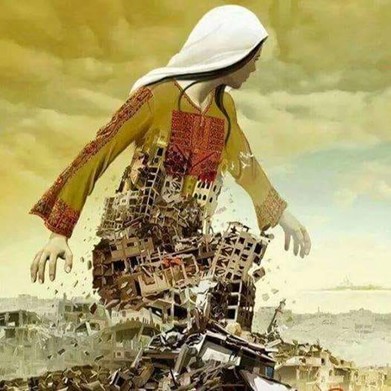
With the rapidly increasing reliance on digital material, digital preservation (DP) becomes critical to ensure long-term availability and understandability of information resources for further re-use and the development of new knowledge. DP is a crucial activity of information management in various organizational settings. However, the priorities in many areas on this planet go far away from preserving digital content and focus only on preserving the basic survival requirements of people.
Current State of Digital Preservation Services in Finland
Heikki Helin is Senior Technology Coordinator for Digital Preservation Services at CSC - IT Center for Science Ltd in Espoo, Finland
Two years ago, on WDPD2018, we wrote a kind of a status report about national digital preservation service in Finland. A lot has happened since then. As today is the 5th anniversary of our digital preservation service in production (yes, exactly today), it’s perhaps a time to give a short overview of what has happened since.
Back in 2018, we provided the preservation service only for the national cultural heritage sector, but during 2019 this was extended to also include research data (national universities, research institutes, etc.). All this within the remit of the Ministry of Education and Culture of Finland. This, obviously, increased the number of our potential partner organisations significantly, and especially the potential amount of data to be preserved. At the end of 2018, we had preserved about 200 terabytes of data, but today the number is roughly one petabyte. The amount of data is growing on an average of 1.2 terabytes per day, with data flowing in constantly 24/7.
Activities of Digital Preservation at the National Archives of Korea
National Archives of Korea(NAK) is a central archive affiliated to the Ministry of the Interior and Safety that systematically collects and preserves major records, provides archival information to the public and carries out various activities so as to promote an archival culture. NAK opened its doors in 1969 and it has since been growing and developing steadily at the central records and archives management organization in charge of national records management. At the present, it has several branch offices in various regions, including the Government Complex in Daejeon, National Archives, Seoul, National Archives, Daejeon, National Archives, Busan and Presidential Archives.
There had been growing interests on the digital preservation among collecting institutions in Korea for some time. Each institution had only dealt with it’s own challenges so far, however, rather than creating a collaboration mechanism. It was noteworthy that three collecting institutions met for the first time, on February 12 to pave a road to cooperate: National Archives of Korea(NAK), National Library of Korea(NLK), and the Korea Institute of Science and Technology Information(KISTI). They agreed on the need of a Korean version of Digital Preservation Coalition then.
In a couple of subsequent meetings, each participating institutions had chances to briefly share their past and current activities related to digital preservation: NLK performed various digital material preservation and digital service of online materials, KISTI conducted various research on digital preservation and NAK developed a digital format registry. They also discussed for cooperation agenda and agreed to organize joint seminars and regular meetings.
Digital Challenges Facing the National Archives of Japan
Etsuko Watanabe is the Chief of International Liasion Team at the National Archives of Japan.
National Archives of Japan (NAJ) is a government organisation which serves to ensure the proper preservation of, and provision of access to, public records with historical/evidential value. Over two decades have passed since archivists all over the world started to tackle issues brought about by ever-evolving digital technologies; however, the governments’ records in Japan have been preserved in physical (mainly paper-based) formats as original records, even though they were digitally generated. As of March 2020, the digital records account for only 0.1 % of our entire holdings (1.54 million volumes). In addition, the transfer of digital records created by governmental bodies started in 2011, and their total amount still remains at 1,759 volumes.
Along with the governments’ policies, digital records acquired by the NAJ are, in principle, converted to long-term preservation formats in order to ensure their readability. They were then preserved in the system for transfer, preservation and use, which is called the “Electronic Records Archives of Japan (ERAJ).” To ensure the preservation of digital records, we undertake the following processes: (a) creating metadata, (b) ensuring security, (c) integrity checks of digital files, and (d) carrying out proper backups. Long-term preservation formats for acquired records to be converted are regulated as PDF/A-1 (ISO19005-1) and JPEG 2000 (ISO/IEC15444) depending on their file format. In addition, it is specified that acquired records should be preserved in their original formats when they are unable to be converted, or need to be preserved in their original form. So far, the file formats of Microsoft Word and PDF are often seen among these acquired records.
Future development: Unbounded • Symbiosis
Zhenxin Wu is Professor of the Information System Department, and Deputy Director of the Digital Preservation Center of Chinese Academy of Sciences at the National Science Library in Beijing, China. She is also responsible for the technical system and data archive for NDPP (National Digital Preservation Program).
The following blog is also available in Chinese below:
This year, the sudden epidemic has had a huge impact on the world. Out of necessity, the global situation has greatly promoted the speed of digital transformation in various organizations as well as the increase of online communication, for example, #WeMissiPRES in September was successfully held online. The National Science Library of CAS has provided several information services to support research on COVID-19, such as VPN-based online access, fast thematic information services and tracking of the latest global research progress. With the changing states of COVID-19, these changes have gradually become the norm.
It also makes us more clearly aware of the impact of this ‘black swan event.’ We realize that an approach of "unbounded symbiosis"(that is to say, living and working together without geographic boundaries) is more suitable for the global fight against the epidemic, as well as for various industries in the digital age, and of course it is especially suitable for the future development of the digital preservation community.
2020 – an annus horribilis, but not for our collections
Serena Coates is the Lead of Preservation Services at the State Library of Queensland.
To say that 2020 has been a challenging year is somewhat of an understatement. In Australia, the year started with horrendous bushfires over much of the nation, and then of course, COVID-19 affected the world on a scale hitherto unknown to current inhabitants of planet Earth.
These history-making events were captured on our phones, shown on our televisions, discussed on social media, and will have a lasting effect on our psyches. As a collecting institution, State Library of Queensland has responded to these global events at the local level, by capturing the stories of 2020 and preserving them for future generations.
To date, State Library of Queensland has collected and archived over 2000 images, videos, digital stories, oral histories, ephemera, realia, and emails relating to Queensland’s experience of and response to COVID-19. Through a mixture of donations from the public, commissioned works from documentary photographers and storytellers, and web archiving, we have captured a broad cross-section of experiences of Queenslanders during this challenging year.
Pivoting into a Pandemic - Doing Digital Preservation for Good
Lee-Anne Raymond is the Senior Coordinator (DAMS) at Museums Victoria.
The recovery rescue of valuable digital images from relative oblivion sometimes takes a pandemic lockdown to achieve. Whilst a viral outbreak of global proportion has delivered us anxious and uncertain times, it has also presented us with unique opportunity.
In late March 2020 as the Covid-19 Pandemic hit Australia’s public institutions, including Museums Victoria (MV), were transformed overnight. Only those with essential worker status were permitted access, ensuring precious collections and infrastructure were safe. MV’s essential workers variously relayed how strange it was to see the place so bereft of staff, volunteers and visitors “...the Museum is so quiet”.
Memory Bank: Collective Isolation Project
Toni Burton, Collection Curation & Engagement Manager & Bridie Flynn, Senior Librarian Victorian & Australian Collections, State Library Victoria.
As the impact of the COVID-19 pandemic started to unfold, it was clear that State Library Victoria needed a rapid collecting response to ensure that this event was documented and recorded.
Memory Bank: Collective Isolation Project developed as a cross department initiative to engage audiences in the act of citizen collecting. Using a series of weekly prompts, highlighted by existing collection material, people were invited to contribute their own documentary material to record their individual experiences. The prompts allowed collection and curatorial staff to guide the type of material we would like to receive and consider what might be important for future generations of researchers. A wide range of responses were received but due to the nature of the way people were living most submissions came in the form of digital content.
Keeping the Record: Digital Preservation and Schools
Ros Malone is a Counsellor for The Australian Society of Archivists.
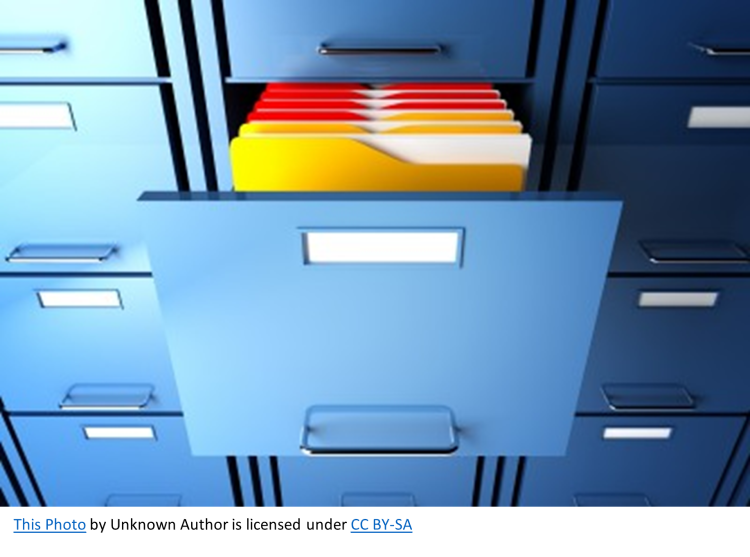
It is important for schools in Australia not to misunderstand the central findings and recommendations of the Commonwealth of Australia’s Royal Commission into Institutional Responses to Child Sexual Abuse, handed down in December 2017.
For school archivists and recordkeepers, the key to understanding is in the title of the enquiry.
Because for many schools across Australia, it was revealed that it was their response to allegations of, and enquiries about, child sexual abuse that was their greatest failing.
Preserving Australia’s Digital Memory of the Pandemic and beyond
Karuna Bhoday is the Assistant Director of the Integrated Archival Management System Project at National Archives of Australia.
The National Archives of Australia provides leadership in best-practice management of the official record of the Australian Government and ensures that Australian Government information of enduring significance is secured, preserved and available to government agencies, researchers and the community
The National Archives has two key roles under our Act:
-
to provide access to the Commonwealth government records which document the memory of our nation (connect Australians with their identity, history and place in the world); and
-
to advise government agencies on the creation, management, including authorised disposal, and access of information and data to ensure:
-
government is transparent and accountable;
-
evidence of the actions and decisions of the Australian Government is created; and
-
that information is kept and is accessible for as long as needed.
-
Home and Away for Digital Preservation
Andrea Goethals is the Manager of Digital Preservation at the National Library of New Zealand
This post is about the adjustments our digital preservation team at the National Library of New Zealand made during and after our Covid-19 lockdown.
Before Covid-19, with a couple exceptions, most of the Preservation Research & Consultancy (PRC) team came into the Library building in Wellington to work five days a week. One of us already worked remotely full-time from Auckland, and occasionally a few people worked from home, on the order of a day every other week.
Back in early March 2020, our team had been working on our BCP (business continuity plan) as part of our routine tasks. The BCP had different scenarios to plan for, for example, losing access to our building, which called for working from home as our strategy. We decided to test out our team’s ability to work from home one day - Friday March 20. As it got closer to our test day, the news about Covid-19 started increasing around us. On March 18 the entire Library was told to work from home on March 20 as a test. We started to realize that our test day might intersect with a real call for us to start working from home. A few days beforehand we did two things that turned out to be important in hindsight.
Digits:\> For Good
The theme for World Digital Preservation Day (5th November if you hadn’t noticed) is Digits: For Good.
I have improvised the punctuation in my title to look like the old DOS prompt, suggesting crudely that ‘Digits’ are the configured infrastructure which makes everything (anything) possible and ‘For Good’ is the routine we execute: ‘Digits’ as the universal virtual machine: ‘For Good’ our programmatic but achievable goal.
I like the theme this year, not just because it tells me that World Digital Preservation Day is mature and ambitious enough to carry a theme greater than the simple ‘connect and communicate’ of previous years. I like it because there’s a double meaning and both of them seem fitting: digits for ‘ever’ and digits for ‘better’.
It’s no surprise that the digital preservation community is interested in the ‘forever’ bit, even if we usually pivot to something shorter than forever. Mostly we don’t mean to keep digits for ever, and mostly we wouldn’t promise it either. It is perhaps less obvious that digital preservation is also for the common good and perhaps it’s time to put that right. This year’s theme reminds me that we don’t do digital preservation for the sake of the bits and bytes: it’s not ‘good for the digits’. We do it because of real world impacts we can have with the digits that we work for. That means we dive deep into file formats and fixity and storage and such, but you’d be wrong if you thought that was also our purpose. Here we are geeking out about representation information and all the while digital preservation helps deliver healthier, wealthier, safer, smarter, greener, more creative and more transparent agencies, communities and individuals: goals which we wouldn’t be able to achieve, or perhaps even imagine, without access to a trusted and secure digital legacy. This year’s theme encourages a reflection on human aspects of digital preservation: the labour that makes it possible and the aspiration that makes it desirable.
World Digital Preservation Day: 5th November - Expecting a spectacle
Remember remember the 5th November...
For us here in the UK this date usually means fireworks, toffee apples and huddling round a bonfire as we mark Guy Fawkes Night or Bonfire Night. It’s usually freezing, often raining, but a tradition many* observe anyway as it offers the chance to come together as friends and family, and ‘ooh’ and ‘aah’ at an impressive spectacle whilst eating sweets and treats.
*I know that fireworks are not favoured everyone, most espeically by our dogs of digital preservation. Please enjoy thoughtfully.
I’m not sure there will be many community bonfire-side gatherings this year given the pandemic and various lockdowns still in force, but I’m not at all worried because we have:
Earthrise: WDPD+1
The Sun has now set on another World Digital Preservation Day: it’s been down for a while already and this post is really a late echo. But universal laws of motion tell me that the Sun doesn’t rise or set. It’s the Earth that rises.
2019 is, of course, the 50th anniversary of Apollo 11 (and the less celebrated but altogether more joyous Apollo 12), travelling ‘in peace for all mankind’. For a moment people in every continent cheered as a man called Armstrong walked upon the moon. At one point in lunar orbit, Michael Collins could look back towards the Earth (as Dick Gordon could do a few months later) and hold in a single view the entire human family. It’s the ringside seat of all time: to spectate as our tiny planet spins through the blackness of space, sustaining the entire freight of human history.
Finding the balance: Multidisciplinary teams in digital preservation
Sarah Mason is Systems Archivist for Artefactual Systems Inc. and is based in the UK
World Digital Preservation Day is a great chance for the digital preservation community to celebrate achievements, to reach out to those outside and bring them into the community; it is also a chance to discuss what challenges we face and what opportunities are out there to help us move forward. So in the face of challenges that involve funding, staffing, and managerial or IT buy-in, how do we preserve the ever increasing volume and complexity of digital materials?
One way that we can face these kinds of challenges is by collaborating as part of a multidisciplinary team. Bringing together a diverse range of expertise, the team at Artefactual Systems is comprised of analysts (who represent domain specialists from archivists to librarians), developers, and systems administrators. Together, we can use of different viewpoints and specialisations to collaborate on digital preservation solutions--in different geographic locations! We understand that in this field no one person can know it all; sometimes it takes many voices to address issues in a balanced way.
La preservación Digital en Latinoamérica
Alexander Barquero es director del Archivo Nacional de Costa Rica y Coordinador del Grupo de trabajo sobre Gestión y Preservación de Documentos Electrónicos de la Asociación Latinoamericana de Archivos
[English version follows]
En un mundo globalizado, transformado por las sociedades del conocimiento e inmerso en la cuarta revolución industrial, los países de la región latinoamericana tienen un gran reto (y una gran oportunidad) para potenciar la capacidad productiva de sus habitantes y obtener el máximo provecho a la constante e imparable producción intelectual, técnica y tecnológica del mundo. Los recursos con los que cuenta cualquier administración para trabajar siempre serán limitados, y en el caso de los países latinoamericanos esto es una constante que pareciera no fenecer pronto. Ante esta realidad, los gobiernos, instituciones, empresas y ciudadanos se ven obligados a la búsqueda continua de opciones que logren aprovechar eficientemente los recursos económicos y talento humano, así como la infraestructura física y tecnológica.
It Takes a Village… to Manage Digital Assets
Helen Hockx-Yu is Enterprise Data Architect at the University of Notre Dame in the USA
The University of Notre Dame (UND) is a private research university located in the United States. I joined UND in 2016 as a programme manager for digital asset management. Since 2009, various initiatives have taken place to address the challenge but they have largely been specific in their scope and not broadly adopted across the University as a whole. I was expected to build on the previous work, to refocus and come up with a new plan. My web archiving and digital preservation background were thought to be relevant and helpful - the executives who entrusted me with this important work were the University Librarian and the then Chief Information Officer.
My first challenge was to understand the definition and scope of digital asset management, as the term often relates to rich media such as digital videos, animation, graphics, photographs, audio files, logos and marketing collateral. Digital Asset Management (DAM) systems emerged in the 1990s in the private sector to support digital media creation, marketing, publishing and brand management, and their customer-base mainly consists of commercial organisations.
Perspective in Digital Preservation
Alberto Castro Thompson, Ana Yuri Ramírez Molina and Lisandro Pablo Olivares work in the Innovation and Digital Strategy Coordination (CIED) team at Biblioteca Nacional de México
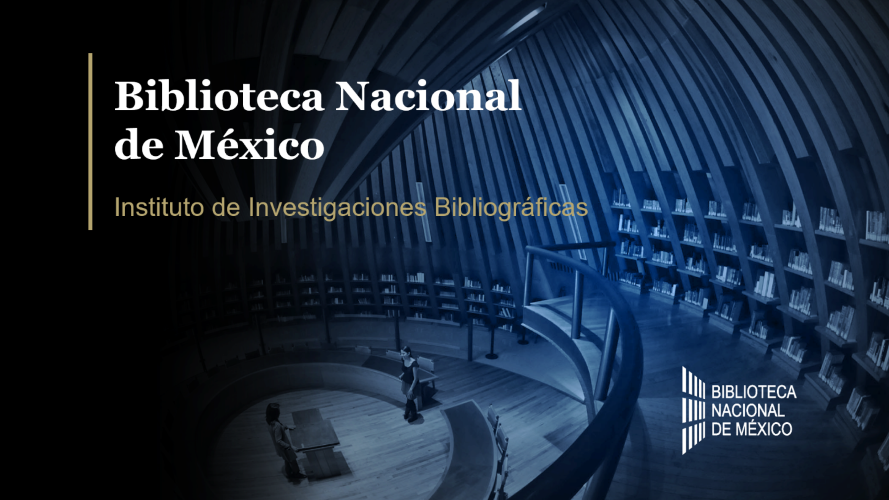
The National Library of Mexico (BNM) is legally empowered by a Decree of Legal Deposit of national scope since 1812[i] and last modified in 1991, being in this reform where publications in electronic formats are included for the first time.
DOCUMENT THIS. And this. And this, too.
Amy Rudersdorf is a Senior Consultant with AVP in the USA
As a consultant with AVP, I work with many different types of organizations to help them assess and optimize their digital preservation programs. I have the opportunity to really dig into the inner workings of these digital preservation environments. I've found that it is very common for institutions to have very little documentation relating to their digital preservation programs. Sure, you know what you're doing, but there are so many other reasons to create documentation!
Stewardship with a network logic
Brian Lavoie is Research Scientist for OCLC in the USA
An important class of at-risk digital materials is the myriad forms of output generated over the research lifecycle – think of data sets, computer code, online discussions, e-lab notebooks, and so on. Growing recognition of the value of these materials to the scholarly record has led to many efforts to collect and preserve them over the long term. But mitigating risks associated with preserving digital research outputs means setting up stewardship arrangements that are well-adapted to the evolving nature of today’s scholarly record. For that, we need stewardship with a network logic, or conscious coordination.
What if online services had a time dimension?
Euan Cochrane is Digital Preservation Manager at Yale University Library
Online web services are used by billions of people every day. They impact our lives and society in a myriad of ways. The way they present data to us and the ways they manipulate and transform the data we store in them have the potential to change behaviour and our understanding of the world. And this is all being done at a scale unimaginable in previous history. These services have changed greatly over time. Many of those changes are not publicly documented or even known to the general public. I’ve outlined a few of those we do know of below:
Preserving and Integrating Community Knowledge of Computing Systems
Ethan Gates is Software Preservation Analyst, Digital Preservation Services at Yale University Library in the USA
The efforts of the EaaSI (Emulation-as-a-Service Infrastructure) project and the Software Preservation Network to preserve the software and computing environments around digital objects have revealed that a parallel effort needs to be made to preserve the expertise and knowledge necessary to use and interact with such environments. Scanning software manuals and printed guidebooks, photographing boxes and physical media, archiving the web sites of developers, enthusiasts and community forums - all of these are necessary activities, largely happening on an ad hoc basis in the digital preservation community if at all. Dedicated, collaborative initiatives on this front are essential to make sure future users are able to interact with authentic digital objects in context.
One of the student workers we employ in the EaaSI program once came to me with a troubleshooting problem. This is not unusual - our diligent student team is tasked with cataloging and attempting to install a vast range of legacy software applications, and between quirks in the applications, quirks in the necessary operating systems, quirks in the emulators running them and quirks in Yale’s beta installation of the EaaSI platform, any number of questions can come up. The student was having trouble with an application running in MacOS 7.5: the menu bar at the top of the screen seemed to be glitching, constantly closing before they could access the settings and preference menus that are often our best source of information about a given piece of software (language configuration, file format capabilities, etc.)
Inspiring Confidence: Securing ARCW Security
Sally McInnes is Chair of the ARCW Digital Preservation Group and Head of Unique Collections and Collections Care at the National Library of Wales
It has been two years since the Archives and Records Council launched its National Digital Preservation Policy on International Digital Preservation Day, 2017. Since then, ARCW has made considerable progress in supporting the policy, the aims of which are to:
- To ensure digital resources of enduring value are selected for preservation and remain authentic and accessible in the future.
- To provide a framework for the development of digital preservation strategies that can be adapted for use by organisations throughout Wales, irrespective of their size and capacity.
- To raise awareness of the importance of effective Digital Preservation among archive institutions and practitioners, managers, information technology staff and stakeholders / decision makers.
Taming the Pre-Ingest Processing Monster
Sheila Morrissey is Senior Researcher at Portico, based in New York
We hear again and again that, first, one of the biggest threats to ensuring long-term access to our digital heritage is the cost of preservation, and, second, that one of the critical cost drivers is the set of activities associated with selection, acquisition, and other pre-ingest processing (such as quality assurance of acquired artifacts).
As the amount of content in preservation archives grows at geometric rates, and as the artifacts in ever-increasing input streams continues to evolve, sometimes unpredictably, into varying new complex forms, how do we scale what might be called “pre-ingest” activities without scaling up our costs at the same rate?
Charting the Landscape: A digital content review for effective long-term preservation planning
Daniele Balduzzi is IT Officer/Archivist and Shiri Alon is Archivist at World Bank Group Archives
A year ago, our colleagues Jeanne Kramer-Smyth and April Miller published a post about the people and process investments required for the Archives of the World Bank Group (WBG) to fully handle both analog and born-digital records. In this post we will discuss how we are defining the digital landscape of the WBG in order to shape and refine our long-term digital preservation strategy.
Planning for long-term preservation of digital content is a challenging task, often resulting in more unanswered questions than definitive decisions. It’s a complex effort, but also an iterative process with a staggered implementation: setting a course for a distant future in a dynamic present requires a solid sturdy boat, a clear map to refer to, and the agility to navigate in uncharted waters.
The Pre-Digital Preservation Black Hole
Eng Sengsavang is Reference Archivist for United Nations Educational, Scientific and Cultural Organization (UNESCO) in Paris, France
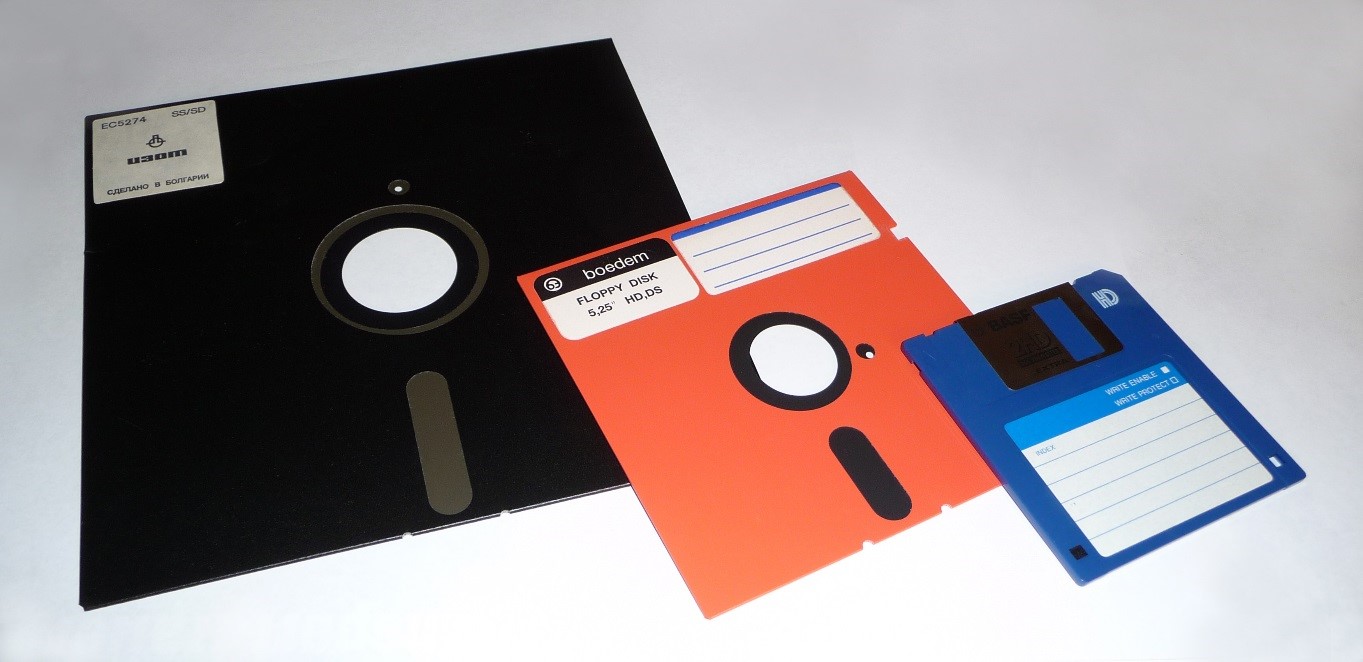
Credit: George Chernilevsky: https://commons.wikimedia.org/wiki/File:Floppy_disk_2009_G1.jpg#/media/File:Floppy_disk_2009_G1.jpg
My experience of technology is inevitably historical: as a child of the 80s, an adolescent of the 90s, and an adult into the 2000s, I experienced first-hand the paradigm shift from analogue to digital technologies, alongside the continual accrual of different eras of technology co-existing simultaneously. Of course, not only mine, but every person’s experience of technology is necessarily historical: throughout our lives, we experience on a deeply personal and at the same time macro level the mutations of technologies that seem to gather speed over time, new technologies continually appearing and old ones disappearing or threatening to disappear, and being replaced or persisting in ways both predictable and unexpected.
On a Transparent Process for Digital Preservation
Leslie Johnston is Director of Digital Preservation at the U.S. National Archives and Records Administration (NARA) in Washington DC, USA
The Strategic Plan for the U.S. National Archives and Records Administration outlines a vision to ensure ongoing access to government information. Digital preservation is crucial for this work, as evidenced by the June 2019 direction (M-19-21, Transition to Electronic Records) to Federal agencies to transition to a fully electronic government and to end the National Archives’ acceptance of analog records after December 31, 2022.
The Strategic Plan also embraces an Open NARA, one that is both transparent about its operations and participates in an open community where it can learn from the insights of other organizations. As part of achieving that goal, NARA has released its Digital Preservation Framework for public comment. The release of this framework will allow NARA staff, federal agencies, the public, and our colleagues in the archival and preservation communities to weigh in and assist us in creating the standard for digital preservation in the U.S. Federal government. We want to ensure that both our process for identifying and mitigating risk in the electronic records that we preserve and make accessible and the decisions that we have made are as transparent as possible.
Teaching a Young Dog Old Tricks: Emulation Research at the National Library of Scotland
Sara Day Thomson is Research Officer at the DPC | Graham Purnell is Digital Preservation Assistant at the National Library of Scotland
1: Getting Our Feet Wet in Emulation
World Digital Preservation Day celebrates all the inspiring work being done in digital preservation around the world. It celebrates innovative tools and techniques, effective advocacy and awareness-raising, and collaboration among fellow practitioners. This summer, I got to experience all of those things at the National Library of Scotland (NLS) as part of a digital preservation skills upgrade.
It all started when Lee and Graham - the digital preservation team at NLS - agreed to let me help them with some speculative research into emulation for digital preservation and access. I learned a lot about emulation as a technology but also about the real-life, facepalming frustrations of trying to coax 20-odd year old software to work properly on a legacy OS built in VirtualBox.
While the research was limited to a few test cases just to get our feet wet, I came away with a much deeper understanding of the opportunities and limitations introduced by emulation as a digital preservation strategy for heritage institutions. With patience and good humour, Graham taught this young dog some old tricks.
But before I get to the juicy bits, I thought I’d paint the scene a little with a few basics about emulation for those readers who, like I did, need a refresher.
If you’re all up to date on emulation as a digital preservation strategy, feel free to skip to section 3: It works! Wait, is it working?.
Estamos perdiendo la credibilidad
Hernán Cabrera Pichuante es Jefe de Proyectos Técnicos del Proyecto de Modernización de Archivos Nacionales de Chile (National Archives of Chile)
[English version follows]
Estamos llenos de información almacenada y muchos de mis conocidos en el área de TI insisten en que la copia no solo es segura, sino que, prácticamente eterna.
Es frecuente ver como las políticas de respaldo de los activos tecnológicos llenan bodegas con cintas magnéticas creadas en modernos sistemas automáticos de respaldo.
Es frecuente ver como una y otra vez, al querer recuperar algo la respuesta es: ¿te acuerdas de más o menos de que fecha es lo que me pides?
Es más frecuente aún, que luego de un par de días de búsqueda, la cinta se encuentre y lo que sigue es que estas, por lo general, contienen más de una versión del mismo documento y nos preguntamos …y ¿cuál de todos estos documentos es el que busco?
La Red Iberoamericana de Preservación Digital de Archivos Sonoros y Audiovisuales (RIPDASA) frente al riesgo de pérdida de los archivos sonoros y audiovisuales
Perla Olivia Rodríguez Reséndiz es Coordinadora de Red Iberoamericana de Preservación Digital de Archivos Sonoros y Audiovisuales (RIPDASA) e investigadora de la Universidad Nacional Autónoma de México (UNAM).
[English version follows]

En el Día Mundial de la Preservación Digital es necesario recordar que subiste el riesgo de pérdida, tanto de las grabaciones sonoras y audiovisuales registradas en soportes analógicos como de las que fueron creadas de origen digital. Este es un peligro latente y un problema social contemporáneo que afecta a todos los archivos. No obstante, son especialmente sensibles a esta pérdida los países que hasta ahora no han puesto en marcha políticas y estrategias de preservación digital sustentable.
Preservación digital: la comunidad profesional como base para su desarrollo
Gabriela Andaur Gómez es Profesora Asistente, Facultad de Economía y Negocios, Universidad Alberto Hurtado, Consejera, Comité Memoria del Mundo – Chile (UNESCO) y Archivera, Proyecto de Modernización, Archivo Nacional de Chile
[English version follows]
Desde hace algunos años hemos visto como dentro de la comunidad profesional latinoamericana ha comenzado a instalarse la preocupación sobre la preservación digital. Este discurso ha comenzado a permear, aunque lentamente, en las instituciones archivísticas locales y las comunidades vinculadas al patrimonio documental. No obstante, falta mucho para generar conciencia sobre la fragilidad de los documentos en el entorno digital, de tal manera de pasar desde la comprensión del problema al avance en su solución.
Uno de los mayores problemas que enfrentamos es la parálisis. Estamos aprendiendo que la preservación digital es una tarea gigantesca y sin fin, que requiere recursos constantes (y superiores a los que solemos tener), la aplicación de estándares técnicos diversos a los que no siempre tenemos acceso, además de competencias distintas a las que hemos estado adquiriendo en nuestros programas de formación archivística. ¿Cómo preservaremos nuestros documentos electrónicos si no tenemos claro cómo ni dónde empezar? ¿dónde obtendremos los recursos necesarios? ¿cómo nos capacitaremos? La problemática es tan compleja que el miedo y la parálisis son las primeras reacciones, y acabamos por no hacer nada al respecto.
If you can’t start big, start small
Millard Schisler is Adjunct Faculty for the Online Master’s in Museum Studies at Johns Hopkins University. He lives and works with Digital Preservation in Brazil
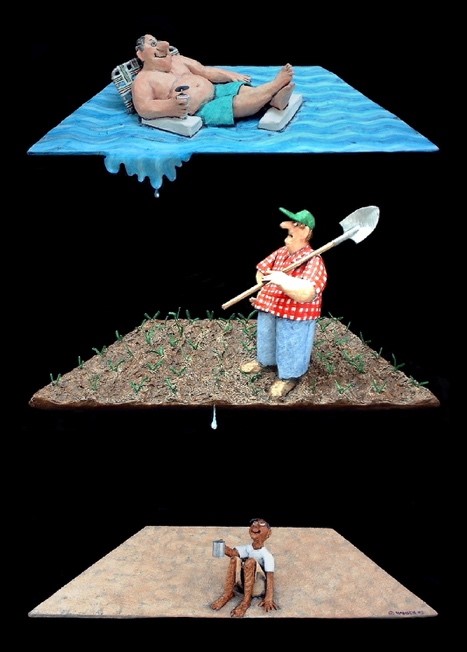
I have always liked the image of the three-dimensional sculpture figures created by artist Stephen Hansen as a way to illustrate the “trickle-down economics” of the Reagan era – it is pretty much self-explanatory as to the “distribution” of wealth. This image also comes to my mind when I think of the international and national organizations that brand the need for digital preservation in their meetings and conferences and create manifestos and guidelines to steer us all. I am grateful for this work, and am not against these efforts and strategies, but many times these ideas seem to take a long time to trickle down to the bottom where everyday life is, much like this image.
How to sell an archive
Alistair Goodall is Head of IT for Crossrail Ltd in the UK
Last year we were the proud winners of a Digital Preservation Award for our Crossrail archive and I was lucky enough to experience the passion and enthusiasm for digital preservation at the awards ceremony.
Since then we have successfully closed down some of the applications associated with the early stages of our 10 year project (such as land acquisition and property access requests) and these are now available through our Crossrail archive. The Crossrail project itself has, however, been delayed beyond December 2018 and we are in our most information intensive stage with testing, commissioning and certification underway.
Sharing format preservation information and how this will benefit us all
Jon Tilbury is CTO of Preservica, and is based in the UK
World Digital Preservation Day is all about the global community coming together to share ideas and collaborate. So how can we all work more closely on sharing format preservation information and what is the value of doing this?
Augmenting the community, lowering the risk internationally
Antonio G. Martinez is CEO & Founder of LIBNOVA and is based in Madrid, Spain
Last year in our guest blog post for the DPC we wrote about “Do you D.P.?” and we commented that there is no “DP yes or no, but, up to what level of DP can you go?”. This year the theme for World Digital Preservation Day is ‘At-Risk Digital Materials´.
As we mentioned last year, it was the less D.P. intense communities that were picking up the tune of the more energetic entities, at many levels. Over the last few years we have been sensing that the ‘At-Risk Digital Materials’ menace is being taken very seriously indeed by big and small cultural heritage institutions across the globe and that those international entities are picking up speed by their own accord. Many of these international entities are turning to other older and established associations to contrast their fears concerning digital preservation. They realise they are not alone on many issues; it is quite an international concern. And this takes me to another point.
Deep Enough For Sharks
Sean Barker is an Information Management Specialist
I have an embarrassing admission to make. For years, part of me worked on the LOTAR project (1) developing preservation standards for Product Data Management (PDM), while another part was making those standards obsolete by creating an Integrated Design Environment. And I didn't connect the two parts together.
The first thing I should do is not explain PDM - it's too complex for a short blog and people shouldn't worry about it unless their project gets bigger than a team-of-teams (about eighty people). Think of PDM as provenance on steroids, where even a simple sign-off is backed up by a ten-volume procedures manual and where the people who sign the approvals must be approved to do so by an approved organization.
From ‘starting digital preservation’ to ‘business as usual’
Anna McNally is Senior Archivist at University of Westminster in the UK
The University of Westminster’s Records and Archives team manage the institutional records of the University (founded in 1838), alongside the deposited records of several architects and town planners, and a garment collection (the Westminster Menswear Archive). We started actively managing digital records in 2016 but, in a relatively fast-paced area (compared with paper records!), it’s hard not to always think of yourself as a beginner. In 2017 we recorded a webinar titled ‘Work In Progress’, which - despite having been in production for nearly 3 years now - is still how I would describe our digital preservation activities. While our software solution gives us confidence that we are meeting our targets with the NDSA levels, we’re aware that there is a lot more we could be doing.
What can our memory institutions teach us about fake news?
Dr David Tarrant is the senior learning advisor at the Open Data Institute (ODI).
I would first like to thank the work of the BBC for the research behind this article that was broadcast in “Ian Hislop’s Fake News: A True History”. I have added to the story with details not included in the programme and checked these using a combination of sources.
So what can our memory institutions teach us about fake news?
It’s just not always a clear cut: Digital, analog and everything in between.
Brecht Declercq is Digitisation and Acquisition Manager for VIAA in Belgium
At first glance, there is a strict distinction between carriers of analogue and digital audiovisual information. But in practice, this distinction is not always clear. There are even carriers of audiovisual information that can hardly be catalogued under one of those two names. The word ‘digitisation’ is therefore not always used correctly. Moreover, there is an important difference between digital information, file-based information, and information stored on mass storage systems. By taking a closer look at the history of digital information storage, it becomes clear that the world has not made the switch overnight. There are decisive inventions, but more often even very long-term evolutions. Both inventions and evolutions, of which the importance is almost forgotten, even prove to be essential for understanding where we have arrived today, and how we can preserve any audiovisual information.
I’m Gonna Preserve (500 Files)
I don’t think anyone could disagree that the highlight of last year’s World Digital Preservation Day was the State Library of Queensland’s outstanding parody song “All the Corrupt Files”. There was singing! There was dancing! There were costumes! There was high production value! There was even an awards ceremony!
And this year they’ve knocked it out of the park again as Preservana and “Smells Like Digital Preservation”. The University of Melbourne has also joined the party with the wonderful piece of story telling that is “Bits and Bytes”, which introduces two new characters that are quickly gaining a legion of fans. And to keep the music themed fun going there’s also a digital preservation themed playlist by the folks at the Netherland’s Institute for Sound and Vision.
Here at the DPC we couldn’t be left out of the fun, but what could we do? What classic song could we reinterpret? And how could we make it just that wee bit Scottish? Suddenly the answer was clear, there really was only one choice….
So please enjoy our entry into the digital preservation song contest (sadly due to time it’s minus the creative production of those above!)
BitList 2019: The Global List of Digitally Endangered Species
The BitList 2019 is the first complete revision of the list since initial publication in 2017.
Whereas The BitList was experimental in 2017 and 2018, the 2019 edition is considerably more robust in content and process. In part this is because it has established a small but definite following. The DPC has been asked to report and expand our 2017 recommendations in multiple contexts, and professionals in agencies around the world have reported their own use of The BitList to support advocacy and target resources to greater effect. That constitutes a success in relation to what we hoped to achieve in 2017, so in this edition we move from hopeful experiment to practical and continuing contribution back to the digital preservation community which have shaped and used it.
One Size Fits All?
Eld Zierau, Jette Junge, Claus Jensen and Lars Lundegård Olsen form the specialist group for digital preservation at the Royal Danish Library
There is a growing tendency in libraries and archives to strive for standard solutions, and a conception that all digital preservation challenges can be solved by one product. Our claim is that trying to achieve this constitutes one of the biggest risks for all types of materials.
The merger of two national libraries with the same goals and under the same jurisdiction has revealed how much the devil is in the detail and how the thought of “One Size Fits All” is indeed questionable within digital preservation as for many other areas. As it turned out to be so hard on a national level, it is surely much harder at an international level where there are legal and cultural differences.
Assessing where we are with Digital Preservation
Fabiana Barticioti is Digital Assets Manager at LSE Library
The DPC launched their Rapid Assessment Model (RAM) to members in September. To keep the momentum going I completed the assessment, in consultation with other colleagues, and submitted it to DPC immediately. I strongly recommend all membership to do it and help DPC to benchmark the DP community efforts.
For you, for me, for everyone? - The risk of discrimination in digital preservation practice
Michelle Lindlar is Digital Preservation Team Leader at Technische Informationsbibliothek (TIB) in Germany
DISCLAIMER: This post is an opinion piece and by no means perfect. So, grab a hot chocolate with your WDPD slice of cake and enjoy the ride.
One of the most discussed things at iPRES2019 this year was probably Michelle Caswell’s keynote Whose Digital Preservation? Locating Our Standpoints to Reallocate Resources. As there are many people who are much smarter than I am and know much more about feminist and archival theory, this blog isn’t about the keynote. I also know little about archival appraisal – a main focus of Caswell’s talk. Instead, this is more of a personal train-of-thought / opinion-piece sparked by questions I asked myself after the keynote: “Do we discriminate in digital preservation practice? How? Why? How can we be aware of this and move towards a more social / ethical digital preservation practice?”
PREMIS News & Highlights for 2019
Karin Bredenberg is Chair of the PREMIS Editorial Committee. She works for Kommunalförbundet Sydarkivera/The Municipality Organisation Sydarkivera in Sweden.
2019 has been a very productive year for the PREMIS Editorial Committee!
We’ve welcomed several new members to the EC this year and have made significant progress in various areas.
The release a year ago of the PREMIS 3.0 OWL Ontology led the EC into discussions regarding the relationship between the ontology and the PREMIS Data Dictionary and other discussions regarding Rights. A Rights working group is currently preparing a short paper relating to recent developments in this area.
You'll miss it when it's gone...
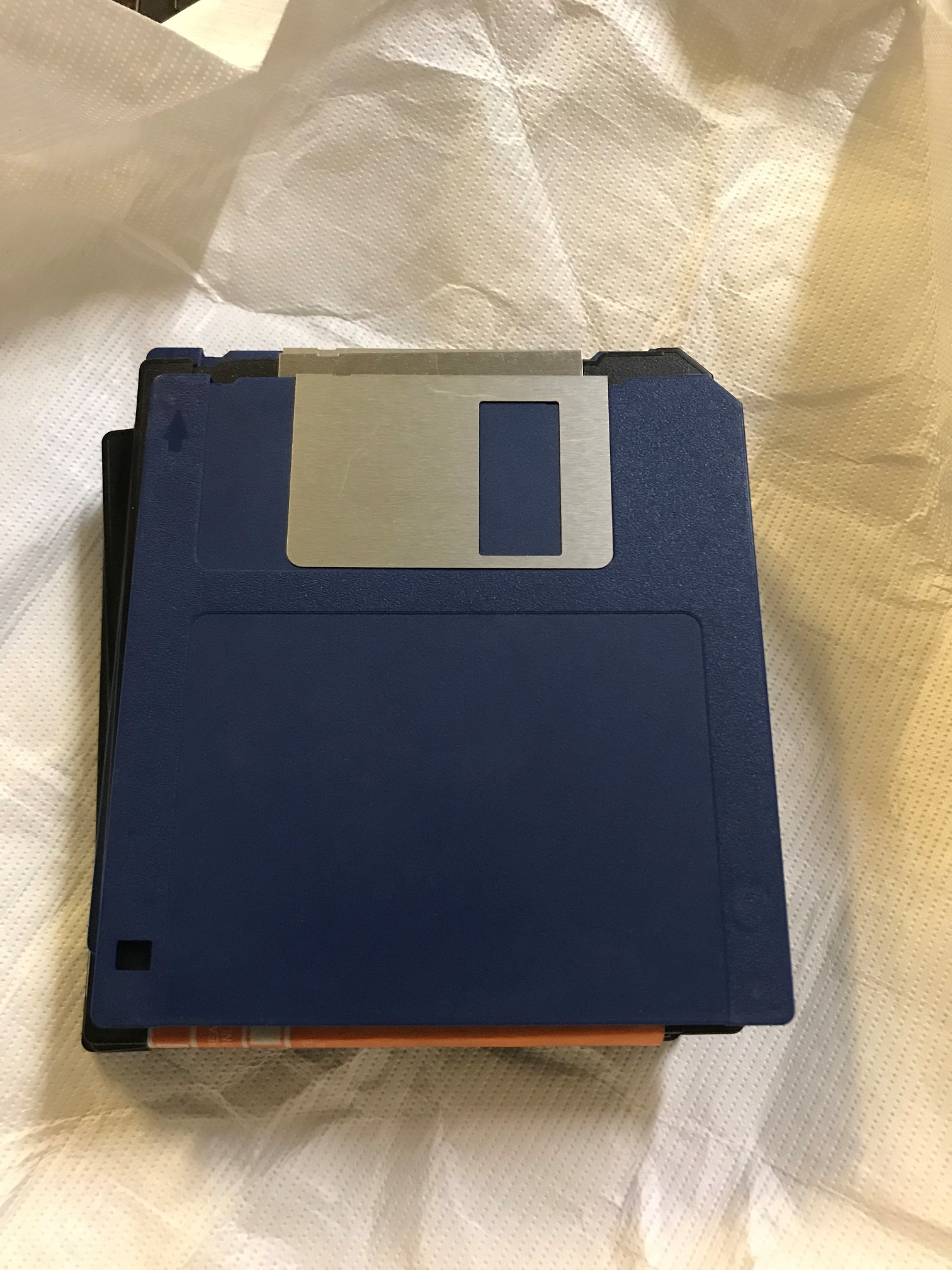
Three and a half inch floppy disk
When I first started out swimming in the deep waters of digital preservation and trying to understand what the risks were I lived with the fear that format obsolescence was our number one enemy and that we would need to spend all our time migrating content and upgrading and or else we would never be able to open those old Word Perfect files. However even then there were wise words from the likes of David Rosenthal who as long ago as 2007 and he predicted not a cliff edge crash of format types that would remain beyond our reach but a slow drift which (hopefully) with increasingly sophisticated emulation (and migration) techniques we can keep abreast of. My first steps in dealing with some of our legacy digital collections (all the way back from the 1990s) were imaging and capturing the contents of the floppy disks belonging to the distinguished historian Eric Hobsbawm which I wrote a bit about here.
Influence of Blockchain Technology on Protecting Trustworthiness of Electronic Records
Özhan Saglik is Lecturer at Bursa Uludag University in Turkey
Blockchain is one of the latest discussed technologic issues in records management. Questions like 'does blockchain shift our practices radically?' and 'how does it affects the trustworthiness of e-records?' have emerged. We will discuss some points in terms of trustworthiness.
We analyse the trustworthiness of e-records in four stages. These are authenticity, realibility, accuracy and usability. Usability refers to the accessibility and readability by a user. Accuracy is the completeness of the records form elements and reliable records can get by the more and solid records management procedures. We define authenticity as preserving the attributes of records. It has two components: Identity and integrity. Identity is differentiating the records from others, and integrity refers to the non-alteration of the records’ message intentionally or unintentionally (International Research on Permanent Authentic Records in Electronic Systems [INTERPARES], 2008).
Creating SIPs without Breaking a Sweat: The Pre-ingest Tool and File Scraper
Heikki Helin is Senior Technology Coordinator for Digital Preservation Services at CSC - IT Center for Science Ltd in Espoo, Finland
The Finnish national digital preservation service, based on the OAIS reference model, has been in production since 2015. Providing services for preserving the cultural heritage and research data sectors, it is a service funded by the Ministry of Education and Culture of Finland. Currently, we have more than 1.3 million Archival Information Packages (AIPs) in preservation amounting to more than 450 terabytes. We have defined common national preservation specifications, which describe in detail how digital assets must be prepared before ingesting them to the preservation service. This includes detailed requirements for metadata and file formats.
Detailed requirements on both file formats and metadata are necessary for a fully automated ingest process. However, preparing and ingesting digital assets in an appropriate format according to the requirements can be a demanding task, especially in cases in which the producer is not familiar with the various preservation standards and metadata formats. This process requires both know-how and can be very time-consuming. It is therefore a very costly process, highlighted in those organizations with insufficiently competent IT staff. The growing demand for making this process easier for our partner organizations is the reason we have developed tools to decrease the burden of creating valid submission information packages from scratch. We introduce two main tools in this blog post.
Approaching digital preservation at scale - a pilot programme at University of Cape Town Libraries
Niklas Zimmer is Manager of Digital Library Services at University of Cape Town Libraries in South Africa
In this brief overview, I hope to share with you some of our experiences, activities and challenges around digital preservation at the University of Cape Town, at the southern tip of Africa. Presently, expertise in digital preservation is growing only slowly in South Africa: relevant training opportunities remain rare because many institutions have yet to recognise the fundamental issues, and get started with sustainably resourcing solutions. While some of our needs may be about driving appropriately funded and structured projects forward, even more important to our capacity-building efforts will be to convene a local digital preservation community of practise that is vitally connected to global exchange of ways of knowing and describing the world.
In September this year, I was asked to speak about digital preservation at the University of KwaZulu-Natal Special Collections Preservation Conservation Conference entitled ‘Disaster Prevention Preparedness, Response & Recovery of Collective Collections and E-collections,’ and while the slides from this talk are publicly accessible (see: https://doi.org/10.25375/uct.8982452), I thought it useful to also provide a brief narrative in the form of this blog post, to share more widely what digital preservation activities we are busy with at Digital Library Services in securing the University of Cape Town’s digital legacy.
Sharing is caring: tell someone new about digital preservation today!
Rise and shine digital preservationists of the western hemisphere! It’s World Digital Preservation Day, and all is well! There are things to see and do and celebrate – and people to tell about the wonders of digital preservation!
At-Risk Material in UCT Libraries’ Special Collections
Andrea Walker works in Special Collections at the University of Cape Town Libraries, South Africa
At-Risk Material in UCT Libraries’ Special Collections
This year, the first that UCT Libraries is participating, the theme for World Digital Preservation Day is At-Risk Digital Materials. It’s as if it was tailor-made for us. Even though I work in the historic, beautifully restored Jagger Library, I spend most of my time these days down in the basement, 2 or 3 stories underground (it’s hard to measure that when you’re on the side of a mountain). Right at the bottom is our AV archive. I’m currently undertaking an audit, to determine not only what’s there, but also what the exact format is, and when the material was recorded, among other things. Why? Because these materials only have a limited lifespan. Some of them were kept in less than ideal conditions before being deposited with us, and it shows. Most of them are in formats that are no longer easily accessible.
The UNESCO/DPC Executive Guide on Digital Preservation
Robert Buckley is the Chair of the PERSIST Policy Working Group and a Technical Adviser at the National Archives of the UAE.
UNESCO and the Digital Preservation Coalition (DPC) have collaborated to produce the Executive Guide on Digital Preservation, an online resource for raising awareness of the importance of digital preservation in archives, libraries and commercial enterprises—any organization that has digital assets to preserve and access. While many of us are often immersed in the technical aspects of digital preservation—in my case color image digitization and compression, it is generally realized that a successful and sustainable implementation of digital preservation requires support and commitment across an institution and beyond in the prevailing political, legislative and fiscal environment.
When digital preservation is turned into a municipality organisation
Karin Bredenberg is Metadata Strategist at Sydarkivera in Sweden
In 2015 the municipality organisation Sydarkivera was founded in southern Sweden with the goal of supporting members with digital preservation. Since then, with the growing number of members, the goal has also come to include analogue archiving. Today the number of members is 27 and in two years’ time an additional 10 will have joined Sydarkivera.
Sydarkivera originated from the need for municipalities to archive their digital information, as in Sweden, municipalities are required by law to have their own archives and act as their own archival institution. Digital information has been around for a long time so the arrival of the need for archiving digital material made the municipalities see the need to join forces and share their competences. In Sweden, municipalities can join in a municipality organisation which in turn functions like its own municipality. I know it’s not easy to really explain briefly but we are working together and have a shared archival organisation! What started in southern Sweden is quickly growing north towards central Sweden… There’s a wide interest in joining the organisation and becoming a Sydarkivera member!
A Reflection: Outreach about digital preservation
Matthew Yang Jiefeng is Archive Officer at the Asian Film Archive in Singapore
The Asian Film Archive (AFA) reflects on its recent engagement with film students during an outreach session. The interaction with the students revealed that complacency is a major plague amongst content producers, posing a risk to the films that are under their care. Furthermore, many of them have misconceptions of digital data and how to care for them. This blog post shares some of the underlying assumptions AFA encountered during its interactions with the film community and its plans to address these challenges.
As we celebrate World Digital Preservation Day with colleagues around the world, we at the Asian Film Archive (AFA) are reflecting on a recent engagement with a group of film students in a film school in Singapore. We were speaking to them as part of the AFA’s engagement with the filmmaking community on preserving and caring for their works, to encourage good practices and to create awareness on common misconceptions about preservation practices.
People Get Ready - The WDPD Edition
At iPRES this year I presented a (rapid fire!) paper sharing my thoughts on the current state of digital preservation workforce development. The headlines were:
Working together to reduce digital information at risk
Zhenxin Wu is Professor of the Information System Department, and Deputy Director of the Digital Preservation Center of Chinese Academy of Sciences at the National Science Library in Beijing, China. She is also responsible for the technical system and data archive for NDPP (National Digital Preservation Program).
[Chinese version follows]
---From CCDP2019 to WDPD2019 and iPRES2020
Thanks to the invitation from DPC, I have an opportunity to be involved in World Digital Preservation Day again and also to introduce China's progress in digital preservation.
After being busy with Chinese Conference on Digital Preservation 2019 (CCDP, http://dipres2019.csp.escience.cn/dct/page/1 ), I start writing this blog for WDPD2019. Just like DPC's World Digital Preservation Day has become an international event, the CCDP series of conferences have also became the most important event for Chinese archivers. The surprises and exhaustion brought by CCDP2019 have not disappeared, and my mind is still full with CCDP2019.
Bits and Bytes: The Video
Jaye Weatherburn is Program Manager, Digital Preservation at The University of Melbourne in Australia
This year for World Digital Preservation Day, several passionate souls at the University of Melbourne, in collaboration with friends from the Australasia Preserves community of practice, have produced a video to celebrate all things digital preservation.
Digital preservation & digital asset management in the real world no mere matter of magic
Lee-Anne Raymond is Senior Coordinator, MV Images (DAMS) at Museums Victoria in Melbourne, Australia
When Mary Poppins measures herself using her magical tape measure it reads, “Mary Poppins, practically perfect in every way.” (Mary Poppins, P. L. Travers, 1934)
In the real world realm of Digital Preservation we can strive but will struggle to approximate such perfection without the assistance of the right software and engineering principles, as an intervening Poppins, in order to underwrite the magic. To perform digital preservation actions at scale competently and efficiently and in a repeatable way with trusted results, practically perfect, we need systems as well as systematic approaches. As laudable as our efforts are to do so using manual techniques underpinned by strict rules based standards, they do not and will not meet the challenge that the digital realm presents us.
You put WHAT in the repository??? State Library of Queensland’s project to audit the repository for obsolete physical carriers
Serena Coates is Digital Preservation Coordinator at State Library of Queensland in Australia
At State Library of Queensland (like at many other institutions around the world) when we started acquiring digital content on floppy discs, CDs, and DVDs, we didn’t know what to do with them. So, what was the wisdom of the day? “Put it in a box, and store it in the repository until there is a time when we work out what to do with it.” For State Library, that time is now!
With an increasing maturity of skills and knowledge in the area of digital preservation, and the imminent implementation of a digital preservation system (Rosetta), in 2016 we felt we were ready to tackle the issue of obsolete carriers that had been squirrelled away in our repositories for anywhere up to 30 years. And so, we embarked on an audit of physical carriers in our repositories.
A Couple of Views from New Zealand
Andrea Goethals is Digital Preservation Manager | Kaiwhakahaere Matapopore Matihiko, at the National Library of New Zealand | Te Puna Mātauranga o Aotearoa
At the National Library of New Zealand, quite a few of us play a role in preserving the nation’s digital heritage. If you were to ask each of us what digital materials are most at risk in New Zealand you would hear a variety of different opinions, depending on where we sit in the Library. Among other things you would hear about at-risk audio-visual collections on obsolete physical media, born-digital archival and special collections material across New Zealand, and social media. It’s true that these are very real challenges, but we are chipping away at many of them through a variety of initiatives at the Library and in collaboration with others.
So what challenges are we finding especially hard to address? In this post, Steve Knight and I describe some of the key challenges we face.
Is it World Digital Preservation Day Yet?
Is it World Digital Preservation Day yet? Yes it is! Here are some ways you can tell:
-
Has the sun come up over the National Library of New Zealand on the first Thursday in November?
-
Is this the first post of a digital preservation themed blog-a-thon on the DPC website?
-
Will there be a new edition of the BitList of Digitally Endangered Species before the end of the day?
-
Are there an abundance of stickers in more than a dozen languages, and versions of the swooshie logo available to download in even more?
-
Will there be lectures and seminars and workshops and webinars about digital preservation in dozens of countries and perhaps hundreds of venues?
-
Will there be digital preservation themed cake to share, and biscuits and baking?
-
Will there be singing and videos to match?
-
Will the fun continue till midnight somewhere out over the Pacific Ocean in about 36 hours from now?
The World Digital Preservation Day effect
World Digital Preservation Day is just around the corner. November 7th is just 5 weeks away which means, for me, the countdown has really begun!
We’ve chosen a theme - ‘At-risk Digital Materials’ - to tie in with the new edition of the BitList of 'Digitally Endangered Species' we’re publishing on the day and work on that is underway in earnest, we’ve updated logos, added MORE logos in different languages, created event packs and stickers, posted them to all corners of the globe, invited a whole bunch of interesting bloggers to write for us on the day…so now it’s getting exciting!
How does it feel? The psychology of digital preservation
Charles Miller is a former BBC documentary producer, currently working for a tech startup in London and studying for a Masters in History. Anchoring will be his second book.
In all discussions about digital preservation, there’s an impossible question to answer: how much should I keep? While institutions are limited by budgets and staff time, for individuals, it’s more personal. Decisions about deleting, and the very process of organising and preserving, bring out complicated emotions about family, nostalgia and sometimes grief.
It’s one of the issues I’m looking at in a book I’m writing about how the digital world has changed ideas about what we want to hang on to and how we can best do it.
Afterclap: WDPD for everyone, for ever
Afterclap (n) – the last person who claps after everyone else has stopped.
It’s Friday, so it must be Schiphol Airport Amsterdam. Here’s me at the departure gate for the flight home after a day that has lasted almost 48 hours and has crammed in a year’s worth of digital preservation news.
An airport lounge seems an appropriate place to reflect on World Digital Preservation Day. It’s practically home: my work involves so many airport lounges that, rather being an honorary lecturer at Glasgow University, I should really be an honorary air-traffic controller at Glasgow Airport. Schipol offers so many connections: in every one of them an emergent digital preservation need is arising, and in many an incipient digital preservation community is forming. There’s also a lot of time dependencies at airports too, a lot of verification of identities and checking of manifests: a lot of strong metaphors for our daily work. These challenge us to connect but remind us that if we hang about too long then our digital preservation work is going to become a lot harder and a lot more expensive. As with aeroplanes, if you want digital preservation to be difficult and costly just ignore the repeated calls to get on board.
Current State of Digital Preservation at Library and Archives Canada
Faye Lemay is Digital Preservation Manager at Library and Archives Canada
This is part 3 of a 4-part series on Digital Preservation at Library and Archives Canada. Part 1 addressed “Building the Momentum for Change” and Part 2 talked about “Learning from our past”.
Although our recent efforts have been focussed on program development, the DP team has also sought to stabilize and grow its digital preservation infrastructure: specifically the LAC Digital Archive, which serves as the repository of preservation masters.
Thinking Creatively to Understand Complexity: A Workshop for the UK Legal Deposit Libraries’ Emerging Formats Project
Caylin Smith is the Legal Deposit Libraries Senior Project Manager for the British Library
Earlier this month, the British Library hosted a workshop for the Legal Deposit Libraries’ Emerging Formats project. The purpose of the workshop was to engage stakeholders and look at some new approaches to address challenges the project has identified.
In this post, Caylin Smith, project manager for the Legal Deposit Libraries and a researcher on the Emerging Formats project, outlines the importance of Non-Print Legal Deposit in the UK, provides background information on the Emerging Formats project and in-scope content, as well as introduces the workshop.
Sara Day Thomson of the DPC then describes her experience of the workshop and how the Emerging Formats project reflects broader trends in digital preservation.
Against Entropy: An Update
Sheila Morrissey is Senior Researcher at Ithaka S+R, based in New York
If there’s one thing digital preservationists understand, it’s the importance of continual investment in infrastructure. That includes our own technical infrastructure – the systems we rely on to collect and manage and deliver digital objects over the very long term.
On the first World Digital Preservation Day, we were just at the mid-point of a two-year project to rebuild Portico’s technical preservation infrastructure, pretty much from the ground up. At the end of September of this year, we closed out our “NextGen” project as scheduled.
As we noted in last year’s WDPD day of blogging, a big motivation for our “gut rehab” project was the need to grapple with issues of scale – with geometric growth across pretty nearly every measure of content streaming into the Portico archive:
Sustaining your own Digital Preservation Efforts
Nancy McGovern is Director of Digital Preservation at MIT Libraries
I love what I do! My role combines research, instruction, and practice and has since I started at Cornell as the Digital Preservation Officer in 2006 - that means by design I never have to stop doing what I am doing to work on what I want to do, which is amazing.
Recap of Born to Be 3D Forum Hosted by the Library of Congress
Kate Murray and Jesse Johnston are B2B3D Program Coordinators and work at the Library of Congress in Wasghington DC, USA
On November 2, 2018, the Library of Congress hosted Born to Be 3D: Digital Stewardship of Intrinsic 3D Data (#B2B3D), a small group forum to discuss stewardship of born digital 3D data. Born-digital 3D content is an emerging research and technology area. Digital preservation approaches and stewardship requirements for this content are not yet mainstream, but the impact and influence of this content is undeniable. In its role as a convener, the Library’s goal for sponsoring B2B3D is to support and amplify existing research projects while also bringing together a “sampler” of 3D-related development across a wide spectrum of stakeholders. The publication of the Library’s new Digital Strategy with renewed focus on driving momentum in our communities and building towards the horizon made this the ideal opportunity to engage in the building energy in the well-named Year of 3D.
Preservation Rights
Jared Lyle is an Archivist at the Inter-university Consortium for Political and Social Research (ICPSR), where he directs the Metadata and Preservation Unit which is responsible for Metadata, the Bibliography of Data-Related Literature and Digital Preservation. He also serves as Director of the Data Documentation Initiative (DDI), an international metadata standard for describing survey and other social science data.
While my thoughts about digital preservation tend to gravitate to issues of file format longevity, on the occasion of this World Digital Preservation Day I've been thinking quite a bit about preservation rights, especially from the perspective of a data custodian. Why the recent shift in concentration? The repository where I work, ICPSR, a data repository for social and behavioral science data, has applied for the CoreTrustSeal Data Repository certification. ICPSR has participated in several repository audits and certifications. In 2006, it was a test case for Trusted Repositories Audit & Certification (TRAC). ICPSR was one of the first six data repositories to earn the Data Seal of Approval in 2011. ICPSR earned the World Data System certification in 2013. CoreTrustSeal Data Repository certification replaces the DSA certification and WDS Regular Members certification.
Designing a Universal Virtual Interactor (UVI) for digital objects
Euan Cochrane is Digital Preservation Manager at Yale University Library
In the EaaSI program of work we're developing the ability to click on a link to a digital object (for example in a library’s catalogue or an archival finding aid) and have it "automagically" open in a representative version of the “original” software, within your web browser, using an emulator. For example, the gif below demonstrates clicking a link to automatically open a Microsoft Works file running in Windows 98 within a web browser[1].
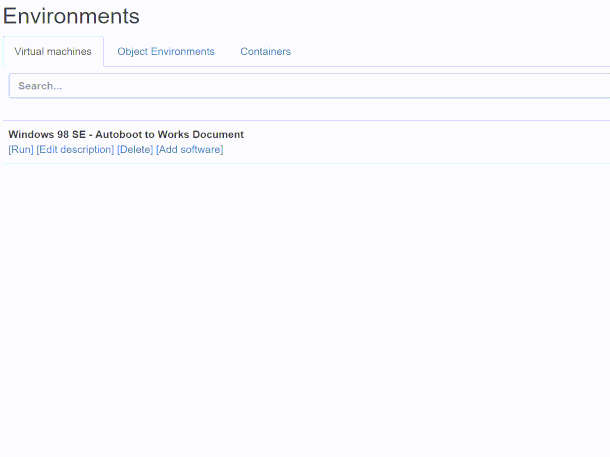
Audiovisual archives & digital preservation
Bertram Lyons is Senior Consultant for AVP
I want to tell a story to demonstrate the inherent relationship between audiovisual preservation and digital preservation.
1. What is it about audiovisual preservation today that requires us to engage in digital preservation?
My story begins with a collection of folk music analog audio recordings in the Alan Lomax Archive.
The year is 2002. The recordings -- I’ll focus on the 2,000 quarter-inch magnetic reel to reel audio tapes -- date from 1948 to 1997. They vary in composition from paper, to acetate, to polyester. They display a variety of states of physical condition, from excellent, to disheveled, to disintegrating, to sticky.
Perspectives on the Evolving Ecology of Digital Preservation
Oya Y. Rieger is Senior Advisor at Ithaka S+R, based in New York
As an organization that provides research and consultancy services to the global higher education community to support the creation, discovery, dissemination, and preservation of scholarship, Ithaka S+R is interested in exploring the current landscape of digital preservation programs and services in order to identify research questions that will contribute to the advancement of strategies in support of future scholarship. To this end, we recently published a brief, The State of Digital Preservation in 2018: A Snapshot of Challenges and Gaps, which is based on interviews with 21 experts and thought leaders to survey their perspectives on the state of digital preservation. The digital preservation community now represents deeper expertise involving a robust exchange of best practices, standards, preservation techniques, tools, and systems. Nevertheless, given the complexity of designing preservation strategies at scale, it is inevitable that there is lingering anxiety.
A Parliament of Owls: Leveraging internal wisdom to build support for digital records
Jeanne Kramer-Smyth is Archivist and April Miller is Program Lead for Archives at World Bank Group Archives

World Bank Group Archives Digital Vault logo.
We considered writing a blog post about the technical solutions selected for the World Bank Group (WBG) Archives’ “Digital Vault” digital preservation project. We spent months working through an RFI and RFP, selecting a vendor, and finalizing contract negotiations. This was followed by work on technical design and internal approvals.
This is not what this blog post is about. Instead, this post is about identifying and tackling the people and process investments required to evolve into an archives that handles both analog and born-digital records.
Typology of Digital Collection as a Framework for Digital Preservation
Helen Hockx-Yu is Program Manager for Digital Asset Strategy and Don Brower is the Digital Library Infrastructure Lead at the University of Notre Dame in the USA
Like many academic and research libraries, the University of Notre Dame's Hesburgh Library collection has evolved over the last twenty years or so from analogue to increasingly digital, and from a physically owned and locally stored collection to a broad range of both local and external resources, organised around users’ needs.
The complexity and varied nature of our collection means this is no one- size-fits-all digital preservation approach. Different strategy is required dependent of the significant properties of the collection items.
To gain a better understanding of the Library’s overall digital content, and to help plan for digital preservation, we recently co-led a project at Hesburgh Libraries, University of Notre Dame, where we developed a Typology of Digital Collection as a framework to guide digital preservation.
The Archivist’s Guide to KryoFlux
Dorothy Waugh is Digital Archivist at Emory University in the USA
On this World Digital Preservation Day, we’re here to remind you of the humble floppy disk, last century’s save icon. Though limited in terms of capacity, these inexpensive and lightweight disks were the dominant storage device for three decades, as is evidenced by the boxes of floppy disks now found among the stacks of most archives. Among the disks at Emory University are files created by novelist and Pulitzer Prize winner Alice Walker, poet and former US Poet Laureate Natasha Trethewey, poet and writer Lucille Clifton, and the Southern Christian Leadership Conference (an Atlanta-based organization founded in the wake of the 1957 Montgomery Bus Boycott under the leadership of Dr. Martin Luther King). Unfortunately, the deterioration of such magnetic media due to age and poor storage conditions has been difficult to avoid and, with even the youngest of these disks now approaching twenty years old, recovery of data frequently proves challenging.
On Robustness
Christopher (Cal) Lee works at the School of Information and Library Science at the University of North Carolina at Chapel Hill
Digital preservation is about conveying meaningful information between contexts over time [1]. A great deal of the complexity stems from digital information residing at multiple levels of representation [2] This process is never free. It requires resources (human, technical, financial). Ensuring a steady flow of resources over time is difficult.
At any given time, dedicated individuals and informal groups play a vital role in the provision of resources (collecting, organizing, storing and sharing information in which they have an interest). Commercial providers of information systems also play a major role, by providing the platforms upon which consumers create, manage and share information.
Contrastes en Preservación Digital: Lo que hemos aprendido de sistemas de Preservación Digital Distribuida y Metodologías Tradicionales / Contrasts in Digital Preservation: What we have learned from Distributed Digital Preservation Systems and Traditional
Pamela Vízner es Consultora de AVP / Pamela Vízner is a Consultant for AVP
Como comunidad enfrentada a la responsabilidad de preservar la memoria de nuestras respectivas organizaciones, nos ha tocado una tarea difícil. Casi la de adivinos. Cuando hablamos de la preservación y de proteger y poner a disposición “para siempre” nuestra historia - en el medio que sea se haya originado, papel, objetos, audiovisual, etc. - dichas palabras nos quedan grandes. Hay mucha incertidumbre en ese “para siempre”. Sin embargo, hemos sido capaces de encontrar juntos poco a poco la respuesta a nuestras necesidades, y seguimos construyendo en esa dirección. Las comunidades son de suma importancia en nuestro quehacer, y cómo hemos dado forma a nuestra disciplina a pesar de esa incertidumbre. ¿Será que un enfoque comunitario es la respuesta a nuestras necesidades en preservación digital?
Transforming Archives / Opening Up Scotland’s Archives: Winning in 2016
Victoria Brown is Programmes and Development Manager and Audrey Wilson is Skills for the Future Project Manager at the Scottish Council on Archives, and in 2016 they won a Digital Preservation Award for Teaching and Communications
When announcements of the nominations for the 2018 DPC digital preservation awards appeared, it was hard to believe two years had passed since (as hopeful nominees), we entered the grand marble foyer of the Wellcome Trust HQ. The list this year is truly impressive. The scale of the digital preservation challenge can obscure the fact that there are so many amazing projects and initiatives underway. Projects that are tackling sustainability, driving skills development and addressing the trickiest of quandaries through imaginative and applied research. It is both crucial and excellent that this work is being celebrated, recognised and shared.
New Humanist Archive — A Feat of Preservation
Tom Rodenby works for Exact Editions
Every issue of the New Humanist and its predecessors dating back to 1885 is now available through the state-of-the-art digital edition developed in partnership with Exact Editions. We like to think that those historical issues have now moved into the ‘safe pile’. In their digital format, they will stride forth into the future to be read by new generations of readers and thinkers.
Digitally Preserving the History of CILIPS
Sean McNamara is Acting Director of Chartered Institute of Library and Information Professionals (CILIP) in Scotland CILIP) in Scotland
Libraries and digital preservation go hand in hand in Scotland. All across the country there are exciting initiatives ongoing in organisations such as the National Library of Scotland as well as Scotland’s thriving network of public and university libraries: ground-breaking projects only made possible because of the skills of Scotland’s library and information workforce.
With all the work that is going on we at CILIPS became aware that our own organisation did not have a strong digital history. Despite being over 100 years old (previously the Scottish Library Association) all our history was held in archives on site or with the National Library. With that in mind we decided to look at creating a digital archive via a timeline and highlighting notable people.
Attention Please!
Sean Barker runs a Technical consultancy on Enterprise Integration and Information Sharing for Products
Some time back long term data sustainment lost the attention of my main funders, so last month - when I retired - I thought I'd have a chance to return my attention to it properly. Unsurprisingly, my immediate attention has been taken up with VAT returns, no longer putting off redoing the kitchen and the magnificent local buzzards circling low overhead.
Attending to the right thing is not straightforward. A colleague once said that a managing director should have nothing on their desk, otherwise that becomes locus of their attention rather than the future of the company. Look at any Computer Aided Design (CAD) demo and your attention will be drawn to a complex 3-D part rotating to show itself off. However, the future in CAD lies in the change from drawings to models, something only hinted at by the dull text boxes at the display's edge and which did not grab your attention. Although early CAD did replaced the drawing board, the modern CAD model replaces the model shop where skilled craftsmen would construct wooden mock-ups, For example, Airbus created a full scale mock-up of the A340 wing, said to cost a million pounds, but saving several times that through design improvements. Now model-based CAD saves the cost of building those physical mock-ups.
Libraries and the future of their USP
Pamela Tulloch is Chief Executive of the Scottish Library and Information Council
Everyone tells us we live in a digital world and to a certain extent this is true. As a librarian, I first started creating digital content in the 1990’s and looking back, what we were doing then, does look so last century now. These are the digital dark ages and yet the content which was created remains as relevant now as it was then. So much has changed in a few decades and how expect to access content has changed too.
Preserving Knowledge – Are we keeping the right things?
Neil Jefferies is Research and Development Project Manager for the University of Oxford's Bodleian Libraries Research & Learning Services
I feel that there is an increasing disconnect between the digital artifacts that we capture and the mechanisms used to create the knowledge that they embody. This contributes to some of the difficulties with preserving these born-digital materials in a way that effectively retains their meaning.
The seed for this train of thought has been my involvement in the Cultures of Knowledge project and the accompanying online resource Early Modern Letters Online (EMLO). The aim of the project is to use digital methods to reassemble and interpret the correspondence networks of the early modern period (roughly 1550-1750). This period is interesting in that it saw the emergence of a significant social network across Europe and the associated Empires, enabled by the development of postal services and increased population mobility. This resulted in an explosion of intellectual activity that laid the foundations for the Enlightenment and established patterns for scientific discourse that persist until the present day - for example, the foundation of The Royal Society and the publication of the first scientific journals.
If they can’t agree on the plug, how can they ever agree on the metadata?
Miguel Ferreira is Executive director at KEEP SOLUTIONS based in Braga in Portugal
“If they can’t agree on the plug, how can they ever agree on the metadata?”… This sentence has stuck with me for over 13 years now. It came about in the summer of 2005, when a DSpace user group meeting was about to take place in the beautiful city of Cambridge, in the UK. The meeting intended to give a voice to real-world users and to provide an opportunity for young developers such as myself to learn from the collective wisdom of all of those present.
Preserving the past: the challenge of digital archiving within a Scottish Local Authority
Lorraine Murray is Archivist at Inverclyde Council in Scotland
During my masters course where I studiedInformation Management, Digital Preservation and Archives at the Department of Information Studies (or as I knew it at the time; HATII!) at The University of Glasgow, I came to realise how useful it was to create and use digital content with the aim of making historical information and original source material more widely accessible. However, the successful curation, management and preservation of any digital object is an absolutely essential part of this process.
I’ve never met-a-data I didn’t like (or why metadata can help us learn about digital preservation)
Kristen Schuster is Lecturer in Digital Curation for the Department of Digital Humanities at King’s College London
I lecture in digital curation and exploring the relationship between curation and preservation is one of my favorite topics of discussion. I find these discussions so interesting because as a librarian I often find that, on the surface, I have a different understanding of preservation than my students. And, as a result, my examples based in museums and archives are initially at odds with their work experiences and career goals -- many of my students want to work in news broadcast agencies. The idea of long-term preservation making media accessible and usable for decades often alludes them… the news moves forward, not backwards after all! I was quite intrigued by the disconnect between my well-intentioned explanation that we create content – analog or digital – because we want to use and re-use it, and that use, and re-use help us establish narratives and understandings of events, people, places and objects. My efforts to explain file types, compression ratios and the joys of file structures fell flat and, looking back, this shouldn’t have surprised me. After all, connecting the importance of file compression to the activities (cough curation) preservation support is elusive when put in abstract terms. So now, instead of pursuing a degree in broadcast journalism to try and relate to my students’ interests, I discuss how preservation can save us the time, effort and the frustration of having to re-create valuable assets or regret the loss of content. Instead of directly discussing file types and file structures, I enthusiastically convince students that metadata and practical methods for organizing content makes it possible for everyone to participate in the curation and preservation activities.
Everyone’s a winner?!
Kasandra O’Connell is Head of the IFI Irish Film Archive
Last year I wrote a blog for World Digital Preservation Day contemplating the progress the Irish Film Institute (IFI) had made in the area of Digital Preservation; this year’s WDPD sees the IFI join the list of nominees for the DPC Digital Preservation awards in the Safeguarding the Digital Legacy category taking place in Amsterdam as part of the WDPD2018 celebrations.
The project we are nominated for, The Loopline Conservation Project, is one that we have been working on for nearly 2 years. It is our first end-to-end application of IFIscripts – our suite of open source digital preservation tools created to automate our own digital preservation activities but also adopted by a number of peer institutions internationally. Funded by the Broadcasting Authority of Ireland www.bai.ie. the project has focused on cataloguing and preserving the output of Loopline Films, one of Ireland’s most important independent production companies, run by filmmaker Se Merry Doyle. This collection provides an unparalleled record of key areas of Irish history and arts from the 1990s to the present day, documenting a transition in Irish society pre- Celtic tiger and post economic crash. In addition to material chronicling the rapid social and economic change in Ireland during the late 20th century it includes interviews with international cultural figures such as Margaret Atwood, Martin Scorsese & Maureen O’Hara. In 2017 Loopline closed its studios and transferred its holdings to the IFI Irish Film Archive.
Digital Preservation: More than the bits, it’s the organisation.
Kalpana Shankar is Head of the School of Information & Communication Studies at University College Dublin
How do you keep a data archive open and relevant for fifty years or more?
For the last four years, my colleague Professor Kristin Eschenfelder (School of Library and Information Science, University of Wisconsin-Madison, USA), and I have been asking (and trying to answer) that question, along with many other questions, as part of a research project on the sustainability of data archives. Thanks to the Digital Preservation Coalition for giving us the opportunity to talk about this project and why it matters on World Preservation Day.
Can Digital Preservation become business-as-usual?
Jonathan Tilbury is CTO and Founder of Preservica based in the UK
Digital Preservation has come a long way since the initial research activities resulted in cornerstone tools such as PRONOM, DROID, and JHOVE and the creation of the familiar OAIS reference model. The evolution of this change can be seen in the Digital Preservation Coalition itself, charting its creation, the growth in membership numbers, and the gradual move away from pure cultural heritage and academic organisations to the incorporation of different types of organisations. I’ve been there since these early days and am very excited about where the sector is headed.
Products have emerged to reflect this change. You can now choose between open source community tools and investment backed escrowed systems. These have a common core of functionality covering all the OAIS functions and growing sophistication to reflect their communities. They are supported by companies dotted around the world employing specialists in their sector. Choosing between these products depends on where your emphasis is, which functions you value most, the skill level of your team and a look at the total cost of ownership.
Consortium working - a collaborative approach to digital preservation
Sam Johnston is the County Archivist at Dorset History Centre
I think I'm stating what's known colloquially as the 'bleedin' obvious' when I say that digital preservation has presented a raft of challenges for small to medium sized archive services, most of which have undergone significant budget reductions in recent times. It's an area of work that is outside the skill-set and certainly the comfort zone of many, and in budgetary terms, it represents something that is likely to require additional funding, often very hard to secure. Therefore, a technical challenge combined with a relatively glum financial picture has meant that it has been difficult to understand how small services can begin to grapple with digital preservation. One thing I think we all acknowledge is the importance of digital preservation and that archivists should be the professionals to lead it as a clear continuation of our work with the physical records. The risk, as it appears to me at least, is that if we don't take the lead, then it will default to some other sector to pick this up and we risk becoming heritage 'time capsules' of hard copy records only.
Winning a Digital Preservation Award in 2016
James Mortlock is Digital Archives Manager at HSBC in London, UK
HSBC’s digital archive journey began back in 2011 when we first sat down to develop a set of requirements for a system that would manage and preserve our growing born digital and digitised collections. This process developed into an exciting digital preservation project that was supported by senior management. After many years of hard work and collaboration by the archives team, our internal IT colleagues and external vendors we were able to launch the HSBC Global Digital Archive system (GDA) in 2015, just in time to support HSBC’s 150th anniversary celebrations. The following year, in November 2016, the success of the project was recognised when it received the Digital Preservation Award for Most Outstanding Digital Preservation Initiative in Commerce, Industry and the Third sector.
Improving Digital Curation Teaching through International Collaboration: The Ibadan/Liverpool Curriculum Benchmarking Project
James Lowry is a lecturer in the Liverpool University Centre for Archive Studies
A three hour drive from Lagos is the expansive campus of the University of Ibadan, home to the oldest archival education programme in Nigeria. It was here in 2017 that the Ibadan/Liverpool Digital Curation Curriculum Review team finalised their benchmarking exercise, which had started earlier that year when Dr Abiola Abioye visited the Liverpool University Centre for Archive Studies (LUCAS). Funded by the International Council on Archives, this collaboration was the latest in a long history of collaboration between the archives programmes at Ibadan and Liverpool dating back to the work of Professor Gabriel Alegbeleye and Dr Michael Cook in the 1990s.
Developing a Digital Preservation Programme at the British Geological Survey
Jaana Pinnick is Research Data and Digital Preservation Manager for British Geological Survey
We started to develop digital preservation capabilities at BGS in 2016 by exploring the initial requirements and writing a preservation policy to guide the future work. This blog describes the progress we have made so far.
Background
BGS is an approved Place of Deposit under the Public Records Act and committed to looking after certain geoscience data in its care “in perpetuity”. Its National Geoscience Data Centre (NGDC) makes most of its data openly available under the Open Government Licence. BGS also has legal obligations to manage some types of data. The UKRI Data Policy requires data with acknowledged long-term value to be preserved and made available for future research; however, the NGDC considers the retention of most of its geoscience data to be longer than the ten years stipulated in the policy.
Spreading the Digital Preservation Word
Digital Preservation day offers our community a chance to shout from the rooftops that what we do is important for everyone. This day has given me recourse to consider my role in rooftop shouting and to reflect on how successful I have been in spreading the message about digital preservation.
My role at the University of Sussex is in both research data and digital preservation and I have a lot of opportunities to talk about digital preservation in both spheres. So I list here everything that I can remember over the past year where I've managed to talk about digital preservation with someone who hasn't been familiar with it before. What has been my reach this year? Here is my highly scientific presentation of my findings.
Normalising digital preservation
Elizabeth Oxborrow-Cowan is the Chair of the UNESCO Memory of the World Programme UK
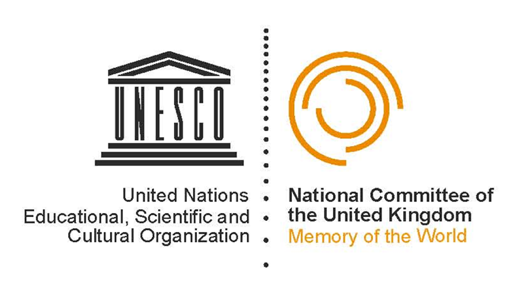 As any government minister will tell you from bitter experience, it is very hard to effect change and get things done. It requires a balance of different factors to come together to overcome obstacles, convince people of the need for change and encourage them to act to enable that change. Digital preservation is no different. As Kenney and McGovern neatly described in their ‘three-legged stool’ model, effective digital preservation requires three components – the provision of technology, resources and organisation. Organisation is important because it is about providing the managerial cultural and policy environment within which digital preservation is accepted as necessary and the working norm. UNESCO’s 2015 Recommendation on Documentary Heritage is one step in that process of normalisation.
As any government minister will tell you from bitter experience, it is very hard to effect change and get things done. It requires a balance of different factors to come together to overcome obstacles, convince people of the need for change and encourage them to act to enable that change. Digital preservation is no different. As Kenney and McGovern neatly described in their ‘three-legged stool’ model, effective digital preservation requires three components – the provision of technology, resources and organisation. Organisation is important because it is about providing the managerial cultural and policy environment within which digital preservation is accepted as necessary and the working norm. UNESCO’s 2015 Recommendation on Documentary Heritage is one step in that process of normalisation.
Preserving Poems. New challenges to archives and the digital creative process
Although the shift from paper to digital has been a major issue in the world of archives for several years, the delay in some disciplines between record creation and archive deposit has meant that, for many repositories, the challenge of processing born-digital archival material is a relatively new one. And although this development has prompted the creation of new practices, tools and methods of working, one constant has been the commitment that archives make to donors; to care for, preserve and where possible make available their valued content. Whether a filmmaker is handing over boxes full of 8mm film or hard drives worth of MP4 files an archivist must be able to confidently state that the material will be safe in their institution’s custody and that every effort will be made to afford access to researchers and the public as required. In the University Library the recent development of some of our research strengths within Special Collections has been prompted by the acquisition of collections which have enabled us to consider some of the unique questions surrounding digital archives, and to challenge ourselves to maintain these commitments as an archive.
Design, Deliver, Embed: Establishing Digital Transfer at the UK Parliamentary Archives
Chris Fryer is Senior Digital Archivist at the UK Parliamentary Archives
The Parliamentary Archives organises UK Parliament's memory. We are a shared service, providing an archives and records management service to the administrations of the House of Commons and House of Lords. We hold records of unique national importance, often defining watershed moments in the history of the United Kingdom (for example the UNESCO Memory of the World recognised Bill of Rights from 1689). Core procedural and administrative records safeguarded due to transfer of corporate digital records represent a continuation of this heritage.
The types of records produced internally are unique, providing valuable background and context for Parliament’s decisions and actions. With the end of the print-to-paper policy in Parliament in 2012 and the introduction of a corporate Electronic Document and Records Management System (EDRMS), the Parliamentary Archives has long recognised the need for a robust, end-to-end process for digital transfer directly from internal information systems.
Break up with legacy systems, there’s a new solution in town
Ben Saxton is Head of Sales at Formpipe Life Science
By 2020, 50% of all current applications in the data centre will be retired. In fact, between 2016 and 2020, IT organisations will decommission more than three times the number of applications they have previously since 2000. This has resulted in the need for organisations to retire existing applications and seek out a future-proof solution, and fast. What was once an afterthought, retaining business assets and developing a plan for maintaining future records, is now a business-critical task.
But, seeking out a reliable solution comes with its share of hurdles. As enterprises modernise their application portfolios, they face a growing challenge in finding cost-effective solutions to retire their current applications and retain access to historic data that has yet to be migrated to a replacement solution.
“Do You DP?”
Antonio G. Martinez is CEO & Founder of LIBNOVA and is based in Madrid, Spain
How many times have you heard this question? When it comes to Digital Preservation though, there’s no such thing as “to do or not to do”. Having worked with and advised all kinds of organisations, from the largest to the most compact, we’ve learnt that almost anything can be considered digital preservation. This means that “Do you DP?” is a hugely misleading question. A question that only allows for binary answers – a yes or a no, a 0 or a 1 – and makes the reply totally irrelevant to the truth. Understanding this key concept is essential for organisations to be able to move forward.
We have to take a step back and take in the full picture so we can then make others -colleagues and stakeholders- understand that there is so much depth to this relatively recent newcomer, digital, to the preservation world that it is not a simple yes or no, but a “What D.P. level shall we go?”. We have to share our vision and make them (colleagues and stakeholders) understand that we can digitally preserve things in so many different ways and on so many different levels that the simple question of “Do you D.P.?” renders the answer obsolete. You see, we all know that every little bit counts, and the more bits we actively layer our preservation cake with the more safely we preserve. But do our colleagues and stakeholders know this? We have to make the case that as we move up layers our digital assets are safer and safer. So the question should be, “Up to what level do we need to D.P.?”.
Archiving Crossrail
Alistair Goodall is Head of IT for Crossrail Ltd and Transport for London
Crossrail is an amazing project to be part of and, when the central section opens next year, visitors to London are going to see stunning new stations and travel on new 200 metre long trains capable of carrying up to 1,500 people.
My team in IT has been responsible for most of the enterprise wide applications which are needed on a mega-project. Some of these we have worked with the vendors over the last 10 years to develop and configure, others have been developed in house by our team to support specific business needs (such as vehicle movement planning and agreements). These applications now hold over 10 years of project data across all business areas including health and safety, commercial, delivery, programme controls and technical information.
PREMIS News & Highlights for 2018
Karin Bredenberg is Chair of the PREMIS Editorial Committee and she works for Riksarkivet/Swedish National Archives
It’s been a very productive year for the PREMIS Editorial Committee!
We’ve brought several projects to fruition and embarked on a number of new efforts since our last WDPD report on PREMIS and Linked Data. As you probably know, we released version 3.0 of the PREMIS Data Dictionary in 2015 and since then we’ve devoted a lot of our resources towards modelling and completing an OWL ontology, creating supporting documentation for the new ontology, and updating the related preservation vocabularies on LC’s Linked Data Service. We are proud to say these are all available now!
In Certification I believe or... Are we doing it YET AGAIN?
Yvonne Tunnat is Digital Preservation Project Manager at Leibniz Information Centre for Economics in Germany
“Are we doing it YET AGAIN?” is the question I would most certainly ask if I were not the one most likely to suggest that we go the next level of certification, or, interchangeably, for the more recent or updated version of a certain certification level.
We have gone through the Data Seal of Approval in 2015, have acquired the nestor Seal in 2017, and at the end of 2018 we will hand in our documentation for the Core Trust Seal. We would certainly have found found us another nice certification process in 2016, but as I was away for maternal leave for a great chunk of that year, we were too busy just archiving stuff.
So, why are we constantly heading for another certificate to prove how trustworthy our Digital Archive is?
Launch of the New Digital Archiving Platform at the National Archives of France: Act I!
Violette Lévy and Béatrice Hérold work at the National Archives of France in Paris
Confronted with the ever-growing surge of digital services used by government agencies, the aim of the ADAMANT Project (Administration of archives and their metadata at the National Archives over time) is to preserve the integrity of the resulting digital archives and to ensure they remain permanently reliable, intelligible and accessible, which is the basic mission of the National Archives.
 After two years of gestation, the new platform will launch on November 29, 2018. This first version will focus on the collection and management of digital archives. Versions 2 and 3, expected to be rolled out in 2019 and 2020 respectively, will focus on the consultation and reuse of these archives by the public, as well as long-term preservation.
After two years of gestation, the new platform will launch on November 29, 2018. This first version will focus on the collection and management of digital archives. Versions 2 and 3, expected to be rolled out in 2019 and 2020 respectively, will focus on the consultation and reuse of these archives by the public, as well as long-term preservation.
Project Preview: “Weaving Digital Stewardship into the Organizational Fabric”
This post was written by: Shira Peltzman, Digital Archivist for the University of California, Los Angeles (UCLA); Julia Kim, Digital Assets Specialist, Library of Congress; Peggy Griesinger, Metadata Librarian, George Mason University Libraries; Vicky Steeves; Librarian for Research Data Management and Reproducibility, New York University; and Karl-Rainer Blumenthal, Web Archivist, Internet Archive.
As digital preservation programs and stewardship initiatives mature, so may they become more dysfunctional.
One of the most important takeaways from the National Digital Stewardship Alliance (NDSA) staffing surveys conducted in 2012[1] and 2017[2]-- discussed here last World Digital Preservation Day -- is the increasing dissatisfaction among stewards with the way that digital preservation is organized at their respective institutions.
Perceptions that the digital preservation function at their organizations “works well” among respondents to the NDSA Staffing Surveys of 2012 and 2017.
Bit by bit, byte by byte: web archaeology going strong in the Netherlands!
Tjarda de Haan is Guest Curator for E-culture at Amsterdam Museum in the Netherlands
Since winning the Digital Preservation Award 2016 in the category The National Archives Award for Safeguarding the Digital Legacy in December 2016 our project accelerated! We have published the 'DIY Handbook for Web Archaeology' and the 'FREEZE! A manifesto for safeguarding and preserving born-digital heritage' and with this we have put web archaeology on the map in the Netherlands. Many initiatives took up the challenge. The KB National Library of the Netherlands has done some remarkable excavations, journals have published articles about web archaeology and the Journal for Media History will publish a special issue next year 'Media history for the future: Web Archaeology'.
Heritage preservation of contemporary dance and choreography
Suzan Tunca is a Dance Researcher for ICKamsterdam and this project was undertaken in collaboration with Motion Bank
Heritage preservation of contemporary dance and choreography through research and innovation in digital documentation and annotation of creative processes
ICKamsterdam and Motion Bank.
ICKamsterdam and Motion Bank join forces to optimize caring for the heritage of contemporary dance and choreography through the invention of new forms of digital documentation, notation and transmission of embodied knowledge. This unique collaboration integrates the verbal movement language research of Emio Greco I PC and ICKamsterdam with the annotation systems and goals of Motion Bank software development. In this way digital preservation media development is linked directly to the potential of establishing working vocabularies specific to various choreographers and performing artists. Documenting and annotating processes in performance creation enables the safeguarding of ephemeral and ineffable artistic contents in dance through time.
What, who, where, how? Persistent Identifiers at the National Library of Luxembourg
Roxana Popistasu is Digital Preservation Coordinator at Bibliothèque nationale de Luxembourg
“In digital preservation, identification of digital content is essential”, say A. Dappert and A. Farquhar in their iPRES 2017 article Permanence of the Scholarly Record: Persistent Identification and Digital Preservation – A Roadmap. The same idea appeared in the introduction of Robert E. Kahn’s keynote at iPRES 2016:
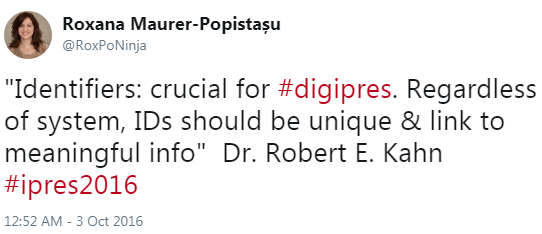
https://twitter.com/RoxPoNinja/status/782850754059132929
At the National Library of Luxembourg (BnL), we agree unequivocally: we cannot preserve and provide access to our national heritage without taking into account the reliable and sustainable identification of our digital resources. But how do we do that? What is the “best” persistent identifier (PID) system? Are there best practices when it comes to persistent identification? These are some of the questions we set out to answer at the start of our journey into finding the right PID system.
The question of what can we do in this political climate… has, again, a relatively modest answer: small interventions with grand intention
Patricia Sleeman is Archivist (Electronic) at UNHCR in Geneva, Switzerland
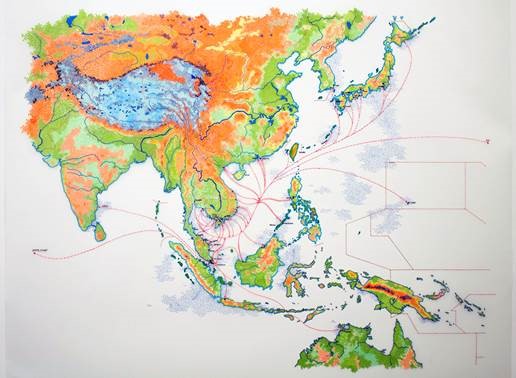 Tiffany Chung’s reconstructing an exodus history: boat trajectories in Asia, 2017
Tiffany Chung’s reconstructing an exodus history: boat trajectories in Asia, 2017
To be a digital archivist in UNHCR is interesting, challenging and inspiring all at once. To be part of an organization whose staff are often at the coalface of conflicts and operations which are concurrently taking place all over our world, witnessing the misery of displaced people is a unique experience. A privileged one.
Let’s be honest … a “honey we need to talk” with digital preservation
Michelle Lindlar is Digital Preservation Team Leader at Technische Informationsbibliothek (TIB) in Germany
It seems that most of us are well into the commitment stage of our relationship with digital preservation – it’s no longer a task tucked away in exclusive projects which only few institutions can participate in, but has growing acceptance as an institution’s core function. Or, to put it in the words of William Kilbride himself in reflecting on last year’s WDPD: “we have learned that it’s not about delaying the digital dark age: it’s about coming good on the digital promise”.
Music Treasures
Background
Within the Netherlands there are several archives with sheetmusic. There is not a national organization which covers those archives. Due to financial problems in 2013, all these archives were closed for public and their collections were no longer available. The largest collection is at the Stichting Omroep Muziek ((SOM) Dutch Broadcast Music), which has about 650,000 titles, classical music as well as popular music, salon music and, the unique part, the music which was specifically composed or arranged for the national radio and television broadcasts from 1920 until 1980 (180,000 titles).
Scotland, a leading Nation in Digital Preservation.
Fiona Hyslop is Cabinet Secretary for Culture, Tourism and External Affairs within the Scottish Government
On World Digital Preservation Day, I’d like to reflect on Scotland’s long tradition of preserving its documentary heritage and showcase how Scotland is helping to lead in the global challenge digital preservation.
This tradition dates back to 1286 to the first reference of a Scottish Government official William of Dumfries who had the responsibility of looking after records. This responsibility eventually evolved into the current role of Keeper of the Records of Scotland that we have today. To store our national archives General Register House was built in the 18th century, it is one of the oldest custom built archive buildings in the world still in use for its original purpose, and is home to National Records of Scotland which is responsible for Scotland’s national archive, as well as the registration of vital events and the taking of the 10 yearly national census.
Good Morning World Digital Preservationists!
A new day is dawning on this part of planet earth… but this day is like no other, this day is special, this day is all about digital preservation and this day is ours!
Ok, that sounded a bit full on and slightly arch-baddy, but it’s actually ALL good. All of it!
Supporting Digital Preservation Infrastructures
Mariella Guercio is President of ANAI (Italian National Association of Archivists)
In the past few years, many initiatives have been developed to support or promote digital preservation infrastructures, specifically with reference to the quality of the repositories and to the definition of standards for interoperability. This might seem a promising opportunity for making concrete experiences and implementing technical solutions, but I think that the professionals in the preservation sector (mainly archivists and digital curators) should monitor very carefully these initiatives on digital preservation (for example, the ETSI draft for defining policy and security requirements for trust service providers offering long-term preservation of digital signatures; and – even more - the standard ISO 17068 “Information and documentation — Trusted third party repository for digital records,” with its narrow and limited definition of authenticity), for many reasons.
It was 20 years ago today...
Marcel Ras is Digital Preservation Manager for the Dutch Digital Heritage Network
It is almost 20 years ago that the pioneering publications on Digital Preservation were issued by initiative of the KB, the Dutch National Library. The NEDLIB papers described technical challenges and solutions for digital preservation. Preserving digital information was a very different job at the turn of the Century. The challenges with digital preservation were mainly framed in technical terms, as the NEDLIB papers showed us. With the turn of the century also came the millennium bug and the dooms of the “digital dark age”. Gloomy predictions adding some state of urgency and awareness to our work and the profession of digital preservation.
Thoughts on obsolescence
Lourdes Fuentes-Hashimoto is Archivist for Total in Paris, France
When you hear the word “obsolescence” what do you spontaneously think about? I asked the question to a dozen random coworkers, who are neither archivists nor digital preservation specialists. The majority immediately think of planned or built-in obsolescence, that is to say the fact of designing something with an artificially limited useful life so it become quickly unfunctional or unusable. They mentioned “my washing machine” or “my smartphone” as examples. Other colleagues’ quick-fire answer was “something being out of date” or “outmoded” and consequently useless.
Keeping Blogs Alive
Kelly Merks works at the Expatriate Archive Centre in the Hague, Netherlands
The Expatriate Archive Centre (EAC) is an independent non-profit foundation. We aim to collect and preserve expatriate life stories, regardless of a person’s country of origin or where they moved to. Our focus is primarily on unique personal writings. Though much of our collection is tangible — including photographs, letters, diaries and other documents — in recent years we have begun to collect born-digital material.
Des cerises sur le gateau de la préservation digitale / Cherries on the cake of digital preservation
Jen-Yves Le Meur is Digital Memory Project Leader at CERN in Geneva, Switzerland
Le projet de la Mémoire Numérique du CERN, commencé en 2016, se devait de s’attaquer en priorité à la sauvegarde des collections sonores, photographiques et audiovisuelles nées avec l’institut en 1954, et déjà menacées par l’obsolescence de ses supports. En charge de ce projet, je me suis lancé tête baissé dans les inventaires, classifications, regroupements, analyses des pratiques, spécifications, appels d’offre et recherches de fond sans me douter un instant des magnifiques surprises qui orneraient ce chemin.
Ce sont ces surprises que je veux partager ici, à l’occasion de cette journée mondiale de la préservation. Elles sont quelques cerises sur la gateau de notre héritage. Cerises qui donneront peut-être une motivation supplémentatire à tous les acteurs engagés dans des projets de ce type.
Digital preservation at home……. and beyond
Joost van der Nat is a researcher for the Dutch Digital Heritage Network. In 2016 he and his team won the DPC Digital Preservation Award for Research and Innovation.
A short, personal story of how Digital Preservation came into my life, and the way our household deals with it now. Some astounding figures on how the world is expanding its digital universe lead to a burning question…
n=1, or how digital non-preservation showed its ugly face to me
When I try to explain to Muggles (the major part of the population that is ignorant of the blessings of, and the need for Digital Preservation) what Digital Preservation is all about, I often give the example of the scenario that took place in 2004. A trip to New York with our then 11 year old son. I made a lot of video recordings, and spent 60+ hours in producing a home video of 30 minutes on a DVD. Menus and Gershwin’s music topped it off, a great success with family and friends. Then 3 years later the DVD wouldn’t play. Bit rot or low quality DVD? But no problem, of course I had a backup on a separate hard disk. And as you may guess, the hard disk didn’t function… A company called The Disk Doctor saved me, for the round sum of € 750. Lesson learned: store your stuff in the cloud (too).
n=2, or how our household deals with its (digital) objects
Over the years E (my better half) and I have collected significant amounts of recorded music. Vinyl to start with, and countless CDs as of the 1990-ies. Digitising LPs is fun, but time consuming. Fortunately the vinyl collection was not too big. Ripping 600+ CDs and finding and applying cover photos in the course of 15 years is achievable. The music, along with other stuff, is stored on a Synology NAS that is backed up to Amazon Glacier in Ireland for $ 2.34 per month (600 Gb). The point is however that nowadays Spotify has (almost) all of our music at a fingertip.
The same goes for DVDs. In the course of many years the collection of movies grew up to 150+ (modest, compared to some friends). At present Netflix is streaming a lot of this content straight into our home.
Old family photo albums are great. Altogether we have some 15, containing priceless pictures dating back to the early 1900’s. On the pictures one can look back in time, seeing familiar faces in their young versions, and historic views of modernized places. Digitising these albums is fun, Photoshop slowly reveals its secrets and the result is spectacular. The extended families love it. Minor details is the meta data. The date a picture was taken is often not available, and some of these faces must be family, but who is it again ? Too late to ask…
And then, as of the early 2000’s, the digital camera came into our lives. The number of pictures was not longer limited to the 24 or 36 one would have on an analogue camera. An influx of 100’s of pictures per year in the household was manageable. However, soon the camera became part of the smartphone (or is it the other way round ?), and things got worse. E. travels a lot, and loves to share places, moments, people, diners, outings, seminars, nature, odd pictures, and what not. The potential ingest of pictures of her phone is now well over 2.000 per year. As many of these pictures are instantaneously shared with WhatsApp (in various groups) the number of files is likely to be around 4.000. duplicates included. The family curator is in trouble…
Recently I heard of Gudak. This is an app for the smartphone that will let you make 24 pictures, no reviewing. You then wait 3 days before you can check the results. I am going to try to replace the camera function of E’s phone with this app.
All in all our household seems to have reached the maturity level of “backed up bit preservation”. Which is something…
n = zetta, or how the world develops its digital universe
Now only imagine what the above n=2 story turns into when you realise that the number of active mobile social users in the world in 2017 has come to well over 2.5 billion (a third of the world population, see We are Social and Hootsuite). In 2015 Bernard Marr gave some staggering figures in Forbes:
- Facebook users send on average 31.25 million messages and view 2.77 million videos every minute.
- We are seeing a massive growth in video and photo data, where every minute up to 300 hours of video are uploaded to YouTube alone.
- In 2015, a staggering 1 trillion photos will be taken and billions of them will be shared online. By 2017, nearly 80% of photos will be taken on smart phones.
- The data volumes are exploding, more data has been created in 2013 -2014 than in the entire previous history of the human race.
- Data is growing faster than ever before and by the year 2020, about 1.7 megabytes of new information will be created every second for every human being on the planet.
IDC forecasted in 2017 that by 2025 the global data sphere will grow to 163 zettabytes (a zettabyte is a trillion gigabytes [JvdN: A trillion seconds is 31,710 years, to give you an idea.]). That’s ten times the 16.1 Zb of data generated in 2016.
Now my conclusive question is: either the Digital Preservation Community comes up with some ideas on how to tackle this, or should we say “Digital Preservation, don’t try this at home !”?
I do not have the answer (yet ;-). Maybe the industry has, in the longer run?
(Already) 10 years of LHC Data Preservation
Jamie Shiers is Data Preservation in High Energy Physics Project Leader at CERN
From the early days of planning for the Large Hadron Collider (LHC) it was known that it would generate an unprecedented amount of data. As we come to the end of the 2nd multi-year run (Run2) of the LHC, the CERN data archive has broken through the 300PB barrier. The LHC, including its planned upgrades, such as the High Luminosity LHC, will continue to take data for between one and two more decades when it restarts for Run3 in 2021 (so around 3 decades from start to finish).
All of this data – past, present and future – will need to be preserved for at least the data-taking period of the LHC, if not for an extended period thereafter.
NULLA DIES SINE LINEA …DIGITAL: What is and what is not digital preservation? Or the need for a few mantras
Isabel Bordes Cabrera es Jefe de Área de Biblioteca Digital, Biblioteca Digital Hispánica a la Biblioteca Nacional de Españaña / Isabel Bordes Cabrera is Head of Area at the Hispanic Digital Library at the National Library of Spain
Because of the world digital preservation day (#WDPD2018) we’ve wanted to take a break so to think and explain what is digital preservation, what is not and why this need arrived to memory institutions.
In our personal lives we've all experienced ourselves losses of digital data: that CD or USB with pictures of our last summer that won’t ever open again, that computer that can’t read DVDs; that wordperfect file which we cannot longer open nor edit, that corrupted file that cannot be recovered, that videogame we can no longer enjoy because we no longer have that commodore 64 which delighted us on those rainy evenings…The challenges of digital preservation have knocked everyone’s door, and not even NASA is an exception. Furthermore, NASA was one of the first institutions to react when they realized that almost all data from Viking probes were lost. And this was true even when they thought they had solved the problem back in the 90’s when they transferred data from the original magnetic tapes to CDs. And why was that? Because formats were not readable and the original programmers were either dead or had already left NASA. These facts put the machine to move and digital preservation turned into an undeniable challenge to all of us.
Preserving and providing access to digitally-born documentation
Frédéric Blin is Director for Heritage Collections, Preservation and Digitisation at the National University Library in Strasbourg, France
If all libraries are faced with providing access to digitally-born documentation, not all of them have the responsibility to preserve this documentation for the longer term. This is mainly the task of national libraries, or libraries bearing legal deposit responsibilities. International programmes and consortia have been created between libraries and publishers to keep academic resources secure, or between national libraries for the preservation of Internet. Academic libraries have been active in the field of research data preservation, in collaboration with institutional or shared data storage services.
For an autonomous medium-sized library, having the responsibility to preserve the regional heritage including the one coming through legal deposit, while at the same time trying to serve research needs based more and more on access to and use of digitised material, digital preservation is a question that tends to be at the back of the professional’s minds, leading however to no clear solution.
What we learned from Leren Preserveren
Frans Neggers is Digital Archivist at Het Nieuwe Instituut, and Project Manager and Trainer for Leren Preserveren
What should teaching heritage professionals about digital preservation be about? Autumn 2016 we - the Dutch Digital Heritage Network (DDHN) and Het Nieuwe Instituut (Rotterdam) - started developing Leren Preserveren (Learning Digital Preservation). We commissioned a professional to make a educational design. Decided was that it should become a blended learning environment for online students and with a group training. The target group was defined as practitioners that maybe don’t know too much yet about digital preservation or don’t know how to apply their knowledge. So it does not serve the more experienced practitioners who already know ‘how to’, nor the ones who are looking for answers to specific problems. Then all things to be learned had to be brought within a logical learning process. This resulted in a three module setup (learning to speak the language of digital preservation, becoming able to consider digital preservation in your own situation and learning to take the first steps). Important part of the group training were the module assignments as well as the expert sessions and exercises.
Digital Preservation and the Grand Gallery of IT Evolution
Eng Sengsavang is Reference Archivist for United Nations Educational, Scientific and Cultural Organization (UNESCO) in Paris, France
Last autumn, I moved to Paris to take on the role of Reference Archivist at the United Nations Educational, Scientific and Cultural Organization (UNESCO). My morning commute begins on a network of streets named after some of France and Europe’s prominent 18th-century naturalists. Rue Geoffroy Saint-Hilaire takes me past the Jardin des Plantes, site of the National Museum of Natural History (MNHN). The MNHN houses, among other displays, the Gallery of Evolution, an immense space exhibiting varieties of taxidermied animals. On the ground floor, an African elephant heads a procession forming the centerpiece of the ‘grand gallery,’ so-designated in French.
What if … your smartphone movies were suddenly all erased?
Brecht Declercq is Manager of Digitisation and Acquisition at VIAA, the Flemish Institute for Archiving in Belgium
There it is, lying next to you. Or maybe it is in your handbag or pocket. It may still be on your bedside table. Or your children are messing with it. Yesterday you used it to make some video clips. From your partner, your parents, your children, your BFF or just from the car before you. You probably didn’t think about it, but you documented your life in images and sounds. Some clips you erased quickly ... they better be not saved! Others are very valuable to you. Your 3-year-old granddaughter pressing a wet kiss on your camera lens. The champions celebration of the hockey team of a dear friend. Grandpa's voice at the birthday party ... three weeks before he died unexpectedly.
BitList 2018: The Global List of Digitally Endangered Species
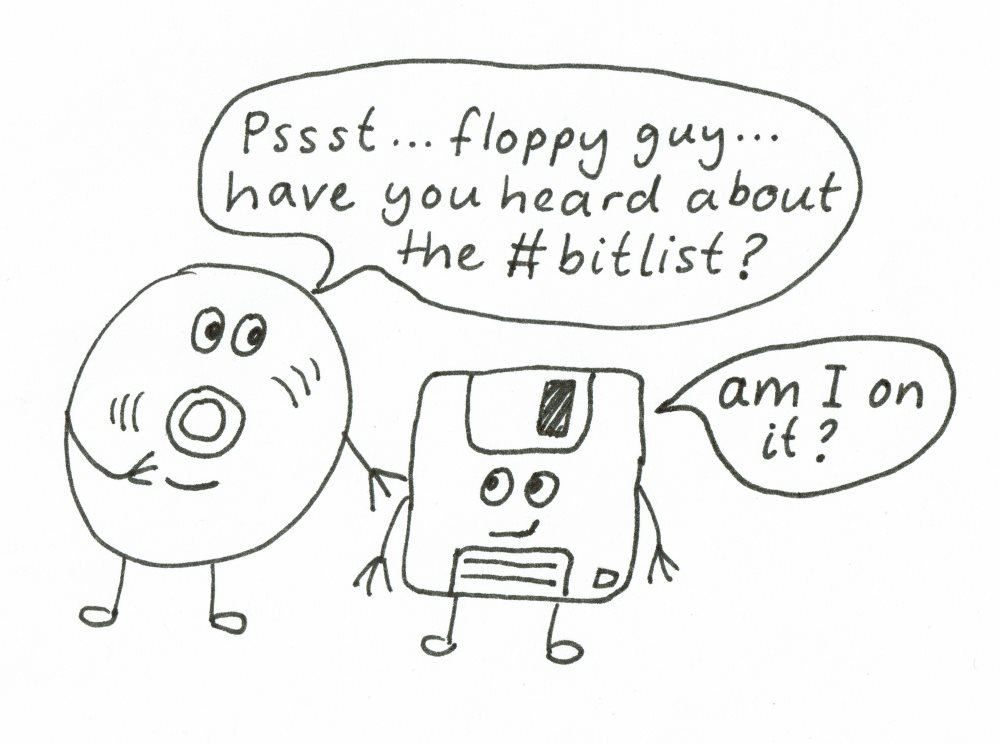 The 2018 Revision of The BitList offers a chance to update and review progress since initial publication in 2017. It was always intended as an interim statement that identified major changes or trends but offering commentary rather than a comprehensive review. It designed around the commitment that the DPC makes to the Digital Preservation Awards in alternate years, recognizing that the capacity for a full review would be limited in Autumn 2018. However, the pace of change is also relatively slow so the appetite and impact of an annual revision would be limited.
The 2018 Revision of The BitList offers a chance to update and review progress since initial publication in 2017. It was always intended as an interim statement that identified major changes or trends but offering commentary rather than a comprehensive review. It designed around the commitment that the DPC makes to the Digital Preservation Awards in alternate years, recognizing that the capacity for a full review would be limited in Autumn 2018. However, the pace of change is also relatively slow so the appetite and impact of an annual revision would be limited.
Authenticity of The Electronic Records: Presenting The Context
Özhan Sağlık is Lecturer at Bursa Uludag University in Turkey
This is my hard drive, and it only makes sense to put things in there that are useful. Really useful. Ordinary people fill their heads with all kinds of rubbish. That makes it hard to get at the stuff that matters. Do you see?" Sherlock Holmes, Season 1, Episode 3.
Archives are the banks of semantic capital (Floridi, 2018; Gollins, 2018) and we can ensure the intellectual control over this capital by context which is everything in digital archiving (Sheridan, 2018).
On the National Archives building of the United States it is written that “This building holds in trust the records of our national life and symbolizes our faith in the permanency of our national institutions” (National Archives and Records Administration, 2018). This sentence is valid for every country. Archives hold the trust for records whether they are physical or electronic.
Staying on Target: Reflections of a Digital Preservation Business Analyst
As Rosetta’s business analyst, I’ve always positioned myself on the receiving end of this blog. The ever-growing experience and different perspectives of digital preservation expressed in the stories shared here - and elsewhere - has significantly contributed to my ability to provide informed recommendations and decisions concerning the product’s roadmap and feature set. Therefore, when approached to contribute a post for this World Digital Preservation Day, I was ambivalent: My eagerness to contribute to this conversation seemed at odds with the product-oriented type of knowledge I can offer, which many would find uninteresting, if not inappropriate. After mulling over this for a while, I decided to share a recent dilemma I’ve been facing, with the hope that it will resonate well with the, er, designated community.
10 Years of Digital Preservation Collaboration in Finland
Heikki Helin is Senior Technology Coordinator for Digital Preservation Services at CSC - IT Center for Science Ltd in Espoo, Finland
Back in 2008, the National Digital Library of Finland (NDL) initiative was formed within the remit of the Ministry of Education and Culture of Finland. The initiative aimed at creating a nationally unified structure for contents and services ensuring the effective and high-quality management, dissemination, and especially digital preservation of cultural digital information resources. The basis for the NDL was formed by libraries, archives and museums (partner organisations).
In the early days of the NDL, it was decided that a centralized and shared digital preservation service should be created. It was estimated that common infrastructure and services reduces costs, increases system integration, strengthens cooperation, and brings the practices of partner organisations closer together. Besides technical solutions, the collaboration between partner organisations was an essential goal of the NDL.
Preserving digital anthropology resources at the Princess Maha Chakri Sirindhorn Anthropology Centre
Wachiraporn Klungthanaboon is Lecturer at Department of Library Science, Faculty of Arts, Chulalongkorn University and Sittisak Rungcharoensuksri is Researcher at the Princess Maha Chakri Sirindhorn Anthropology Centre
Learning the human behaviours and cultures in a particular community and time may not easily be done through the only lens of printed resources. The Princess Maha Chakri Sirindhorn Anthropology Centre (SAC), founded in 1991, is one of the most leading research centres in Thailand in the accountability of gathering and providing anthropological data to foster education and research in anthropology and archaeology in Thailand.
The SAC collaborates with local museums and communities across the country. The SAC has developed a digital platform for collecting, organizing, and disseminating gathered data and research output to the public with the aims of educating and preserving ritual practices, festivals, and other cultural expressions.
CIE TC8-15: Colour Imaging for Digital Preservation
Robert Buckley and Melitte Buchman are members of CIE TC8-15 – Archival Colour Imaging Technical Committee where Melitte is the Chair.
CIE TC8-15 is the CIE Technical Committee on Archival Colour Imaging. Overall the CIE is a technical, scientific and cultural non-profit organization in the field of light and lighting, encompassing fundamental subjects as vision, photometry and colorimetry. What does this have to do with the DPC and digital preservation? To the DPC, digital preservation refers to the series of managed activities necessary to ensure continued access to digital materials for as long as necessary. Basic activities are the good capture of physical originals and keeping the digital data safe and secure. CIE TC8-15 exists in the zone where the two organizations overlap for the accurate capture (or digitisation) of colour originals.
The TC’s Terms of Reference are “to recommend a set of techniques for the accurate capture, encoding and long-term preservation of colour descriptions of digital images that are either born digital or the result of digitising 2D static physical objects including documents, maps, photographic materials and paintings.”
A Case Study – WhatsApp Records Capture
Jingwen Yang is Records Management Officer for the United Nations Framework Convention on Climate Change (UNFCCC) in Bonn, Germany
Digital technologies are radically transforming business practices in the workplace as organizations become more mobile and virtual. Led by the increased prevalence of smartphones and BYOD (Bring Your Own Device) in organizations, more and more employees are turning to consumer messaging apps to collaborate with their colleagues and customers. Although an organization can benefit from this adoption, this also generates a huge amount of unstructured data outside of the technical platform managed by the organization, creating new challenges in digital records management, information security and information privacy protection.
Among a diverse landscape of messaging apps, WhatsApp stands out as one of the most popular: in 2018, WhatsApp reported more than 450 million daily active users, and it has been downloaded and installed by over 1.2 billion people worldwide. WhatsApp provides fast, simple, and secure services at no cost, allowing users to send text messages, voice messages, pictures, documents and other files as well as place voice calls and video calls to other WhatsApp users, all for free. It is expected that the unstructured data generated by WhatsApp alone will double in volume within the next 4 years.
Digital is an Illusion, but Film is a Reality?
Sanchai Chotirosseranee is Deputy Director of the Film Archive (Public Organization) in Thailand
When it comes to the digital age, most people believed that there is no need to preserve original materials, once they are digitized. When we had a funding campaign for a film storage a decade ago, Dome Sukvong, the founder of the Thai Film Archive, used the motto inspired by a famous Thai saying that the “Digital is an Illusion, but Film is a Reality” to champion an awareness about the importance of preserving analogue prints in the digital world.
A review of the Chinese Conference on Digital Preservation (CCDP) 2018
Zhenxin Wu is Professor of the Information System Department and Deputy Director of the Digital Preservation Center of Chinese Academy of Sciences at the National Science Library in Beijing, China
回顾CCDP2018:汇聚多方力量,应对新型数字内容资源长期保存挑战
十月底在北京举办的2018年数字资源长期保存全国学术研讨会非常成功,获得了很好的反响。作为会议的组织者,很高兴看到数字资源长期保存在中国国内得到越来越多的关注,越来越多的人和机构开始从事研究与实践。我也希望通过世界数字保存日(World Digital Preservation Day),让更多人了解中国保存者所作的努力。
数字内容资源已成为科技、教育和文化传承的主流资源,它们的长期保存已经成为各国信息基础设施战略的重要部分。科技部已经启动国家数字科技文献资源长期保存系统建设,在中国本土自主长期保存重要的国内外科技期刊、会议、学位论文等文献数据库。与此同时,数字内容的形态和应用正在迅速变化,数字音视频、数字图像、科学数据、社交媒体、计算机辅助设计、数字艺术、数字人文资料、开放教育资源等迅速成为知识创作、传播和利用的常规形态,成为人类知识和文化的自然和重要的组成部分。
Digital Preservation Song Challenge
Serena Coates is Coordinator of Digital Preservation (Preservation Services) and Rachel Merrick is Metadata Specialist at State Library of Queensland
With more conferences being held south of the equator (iPres in 2014, IDCC in 2019) for the first time, and local communities of practice growing in numbers (Australasia Preserves, and the National and State Libraries of Australia DP CoP), the digital preservation community is Australasia is growing stronger by the minute. So why not put this growing enthusiasm to music?
A recent thread on the Australasia Preserves web forum posed the question – “Does AusPreserves need a theme song?”. A couple of DP themed songs already exist, but the creative juices got flowing, and ideas were thrown in to the mix – “If I Could Turn Back Time” (Cher), and “Born this Way” (Lady Gaga) were put up as two possible candidates.
On behalf of the NSLA community of practice, we took it one step further, and issued a song challenge – to create a parody of an existing song, or write an original song with the theme of digital preservation. More ideas flowed - “Baby One More Time” (Britney Spears), and “[Files] Will Survive” (Gloria Gaynor).
A Greener Film Archive
Janice Chen is Archive Officer at the Asian Film Archive in Singapore
Much has been written about the escalating carbon footprint arising from digital consumption and its resulting environmental impact. The U.N. Intergovernmental Panel on Climate Change (IPCC) reported that the world needs sweeping changes to energy, transportation and other systems to hold global warming to 1.5 degrees Celsius.[i] The bleak future facing our world and the devastating natural disasters in 2018 that have hit Indonesia, the Philippines, Japan, Taiwan, and other parts of the world, inspired the thoughts of this piece.
The Maturing of Digital Preservation
Ross Harvey is Professor at Monash University in Melbourne, Australia
I’ve been thinking lately about the maturing of digital preservation. Exactly when it was born is difficult to determine. Wikipedia’s ‘Timeline of Digital Preservation’[1] starts in 1972, and Peter Hirtle suggests ‘at least the 1960s’.[2] Other contenders include the establishment of data archives in the 1960s. But although its precise age is debatable, we can agree that digital preservation has been around long enough to have developed processes, standards, theories, and ways of thinking that the digital preservation community generally accepts. For example, that the OAIS Reference Model is the basis for digital preservation systems, or that we need geographically-distributed copies – although there is no consensus about how many.
The importance of digital preservation
Richard Ovenden is President of the Digital Preservation Coalition, and Bodley's Librarian at The Bodleian Libraries, University of Oxford
I am really pleased to be celebrating World Digital Preservation Day (#WDPD2018) in Amsterdam, with the Netwerk Digital Erfgoed at the Annual Digital Preservation Awards event at the Amsterdam Museum. #WDPD2018 succeeds International Digital Preservation Day and aims to celebrate the work that is done across the globe to protect information created in digital form, and to mark the efforts made by the communities of practice that work in this vitally important area.
Automation in digital preservation
Richard Lehane is an archives and recordkeeping consultant with Recordkeeping Innovation, Sydney, Australia. Next year he'll be joining the IAEA's Archives team in Vienna, Austria
When I find spare moments, I work on siegfried, a file format identification tool like DROID and fido. I've been tinkering on it now for over five years. Automation has been critical for me to sustain the project; otherwise I just wouldn’t be able to attend to all the things that need doing, besides improving the tool itself. So far I’ve automated:
- testing,
- building and publishing releases,
- updating signatures,
- profiling the codebase,
- and benchmarking.
Automating these processes isn’t just about relieving me of manual work and freeing up time, it is also about putting in safety nets so that I can dive in and make changes knowing that any serious errors or regressions will surface in the tests and benchmarks.
TownsWeb Archiving celebrates World Digital Preservation Day with a WEEK of announcing digital access
Marshall Parr works for TownsWeb Archiving
We have decided to celebrate World Digital Preservation Day with an entire week of announcing organisations who have made the leap to digitising their collections and providing access online. We have helped each of these organisations using our PastView System to manage and publish their collections online. Keep an eye on our Twitter page, as we celebrate new websites every day this week.
Making Australia’s biodiversity literature openly accessible and discoverable online
Nicole Kearney is Manager of Biodiversity Heritage Library Australia at Museums Victoria
The Biodiversity Heritage Library (BHL) is the world’s largest online repository of biodiversity literature and archival materials. I manage the Australian component of this global project and, to celebrate world digital preservation day, I’ve been asked to share what we do to make Australia’s biodiversity literature openly accessible and discoverable online.
Digitising David
Michaela Hart is Senior Archivist for the Department of Health and Human Services Victoria, Australia
What better way to celebrate World Digital Preservation Day than tell a story about global superstar David Attenborough? I hope folks will let me know if I’ve drawn the bow too long.
This case study demonstrates some of the complexity of working with audio-visual material, and how this archivist was able to justify watching a 40-year-old documentary on a Friday afternoon. I am working on a project to digitise magnetic tapes that were acquired by our archives during the 1990s when most of the psychiatric intuitions were closing. Some of the tapes contain recordings with clients on them, but this particular accession contains educational material, recorded seminars, and talks.
Digitising the Dorothy Hill collection at the University of Queensland Library
Mandy Swingle and Kellie Ashley are Curators at the University of Queensland
In 2017, The University of Queensland Library unveiled an online exhibition about Professor Dorothy Hill (1907-1997), Australia’s first female professor. This exhibition is the result of an 18 month project that showcases the extensive collection of papers she donated to the Library and celebrates the scientific contribution of one of Australia’s leading academics. The exhibition features digitised content curated from the ninety boxes of her collection. Today, on World Digital Preservation Day, we are excited to share our story of how we aim to digitally preserve this wonderful collection.
(What A) Wonderful World
Back in February of this year I wrote a post for this blog describing work the DPC was embarking on to formalise our commitment to supporting inclusion and diversity in the digital preservation community. Then followed a lot of reading and research, discussions with people across the community, and numerous drafts and reviews of the document.
But, I am happy to report our Inclusion and Diversity Policy was published in June and launched at our yearly member’s unconference ‘Connecting the Bits’. There are a number of reasons why this is a topic that is important to me and I was honoured to have a chance to work on the policy. I must admit that it is perhaps the piece of work I am most proud of in my career to date.
It’s not all technical, digital preservation at State Library NSW
Joanna Fleming is Digital Curation Specialist for State Library of New South Wales
The State Library of New South Wales (the Library) is the oldest library in Australia, with a history dating back to 1826 and a collection of historical, cultural and informational significance documenting the heritage of Australia, New South Wales and Oceania.
The Library has a long history of collecting born-digital material and collection digitisation. However, systems, delivery, infrastructure, policy and practise required improvement to keep up with the demands of digital collecting and the expectations of readers. The Library also needed to be able to ensure the ongoing sustainability of digital collections.
Digital preservation as “communication with the future”? How really to do that?
José Borbinha is Professor of Information Systems at IST / INESC-ID in Lisbon, Portugal
I am an engineer… as that, I’m “cursed” with the fundamental (lack of?) knowledge to understand the root causes of the digital preservation challenge… But let us not talk about that today! The crime was committed a long time ago, and the criminals have escaped for good… We have no option than to address it the best we can…
OK, so let us do all the necessary engineering for that! Let us move on!!! Let us analyse the problem, conceive the corresponding technological solutions, and… just do it! Correct? NO! WRONG!
It is wrong because even if it is true we need “engineering” to address the problem (good for me and my friends… we still have work… ;-), we also know it is not enough… Let us then restart…
My preferred definition for digital preservation is “communication with the future”. This was the slogan of the SHAMAN project (https://cordis.europa.eu/project/rcn/85468_en.html), but I’m sure we took it from someone else… unfortunately I could not trace it to its due source… my apologies!
Developing a community code of conduct
Rachel Tropea is Senior Reseach Archivist and Jaye Weatherburn is Digital Preservation Officer at the University of Melbourne
Australasia Preserves is an active digital preservation community of practice for the Australasian region, established in February 2018 (http://blogs.unimelb.edu.au/digital-preservation-project/2018/03/06/australasia-preserves-establishing-a-digital-preservation-community-of-practice/). This community aims to nurture a community of learners, teachers, researchers, managers, and practitioners from a variety of professional and personal backgrounds and skill levels.
A team from the University of Melbourne has committed time and resources during 2018 for organising online monthly meetups, featuring a variety of speakers and topics. The Twitter hashtag #AusPreserves is used to share information with the broader international digital preservation community.
No Time To Wait 3: Rough Consensus and Running Archives
Ashley Blewer is AV Preservation Specialist for Artefactual Systems
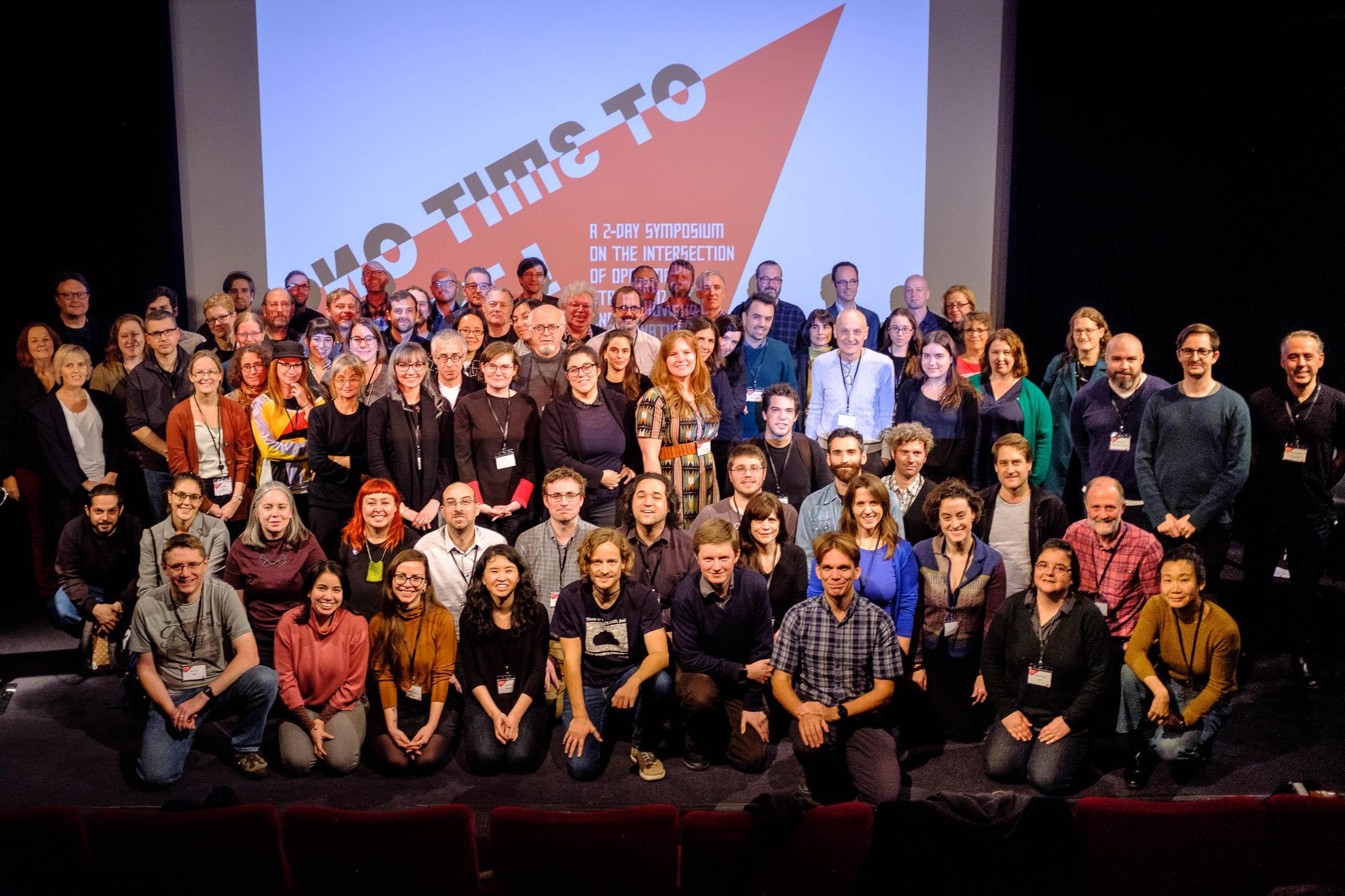
NTTW3 Group picture - Photo credit E. Verbruggen CC-BY
Introducing ePADD
Glynn Edwards, Josh Schneider and Peter Chan are part of the team at Stanford University Libraries
Email offers singular insight into and evidence of a person's self-expression, as well as records of collaboration, networks, and transactions. Email communications of prominent individuals, including politicians, writers, scholars, and the like, reveal not only their professional and personal actions, decisions, and creative output, but also relationships within society and communities. Thus, the appeal of email collections extends beyond historians to all manner of researchers, journalists, and the general public seeking to obtain insight into individuals and their lives.
Community Cultivation and the Software Preservation Network
Jessica Meyerson is Research Program Officer for Educopia Institute and coordinating member of the Software Preservation Network
Introduction
As the Software Preservation Network (SPN) makes its first attempt to transition from a grant-funded effort to a member and sponsor-supported community, we do so with an awareness that initiating a new collaborative effort looks very different, in terms of required skills and resources, from sustaining an existing collaborative effort. We are lucky to be informed by Educopia Institute’s Community Cultivation - A Field Guide (CCFG), which provides a comprehensive description of community growth both in terms of lifecycle stages (Formation, Validation, Acceleration, Transformation) and growth areas (Vision, Engagement, Infrastructure, Governance, and Finances & Human Resources).
I want to take this opportunity to map a subset of SPN’s activities using the CCFG with the goal of demonstrating SPN’s commitment to responsible development and to provide an example of how other digital preservation communities can use the field guide as a tool for assessment and development.
The supermassive black hole in the middle of our current digital preservation strategies
Carl Grant is Dean (Interim) for the University of Oklahoma Libraries
In July 2018, astronomers announced that they had located a supermassive black hole at the center of the Milky Way Galaxy, our home galaxy. (Black holes are gravitational fields that have such intensity that when things enter, they disappear without a trace.) Which reminded me of a concern I’ve been voicing about digital preservation for the last several years, i.e., the fact that we have no apparent organized strategy for preserving cloud-based services.
PERSIST – UNESCO’s Commitment to Digital Heritage
David Fricker is the Director-General National Archives of Australia and President of the International Council on Archives
For some time, UNESCO has recognised the transformative power of digital media as a creative engine of cultural heritage, and as a carrier through which culture is transmitted across populations and through time to future generations. Of particular concern, however, is the fragile nature of digital heritage and the risk that, as technology advances, so much of our digital heritage is lost through neglect or technological obsolescence. Back in 2003, in article 12 of its visionary Charter for the Preservation of the Digital Heritage, UNESCO defined its task ‘to serve as a reference point and a forum where Member States, intergovernmental and international non-governmental organizations, civil society and the private sector may join together in elaborating objectives, policies and projects in favour of the preservation of the digital heritage’. More recently, in 2015, UNESCO adopted its Recommendation Concerning the Preservation and Access to Documentary Heritage, including in Digital Form, which calls upon member states to establish cooperation and dialogue between governments, social organisations, and the ICT industry, and to create practical solutions in the area of sustainable digital preservation.
What Do We Need & What Can We Do Without for Digital Preservation Storage?
Andrea Goethals is Digital Preservation Manager at the National Library of New Zealand
What We Learned by Playing Games at iPRES 2018
Over the last few years a group of us have been working on a list of criteria for storage that supports digital preservation (see version 3 at https://osf.io/sjc6u/). At the recent “Using the Digital Preservation Storage Criteria” iPRES 2018 workshop, we put the criteria to the test.
Once Around the Sun: World Digital Preservation Day 2018
At the point this blog is published, the calendars in Fiji and Auckland and Wellington will already have clicked over to 29th November. As the sun sets over my hotel in Amsterdam it will have risen already on World Digital Preservation Day, so I have the privilege and pleasure of welcoming you all to World Digital Preservation Day 2018.
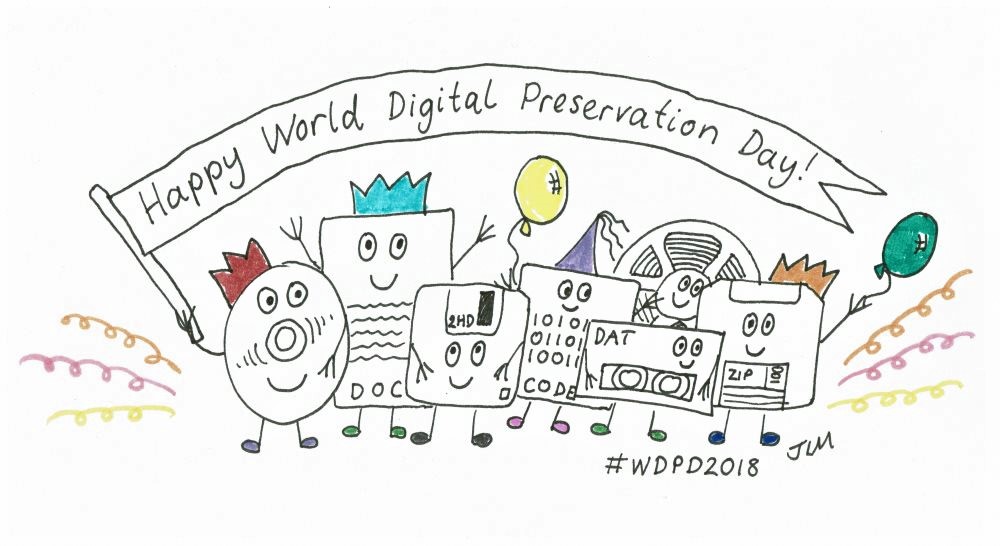
Expecting the Unexpected... World Digital Preservation Day
You never quite know how some things are going to pan out, and that was certainly true for our first World Digital Preservation Day (formerly International Digital Preservation Day) in 2017. For those of you who weren’t involved in last year’s inaugural extravaganza, honestly it was one of my favorite DPC days ever - and for those who were, I really hope you enjoyed it as much as I did!
In the hope that I can encourage even more people to join in the fun on 29th November, I shall endeavour to try and sum up why World Digital Preservation Day was SO great last year.
Here comes the sun: IDPD17+1
The sun has set now on International Digital Preservation Day (IDPD17) around the world, so, at the very last tick of the clocks on the most westerly reaches of the setting sun, we’d like to conclude by offering our thanks to colleagues in all time zones.
We have been astonished, delighted and massively energized by the numbers that participated, by the number of blogs, tweets, emails, messages on every media platform imaginable. There has been a significant effort of disk-imaging, file-migrating, and archive-describing. I never knew that ‘digital preservation cake’ was a thing but there’s been an awful lot of it in show; I didn’t know that a working ‘day’ could last for 39 hours; and I could scarcely have imagined the word ‘cryo-flux-a-thon’. There has been enthusiasm and generosity, insight and commitment, and a wonderful sense of celebration at the gathering of our dynamic, diverse and dispersed community.
I think it is safe to say that our first International Digital Preservation Day has been a success.
Preservation and Archiving Special Interest Group in Mexico City, 2019
Natalie Baur is Preservation Librarian at Biblioteca Daniel Cosío Villegas, El Colegio de México in Mexico City.
The Biblioteca Daniel Cosío Villegas at the Colegio de México in Mexico City is thrilled to announce that we will be the hosts for the next Preservation and Archiving Special Interest Group meeting! This exciting conference will be held at the Colegio de México’s installations from February 12-14, 2019, so save the date now! You will not want to miss this unique opportunity to talk digital preservation with colleagues from around the world. PASIG 2019 will be unique in that this is the very first time that the meeting will be held in a Latin American country. Mexico City is a vibrant, cosmopolitan city that will afford lots of excellent discussion on digital preservation advances locally in Mexico and throughout the Caribbean and Latin American region. We plan to have many attendees from across the region present at the meeting and this new infusion of perspectives and experiences will undoubtedly reinvigorate discussions happening in the international digital preservation community.
Creating a Linked Data version of PREMIS
Evelyn McLellan is President of Artefactual Systems and member of the PREMIS Editorial Committee.
It has been a busy couple of years for the PREMIS Editorial Committee. Since June 2015, when we released version 3.0 of the PREMIS Data Dictionary, we have been revising and releasing supporting documentation such as revised Guidelines for using PREMIS with METS and Understanding PREMIS, and updating and enhancing the preservation vocabularies, particularly the eventType vocabulary.
Perhaps the biggest undertaking, however, has been the preparation of a new OWL ontology by a working group that includes some members of the Editorial Committee plus external Linked Data experts and preservation practitioners. This is a work in progress and we are hoping to release a draft soon for a period of public review and feedback.
Losing the Battle to Archive the Web
David S. H. Rosenthal is a retired Chief Scientist for the LOCKSS Program at Stanford Libraries.
Nearly one-third of a trillion Web pages at the Internet Archive is impressive, but in 2014 I reviewed the research into how much of the Web was then being collected and concluded:
Somewhat less than half ... Unfortunately, there are a number of reasons why this simplistic assessment is wildly optimistic.
Costa et al ran surveys in 2010 and 2014 and concluded in 2016:
during the last years there was a significant growth in initiatives and countries hosting these initiatives, volume of data and number of contents preserved. While this indicates that the web archiving community is dedicating a growing effort on preserving digital information, other results presented throughout the paper raise concerns such as the small amount of archived data in comparison with the amount of data that is being published online.
Digitization Is Not Digital Preservation
Peter Zhou is Director and Assistant University Librarian at University of California, Berkeley
Over the past decade, I have spoken frequently at conferences on both sides of the Pacific, on digital information management and digital preservation, and I have just as frequently encountered academic leaders, librarians, and information specialists working under the misconception that digitization somehow equals digital preservation.
To many, converting print or analog content to a digital format and transferring the converted content to a disk, server, or other storage devices is an exercise in digital preservation. I usually point out that digital conversion makes content digital, but it cannot and will not guarantee that the digitized content can or will be preserved for an unspecified period to come, since the new format may become old, obsolete, or unusable in a matter of a few years—and then there are the problems of format reconciliation, checksum, error correction, data storage, and data migration, all of which are critical components of a robust digital preservation operation, whereas by simply storing the digital content and doing nothing else, one will miss all those vital steps.
Digital Preservation 2007-2017
Art Pasquinelli is LOCKSS Partnerships Manager at Stanford University Libraries in Palo Alto, California USA
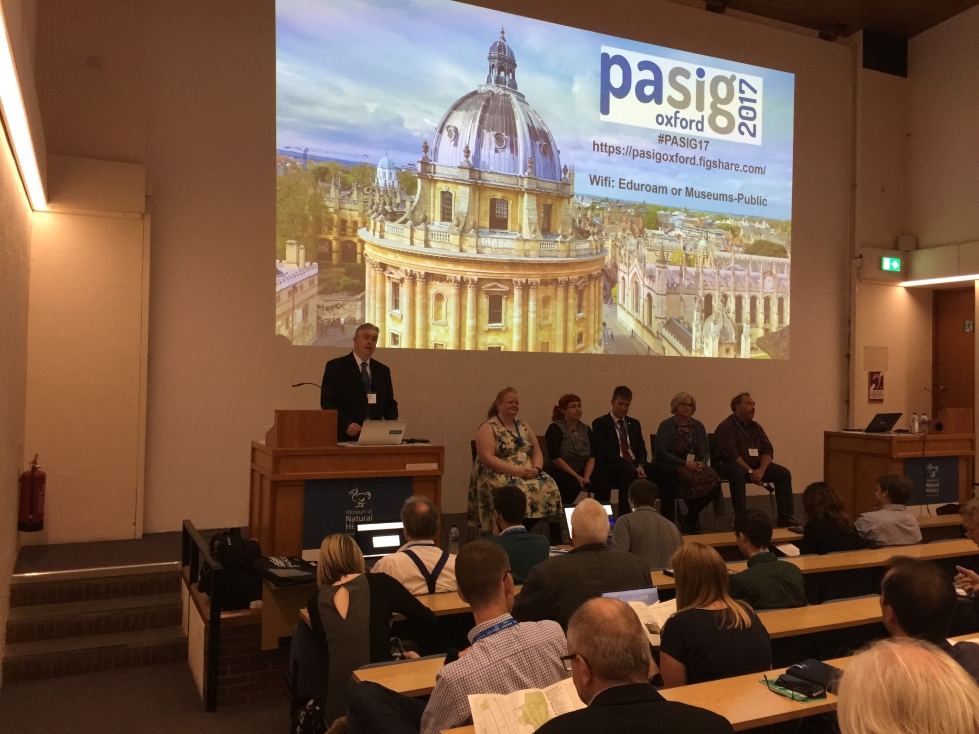
I wanted to take the opportunity of the International Digital Preservation Day to do a retrospective on how we have evolved with regards to Preservation and permanent access over the last decade. So, I looked at two agenda snapshots; one from one of the earliest Preservation and Archiving Special Interest Group's (PASIG) meetings in May 2008 and the other the latest meeting in Oxford in September 2017. The initial meeting can be seen at http://www.preservationandarchivingsig.org/index.html and the latest one can be viewed at https://pasig.figshare.com/pasigoxford. After looking at the content of the two Preservation meetings I came away with a very positive impression. Here are a few reasons why I feel so upbeat.
It’s difficult to solve a problem if you don’t know what’s wrong
Shira Peltzman is Digital Archivist for the University of California, Los Angeles (UCLA) Library Special Collections
Buried in the recently published findings from the 2017 NDSA Staffing Survey is evidence of a growing discontent among practitioners with regard to their organization’s approach to digital preservation. The survey asks respondents whether or not they agreed with the following statement: “The way our digital preservation function is currently organized (staffing levels, expertise, where they are placed within the larger organization) works well.” Of the 133 people who took the survey, 61 of them, or roughly 46%, either disagreed or strongly disagreed with that statement.
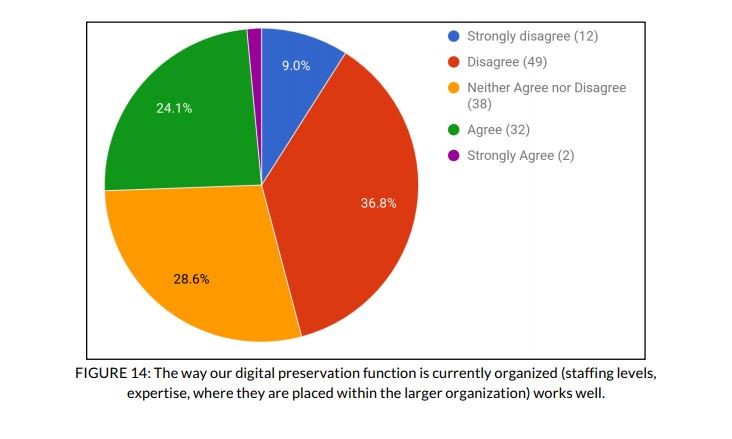
“Q16 - The way our digital preservation function is currently organized (staffing levels, expertise, where they are placed within the larger organization) works well. [133 respondents]”] Taken from “Staffing for Effective Digital Preservation 2017 An NDSA Report”: http://ndsa.org/documents/Report_2017DigitalPreservationStaffingSurvey.pdf
To say that those numbers aren’t great would be an understatement. To make matters even worse, they represent an increase from the 2012 iteration of the survey, in which 34% of participants reported that they were unsatisfied with how things were organized.
Lossy Accelerant: Surfeit and Fragment in Digital Collections Archives
Jefferson Bailey is Director of Web Archiving Programs for The Internet Archive in the USA
Archival collections have always been incomplete. Being homogenous, selective groups of records preserved through time, they support attestation and evidentiary consideration only through their longitudinal availability. Multiple appraisal, selection, and processing strategies have developed over the history of the archival endeavor to address the ways in which the archival collection is, by nature, a partial or symbolic representation. From documentation strategy to the study of “archival silences,” both archivists and users alike have grappled with the challenges of incompleteness inherent in the archive. The emergence of born-digital records, and the ease of their creation, alteration, and publication, has compounded these challenges by introducing a documentary environment that is at once more rich and more easily preserved, but also more dynamic, more ephemeral, and more partial. Furthermore, digital records have introduced their own characteristics of incompleteness: bit corruption, format migration, rendering and technological dependence, and other vulnerabilities that can impede recreation or interpretation.
What we’ve done well, and some things we still need to figure out
David Minor is Director of the Research Data Curation Program at the University of San Diego Library and formerly the Chronopolis Program Manager
I’ve worked in the Digital Preservation field for about a dozen years, and have had the good fortune to see a number of generations pass. I’d like to offer some thoughts on what we’ve done well, and some things we still need to figure out.
What we’ve done well:
- Technology. In many ways, we’ve “solved” many of the digital preservation technology issues. Can we preserve bits for years and years? Yes. Can we move these bits around multiple locations and service backends and guarantee their persistence? Yes. Can we migrate data through various data types and outputs? Yes. (If we need to. Still an open question.) In many ways, the digital preservation community has made enormous strides in infrastructure that would have stymied us in the recent past. Can we do better? Of course. Will there be new technologies that come along and cause us to rethink everything we’ve done up to now? Hopefully. But if not, well, we can do our jobs, and we can do them well.
- Variety of options. A striking facet of our community is the range of non/not-for profit options that 100% compete with commercial fare. We don’t celebrate this enough. Other significant segments of the digital library landscape have struggled with this for decades with little success. Today an organization that wants to contract with a preservation service can choose from at least a half dozen community-driven efforts, that are at least as good (if not better) than expensive commercial offerings. This is completely beyond awesome. It shows both the need for digital preservation across wide swaths of organizations and enterprises, as well as the dedication of large groups of people to solve thorny issues.
Where is the real risk?
Carl Grant is Associate Dean/Chief Technology Officer at University of Oklahoma Libraries
It’s always one of my goals in my role, to watch emerging technologies and to try and identify those that, per the model Geoffrey Moore established, will “cross the chasm” (https://en.wikipedia.org/wiki/Crossing_the_Chasm ) and have an impact in research and pedagogy. This is always a risky move. You can be totally wrong, spend a fair amount of money and have little to show at the end. Or you can be right and be a leader in helping deploy that technology in addition to being well positioned to capture the historical record surrounding it.
Too many librarians are extremely risk adverse, due to typically working in a publicly funded institution. I understand why that makes so many hesitant to take a risky approach. But I wonder if they’re weighing the right risk? In my mind, I want the library to be seen as a place to come and try out new technology, a place where people can get help evaluating the pluses and minuses of that technology and help in using it to pursue their pedagogical and research goals. I want them to see the library as a place of engagement, exploration, innovation and synthesis. We can’t do sitting on the sidelines. Especially, in a world where technology is advancing as rapidly as it is today. Doing so is to risk being seen as obsolete, a problem I hear all too many colleagues moaning about being the perception of their library on their campuses.
Digital Preservation Opportunities at ICPSR
Jared Lyle is Archivist and Director for ICPSR Curation Services and the DDI Alliance in Michigin, USA
The Inter-university Consortium for Political and Social Research (ICPSR), a social and behavioral science data archive based within the Institute for Social Research at the University of Michigan, is happy to celebrate the first ever International Digital Preservation Day. ICPSR curates, preserves and shares 10,000+ data collections. We also provide educational opportunities, including our Summer Program in Quantitative Methods and Social Research, and conduct data stewardship research projects.
ICPSR has been preserving data collections for over 50 years. Over the decades, we’ve archived data from punched cards and floppy disks and other media, as well as data in a wide range of formats, including now-decommissioned OSIRIS dictionaries written in EBCDIC. We still do the occasional legacy conversion, such as rescuing data from a pioneering 1950s study of retirement, although the majority of data we acquire today arrive in more modern formats, such as SAS, SPSS, Stata, and R. Regardless of the age, type, or shape of the data, preservation opportunities and challenges abound.
Networked Approach to Preserving Software
Jessica Meyerson is Research Program Officer for Educopia Institute in Austin, Texas, United States
One of key characteristic of information infrastructure outlined by Star & Ruhleder (1996) is that is ‘becomes visible on breakdown.’[1] While software does in fact breakdown, requiring patches or upgrades, as digital materials move from active use to the reuse context of cultural memory organizations, software breakdown can be understood as the inability to support meaningful access to digital information (ie, scientific or social scientific data, born-digital manuscript materials, complex models of the built environment) due to software dependencies and their associated challenges. This breakdown not only shines light on software (as cultural heritage itself and a tool for accessing existing digital cultural heritage), it makes visible the social structures and practices in which software is embedded – is a comprehensive breakdown of social structures to support information access including communication, legal systems and markets. By thinking about software as infrastructure we gain insight into ways in which software preservation fits into broader digital preservation practice as well as approaches that may prove to be the most effective in addressing the challenges of software preservation.
Towards a Philosophy of Digital Preservation
Stacey Erdman is Digital Archivist at Beloit College, Wisconsin USA
Are archivists born or made? I suppose we’ll never know the answer to that question definitively, but I feel pretty confident that if there’s an archivist “gene” I’ve surely got it. I’ve been actively building a personal archive since I was old enough to understand what memories are.
Of course, coming of age during the rise of the personal computer presented me with challenges in this arena. I still own my first computer – an Apple IIc, along with the floppies that contain my clumsy attempts to learn to program in BASIC. When I went off to college in 1995, I purchased a used Macintosh Plus and dial-up modem; soon I was surfing Mosaic from my dorm room in Urbana-Champaign – home to HAL 9000, the fictional computer from 2001: A Space Odyssey. I discovered BBSs, IRC, newsgroups, MUDs, and became a voracious e-mail correspondent. I dove headfirst into this new online life, but with time, I grew concerned about the astounding impermanence of it all. How was I to document the time I was spending in these realms?
The Next Leg in the Preservation Relay
Amy Kirchhoff and Sheila Morrissey work for the Portico digital preservation service which is part of ITHAKA, a not-for-profit organization in the USA
Portico, a service of the non-for-profit organization ITHAKA, is a preservation service for the digital artifacts of scholarly communication. Portico’s original remit 15 years ago– one shared by many DPC member organizations – was to develop a sustainable infrastructure, both institutional and technological, that would support the scholarly community’s transition from reliance on print journals to reliance upon electronic scholarly journals – more generally, to ensure that scholarly literature, published in electronic form, remains available to future generations of scholars, researchers, and students.
The occasion of the International Digital Preservation Day is an opportunity for us to reflect both on the continuing challenges (and opportunities) in preserving scholarly literature, and what we think might be new challenges ahead.
Written into our institutional DNA is the requirement simultaneously to preserve content at scale, and to preserve it in a fiscally sustainable way. Again, this is challenge we all share, across all the content domains we jointly seek to preserve. The sheer ever-increasing volume of content flowing into Portico was a major motivator for undertaking a two-year project, launched in mid-2016, to develop the next-generation Portico technical infrastructure project.
Educating Digital Stewards
Rhiannon Bettivia is a Postdoctoral Research Associate at the School of Information Sciences (iSchool) at the University of Illinois, Urbana-Champaign
I frame this post as a set of considerations for developing training and teaching modules for students and trainees endeavouring to enter the field of digital preservation. I teach such a module 2-3 times a year, and my university offers it 4 times a year with the help of adjunct instructors. It is often full to waitlist room only, meaning we will send anywhere from 50 up to as many as 110 students through this course in a calendar year. Chris Prom, of the University Archives, related that he was once requested to teach a module on advanced arrangement and description of digital materials for the Society of American Archivists nine times in a single year. The trend here is pretty clear: there are plenty of practitioners in the pipeline, ready to enter our field and to steward us into the future of digital preservation.
Brushing up on Digital Architecture, Design and Engineering Assets
Kate Murray works for Digital Collections & Management Services at the Library of Congress in Washington DC
On November 16, 2017 the Library of Congress, Architect of the Capitol and National Gallery of Art hosted the Designing the Future Landscape: Digital Architecture, Design and Engineering Assets symposium at the Library of Congress. The programming for the over 140 attendees included panels on lifecycle data management, data flow, access use cases, future-looking approaches and an ADE formats primer.
The presentations were recorded for later distribution on social media platforms, including YouTube, and a report covering the themes of the day will be published in early 2018. See #DigADE2017 on Twitter for on-the-spot reporting during the event and links to published information will be widely distributed when available.
DAM and LAM - towards convergence
Helen Hockx-Yu is Program Manager, Digital Product Access and Dissemination in the Office of Information Technologies for University of Notre Dame, Indiana USA
INTRODUCTION
Digital media are frequently produced and widely used at the University of Notre Dame (UND) to support education and research, and to document campus activities and athletic competitions. UND’s media products range from photographs and simple sound or video capture to sophisticated footage appropriate for national broadcasts. UND’s video assets are presently estimated to measure ~2PB.
As part of a project aimed at developing a common solution for managing Notre Dame’s video assets, we gathered and documented requirements from a wide range of stakeholders on campus and used these to assess Digital Asset Management (DAM) software.
DAM software vendors seem to have picked a very broad term for a relatively small software products segment. DAM systems (DAMs) in general have a much narrower focus than the collective name suggests. Different variants of DAMs are difficult to differentiate, making it hard for organisations to select the right product.
DAMs are a breed of software that manages specific types of digital information within a specific organisational context. DAMs are mostly intended for multimedia or rich media, such as photographs, videos, animation, graphics, logos, and marketing collateral. DAMs emerged in the private sector to support digital media creation, marketing, publishing, and brand management.
Operationalizing Digital Preservation: An Innovative New Curriculum
Kara Van Malssen is Partner and Senior Consultant at AVPreserve in New York
I work at AVPreserve, a consulting and software development firm, where we focus on developing innovative solutions that advance the ways data and information serve individuals, organizations, and causes. Often, we are asked to come in to an organization and help them assess their digital preservation efforts, in order to move toward expanding capacity, scope, functionality, overall efficiency, or standards-compliance. We start by looking at their current digital preservation practices, evaluating technologies, policies, workflows, procedures, staffing/roles, and other resources. It is not uncommon for us to find that the organization is “stuck” in some respect, struggling to, for example, consistently collect all digital assets of value, implement comprehensive ingest procedures, or store all content in a managed preservation environment. And while the causes of these challenges vary between organizations, lack of funding is generally not the culprit. There are a variety of operational factors that need to be considered in order to implement successful digital preservation processes.
The only archival digital document format
Duff Johnson is Executive Director of the PDF Association and Project Leader for ISO 32000 in Winchester, Massachusetts, USA
What is a “document”? It’s a record of some (typically written) content - a publication, a contract, a statement, a painting - at a moment in time. Until the advent of computers (and scanners), the only media considered useable for such records were papyrus, vellum or paper pages.
PDF became the document format of choice for business, government and the general public because it delivers the key qualities of paper in a digital format. PDF is fixed, self-contained, readily shareable and relatively hard to change. It’s not just PDF’s innate characteristics that make it successful, but the fact that PDF interoperates smoothly with paper documents. The classic “PDF it, send it, print it, sign it and return it” type of workflow introduced new efficiencies when PDF surfaced into public consciousness in the mid-to-late 1990s. This approach used only the most basic of the format’s capabilities, but it was enough to enable the slow economy-wide transition to digital documents.
The Emergence of “Digital Patinas”
Euan Cochrane is Digital Preservation Manager at Yale University Library in the USA
Physical objects often have a “patina” associated with them that illustrates their age and authenticity and evokes an emotional response in ways that are in contrast with responses to brand-new objects.
“Patina (/ˈpætɪnə/ or /pəˈtiːnə/) is a thin layer that variously forms on the surface of stone, copper, bronze and similar metals (tarnish produced by oxidation or other chemical processes), [1] wooden furniture (sheen produced by age, wear, and polishing), or any such acquired change of a surface through age and exposure.” https://en.wikipedia.org/w/index.php?title=Patina&oldid=810608866
Inform and Form – The Role of Education in Digital Preservation
Millard Schisler is Researcher at Digital Culture Center / CEBRAP in São Paulo, Brazil
It is wonderful to celebrate International Digital Preservation Day and recognize how much has been accomplished during the past decades, while also realizing how much we still need to work on, evidenced by the people, businesses and institutions struggling with how to deal with their ever-growing digital assets. As I think about our role in transforming this landscape, I go back to the beginning of this century, when Nancy McGovern and Anne Kenney talked about the three-legged stool that was necessary for digital preservation to happen: the organizational infrastructure, technological infrastructure and the resources (human and material). You cannot sit on a stool with just two legs – we need all three to maintain a balance, and one cannot be larger or smaller than another if we are to make the stool functional. I have used this image so much in my talks. With this awareness, another image came into my mind once when preparing for a lecture – if we were to connect all three legs at the bottom, it would provide the stool with extra sturdiness; this strength would come from the role of education within digital preservation.
Archivo web de Proceso de Paz y Posconflicto
Johanna Gallego Gutiérrez is Digital Deposit Manager for Biblioteca Nacional de Colombia, in Bogotá
La Biblioteca Nacional de Colombia ha iniciado la construcción del Archivo de la web y de recursos estáticos digitales sobre proceso de paz y posconflicto en Colombia. Esta iniciativa pretende recolectar, custodiar, preservar y divulgar, para las generaciones presentes y futuras, la historia web del importante momento que vivimos en nuestro país, a través de las herramientas especializadas de harvesting que permiten la copia de sitios web, recopilan su contenido, diseño y arquitectura.
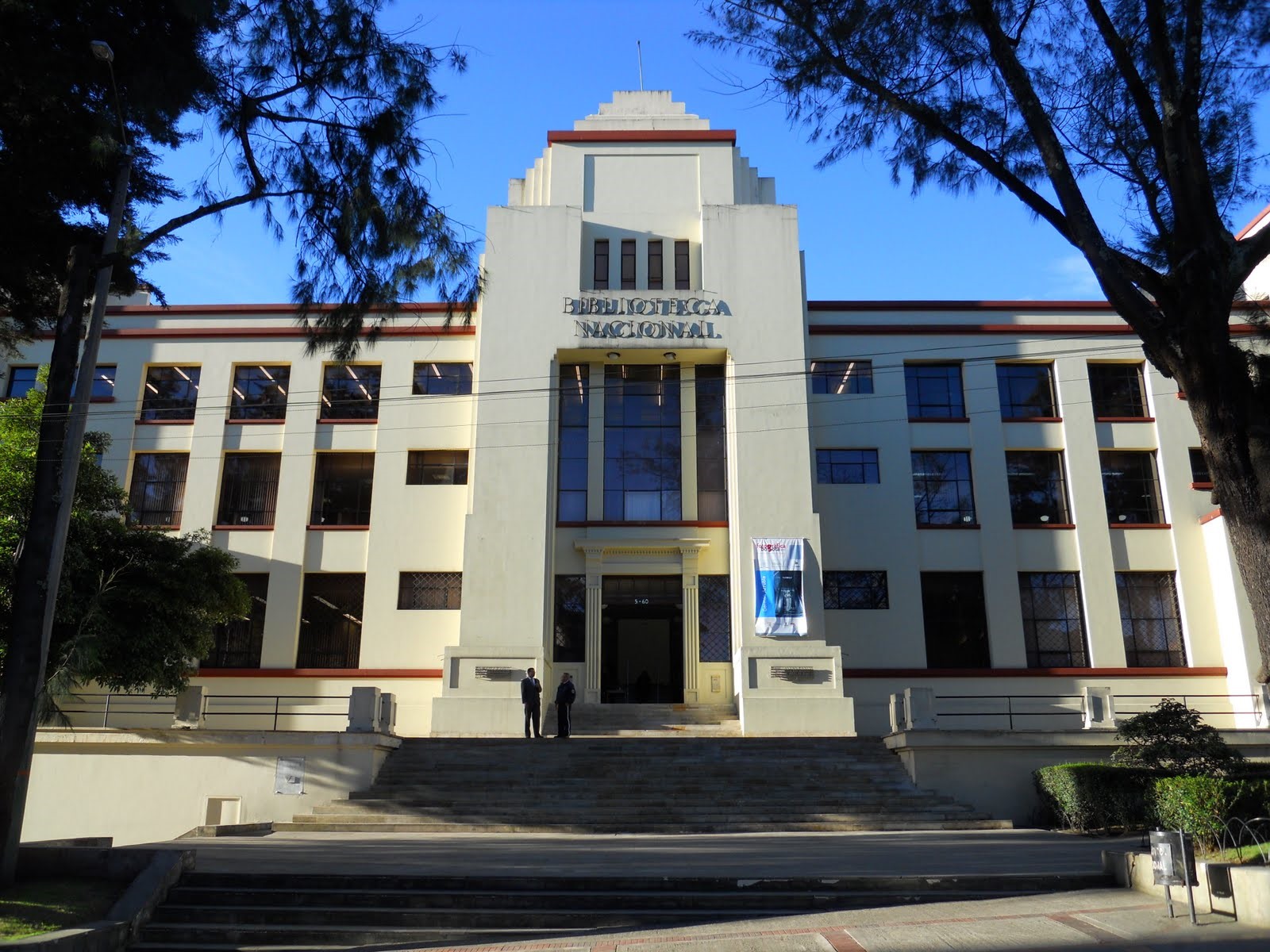
Biblioteca Nacional de Colombia. Foto por: Confidencial Colombia. Agosto 9, 2016.
Este interés surge, principalmente, por el actual proceso de paz que vive Colombia con las FARC, el mayor grupo guerrillero en el país y con mayor alcance militar. Pues, tras más de 50 años de guerra, nuestro país ha comenzado uno de los capítulos más anhelados por la mayoría de los colombianos.
Es importante resaltar que el escenario de producción en Colombia ha tenido un crecimiento importante desde la esfera digital; sin embargo, no hay una excepción en la legislación que le permita a la Biblioteca Nacional de Colombia realizar la preservación de este patrimonio. Además, las implicaciones de realizar la preservación web en casa, teniendo en cuenta que el dominio .co se ha vendido, es usado de manera comercial y su cosecha no garantizaría la salvaguardia de la web colombiana, por esto y teniendo en cuenta la compleja realidad, se ha iniciado un proyecto en alianza con la Universidad Externado de Colombia para la recolección selectiva sobre la producción web de proceso de paz y posconflicto.
A Wish List for the Future of the Digital Preservation Community
Nancy McGovern is Director of Digital Preservation at MIT Libraries in the USA
International Digital Preservation Day got me thinking about this: what might be most helpful for the digital preservation community to be able to continue to grow in a sustainable, inclusive, and responsive way? Here is a brief, annotated wish list for the digital preservation community using four attributes of an emergent group, a sociological convention to enable a group to be identified and studied.
- Membership: members have a sense of belonging to the group and it is possible to recognize other members.
Background: There is a perception that the digital preservation community exists and is growing. So far, the best ways to indicate membership has been attendance conferences and meeting.
My wish: That we identify more and increasingly better ways to be able to “join” the digital preservation community, whatever that may come to mean.
Collaboration is essential for Digital Preservation
Thomas Ledoux is Co-ordinator of Digital Production at the National Library of France
Digital preservation, seen from the outside, may appear as a very technical topic where you only talk about formats, storage, infrastructure and the like.
Indeed, in order to appraise, audit or ingest digital material, a certain degree of technical expertise is needed. But when you follow these steps, it becomes clear that the first requirement is collaborating and building up communities, because what you build should last.
Of course, the first community you need to build is inside your organization: aggregate an internal team. This means you need to define your own goals and start to share a common vocabulary (here is where tools like OAIS or METS can be helpful). A better understanding about the collections and the kind of media you have to deal with is essential. At the same time, you need to pool the means (especially storage infrastructure) so that what you build is sustainable.
The More You Know...
Leslie Johnston is Director of Digital Preservation for the National Archives and Records Administration in Washington DC, USA
One of the greatest challenge for any archive is the multiplicity of file formats. For the United States National Archives and Records Administration (NARA), with several decades of history accessioning and managing electronic records, this is compounded. We received our first transfer of electronic records in 1970!
How do you plan a preservation strategy to account for decades of electronic files? I started by drawing a picture. Not a literal picture, of course, but I wanted to find a way to analyze and visualize what NARA has in its holdings.
NARA has recently completed a file format profile of its electronic records files. Why did we do this? Because we could not plan without first getting a better idea of what we really have. NARA operates under several different regulatory mandates, each with different restrictions on collection schedules and scope, as well as access controls. This led to the implementation of multiple systems--developed over more than 20 years with different technologies--which meant a real challenge in understanding the scope of the holdings.
I worked with the system owners and our IT operations to get the most granular reporting possible on each set: federal, legislative, and individual presidential administrations. The reporting didn’t always match in terms of granularity, given different tooling for the format analysis and report generation, but in the end I was able to compile a record of what we have, what formats we have, and counts. Could we identify every file format with complete certainty? No. Were there decisions in the past about format normalization that I had to take into account? Yes. Will it help me plan for preservation program and technology priorities? Absolutely.
Digital Preservation at Historic Environment Scotland
My name is Hannah Smith and I work for Historic Environment Scotland, based in the digital archive team within the Heritage Directorate. For the first ever Digital Preservation Day I thought I would share some of the progress we have been making in terms of digital preservation at HES, as well as some of the more day to day work in the digital archive. We have been actively collecting digital archive since 2003, receiving both internally and externally generated material. Historic Environment Scotland currently holds more than 437,000 catalogued digital items which equates to around 32TB of archived data. Over the last 2 years, the digital archive has been making huge strides in renewing the technical infrastructure that underpins our work and to ensure the long term preservation of our digital records. Our goal is to provide the best possible care for our digital archives and we are looking to bench mark our services within the European accreditation framework. In 2015 HES invested in new trusted digital repository software, and work has focused on integrating this preservation system with our own repository. We have made huge advances in the standard of care we provide to our digital archive: 617,338 individual digital files have been audited and processed to ensure they conform to appropriate standards.
The Threat of the Double Extinction
Cees Hof is Project Acquisition Manager at Data Archiving and Networked Services(DANS) in the Netherlands
A first glimpse at the DPC ‘Save the Bits’ announcement on the compilation of a list of Digitally Endangered Species confused me when it passed my screen. Further scanning the text only increased this feeling as I encountered more ‘species’ related references, but it soon turned out I was misled by my own biologically biased search image.
It was especially the ‘IUCN Red List of Threatened Species’ that was steering me wrong. A list very familiar to me as a former coordinator of several large Biodiversity data programmes. But the DPC suggested list had nothing to do with plants, animals and microbes soon to disappear from our planet’s surface. It was all about their digital equivalents occupying binary niches and threatened by the lack of proper digital archives, outdated software formats, or insufficient human efforts to safeguard their existence.
Two early episodes on digital preservation… plus one!
José Borbinha works at INESC-ID – Instituto Superior Técnico (IST) at Lisbon University, Portugal
(Episode 1) When unsuccessful digital preservation can be convenient
The year of 1998 was special. In May, it opened the Lisbon World Exposition! In June, it was held the “Sixth DELOS Workshop on Preservation of Digital Information” in the beautiful Tomar. Finally, in October, I became CIO of the National Library of Portugal.
In retrospective, 1998 was my definitive commitment with this great world of digital libraries and archives. A seed has been planted in 1996, when I got involved in the new DELOS Working Group on Digital Libraries, and it blossom in 2000 when I had the privilege of organizing the 4th ECDL conference in Lisbon. DELOS was a community that still brings special memories (“saudade” as we say in Portuguese - https://en.wikipedia.org/wiki/Saudade)
Lansio Polisi Cadwedigaeth Ddigidol i Gymru / Launching the Digital Preservation Policy for Wales
Sally McInnes is Director of Unique Collections at the National Library of Wales
Today is the first International Digital Preservation Day. The aim of the day is to create greater awareness of digital preservation and the issues associated with preserving and providing access to digital material. There are particular challenges associated with the preservation of digital material, notably the fast pace of software and hardware developments, the increasing complexity of digital resources and the resulting impact on the stability of such media. If digital material is to remain accessible, both in the short-term for business continuity, research, economic and legal requirements and for preserving the historic record in the longer-term, measures have to be taken to ensure that this information is accessible.
The International Digital Preservation Day has been co-ordinated by the Digital Preservation Coalition http://www.dpconline.org/. The NLW is a long-term member of the DPC, the aim of which is to support its members to make digital information available in the future. It has published a 'Bit List' of the World's Endangered Digital Species http://dpconline.org/our-work/bit-list) which has been unveiled today as part of this campaign to raise awareness of the need to preserve digital materials.
Guten Tag from the North Rhine-Westphalian Library Service Centre
Martin Iordanidis is Information Safety Officer at HBZ in Germany
Hey, thats us! Us at the North Rhine-Westphalian Library Service Centre (hbz) in Cologne, which is an authority of the federal state of North Rhine-Westphalia, Germany.
The Costs of Inaction: advocating for digital preservation
Neil Beagrie is Director of Consultancy at Charles Beagrie Ltd
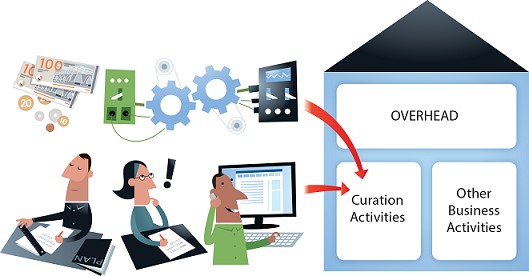
Illustration by Jørgen Stamp digitalbevaring.dk CC BY 2.5 Denmark
Traditionally the major challenge in digital preservation has been seen to be technology obsolesence. However, arguably the organisational challenges, particularly funding (and advocacy for funding), have proved to be much more significant over time.
In recent years an increasing number of community efforts have focussed on helping organisations to identify benefits and write a business case for digital preservation. The Keeping Research Data Safe (KRDS) Digital Preservation Benefits Analysis Tools and the Digital Preservation Business Case Toolkit are good examples.
Digital Preservation Milestones at the University of Sheffield
Chris Loftus is Digital Preservation Manager at the University of Sheffield Western Bank Library in the UK
The first International Digital Preservation day allows us an opportunity to reflect on some of the milestones and significant events so far in the implementation of the University of Sheffield’s Digital Preservation programme. The Library became one of the early adopters of Rosetta, a Digital Preservation solution provided by ExLibris, in 2015. Following installation Rosetta was given the Sheffield brand name ArchiveUS and initial priority focussed on developing ingest routes for our valuable digital material; born digital and digitised collections from Special Collections and the National Fairground and Circus Archive.
In September 2016 the University's Festival of the Mind event gave the Library the opportunity to highlight the thinking behind Digital Preservation through a collaboration with local artist Paul Carruthers. ‘Memories in the digital age’ is a triptych film that featured difficult to access footage from the library’s collections. The piece, which was exhibited at Sheffield’s Millennium Gallery, explored some of the ideas underpinning Digital Preservation; such as the generation and use of digital information and its relationship to memory.
To deposit, or not to deposit (or whether it is a question at all)
Kuldar Aas is Deputy Director of Digital Archives at the National Archives of Estonia
Prologue
October 2006. A workshop discussing digital information management. A known and respected IT visionary comes up and delivers a statement about file format obsolescence: “It is really not an issue to worry about. In ten years we will certainly have artificial intelligence which is able to render any bitstream there is”.
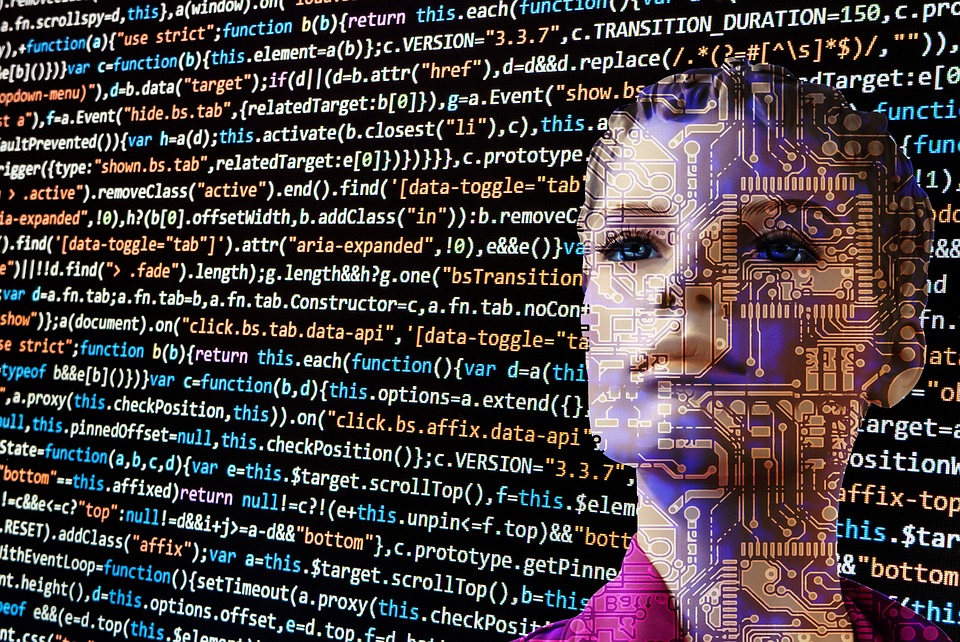
Pixabay, CC0, https://pixabay.com/en/artificial-intelligence-robot-ai-ki-2167835/
The digital society and the digital archivist
“Dear community! My name is Kuldar and I’m a digital archivist in Estonia.”
The particular thing to note about this confession is the country as such – just Google for it and you are guaranteed to get a fair number of hits which describe how in e-Estonia you can set up companies in 18 minutes, declare taxes in 3 minutes, or tell you that 99% of public services are available online. Digging a bit further you will find out how Estonia has implemented nice things like ‘once-only’, ‘digital by default’, and ‘no legacy’ – principles which, when spoken out aloud, will lead any reasonable archivist straight to a mental institution along with inflicting a serious heart condition.
A day at the digital archives of the National Archives of Denmark
Anders Bo Neilsen is the Senior Adviser on Digital Preservation at the Danish National Archives
Thursday was yet another busy and versatile day here at the section of Digital Preservation of the Danish National Archives. As usual there were the daily audit reports and the results of the quality assurance of the ingested SIPs which once again were spit out (pun intended) by our QA system. The producers of the SIPs were notified and given a new deadline for resubmitting SIPs which we can ingest and digest. Almost all of the rejected SIPs were produced by national authorities, but one or two were actually produced by a colleague. A taste of one's own medicine can be bitter and hard to stomach. The errors were the typical ones: lack of context documentation, missing explanation of code values, broken referential integrity and poor conversions to TIFF.
Having dealt with the ingest problems we turned our focus on the next item in the process, the packaging and storage of the AIPs. We are in the process of storing five AIPs from five similar authorities ranging in size from two to eight TB. At first we could not understand the huge size of these AIPs produced from ordinary digital case and document management systems. It seems that many incoming documents are an order of magnitude larger than the outgoing. Apparently, quite a few citizens seem to reply to these authorities by printing out the documents they receive, adding handwritten comments on them, taking pictures of all the pages using their smart phone, and emailing them to the authorities. That is how an outgoing black and white document is transformed into an incoming document in full colour - and full size.
Name that item in…?
Kirsty Lee is Digital Archivist for the Division of Library and University Collections at the University of Edinburgh, Scotland.
I’d like to start International Digital Preservation Day, by putting a conundrum out to the community. My colleague, Lorraine McLaughlin, here at the Centre for Research Collections in the University of Edinburgh, and myself are currently appraising a hybrid collection that documents the history of computing at Edinburgh University from the inception of the Edinburgh Regional Computing Centre (ERCC) in 1966, to its later incarnation the Edinburgh University Computing Service in the 1980s.
The ERCC was to have a considerable impact on computing services as we know them today. Following the Flowers Report in 1966 there was to be regional computing centres set up in London, Manchester and Edinburgh tasked with providing computing services for local university users, research council establishments and other universities.
Keynote Address at 'RecordDNA: developing a research agenda for the future digital evidence base...', Westminster
Nick Thomas-Symonds MP is co-Chair of the All-Party Group on Archives and History for UK Parliament.
This blog post is the text for a speech delivered by Nick Thomas-Symonds MP on 30 November 2017 at a RecordDNA event at Westminster.
As Co-Chair of the All Parliamentary Archives Group I am delighted to open this event, which is being held on International Digital Preservation Day. Delighted also to welcome such an impressive range of speakers. Let me start by thanking Elizabeth Lomas of UCL and Julie McLeod of Northumbria University, for organising and implementing such an impressive programme. Thanks also to all of you for coming. You are a critical part of this partnership.
Records matter. We all depend on them. Members of Parliament rely on them to inform debate, make better laws and hold the executive to account. Everyone will at some point need records, whether investigators into injustice, members of the public researching their family history or needing access to their health history, or scholars needing an evidence base for their research.
How can Digital Preservation move beyond those in the know to those with the need
Jon Tilbury is Chief Technology Officer for Preservica, based in the UK
Digital Preservation has come a long way since the early research projects. The earliest practitioners were academics and specialists who set this field in the right direction and contributed hugely to defining what Digital Preservation is, creating the language of SIPs and DIPs, ingest and dissemination and preservation planning that we all use today. This journey will be complete when information is preserved without the need to understand how and long-term retention and use is just another tick box in your day-to-day IT platform. How far are we away from creating this preserved future?
The early Digital Preservation research projects started in the late 1990s and reached their peak with large numbers of EC funded projects in the first 15 years of the millennium. I become involved in the early PRONOM days and enjoyed many trips around Europe on four different research projects as practitioners exchanged ideas and built prototypes that encapsulated these ideas. We used the OAIS reference model to create a common language that we all now use to describe our systems.
And the answer is…
Roxana Maurer-Popistașu is Digital Preservation Coordinator at the National Library of Luxembourg
National Library of Luxembourg’s Digital Preservation challenges
As a national heritage library, the National Library of Luxembourg (BnL) has as a mission to collect, catalogue, enrich, and preserve the national heritage, both in print and in digital form. Since 2002, the BnL has been digitizing documents to not only ensure the optimal preservation of the originals weakened by their age and / or frequent use, but also to promote the published cultural and intellectual heritage, facilitate access to it and support new research methods. The digitized collection includes historical newspapers, books, manuscripts, postcards, and posters from the Luxemburgensia fund (publications from Luxembourg – legal deposit – or issued abroad by Luxembourg residents or in connection with Luxembourg).
Welcome to International Digital Preservation Day
Although the sun has barely risen over the DPC offices, International Digital Preservation Day (#IDPD17) has been in full swing for at least the last 12 hours thanks to our colleagues in Asia and Australasia who have been doing a great job of celebrating on behalf of the whole community!
International Digital Preservation Day is fundamentally about this large but dispersed community around the world and the opportunities for access and re-use which are made possible when digital assets are preserved. Supported by digital preservation networks around the world – old friends and new - IDPD17 is open to participation from anyone and everyone interested in securing our digital legacy.
While we’ve been asleep a whole pile of blog posts have been published, and we can see through the twitter and instagram feeds that colleagues in New Zealand and Australia are clearing up after important and well-attended events.
Web preservation demands access
Daniel Gomes is Arquivo.pt Service Manager for the Foundation for Science and Technology in Portugal.
"Collect the web to preserve it?! I don't envy that job."
That is a direct quote from my first "real-world" meeting.
I was 23 years old, I had just graduated from the University and that was my first job. We were in the year 2000.
One year later, we had developed a running prototype to perform selective collection of online publications. It was the first effort to preserve the Portuguese web, resulting from a collaboration between the National Library of Portugal and the University of Lisbon.
Even in those early-days of the Web, it became clear that acquiring and storing information from the Web before it quickly vanished was a challenge. But a rather simple one, in comparison to ensuring the accessibility of the stored web data across time.
Preservation as a present
Barbara Sierman is Chair of the Board of Directors for the Open Preservation Foundation (OPF) and Digital Preservation Manager in the Research Department of the Koninklijke Bibliotheek (National Library of the Netherlands).
20 Years of preservation have brought us valuable insights, useful tools and a large quantity of digital material that is now taking care of.
For the general public, used to their tablets and phones where everything is stored for them somewhere in the cloud and new updates are almost always compatible with older versions, the issue of preservation is invisible. This is very convenient for them, but not for us trying to get political attention and sustainable funding for our invisible activities.
Most people however value their digital stuff. This “digital capital” should be in our story to convince funders when asking for budgets to preserve the digital materials. Preservation should not be a problem but a commodity. Something that helps you to take care of your stuff in a way you were not aware of. Like water that comes out of the tap: reliable, clean and always available (at least in part of the world). Only a few will know about the organisation behind this clean water. Although often taken for granted, in fact the running water is a present, resulting from a wide range of carefully planned actions. Similarly the preservation community could mirror this water model.
Dear IFI Irish Film Archive of five years ago
Kasandra O’Connell is Head of the IFI Irish Film Archive in Dublin, Ireland
Dear IFI Irish Film Archive of five years ago,
I know you are filled with trepidation at the sudden need for the IFI Irish Film Archive to preserve Ireland’s digital moving image heritage alongside your analogue collections. The switch to digital formats within the film and broadcasting sector in Ireland has been sudden, encouraged by a government sponsored scheme enabling cinemas to change from analogue to digital exhibition. This has left you with no option but to take in digital material as part of your preservation agreements with the two main funders of moving image production in Ireland, the Broadcasting Authority of Ireland and the Irish Film Board. Starting from scratch is scary. No one on your small team has an IT background, you haven’t the necessary equipment and infrastructure to deal with digital deliveries and the thought of making preservation format decisions or developing digital polices is so alien at the moment that it induces a cold sweat. I’m here to give you some reassurance. Five years from now the IFI Irish Film Archive will have made more progress in this area than you could have possibly imagined. While there is a still a lot to do and there are many challenges ahead, the team have accomplished a huge amount in a short time and the archive as you now know it is unrecognisable.
Preserving digital cultural heritage: Better together!
Barbara Signori is Head of e-Helvetica at the Swiss National Library, Bern.
The Swiss National Library has a mandate to collect, catalogue, store and disseminate the cultural heritage created in Switzerland and abroad by and about the Swiss. This sounds like a clear enough mission, but dig deeper and this mandate raises all sorts of tough questions especially in a digital world.
First of all, what is digital cultural heritage? Obviously it goes far beyond e-books and e-journals, it includes Swiss websites, newsletters of Swiss societies, and so on. But what about all the digital data that is created by Swiss people every minutes of every day? The selfies, blogs, tweets, social media, personal digital archives. I’m sure that not everything can or should be considered cultural heritage. But who decides what is and what isn’t?
Frisch’s speech in Hamburg and what it tells us about radio archiving
Brecht Declercq is Secretary-General of FIAT/IFTA, Digitisation Manager at VIAA
Hamburg, Germany, almost day on day 40 years ago. Swiss writer Max Frisch, at age 66, went to great lengths to travel from his hometown Berlin to Hamburg. He has accepted to give a speech at the SPD party congress in Hamburg. Frisch has had a good relationship with prominent German Social Democrats such as Willy Brandt and Chancellor Helmut Schmidt for years and the speech may be regarded as a friends service. The party congress is known as "the day the Chancellor asked the poets for advice" - Günther Grass is also present - and takes place in the midst of what the Germans call the German Autumn: a period of far left attacks and kidnappings, from Germans, against Germans. The speech of Max Frisch is a benchmark, even a crisis. To the German Social Democrats Frisch will point out their social democratic responsibility, also as a government party, and also in times when the street's call for severe repression against the very young RAF terrorists sounds particularly loud.
We need to talk about copyright
Susan Reilly is Director of Digital Library, Licencing & Copyright at Qatar National Library, Doha
With a European Parliament vote on copyright reform looming it’s worth taking a look at the relationship between digital preservation and copyright law and why we need copyright reform at international level to help ensure the preservation of the digital cultural and scientific record.
You don’t need to be a lawyer to figure out that one of the biggest challenges facing digital preservation today is copyright. Digital preservation usually necessitates the making of several copies, shifting formats or making derivative works, circumvention of technical protection measures, not to mention making available. Each one of these acts can require an exception and limitation in copyright law.
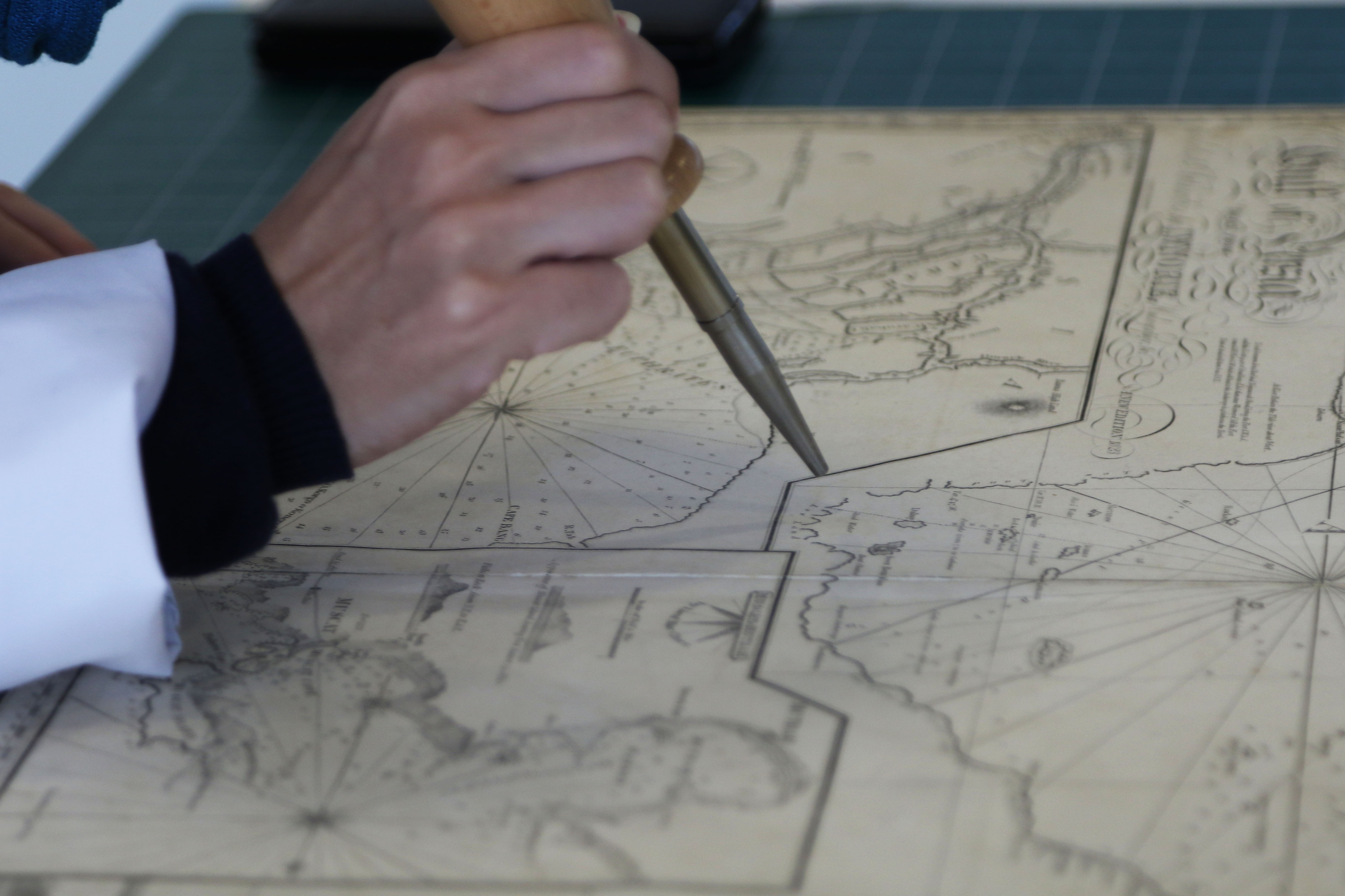
Possibly one of the least discussed aspects of the current proposal for an EU Directive on Copyright in the Digital Single Market is Article 5 on the preservation of cultural heritage, which introduces a mandatory exception to the right of reproduction allowing cultural heritage institutions to make copies of items (in any format) in their collection for the purpose of preservation. This article recognises the fact that a single copy is not sufficient for digital preservation and that it is necessary to multiple copies. It also allows for format shifting. The proposed directive also has a provision on technical protection measures but does not go far enough in providing a mechanism for recourse should rights owners not cooperate in allowing cultural heritage institutes to circumvent these measures for the purpose of preservation.
1997-2007: the main challenge after two decades of digital preservation research is the weakness of the professional and institutional networks
Maria Guercio is President of Associazione nazionale archivistica italiana
The main challenge after two decades of good research is the weakness of international and national professional and institutional networks with reference to the capacity of sharing knowledge and solutions.
It is a paradox that in the modern society, interconnected by definition, the international community involved in digital preservation (more robust and interrelated than other professionals and rich of two decades of good research and experience) does not have planned tools and communication channels strong enough to play with continuity its role with success. In fact and indeed, the networked digital world is more fragmentary than in the past, while the archival heritage can survive for future only if our professional and institutional community will be able to put in place a long-term program of research and a stable cooperation framework. The relations we have to create and maintain could be able to re-enforce our capacity of identifying and improve solutions by cooperating and sharing our experiences, our successful achievements, but also our failures.
The lack of continuity and the increasing isolation of the stakeholders is the most critical aspect of the whole sector, but the international funding and coordinating bodies do not seem to be aware of this. For instance, this factor has seriously weakened the European effort in this area and prevented the completion of ambitious and promising projects and implementation plans, at the point that no robust programs for funding preservation projects are in place within Horizon 2020 and no coordination is available to discuss and compare the models developed in the European countries. A similar attitude is present in the ICA initiatives where a temporary group of expert has been created for handling with digital records (DREG, http://www.ica.org/en/our-professional-programme/expert-group-digital-records-dreg), but no resources are available neither for events nor for meetings.
Fifteen years with digital preservation
Zhenxin Wu is Professor of the Information System Department and Deputy Director of the Digital Preservation Center of Chinese Academy of Sciences at the National Science Library in Beijing, China
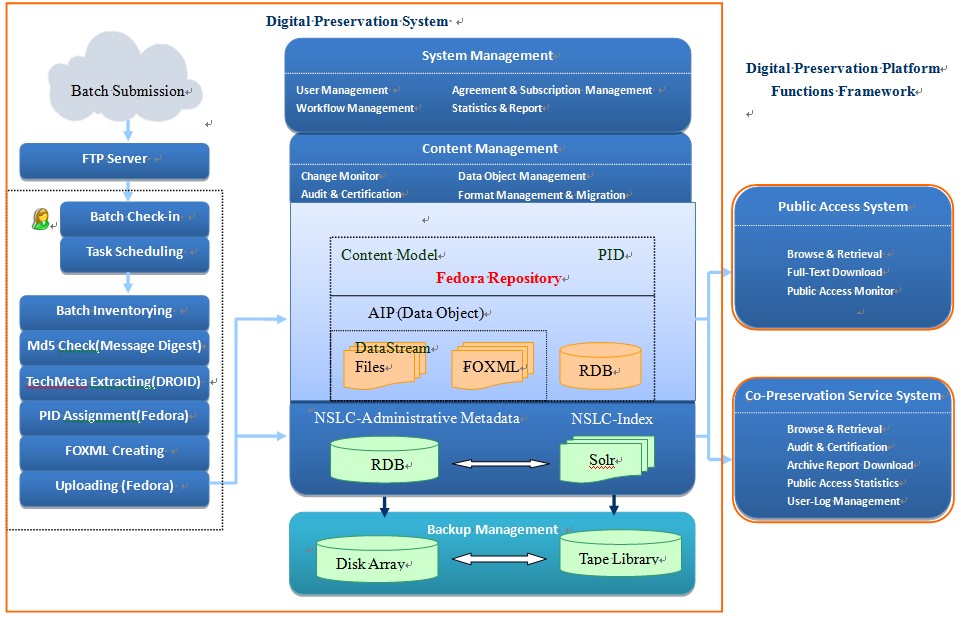
与长期保存共同成长的十五年
长期保存对我而言,是我研究生涯的开始,之前我是一个图书馆系统程序员。2003年,张晓林教授找到我,希望我能参与斯坦福大学图书馆的一个项目协助做些事情,也就是日后很成功的LOCKSS项目。出于对这所著名大学的敬仰,我立刻就答应下来。从配合LOCKSS项目在中国北京建立一个测试节点开始,我逐步了解了数字资源长期保存的内涵,以及这项工作的重要意义,并产生了浓厚的兴趣。2004年,在北京作为工作人员参加组织了第一届数字资源长期保存国际会议(iPRES),目前iPRES已成为长期保存领域最有影响力国际会议。2005年Neil Beagrie先生介绍我到英国数字保管中心(DCC)作高级访问学者,在爱丁堡,我学习到很多新东西,也看到很多新思想的碰撞,结识了很多长期保存领域的专家。
回到北京后,在中国科学院的资助下,我开始从事电子出版物的长期保存研究和试验,对文件格式管理、fixity check,起源信息管理,数据迁移,以及可信赖审计与认证等进行了深入的研究,与团队一起开发了基于Fedora的电子期刊存档试验系统,并致力国家层面的宣传呼吁。
图1.电子期刊存档试验系统功能框架
PERSIST: A Global Dialogue on Digital Preservation
Robert Buckley works for the National Archives of the UAE in Abu Dhabi
PERSIST: A Global Dialogue on Digital Preservation
To those unfamiliar with PERSIST, it is a project within the UNESCO Memory of the World Programme, whose International Advisory Committee is currently chaired by Dr. Abdulla Alraisi, Director General of the National Archives of the UAE. The Memory of the World (MoW) Programme was created in 1992 to facilitate preservation of the world’s documentary heritage and to assist in providing universal access to it.
When my colleague Hamad Al Mutairi, Director of the Archives Department here at the National Archives of the UAE, and I first sat down to discuss this contribution, he drafted the outline of a general digital preservation policy. We realize that having a policy for digital preservation or digital continuity is not a unique thing; numerous institutions have one already, suitably adapted to the environment in which they operate. What is different is that the effort here is partly stimulated by our participation in the PERSIST project.
The PERSIST project is essentially a digital component of the MoW programme. It is an outgrowth of the The Memory of the World in the Digital age Conference held in Vancouver in 2012. PERSIST aims to address the challenges of long-term digital preservation and the risks of losing access to part of our digital heritage. Partnering with UNESCO on PERSIST are the International Council of Archives (ICA) and the International Federation of Libraries Associations and Institutions (IFLA).
Building blocks of digital preservation in India
Dr. Dinesh Katre is Associate Director and Head of Department at the Centre for Development of Advanced Computing (C-DAC) in Pune, India
It is a matter of great pride for me to have associated myself with the global cause of preserving information in digital era. I wish to congratulate the team of Digital Preservation Coalition (DPC) for taking this initiative to celebrate International Digital Preservation Day (IDPD)! This can be a very effective tool for creating awareness about rampant digital obsolescence among general public.
We have been working on digital preservation in India since 2009. I take this opportunity to present an overview of “Centre of Excellence for Digital Preservation”, the flagship project undertaken as part the National Digital Preservation Programme sponsored by Ministry of Electronics and Information Technology, Government of India. The Centre of Excellence of Digital Preservation is established at C-DAC, Pune, INDIA. Being the Principal Investigator (PI) of this project, I would like to share information on major outcomes of this project.
Digital Preservation at the University of Melbourne
Jaye Weatherburn is Digital Preservation Officer at the University of Melbourne
Background
Three years ago, at the September 2014 meeting of Academic Board at the University of Melbourne, the Digital Preservation 2015–2025: Strategy[i] and Implementation Roadmaps[ii] were endorsed. By early 2016 the Digital Preservation Project team had formed and commenced the “Establishment phase” towards implementing the Strategy. A central aim of the Strategy is to establish a university ecosystem of repositories with the capability to archive, preserve and provide ongoing access to the university’s digital assets.
The project has survived and thrived through a large-scale university restructure, and significant resourcing challenges, thanks to the ongoing dedication of the library Research & Collections team at the university, led by Donna McRostie.
Digital Preservation of Indian Cultural Heritage: Issues and Challenges
Dr. Ramesh C Gaur works at the Jawaharlal Nehru University
At the outset, let me congratulate all on initiating 30th November as the International Digital Preservation Day (IDPD17).
My introduction to digital preservation started in 2005 when I visited Germany with the support of Max Mueller Bhawan. My three-week stay, one week each at Belfield University, Belfield; German National Library Frankfurt; and State Gottingen University Library, Gottingen; provided me opportunity to closely study some of the digital preservation initiatives in Germany in particular and in Europe in general. The interaction with researchers working at project like NESTOR, KOPOL, and REUSE, etc., helped me in learning the basics of digital preservation. After coming back from Germany, I shared my experience in the form of various lectures delivered at various national and international conferences in India. Since then, digital preservation is one of the prime area of my interest.
Digital preservation is a process of preserving both digitized and born-digital contents to a distant future in reusable condition for access by its users. It involves a set of systematic guidelines, processes, strategies, technology and approaches.' The technological obsolescence, shorter and uncertain life-period for current storage media, information glut, and internet revolution are some of the major factors which have made preservation of digital information more complex and challenging. Being a librarian, preservation for access is key to my thought process.
How do I keep my digital films safe
Joshua Ng is the Information Technology (IT) & Technical executive at the Asian Film Archive (AFA) based in Singapore.
Hi Joshua,
I made some short films a couple of years back. Some of them were submitted to competitions and won some awards. I have been keeping them in an external hard disk, thinking that since the files are backed up, it should be safe. But I had quite a scare the other day when my computer couldn't detect the hard disk. Fortunately when I tried it with another USB cable it worked. Is there something I can do to ensure my short films are safe?
Warm regards,
Paul Soon
Filmmaker
Plans are my reality
Yvonne Tunnat is Preservation Manager at the ZBW Leibniz Information Centre for Economics
I was fresh from university when I started my job as a preservation manager in October 2011 at the ZBW. Having taken a module named “Digital Preservation” during my studies of library and information science and after a 9-week-internship at the Digital Preservation Department of the university of Utah, I obviously was the best they could find for the job, although I knew next to nothing and they knew it.
Only, I did not know it. I felt self-confident and well-prepared. I had seen the OAIS slides several times, I knew our ingest was more or less solved and I did not need to think about access as we run a dark archive, so preservation planning was the one big task left on my desk.
There was this software, JHOVE, which miraculously was able to decide if a PDF was ok, flagging the bad ones for later preservation actions. As I knew nothing (like Jon Snow), I took all JHOVE findings as granted.
My preservation plan was as following:
- Gather all bad PDF
- Migrate them to good PDF
- Check if they still look alike
Thanks to JHOVE, the first step was easy. I left the second step to our IT guy, who quickly built a small java program, which transformed all the bad PDF into good ones. At least, after the migration JHOVE could not find anything wrong with them anymore.
But I had to rack my brain about the third step. Somehow I needed to compare the new PDF version with the original to see if there were any changes that would make the data producer angry (like layout changes, missing content etc).
What does digital preservation mean to you?
Jaye Weatherburn is Digital Preservation Officer at the University of Melbourne
In a review conducted in 2016 for the University of Melbourne’s Digital Preservation Project, key research staff at the university were asked the question, What does digital preservation mean to you? The primary aim of this review was to identify and document gaps in service provision for research data management, and to highlight the main barriers impeding the implementation of sustainable digital preservation.
The responses from the review have been anonymised, remixed slightly, and in parts edited for length, but still accurately represent the answers as provided. They are presented here in both transcript form, and as an audiovisual creation using the Mac OS X El Capitan (version 10.11.6) speech-to-text voices: Fiona, Alex, Karen, Samantha, Tessa, and Daniel.
Twittering on the edge of two conferences: Themes of power and empowerment at ASA-ITIC and iPRES 2017
Rachel Tropea is a Senior Research Archivist at the University of Melbourne in Australia.
2017 has been a year for digital preservation firsts – the first ever International Digital Preservation Day on 30 November 2017, the University of Melbourne became the first Australian institution to join the Digital Preservation Coalition, and on a personal level it was my first time attending iPRES.
iPRES is the major international conference on the preservation and long-term management of digital materials. In 2017 it was hosted by Kyoto University, and the theme was Keeping Cultural Diversity for the Future in the Digital Space — From Pop Culture to Scholarly Information.
At the same time, the Australian Society of Archivists Conference & Information Technologies Indigenous Symposium (ASA-ITIC) took place in Melbourne, and its theme was Diverse Worlds.
Although these communities confer separately, their concerns are largely the same as evidenced in part by their shared theme of diversity this year. And, as I hope you’ll see from my discussion of ASA-ITIC, the challenges posed by the keynote speaker Jarrett Drake go to the very core of what we all do.
What’s in a name?
Amber Cushing is Lecturer (Assistant Professor) for the School of Information & Communication Studies, University College Dublin
When it comes to digital curation in Ireland, a lot, actually. In 2014, I was recruited by University College Dublin (UCD) to start an Msc in Digital Curation. Digital curation has been concisely defined as “the management and preservation of digital material to ensure accessibility over the long term” (Abbott, 2008). In essence, preservation is only part of the process, digital curation prescribes that sustaining long term access to digital material should be considered before the object is even created, but selecting optimal file formats, a preservation strategy, etc. I thought my background, having been a PhD student at the UNC School of Information and Library Science, that launched one of the first degrees in digital curation had prepared me for this. I knew the major issues in the field, as well as the key literature. Just to be sure, I, along with UCD School of Information and Communications Head of School Professor Kalpana Shankar, decided to embark on a needs analysis of digital curation in Ireland.
This is not a part
Sean Barker runs a Technical consultancy on Enterprise Integration and Information Sharing for Products
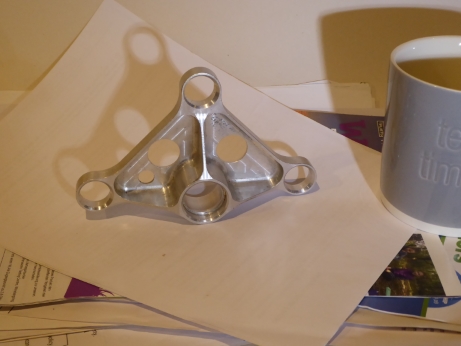
This photo shows my paperweight for the last 25 years. The suggestion is that it was a test part, used in a prototype for a flight control mechanism. You might think that it is the physical part that endures long after the design has been lost in an archive, but this piece of metal demonstrates the opposite - it is a part without provenance, so not an aircraft part at all.
Yes, we could measure and redraw it, but that would not be its design. The holes are set where they are because of the geometry of the mechanism, but which mechanism was it designed for? The flanges - the metal ridges round the edges that stand up from the base plate - are there to stiffen the plate. They will have been analysed through a finite element stress model, but without knowing the original mechanism, we don't know the forces the stress model tested. And even if we can find the most likely mechanism, it is likely that it went through several versions, and which version, which loads is this designed for?
Crossroads
Andrea Goethals works at the National Library of New Zealand
Recently I unexpectedly found myself with extra time on my hands, as I was preparing to take a new position halfway around the world. Like most of you, I’m assuming, I normally don’t get the time to go back and reread some of my favorite digital preservation papers, discover new favorites I missed previously, or to follow the sourced papers to see where it takes me. Because my interests lie in what it takes to build and grow effective digital preservation programs, I focused on preservation requirements, capability criteria, maturity models, self-assessments, risk assessments, audits and certifications. Besides all the benefits that come from rereading these guidance documents, papers, and standards; several things struck me in the process that I’d like to share with you.
Welcome to the Digital Preservation Laundrette!
Matthew Addis is Chief Technology Officer for Arkivum
This blog post is both a demonstration of how to extensively torture a metaphor if you try hard enough, which I'm certainly want to do from time to time, and a look at some of the serious issues of digital preservation at an industrial scale outside of memory institutions.
The metaphor is washing machines, the industrial application is research data preservation, and the answer, perhaps paradoxically, is to choose to do less for more.
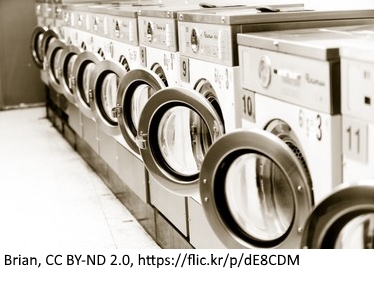 I've been involved for over 2 years now with the Jisc Research Data Shared Service (RDSS). This has the ambitious and laudable goal of providing a national Shared Service for Research Data Management to Higher Education Institutions (HEIs) in the UK, including the deposit, storage, publication and preservation of a wide range of digital research outputs.
I've been involved for over 2 years now with the Jisc Research Data Shared Service (RDSS). This has the ambitious and laudable goal of providing a national Shared Service for Research Data Management to Higher Education Institutions (HEIs) in the UK, including the deposit, storage, publication and preservation of a wide range of digital research outputs.
Bit Preservation is NOT a Question of Technology!
Eld Zierau is Digital Preservation Specialist PhD at the Royal Danish Library in Copenhagen, Denmark
And yes, it does involve technology, but technology is just a tool, in the same way as a word processing editor is a tool for a writer.
Today, there is a growing awareness of the need for bit preservation, but there are still a lot of talk about backup, hardware longevity, bit preservation as a technology solution etc. I will here focus on the technology contra non-technology parts, and I will therefore take the liberty to assume the following: It is common knowledge, that there needs to be copies of data in bit preservation, and that these copies of data are equally worthy (not backup copies of an original), and that the copies of data (replicas) are regularly checked and fixed for errors.
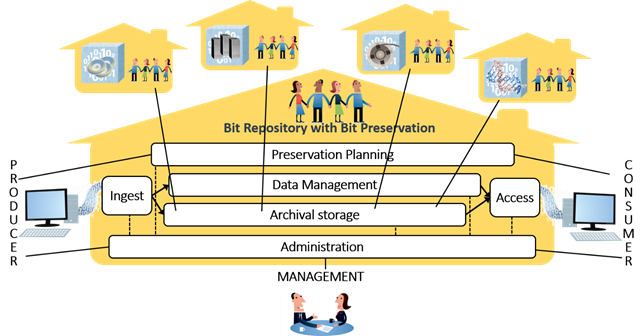
Figure text: Bit preservation with coordinated independent replica units in different organisations, expressed in OAIS terms and images from digitalbevaring.dk
Digital Music Production MK I.
Thomas Bårdsen is Audio Production Manager at the National Library of Norway
I guess the first digital thing that entered my house growing up, was music. A shiny disc of digital information, read out via laser technology. So futuristic, at the time I think it even changed my hairstyles in a more “pointy” direction. Those discs were just an end product of a whole new direction in music production. The whole music production chain aimed digital. The discs were graded and stamped as if they were jewelry. DDD meaning digital technology were used from start to finish. Music productions have in some ways been born digital for over 35 years. It has also left some strange digital collections behind. In the very early eighties, going digital was a risky and costly piece of business. The previous analog era in music technology, had at least tried to be compatible. The new approach from the industry was that of proprietary systems. Legendary record producer Richard Burgess called the approach of the early digital audio formats a winner takes all play, were larger companies hoped on maximizing profits by squeezing out all competition.
2017: A Watershed Year for Digital Preservation?
Ross Harvey is Professor at Monash University in Melbourne, Australia.
Preparing a new edition of Preserving Digital Materials with Jaye Weatherburn (Rowman & Littlefield, 2018) has provided the opportunity to reflect on a large body of material about digital preservation. What I have observed suggests strongly that in the future, 2017 will be considered as a watershed year for digital preservation.
Sometimes the progress of digital preservation seems to resemble a tortoise inching along. Solid foundations are in place, and the need for action is better understood, but these only brush the surface of the many, varied, and evolving challenges. Four challenges seem particularly resistant to change: managing digital preservation, especially its lack of integration into mainstream practice; funding digital preservation – there’s never enough; peopling digital preservation, there being a lack of skilled people; and making digital preservation fit—lack of scalability of digital preservation activities.
The Future of Television Archives
Richard Wright runs Preservation Guide, a consultancy on audiovisual preservation. Before retiring, Richard worked as a Technology Manager at BBC Information & Archives from 1994.
Not everyone knows that there even are television archives. Europe is fortunate in having a tradition of public service broadcasters. They are publicly supported in various ways (licence fee, limited advertising, direct government funding) but all have a remit to provide high-quality information and entertainment. Broadcasting can be seen as ephemera, but yesterday's ephemera becomes today's heritage. Of particular interest in a time of fake and false news is the role of public service broadcasters in providing quality factual material: news and current affairs.
Public service broadcasters, particularly in Europe, have also led the way in maintaining archives of their productions. While drama and entertainment programmes are kept for repeats and for sale to other countries, factual content is heavily recycled to add depth and interest to current programmes. In the BBC, about 30 to 40 percent of 'the news' is actually archive material. Other uses include biographies; retrospectives on people, places and political situations; cultural history; and a wide range of factual content that needs archive footage for context and historical memory. Up to 2010, about 20% of the BBC television archive was accessed each year, and 95% of that use was internal: back into the BBC for adding depth to new programmes. The other 5% was commercial use. Broadcast archives had little or no public access. In the UK, public access to BBC Archives was via copies of tapes sent from the BBC to the British Film Institute.
If I had a time machine: Letter to past-DP-newbie-me
Michelle Lindlar is Digital Preservation Team Leader at Technische Informationsbibliothek (TIB) in Germany.
Dear past self,
You left your IT job a couple of months ago to work in digital preservation. It seemed like a really exciting and good fit given your background and interests. I think you’re still trying to work out the culture shock of working in a public service environment and trying to figure out what digipres is ‘zactly. I thought a few pointers and words of encouragement from future-you-who-has-been-in-the-job-for-a-while would be good.
Stop, collaborate and listen! NSLA’s here with a successful vision
National and State Libraries Australasia (NSLA) is a leading library sector collaboration of the National, State and Territory libraries of Australia and New Zealand.
How Australasian libraries are working together on digital preservation
How often do you leave a conference, or a meeting, with the best intentions of “collaborating more”, only to see those intentions evaporate quicker than rain on bitumen on a hot summer’s day, as soon as you return to your desk and look at your email inbox? We don’t make these statements flippantly; most of us share a sincere commitment to work together, recognising that for us to move forward and progress our work, we need help from others. Sadly though, what happens next is that reality takes over. Business-as-usual kills the best intentions.
Despite this, the national libraries of Australia and New Zealand and state and territory libraries of Australia have found a model of collaboration that has proven to be extremely rewarding. National and State Libraries Australasia (NSLA) brings these ten libraries together under a shared vision of connecting library professionals to information, and to each other. The libraries have many differences – they range significantly in size; they have differing mandates, and differing priorities – and yet, NSLA is a success story.
One of the significant NSLA success stories is the Digital Preservation working group. Formed in 2012, the group brings together representatives from each of the ten member libraries to identify best practice for preserving digital content – practices that are best served by a collaborative approach.
Keep the knowledge
Panos Constantopoulos is Professor in the Department of Informatics at Athens University of Economics and Business & Digital Curation Unit in Greece
An answer to the question “what should be preserved?” would typically include digital content of various forms and related metadata. But what stands for content and where is the limit between content and metadata? The changing notion of ‘document’ and the evolution and spread of computationally supported business and research processes, entail a greater need for keeping process and contextual knowledge.
Digital content traditionally includes material that is the product or record of some activity and comes in several forms - text, graphics, images, audio, video, data sets. Recent years have witnessed a shift in content granularity and structure. This is related with the ability to manage both the identification of entities that possess independent information value and the associations of those entities. Reference to self-contained parts of documents is an old practice (chapters, sections, tables, images, columns, etc.). Yet it is in the universe of the Web and linked data that this practice becomes fully operational and on a large scale: here the parts are independently identified through their URIs following some naming scheme and the conceptual bond that makes them parts of a whole is explicitly represented in the form of appropriate relations between them. The parts can then be reused in different ways. In this perspective, it is useful to maintain the knowledge of the successive uses as well as of the contexts of use.
The first International Digital Preservation Day (#IDPD17) is finally here!
Glasgow, 30th November 2017
Dear colleagues and friends around the world,
Welcome one, welcome all! The first International Digital Preservation Day (#IDPD17) is finally here!
This day is for everyone who works in digital preservation. It’s about their work. It’s about the opportunities created by the digital materials they safeguard and make accessible. It’s about the hard work and ingenuity, often unrecognised, that makes a secure digital legacy possible. And it’s about fostering links across this growing but highly dispersed community. Supported by digital preservation networks around the world – old friends and new - IDPD17 is open to participation from anyone and everyone interested in securing our digital legacy.
5 ways to share your International Digital Preservation Day
There are two months until our very first International Digital Preservation Day (IDPD17), and already there’s a fantastic buzz about it. People have been tweeting and emailing me since we first announced it, asking for ideas for things they could do to join in the celebrations, the fun, the party!
My favourite suggestion yet has been someone contemplating dressing up as a floppy disk at work for the day – please don’t let me stop you.
What’s great is, even aside from the dressing up, there are LOADS of ways to get involved. Whether you’re a tweeter, facebooker, instagrammer, blogger, vlogger, filmmaker extraordinaire…or you just like a good old-fashioned face to face chat with a bunch of likeminded folk, you can do any or all of those things.


